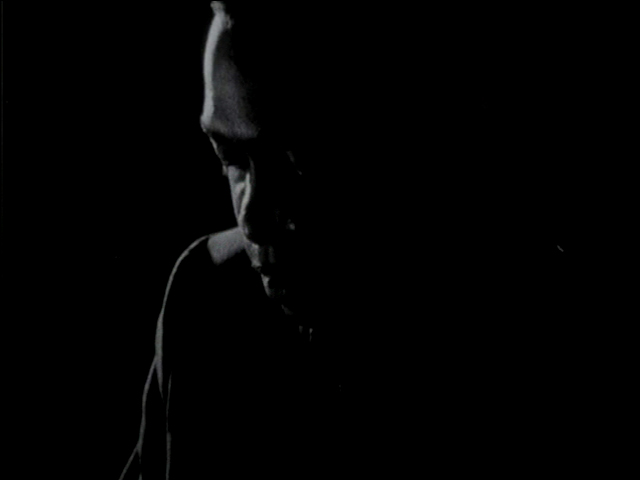

Revision note:We have identified the artist who made the first cover for Jazz in Silhouette: his name is Harry Paul Corbissero and he lives in Ashtabula, Ohio. While studying at the School of the Chicago Art Institute, he lived for a time at 5414 South Prarie, in the apartment next to Sun Ra's. We have taken the first session by Yochanan, the eccentric blues singer, out of the main body of text here and put it in an appendix; our best current information is that the session was made with a "rock and roll band" led by tenor saxophonist John Tinsley. New research by Brad Markus in one of several Pat Patrick archives (at Northwestern University, in this case) has enabled us to give a firm date to the Arkestra's first appearance at the Wonder Inn (February 10, 1960) and enabled us to add to our account of Sun Ra's live appearances (in 1954 and 1957). With the help of Gary Heller, we have expanded our coverage of Paul Severson, a jazz musician whose combos are heard but not seen in The Cry of Jazz. Steve Espinola has identified an issue with Sunny's early-model Wurlitzer electric piano that has led us to reassign some 1956 tracks to sessions. Dante Carfagna has tracked down a record Alton Abraham once said he had made, by a group called The Clock Stoppers. It turns out to be the work of a soul unit from 1967 (not a vocal group—one W. Truman does all the singing). It was released on a label called Clock and there's no reason to think Sun Ra had anything to do with it. Graham Connah has identified a long-elusive track from Sun63a (as we currently catalog it). It is "Mr. Lucky," a TV show theme by Henry Mancini. Mancini's own version was released on a single on February 1960, which helps nail down the date on this live session. We will continue adding in documentation that is preserved in the Alton Abraham Collection of Sun Ra (1822-2008), now housed in the Special Collections at the University of Chicago Library. All of this has led to many changes in our listings, especially for 1956, 1958, and 1960; sessions and other activities by the band will need further rearranging.
Sun Ra's musical career is hard to generalize about. He led bands for nearly 60 years. He made something like 125 LPs. He performed everything from 1930s hotel-band schmaltz to synthesizer pieces that twittered and clunked like a demented Pac-man machine. This page will follow Sunny through the first half of his career—from his days as Sonny Blount in Birmingham through the end of his breakthrough period in Chicago, where he changed his name and founded his Arkestra.
Sun Ra believed in eternal being. Birth was a bad word in his lexicon. One of his "equations of sound-similarity" was B-I-R-T-H = B-E-R-T-H. If you were born, that meant you were going to find your place of B-E-R-T-H — i.e., your final resting place — i.e., the grave. Sunny preferred to say he had "arrived on the planet," and was more than a little vague about when that happened — maybe in 1055, he would say, maybe a few thousand years before that.
His passport and his high school records tell a more mundane story. Herman Poole Blount was born in Birmingham, Alabama, on May 22, 1914. From very early on he was known as Sonny — spelled with an "o," of course. About his family we know little. He had an older brother, Robert, an older half-sister, Mary, and an older stepbrother, Cary Blount, Jr. Three more stepsiblings resided in Demopolis, Alabama. His mother ran restaurants.
The family home was in a strange location. In a Southern city heavily segregated by race, the Blounts did not live in either a black neighborhood or a white neighborhood. Theirs was the only house on an entire city block. They were located across the street from the Post Office and close to the main railroad station. As a child, Sonny could look out the window and see the big sign over the railroad tracks that greeted visitors to The Magic City; many years later that would become the title of one of his greatest (and most avant-garde) compositions. To the north, there were just open fields.
There was a piano in the house (Sunny told interviewers it was a present for his tenth "arrival day") and his family seems to have encouraged his musical aspirations. He was a genuine prodigy, but his boasts that he could read music without training should be discounted—even Mozart and Saint-sëns needed instruction. Though a shy and reserved individual, he struck up a friendship with another young pianist, Avery Parrish (1917-1959). They played duets together and challenged each other to write their first compositions. And while attending Industrial High School — where he was a straight A student — he came under the tutelage of John Tuggle "Fess" Whatley. Fess Whatley has grown legendary as a music educator (now duly celebrated in the Alabama Jazz Hall of Fame), so it may come as a shock to realize that he was employed as a shop teacher, and his musical instruction all took place after hours.
One of Sonny's first compositions (written in 1929 or 1930) was titled "Chocolate Avenue." In 1933, he mailed it to Clarence Williams in New York City. Williams used it on a record—without crediting Sonny for the piece or paying him a dime in royalties. Sonny's lifelong distrust of the music business started right there.
Before he left graduated from high school in January 1932, Sonny was already playing piano on a substitute basis with bands like the Society Troubadours. He subbed (for Curly Parrish, Avery's older brother) in at least one of Fess Whatley's three bands, the Sax-o-Society Orchestra. In later years took pains to emphasize that such bands played for society dances and other genteel events, not in taverns or nightclubs.
By this time, Sonny was listening avidly to recordings by all the jazz "Masters" when they came out. In fact he collected so many 78s that one day he stacked them too high, and the pile fell over and injured him. In 1933, he transcribed a band arrangement off a record for the first time. It was Yeah Man, freshly released by Fletcher Henderson. Sonny always had the highest admiration for Henderson's band —he speculated that it must have been populated with angels rather than ordinary Earthlings— and he would call this tune well over a thousand times on the bandstand. The other three titles recorded on that same session (Can You Take It?; King Porter Stomp; and Queer Notions) didn't escape his attention either; all of them stayed in the Arkestra's book from 1966 onward.
In the fall of 1934, Sonny Blount went on a tour of the Southeast with a band sponsored by Fess Whatley and led by Ethel Harper, a biology teacher who had ambitions to make it as a singer. The tour started September 18, but within three weeks, she decamped with a vocal group, leaving Sonny in charge. By October 13, when the band played the Floral Casino in Kingsport, Tennesse, Sonny was billed as the leader (Kingsport Times, October 12, 1934, p. 8). The band got notices in the Pittsburgh Courier and the Chicago Defender. A Courier piece (p. 14) from November 3, 1934 has the Sonny Blount Orchestra in Asheville, North Carolina. It was a 13-piece band, with Herman "Sonny" Blount (piano), Nathanial Atkins (trombone), Ivy Williams (bass), Joseph Sanford, Alvin Robinson, Ellis McClure, John Reed, Jessie Larkin, Melvin Caswell, James Bates, Jerry Reed, and Bayford Woode. Sanford was a former Bama State Collegian; the rest were said (with significant exaggeration) to be "young college men." On December 1, the Courier (p. A6) mentioned a recent appearance in Danville, Illinois "at the Harrison Park dance hall to a capacity crowd." "Barford Wood" was said to be their vocalist, and the band was said to be planning to head south via Cincinnati so they could play Florida during the winter. Except for a little detour. The Sonny Blount Orchestra first ranged northward to Chicago, where Sonny joined Musicians Union Local 208 on December 15, 1934. Eventually he would alter his destiny in Chicago....
In the spring of 1935, the band was working closer to home. In February they got one-nighters at the Sunset Casino in Atlanta (Atlanta Daily World, February 8, 1935, p. A3; February 21, 1935, p. 3). The February 21 event was the Mid-Winter Sport Dance put on by the Lion Tamers club; Sonny was said to be leading a 14 piece jazz orchestra. A battle of the bands (Sonny Blount vs. the house ensemble, the Sunset Troubadours) was set for the Sunset Casino on March 7 (Atlanta Daily World, March 4, 1935, p. 3). The Daily World's society columnist, Lucius Jones, referred to "Sonny Blount and his sweet, swingy orchestra, fresh from a series of dance hall and radio engagements in the Magic City." He compared Sonny's pianistic skills with those of Jay Gholston of the Sunset Troubadours; reviewed the vocal skills of Claude E. Tarver (Blount) and Will (Cab) Hall (Sunset); and declared that "Sonny Blount and his men are given credit generally for having the best reed section among the bands performing in this circuit." A battle of the bands was not a common event in Atlanta at the time, and according to Jones Sonny challenged the Troubadours at intermission during the Lion Tamers' dance. The Sonny Blount band was scheduled to play a dance in Meridian, Mississippi on April 30 ("Across the Desk of the Theatrical Editor," Pittsburgh Courier, April 27, 1935, p. 21)
Sonny attended Alabama A&M University in Huntsville as a music education major. He was inordinately proud of having done so ("I think I studied everything in that college except farming"). He was able to attend for just one year (1935 - 1936); in the depths of the Great Depression, his family couldn't afford the tuition, but Dr. S. F. Harris, who lived in his neighborhood, paid for scholarships for Sonny and several other musicians from his high school. The music department gave him a good deal of classical training (up through Chopin and Rachmaninoff anyway); you could hear it in his improvised preludes, and in the Chicago days he would warm up by playing classical pieces. He ended up eighth in his freshman class, with a Grade Point Average of 3.18 (no grade inflation in those days...)
Other things happened in college. He had a dream in which he was summoned by robed figures. They admonished him to keep inside a narrow beam of light, and all traveled upwards until they reached their destination — the planet Jupiter. Sonny Blount confided this to his diary; unfortunately one of his classmates discovered the passage and read it out loud to the other guys in the dorm. After he became Sun Ra, he spoke of this experience many times — and in a completely matter-of-fact way.
For the next ten years, he led the Sonny Blount Orchestra. Its partisans regarded it as the top Swing band in Alabama. Without refighting any old battles, let's just say it was a serious competitor to Fess Whatley's aggregations. The Whatley bands played mostly for white audiences, the Blount band almost exclusively for black audiences. (Supposedly their only gig in front of a white audience took place in Cullman, Alabama. Cullman was a center of Ku Klux Klan activity, so they were scared to death the entire night.)
Sonny's audiences wanted blues, pop tunes, and the hottest Swing arrangements (judging from what the Arkestra played in the 1970s and 1980s, these would have included scores by Fletcher Henderson, Duke Ellington, and Jimmy Lunceford, but there must have been many others he never felt like reviving). He was in the habit of transcribing arrangements off the radio (sometimes with the help of a recording device — most likely this was a Dictaphone). When Fletcher Henderson or Duke Ellington came to town, he would put his recorder right on the bandstand. Clad in tunic and sandals, he would walk for blocks — right through the middle of a white neighborhood — to a local music store, where he would pull out music paper and pencil and quickly copy any sheet music that appealed to him.
Territory bands couldn't count on recording then (though the Society Troubadours did manage one session after Sonny had left the band). Alabama's top musicians had little chance of making it onto wax unless they moved to Chicago or New York. No one alive today has direct evidence of what the Sonny Blount Orchestra sounded like. There's one surviving publicity photo of the band, and Sunny had only a Xerox of that in his possession. There was surely some newspaper coverage of the band from the fall of 1936 through the end of 1940, but what we have been able to find dates from 1941, when the band made a couple more appearances at the Sunset Casino in Atlanta.
In later interviews, Sunny would rattle off the names of Alabama musicians. It's hard to tell from what he said who was actually in his band. We do have some idea, though, who played in the last Sonny Blount Orchestra, a 12 piece aggregration. Walter Miller, trumpet; Nat Atkins, trombone; George "Jarhead" Woodruff, alto sax; Frank Adams, alto sax; Joe Alexander, tenor sax; Warren Parham, also in the sax section; Ivory Williams, bass; and Fletcher Myatt, drums and vocals. Nat Atkins and Ivy Williams had been in his band in 1934. Most of these musicians are now in the Alabama Jazz Hall of Fame.
There was one significant interruption in all of this musical activity. In October 1942 the local Draft Board came calling. Sonny Blount declared himself a Conscientious Objector, but during a war in which there was little tolerance for COs, the answers he gave on his questionnaire displeased the authorities. He spent five weeks in jail in Jasper, Alabama, then was sent to a Civilian Public Service Camp in a place called Marienville, in the boondocks of northwestern Pennsylvania. But he didn't stay long; by the end of March 1943, he was out on a physical disability discharge, because he had a hernia.
In later years, Sun Ra would say that a big band was the opposite of an army; it was a group of men who came together, not to kill, but for a constructive purpose. Sonny's misadventures with the Selective Service System could not have helped his popularity with Alabama musicians. Many already considered him weird; now they could also indict him as unpatriotic.

One transition in his career about which we can safely say that "cosmic forces" were not in control took place in January 1946, when Sonny, fed up with segregation and lack of musical opportunities, bought a one-way train ticket to Chicago. He was soon out on the road in a combo led by alto saxophonist Jimmie Jackson. For three or four months they played Club Zanzibar in Nashville, where they backed the touring blues singer Wynonie Harris. An unlikely setting, maybe. But Harris already had made several hit records on the West Coast, and a brand-new local label started by a radio announcer saw fit to capitalize. Label owner Jim Bulliet cut a deal with Harris's manager, Harold Oxley, and Harris and combo (with the old fashioned rhythm section of piano and drums) made four sides. One of them was Sonny's feature, Dig This Boogie. He'd obviously learned his blues lessons. In fact, he'd developed a few tricks of his own, like deliberately dropping beats and picking them up in the next line.
Wynonie Harris (voc, d); Jackie Allen (tp except -1); Jimmie Jackson (as except -1); Herman “Sonny” Blount (p).
WSM Studio B, Nashville, March 1946
| Dig This Boogie (Harris) -1 | Bullet 251A, Krazy Kat KK783, Classics 1013 [CD], Bear Family [Ger] BCD 15864 HL | ||
| Lightnin' Struck the Poor House* (Harris) | Bullet 251-B, Krazy Kat KK783, Classics 1013 [CD], Bear Family [Ger] BCD 15864 HL | ||
| My Baby's Barrel House (Harris) | Bullet 252-A, Route 66 KIX 20, Classics 1013 [CD], Bear Family [Ger] BCD 15864 HL | ||
| Drinkin' by Myself (Harris) | Bullet 252-B, Route 66 KIX 3, Route 66 RBD 3 [CD], Classics 1013 [CD], Bear Family [Ger] BCD 15864 HL |
Bullet 251 and 252 were 78 rpm singles, both released on April 14, 1946 (thanks to Sam Byrd for the exact release date). They were the second and third releases on the label, immediately following Bullet 250 ("Nashville Jumps" b/w "Loose as a Goose") by R and B pianist Cecil Gant, who at the time was also managed by Harold Oxley. For Bullet 252, we follow the A and B designations on the labels. In the trailoff shellac, "Barrel House" shows 252-B and "Drinkin'" shows 252-A.

Krazy Kat KK 783 is a 1983 British reissue LP (by various artists) of items released on Bullet; it is titled Nashville Jumps. Route 66 KIX 3 is a Swedish Wynonie Harris reissue LP from 1977 titled Mr. Blues is Coming to Town. In the early 1990s, this collection of 16 Harris tracks was reissued on CD as Route 66 RBD 3 (provenance is unclear, as Allen Welsh points out, because the CD is labeled as having been made in England—and in Czechoslovakia). Route 66 KIX 20 is another Wynonie Harris LP collection from 1982 titled Oh Babe. All four titles were reissued in November 1998 on a French CD: Classics 1013, Wynonie Harris: 1945-1947. The Classics CD was the first release to mention Sonny's involvement. All four titles were again reissued in 2000 on a Bear Family 8-CD set (BCD 15864 HL) titled Nashville Jumps: Blues and Rhythm on Nashville's Independent Labels 1945-1955. The Bear Family release also credits Sonny.
Jim Bulliet said in interviews that the session was done in Nashville at radio station WSM. Ra confirmed making these sides in his Cadence interview with Bob Rusch. Thanks to Mark Webber, Chris Trent, Julian Vein, and Tony Collins for further information; Jimmie Jackson is mentioned in Hartmut Geerken's 1994 discography. Wynonie Harris shouts "Look out, Jackie Allen!" during the trumpet solo on "Drinkin' by Myself."
For years, the drummer (who plays with brushes only, has good time, but isn't among the slickest on the traps) went unidentified. However, as Martin Hakwins notes in the book that accompanies the Bear Family set, "The drummer is unknown, but it just may be Harris himself when you consider his early reputation as a 'show drummer'" (p. 159). As Hawkins observes, no drums can be heard at all on "Lightnin'," until Harris is finished with his first vocal chorus and Jimmie Jackson starts his solo... then all of a sudden there is a prominent backbeat on the bass drum. Hawkins attributes the abrupt change to amateurism on the part of the recording engineer, but it's distinctly possible that Harris hadn't sat down till then. On the other two quartet tracks, the drums are audible throughout, but are always much more prominent when Harris isn't singing. By contrast, there is a consistent drive from the traps on "Dig This Boogie," where Harris's singing consists of short interjections. The drums are much better balanced on Cecil Gant's 1946 sessions for Bullet, supposedly made at the same studio.
Hawkins opines that "Dig This Boogie" was done in haste at the end of the session to provide a fourth side. This may well be true (the matrix numbers are strictly A and B and don't help us) but Jim Bulliet decided to designate Sonny's tour de force as the A side.
The March date comes from Tom Lord in his Jazz Discography; Tony Collins, in Rock Mr. Blues: The Life and Music of Wynonie Harris, gives March or April—the records were advertised in a trade publication on April 27.
 In Nashville, Sunny took up with Sir Oliver Bibb, in whose band he returned to Chicago. Oliver Bibb (usually called "Bibbs" in Local 208 documents) was a drummer who led a society band known for dressing up in Revolutionary War Patriot uniforms, complete with wigs. "It fit the kind of music they were playing," he later snorted, but the idea of costuming stuck with him. He was hired for odd jobs with many other leaders, including the barwalking tenor saxophonist Cyril "Cozy" Eggleston. On August 15, 1946, his first contract as a leader was accepted and filed by Musicians Local 208: 4 nights at the Boulevard Lounge, under the name "Sonne Blount." A photo from the same period survives, signed "H. Sonne Blount"; a high-quality reproduction can now be seen in Pathways to Unknown Worlds (p. 22).
In Nashville, Sunny took up with Sir Oliver Bibb, in whose band he returned to Chicago. Oliver Bibb (usually called "Bibbs" in Local 208 documents) was a drummer who led a society band known for dressing up in Revolutionary War Patriot uniforms, complete with wigs. "It fit the kind of music they were playing," he later snorted, but the idea of costuming stuck with him. He was hired for odd jobs with many other leaders, including the barwalking tenor saxophonist Cyril "Cozy" Eggleston. On August 15, 1946, his first contract as a leader was accepted and filed by Musicians Local 208: 4 nights at the Boulevard Lounge, under the name "Sonne Blount." A photo from the same period survives, signed "H. Sonne Blount"; a high-quality reproduction can now be seen in Pathways to Unknown Worlds (p. 22).
That same month, the legendary Fletcher Henderson was working nightly at a large Chicago establishment, the Club DeLisa, with his very last big band. They had been in residence since February. Henderson was never much of an improviser, and by this time he had given up the piano, except for one nightly feature on Stealing Apples, and an occasional second feature on Humoresque. So when Marl Young (an experienced bandleader and arranger, who had already recorded with T-Bone Walker for Rhumboogie) found that his studies in law school failed to mix with the long hours 6 nights a week, and left the band to start his own Sunbeam label, Sonny Blount was there to take his place. Sonny's prowess as an arranger would have been a plus, as the band had to develop numbers for acts in the show, which turned over each month, and Henderson had lost not only Young but also trumpeter Elisha Hanna, who doubled as his copyist.
Big bands were facing mass extinction and this outfit was not in the forefront of those yet to be fossilized. Fletcher Henderson had made no musical advances since the mid-1930s, his band had lost much of its popular following, and he couldn't attract star soloists. Though each was invited into the studio infrequently, Fletcher's own brother Horace was making better recordings. Many observers wondered why Fletcher didn't spare himself the aggravation and write arrangements (as he had done in 1935) for appreciative, high-paying leaders like Benny Goodman. Judging from World War II era reviews of live performances, and a handful of recordings by this band's California-based predecessor, it had grown rough and strident, lacking the fluid drive of the 1933 and 1934 Henderson bands whose records Sonny had assiduously collected.
During Sonny's tenure at the piano bench, the Henderson band included Charles Gray, Matthew Rucker, Willie Wells, and Lee Trammell in the trumpet section. Charles Gray, the son of Harry Gray who ran Musicians Union Local 208, had previously served in Buster Bennett's combo, recording with Buster for Columbia and Rhumboogie. Willie Wells, one of many Detroit-based members of this band, handled the trumpet solos and was regarded with some ambivalence by the leader because he was a bebopper. Lee Trammell left toward the end of the engagement, and Freddie Webster joined the band for a single night (March 31, 1947), doing a feature on a very modern "Body and Soul" that, in the words of one of the musicians, "turned the DeLisa out." (This was bound to stick in everyone's mind, because the very next night Webster was dead, of a drug overdose. Sunny had no trouble remembering Webster 40 years later.) Howard Callender (the husband of blues singer Lil Green) appears to have finished out the engagement in the fourth trumpet chair. The trombones were Joe Brown (who handled the solos) and Hosea Martin. One of the alto sax chairs was held down by Riley Hampton, who had been in Fletcher's band in 1942-1943 and returned after completing his military service; the other was occupied variously by Bill McCall, Hobart Clardy, or when a substitute was needed, James Scales. Woodrow Key and Otis Finch were on tenor sax, and, as was the custom then, they carried a lot of the solo load. Buddy Conway was on baritone, Ellsworth Liggett on bass, and Jimmy Adams in the drum chair. Baritone crooner George Floyd, who had been with Henderson continuously since 1942, was the band singer. Most of the musicians had joined Henderson in Detroit in January 1945 and had moved to Chicago with Henderson when he took the job in February 1946. Besides Sonny Blount, only Gray, Callender, Scales, Liggett, and Adams were local musicians, all replacements for other musicians who had left the band. (Hampton would make Chicago his home after the engagement was over, and Otis Finch and Woodrow Key would hang around around for a while).
Sonny's job was to interpret other people's material. The band couldn't handle the "new kind of syncopation" in his orchestrations of Dear Old Southland and I Should Care; after that, Sonny kept his arrangements to himself. Nonetheless, Sun Ra always reminisced about his stay in the band with obvious pride. Though it may not have advanced his musical conception, it solidified his ideas about entertainment.
At the Club DeLisa, the Henderson band's primary responsibility was to back singers and floor shows. The club featured top entertainers in Chicago: singer Lurlean Hunter, who was resident at the club from 1944 to 1948, blues vocalist Little Miss Cornshucks, impressionist and singer George Kirby, and a standup blues singer named Jo Jo Adams, who was renowned for his wardrobe of outrageously colored tail coats. There were tap dancers like the Four Step Brothers and Cozy Cole's Drum Dancers. The extravagant entertainments that the Arkestra became known for in the 1970s, with their light shows and their corps of singers, dancers, tumblers, even fire-eaters, had roots of a more traditional kind.
The Henderson stint ended on May 18, 1947, after which the leader quietly departed to the West Coast, leaving most of his band members high and dry. Sonny had no trouble keeping himself busy. During this period he backed R&B singer Lil Green, whose husband Howard Callender had been a bandmate in the Henderson orchestra. Sonny got into clashes with Callender over religion and philosophy, but he did make the acquaintance of a young drummer from Montclair, New Jersey named Thomas Hunter, usually known as "Bugs." Sunny did not play on any of Lil Green's recordings from the period, but research into the origins of her arrangements might turn something up.
Possibly the oldest paper tape to survive is one that Sonny Blount made at a church at some point in 1948. It is also the oldest recording of his work at the pipe organ.
Herman “Sonny” Blount (pipe organ).
Unidentified church, Chicago, 1948
| All the Things You Are (Kern) | Transparency 0316 [CD, disk 3] | ||
| The Wind in the Trees [How Are Things in Glocca Morra? (Lane-Harburg)] |
Transparency 0316 [CD, disk 3] | ||
| Willow Weep for Me (Ronell) | Transparency 0316 [CD, disk 3] |
First released in 2011 on Transparency 0316, The Eternal Myth Revealed Vol. 1, a 14-CD set, the church organ recordings include two standards. Sonny Blount's first surviving piece of "far out" music, "The Wind in the Trees," is based on a third standard, "How Are Things in Glocca Morra?" "Glocca Morra" had its premiere in 1947. Our thanks to Craig Neilson (email of June 4, 2021) for the "Glocca Morra" identification.
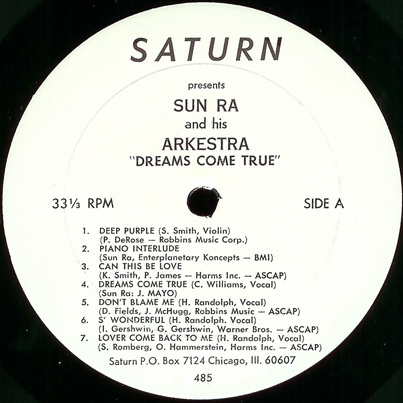
On his very first tape machine, Sonny recorded Stuff Smith and himself playing in his tiny apartment at 5414 South Prairie Avenue. They performed a duet featuring the Solovox, a primitive electronic instrument that Sonny had picked up back in 1941, while still in Birmingham. Sonny had a thing about purple (he thought people would be healthier if they ate more purple food). He released Deep Purple nearly a quarter century later on his Saturn label, and the tune remained in his repertoire for the rest of his career. It would be featured on his very last recording session, when he accompanied Billy Bang for Soul Note in 1992.
Herman “Sonny” Blount (p, Solovox); Stuff Smith (vln).
Sonny Blount's apartment, Chicago, June 29, 1948
| Deep Purple (DeRose-Parish) | Saturn 485, Evidence 22014 [CD], Transparency 0316 [CD set, disk 3] |
Saturn 485 (released in 1973) was an LP titled Deep Purple (on some copies, Dreams Come True). The artists on this collection were billed as "Sun Ra and his Arkestra"; on some copies, "featuring Stuff Smith on Violin" was added. The LP had printed white labels with a Chicago address for Saturn Records, but no covers were printed for it. Consequently, there are many cover varieties, consisting of various generic Sun Ra LP sleeves, many of them hand decorated by members of the Arkestra. All of Side A of this LP was reissued on Evidence 22014, Sound Sun Pleasure!!, a CD from 1992.
The Solovox was an early electronic keyboard instrument (already in Sonny's possession as early as 1941; it can be seen attached to his piano in a photograph that was reprinted in John F. Szwed's book Space Is the Place). When asked for a session date, members of the Arkestra told Bob Rusch “pre 1953,” by which they meant before John Gilmore joined the band; previous discographies have generally said 1953. However, Anthony Barnett, author of Desert Sands: The Recordings and Performances of Stuff Smith, says that Smith probably left Chicago by the end of 1952, and had relocated to New York by February 1953 at the latest. Tommy Hunter recalled recording this get-together (supposedly, just one tune because Sonny was running out of tape) in 1948 or 1949. Sonny Blount had traveled to Cleveland earlier in 1948 to purchase an early Ampex recorder that used paper tapes. According to Michael Anderson, producer of the 14-CD boxed set on Transparency 0316, Sun Ra: The Eternal Myth Revealed Vol. 1 (released in 2011), the original tape box gives June 29, 1948 as the date.

Herman “Sonny” Blount (p, Solovox); Jesse Miller (tp).
Sonny Blount's apartment, Chicago, July 29, 1948
| Yesterdays (Kern-Harbach) [inc] | Transparency 0316 [CD, disk 3] |
Michael Anderson has found additional tracks from the "Deep Purple" session (or at least in close temporal proximity to it). A 1-minute incomplete version of "Yesterdays" is by Sonny and a trumpet player Anderson identifies as Jesse Miller. Miller plays with his mute in; the date on the tape box, according to Anderson, was July 29, 1948.
Jesse Miller Jr. was born in Houston, Texas, on August 16, 1921. He graduated from DuSable High School in Chicago, where like so many others he got his musical training from the legendary Captain Walter Dyett. In June 1940 he joined Local 208 of the Musicians Union. He played in the bands of Tiny Bradshaw and King Kolax. Miller first recorded in 1944, with a combo of young musicians variously billed as the Chicago Jazzmen and the Session Six. Session 12-009 included a rendition of "Yesterdays," on which Miller shared solo space with tenor saxophonist Eddie Johnson. At the time, Miller was leading a band at Joe's Deluxe Club with a talented but erratic lineup that included the legendary Ike Day on drums. In June 1945, Miller's band took over at the Club DeLisa after Red Saunders left; it was Miller who was replaced, in turn, by Fletcher Henderson in February 1946. Sonny played in Jesse Miller's band at some point the late 1940s and often mentioned him in interviews. Miller was also a member of Gene Ammons' combo, appearing on Jug's last session for Mercury on October 4, 1949. Shortly afterwards, he was diagnosed with Hodgkins Disease, which in those days was incurable. Jesse Miller died in County Hospital, Chicago, on January 24, 1950 (Chicago Defender, January 28, 1950, p. 2).
Herman “Sonny” Blount (p, Solovox).
Sonny Blount's apartment, Chicago, July 29, 1948
| Darn That Dream | Transparency 0316 [CD, disk 3] |
Another track from this same group, now also included in the Transparency set, is a 5-minute solo performance by Sonny.
Herman “Sonny” Blount (recitation -1; p, Solovox).
Sonny Blount's apartment, Chicago, August 10, 1948
| If They Only Knew (Blount) -1 | Transparency 0316 [CD, disk 3] | ||
| The Darkness Within (Blount) | Transparency 0316 [CD, disk 3] |
"If They Only Knew" frankly expresses Sonny's alienation and his depression; he had not yet found his mission. It is a much more personal forerunner to cosmo-dramas like "It's After the End of the World."
Herman “Sonny” Blount (p).
Sonny Blount's apartment, Chicago, August 10, 1948
| Ode to Mary Lou (Blount) | Transparency 0316 [CD, disk 3] | ||
| I've Got a Secret | Transparency 0316 [CD, disk 3] | ||
| Something in Your Smile | Transparency 0316 [CD, disk 3] | ||
| High Steppin' | Transparency 0316 [CD, disk 3] |
In the same tape box, though not necessarily from the same date, were four piano solos showing the influence of Mary Lou Williams.
In the Fall of 1948, Sonny Blount got an opportunity to work with Coleman Hawkins for a couple of weeks.
Herman “Sonny” Blount (p); Coleman Hawkins (ts); Stuff Smith (vln); other musicians unidentified.
Chicago, September 1948
| unidentified titles | unissued |
Sun Ra often described a gig with Coleman Hawkins in 1948 in a club on the North Side of Chicago; Gene Wright confirms that Sonny Blount played with Hawk and suggests that this took place at an after-hours club. Hawk was in town to play at the Blue Note, a club in the Loop (downtown Chicago); his contract with that establishment was accepted and filed on September 16, according to the Board meeting minutes of Local 208. According to Danny Ray Thompson in an interview during the WKCR Sun Ra Festival (April 1987), a tape was made and may still be extant. Tommy Hunter placed the date around the end of 1948. Sonny wrote an arrangement of "I'll Remember April" that Hawk couldn't play; Hawkins confirmed this in an interview.
Sun Ra got another chance to play with Hawk in 1953 (see below).
In October 1948, Sonny became the music director of a successful medium-sized band. Bassist Gene Wright, at the tender of age of 23, was simultaneously running a big band and a 10 or 11 piece aggregration called the Dukes of Swing (two previous incarnations of the Dukes had been in operation in 1943 and 1946). For a while, the big band was upstairs in the Pershing Ballroom while the Dukes held the gig at the Beige Room (as the basement club in the Pershing Hotel was then known). During most of the engagement, the Dukes worked with a vocal-instrumental quartet called the Dozier Boys/ Sonny composed or arranged the Dukes' entire book. Many of these pieces were of a strictly functional nature (floor shows again) but their theme number was a suite based on the theme from Spellbound, an ambitious work by composer Miklos Rozsa. If only we were lucky enough to have that on record....
The engagement with the Dukes did bring Sonny some recording work, first as session pianist for the Dozier Boys, then with the entire band. Both sesssions were done for the fledgling Aristocrat label. It was the Doziers who came to the company's attention first, courtesy of bassist and songwriter Willie Dixon.

Andrew Tibbs (voc); The Dozier Boys: Eugene Teague (tenor voc, eg, arr); Cornell Wiley (lead tenor/baritone voc, b); Bill Minor (lead tenor voc, d); Benny Cotton (bass voc); Herman "Sonny" Blount (p).
Universal Recording, Chicago, late November, 1948
| U-7160 | In a Traveling Mood (Tibbs) | Aristocrat 1105A, Classics 5028 [CD] | |
| U-7161 | In Every Man's Life (Mallard-Austin)^ | Aristocrat 1106-A, Classics 5028 [CD] | |
| U7162 | I Want to Be Loved | unissued | |
| U7163 | This Is Always | unissued |
Aristocrat 1105 was a 78 rpm single, released in December 1948 (it was reviewed in Cash Box on February 12, 1949). Aristocrat 1106 was released in July 1949. The unissued items are as identified by Leadbitter, Fancourt, and Pelletier, Blues Records 1943-1970 L-Z (published 1994). The usual caveats about data in the Aristocrat master book apply. The two issued sides got their first reissue ever in February 2002, on Classics 5028, Andrew Tibbs 1947-1951.

We identified the lineup by ear, with help from Benny Cotton and Cornell Wiley. Though the label to Aristocrat 1105A credits Andrew Tibbs and "The Dozier Boys" with Sax Mallard's Combo, in fact Sax Mallard's group appeared only on the flip side ("The Holidays Are Over"). There are no horns on the A side, just the Doziers harmonizing and playing their instruments. The Doziers used a session pianist for dates like this; Wiley and Cotton have stated that Sonny Blount helped out on this occasion. On "Traveling" and "Every Man's," Benny Cotton shares the lead vocals with Tibbs. On Aristocrat 1106, the singer is referred to as "Andy Tibbs." Sax Mallard's band did back Tibbs at a separate session shortly before this one, which provided Aristocrat 1105B and 1106-B.
According to Jay R. Monroe, Aristocrat 1105 has been reissued on a bootleg "repro." The "repro" uses a facsimile of the Aristocrat label, but it is a 45 rpm single. Which is all the buyer needs to know: all genuine Aristocrats were 78s.
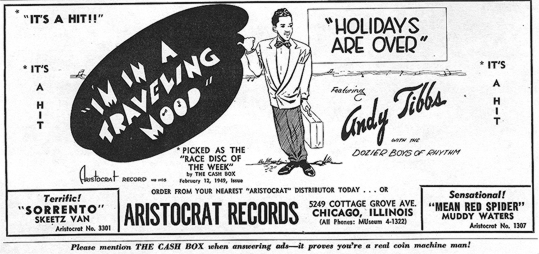
When the Dukes were booked for a session a little while later, Leonard Chess was mainly interested in them as accompanists to the Dozier Boys. The Dukes did manage to slip in two instrumental sides, both written by Sonny Blount. Unfortunately, Leonard Chess relieved him of the composer credits.
According to Cornell Wiley, the session with the Dukes of Swing followed the Tibbs session. Perhaps Aristocrat wanted to remake "Big Time Baby." Of the other three tracks from this session, two are instrumentals by the Dukes, and on "Music Goes Round and Round," the Doziers sing one opening chorus and let the band take over.
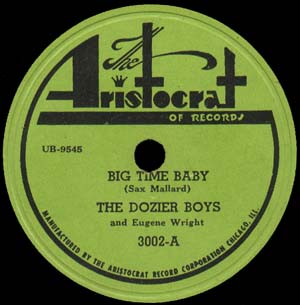
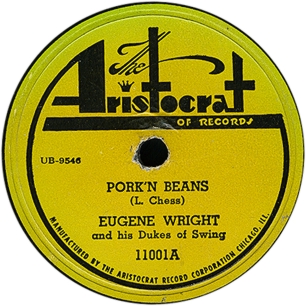
The Dozier Boys: Eugene Teague (g -1, tenor voc); Cornell Wiley (tenor, baritone voc); Benny Cotton (bass voc); Bill Minor (lead tenor voc) -2; with Eugene Wright (b, ldr); Hobart Dotson (tp); John Avant (tb -3); Frank Robinson (as); Melvin Scott (ts); Van Kelly (bars); Herman "Sonny" Blount [Sun Ra] (p, arr); Robert "Hendu" Henderson (d).
United Broadcasting Studios, Chicago, early December, 1948
| UB-9545 | Big Time Baby (Mallard) -2 | Aristocrat 3002-A, Classics 5028 [CD] | |
| UB 9546 | Pork 'n Beans (Blount) -3 | Aristocrat 11001 | |
| UB 9547 | Dawn Mist (Blount) | Aristocrat 11001 | |
| UB-9548 | Music Goes Round and Round (Farley-Riley-Hodgson) -1, 2 | Aristocrat 3002-B |
The session was split between two vocal tracks and two instrumental tracks. The instrumentals were apparently composed by Sonny Blount. Besides Gene Wright's testimony that Sonny was in charge of the band's book, we have transparently bogus composer credits: Leonard Chess claiming "Pork 'n Beans," and "Dawn Mist" being ascribed to one "Crawfish." Leonard Chess continued to take composer credit from time to time, on both Aristocrat and Chess releases, until he co-founded ARC Music in 1953; none of the pieces he claimed were actually by him. Sax Mallard is credited as the composer of "Big Time Baby" on the original label; the composer of "Music Goes Round and Round" is given simply as "Riley."

Aristocrat 3002 was a 78 rpm single, released in September 1949; see the Aristocrat discography. We got the full lineup for the Dukes of Swing came from Gene Wright (as interviewed, many years apart, by the late Otto Flückiger and by John Szwed). According to the Szwed interview, the Dukes of Swing were a 11-piece band and everyone was present at this recording session; Campbell and Trent relied on the Szwed interview in The Earthly Recordings of Sun Ra.
However, in other interviews Wright indicated that the recording ensemble was not all 11 pieces; Yusef Lateef has said that he had left the band before it recorded for Aristocrat. Careful listening suggests that on the Aristocrat sides, the horns are limited to three saxes and a trumpet, with the exception of "Pork 'n Beans," where a trombone is added. Our conclusion is that Gail Brockman (tp); Roy Grant (as); and Bill Evans (ts), who later changed his name to Yusef Lateef, were regular members of the band but did not make the session. With cut-down forces, Sonny couldn't use the arrangements in the band book; preparing for the date, he had to rescore some old compositions and, very likely, to provide some new ones. Sonny varied his forces, using 5 horns on "Pork 'n Beans" and 4 on the remaining sides, just as he would be altering the size of the ensemble on the Sound of Joy session in 1956.
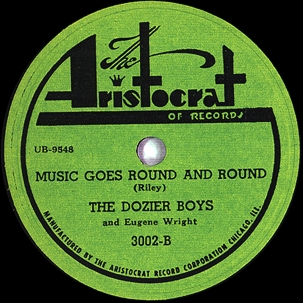
Eugene Teague brought his guitar, which is briefly audible at the beginning of "Music Goes Round and Round." Bill Minor sings the lead on "Big Time Baby." Solos on "Dawn Mist" are by Frank Robinson (alto sax), Sonny Blount (piano), Hobart Dotson (trumpet), and Melvin Scott (tenor sax). After the Dozier Boys' vocal chorus on "Music Goes Round and Round," the soloists are Hobart Dotson (trumpet), Melvin Scott (tenor sax), and Van Kelly (baritone sax).
The UB numbers (which were apparently never written down in the Aristocrat company files, leading every discographer until quite recently to confuse this session with U7156-U7159) indicate United Broadcasting Studios. Consequently "Big Time Baby" from this session (matrix mislisted as U7159) was reissued in February 2002 on Classics 5028, Andrew Tibbs 1947-1951. (Andrew Tibbs is, of course, not on this session—or on the previous one.)
Aristocrat used United Broadcasting occasionally. Wright says the session took place not long before he left town to join the Count Basie band (an event that took place around Christmas of 1948). The band broke up when he went on tour with Basie (who had asked him to substitute for Walter Page on at least one previous occasion). Wright returned to Chicago in the middle of 1949, going on to a long career working with various leaders, most famously Dave Brubeck, but it was the end of the road for the Dukes.
Other gigs were less uplifting. In mid-1949, Sonny and Tommy Hunter began playing in trios in Calumet City, a southern Chicago suburb, outside the territory of Local 208, known mainly for its strip joints. Few musicians would have been thrilled with the setting or the nature of the work, which was Sonny's major source of income for some time. Worse yet, the girls were White and the Mob, which controlled the clubs, dictated that Black bands had to play behind a curtain. More rewarding work came from the Club DeLisa, which he retained his connection with for several years. He wrote arrangements for the medium-sized Red Saunders band. Some musicians recall him spelling for Earl Washington in the Saunders band, but Saunders doesn't seem to have liked his playing and such opportunities were infrequent at best.
Theodore "Red" Saunders (d, ldr); Nick Cooper (tp); Fortunatus Paul "Fip" Ricard (tp); Sonny Cohn (tp); Harlan "Booby" Floyd (tb); John Avant (tb); Porter Kilbert (as); Everett Gaines (ts, as); Leon Washington (ts); McKinley Easton (bars); Earl Washington (p); Jimmy Richardson (b); George Floyd (voc); prob. George Kirby (voc); Sonny Blount (arr -1).
Chicago, c. December 1948
| SU-180 | Trust in Me (Wever-Schwartz-Ager) [GF voc] -1 | Supreme 1523-B | |
| SU-181 | Synthesis (Ventura) [ens voc] -1 | Supreme 1523-A | |
| SU-? | unidentified title ["Synthesis"] -1 | Night Train International CD 7027 | |
| SU-? | Legs Gettin' Bigger and Bigger [prob. GK, ens voc] | Night Train International CD 7013 |
Supreme 1523 was a 78 rpm single, released in 1949. Our basic information comes from Leadbitter, Fancourt, and Pelletier, Blues Records 1943-1970, Vol. 2 (1994 edition). Thanks to Anthony Barnett for pointing out this listing, which doesn't mention the vocalist on "Trust in Me" or the band scatting on "Synthesis." The Supreme labels give George Floyd's name. Floyd was a member of Fletcher Henderson band that was in residence at the Club DeLisa from Feburary 1946 through May 1947; he is advertised in the Chicago Defender of December 18, 1948 on the bill for a DeLisa show that included Red Saunders' band.
Balladeer George Floyd (born in Pelham, Georgia, on July 17, 1912) came to Chicago from Los Angeles with Fletcher Henderson in 1946. Floyd implied in an interview with Charles Walton that all of his sides for Supreme were made in LA; however, there is no evidence that the Red Saunders band ever traveled to the West Coast, and such a trip in 1948 would have required a substitute band at the DeLisa for at least a week. Floyd did travel to the West Coast later when he recorded four more sides for Supreme (matrix numbers SU-210 through SU-213) with a small group led by Henderson; Lord gives February to April 1949 as the date and LA as the location, which make sense because the musicians were regulars on the LA scene. When his style of ballad singing went out of fashion in the early 1950s, George Floyd took a job with a Cadillac dealership. He died in Chicago on April 16, 2000.
Leadbitter et al.'s listings for Red Saunders, like other mainstream discographies, do not give arranger credits. They also make some noticeable mistakes. Fip Ricard is called "Flip Richard" and John Avant goes as "Joe Avant" throughout the Leadbitter entries. Ricard is generally referred to as "Flip" in discographies, though he was actually known as Fip, according to his interview in Jazz Monthly, February 1964.
Chris Trent believes that "Trust in Me" was arranged by Sonny Blount, and rlc concurs. The arrangement is very much like the arrangements for "Hour of Parting" and other ballads from Sun Ra's famous Arkestra session of March 6, 1959.
"Synthesis" is an orthodox bebop number, written by Charlie Ventura during his "bop for the people" phase. The evidence for Sonny Blount's involvement lies in the meticulous arch form: vocal ensemble-alto sax solo-trumpet solo-contrasting instrumental ensemble-tenor sax solo-baritone sax solo-vocal ensemble. Compare "Super Blonde," as recorded by Sun Ra's Arkestra probably on June 16, 1956.
The piece called "Synthesis" on 1995 on Night Train International CD 7027, Music from and Inspired by Devil in a Blue Dress, is an entirely different performance of a different piece! (The Night Train CD is a various-artists collection, issued in 1995; the other tracks are by Jimmy Witherspoon, Lowell Fulson, Johnny Otis, Charles Brown, Lloyd Glenn, Frantic Faye Thomas, etc.) The second "Synthesis" is also a bop instrumental, but here the opening is martial trumpets answered by the drums, then a chorus led by the tenor and baritone saxes, with dissonant flourishes from the piano on the bridge. The second chorus is mostly call and response between muted trumpets and the saxes. The third chorus features a baritone sax solo by Mac Easton. The fourth is a trumpet-dominated ensemble with more dissonant piano sprinkles; the final eight bars are a sax-led ensemble (that more than slightly resembles 1956 Sun Arkestra scoring!), then a brief muted trumpet solo (probably by Fip Ricard), then a pretty typical bebop tag.
"Legs Gettin' Bigger and Bigger" was included in Night Train International CD 7013, Swing Time Jive, a various artists collection derived from the Down Beat, Swing Time, Exclusive, and Superior labels. Other artists include Ray Charles, Joe Liggins, Mabel Scott, and the Basin Street Boys. The CD was released in 1995.
The Night Train notes claim that "Legs" was recorded in Los Angeles, but they also claim that the dates with Bunky Redding were cut in LA, so they should not be taken seriously. Presumably "Legs" is from the same session as the others. There is no evidence that it was released at the time. The lead vocalist on this jivey number is definitely not George Floyd. The best bet would be George Kirby, a comic who did impressions at the Club DeLisa. Kirby was actually a good singer; fortunately for those of us who never saw him live, he recorded one vocal that is actually credited on the label ("Ice Man Blues" with Tom Archia). "Legs" includes a trombone solo (probably by Johnny Avant) and an alto sax solo by Porter Kilbert. It has a typical smooth Saunders arrangement, with no obvious signs of Sonny Blount.
Herman “Sonny” Blount (p); unidentified (eg); poss. Wilbur Ware (b).
Sonny Blount's apartment, Chicago, June 4, 1949
| Upstairs | Transparency 0316 [CD, Disk 4] | ||
| Just One of Those Things (Porter) | Transparency 0316 [CD, Disk 4] |
In his notes to the Transparency box, Michael Anderson suggests Calvin Newborn on guitar. Newborn recorded with Sun Ra in 1957 (see below) and again in 1962, after the Arkestra had moved to New York. But in 1949 he was based in Memphis, Tennessee.
Herman “Sonny” Blount (voc -1, p)
Sonny Blount's apartment, Chicago, July 21, 1949
| I've Got Some New Blues | Transparency 0316 [CD, Disk 3] | ||
| Smile (Chaplin)-1 | Transparency 0316 [CD, Disk 4] | ||
| Old Man River (Kern)-1 | Transparency 0316 [CD, Disk 4] |
According to Michael Anderson, "I've Got Some New Blues" also shows the influence of Mary Lou Williams. "Smile" and "Old Man River" feature Sonny's singing.
Herman “Sonny” Blount (voc -1, p)
Sonny Blount's apartment, Chicago, July 23, 1949
| Song Introduction | Transparency 0316 [CD, disk 4] | ||
| Somewhere over the Rainbow (Arlen-Harburg) | Transparency 0316 [CD, disk 4] | ||
| Out of Nowhere (Green) | Transparency 0316 [CD, disk 4] |
Herman "Sonny" Blount (p); unidentified (eg); unidentified (b).
Beige Room, Chicago, August 17, 1949
| You Go to My Head (Coots-Gillespie) | Transparency 0316 [CD, disk 4] | ||
| Blue Chicago Blues (Blount) | Transparency 0316 [CD, disk 4] |
In his notes to Transparency set, Michael Anderson places this live recording at Birdland, but in 1949 that club (in the Pershing Hotel basement) was called the Beige Room. He puts Calvin Newborn on guitar and Wilbur Ware on bass.
Herman "Sonny" Blount (p, voc).
Chicago, 1949
| Tony's Wife (Adamson-Lane) | Norton CED-352 | ||
| Stuff like That There (Livingston-Evans) | Norton CED-353 |
Another tape that Sonny recorded in 1949 features his own vocals on two popular songs—both highly uncharacteristic of his future work. Norton CED-352, Sun Ra and his Arkestra: Interplanetary Melodies, was released in 2009, as was Norton CED-353, The Second Stop Is Jupiter. Both were anthologies of performances by vocalists and vocal groups recording under Sun Ra's direction.
Dorothy Donegan (p) with Red Saunders (d; ldr); Harlan "Booby" Floyd (tb); John Avant (tb); Porter Kilbert (as); Leon Washington (ts); McKinley Easton (bars); Jimmy Richardson (b); prob. Sonny Blount (arr).
Columbia Studio, Chicago, May or early June 1950
| CCO 5156 | D. D. D. [Dorothy Donegan's Doghouse] (Saunders-R. Alan) | Columbia 30223 | |
| CCO 5158 | Ridin' Boogie (Donegan-J. Todd) | Columbia 30223 |
Before we put it on our Red Saunders page, this session had never been mentioned in a jazz discography. Dan Kochakian owns a copy of Columbia 30223, a 78-rpm single issued around September 23, 1950, according to First Pressings.. Obviously, the recording date was slightly earlier than the next Saunders session. Personnel identified by ear; there is a baritone sax solo (definitely Mac Easton) on "D.D.D."; "Ridin' Boogie" includes a tenor solo (Leon Washington) and a muted trombone solo (this must be by "Booby" Floyd as Johnny Avant was into J. J. Johnson). The arrangement is consistent with Sonny Blount's work at the time, and Sun Ra later said in interviews that he admired Dorothy Donegan's playing. It is not known whether additional unissued titles were recorded at this session—but that missing matrix number (CCO 5157) is tempting.
Adding interest to the next session is the presence of Oran "Hot Lips" Page, the famous Swing soloist and blues singer (1908 - 1954). Lips was in Chicago in March 1950, when his band headlined at the Regal Theater (1 week contract posted with Local 208 on March 2). On April 6, he posted a four-week contract with the Brass Rail (a major jazz establishment in the Loop.) We're not quite sure what he was doing in town in June, when he sat in for Fip Ricard, but he was under contract to Columbia at the time, so it may have been the record company's idea. Unfortunately, Lips got no solos or vocal features.
Red Saunders (d, ldr); Oran "Hot Lips" Page (tp); Sonny Cohn (tp); Harlan "Booby" Floyd (tb); John Avant (tb); Porter Kilbert (as); Leon Washington (ts); McKinley Easton (bars); Earl Washington (p); Jimmy Richardson (b); Jumpin' Joe Williams (voc); Little Miss Sharecropper [LaVern Baker] (voc); Sonny Blount (arr -1).
Columbia Studio, Chicago, June 15, 1950
| CCO 5170 | Blow, "Mr. Low-Blow" [JW, ens voc] -1 (Saunders-D. Williams) | Columbia 30218 | |
| CCO 5171 | Sharecropper Boogie [LB voc] | Columbia [unissued] | |
| CCO 5172 | CHI [Chicago] [JW voc] -1 | Epic E3K 48912 [CD] | |
| CCO 5173 | Lyin' Girl Blues [JW voc] (Saunders-L. Washington-J. Williams) -1 | Columbia 30218, Epic E3K 48912 [CD] |
Columbia 30218 was a 78 rpm single released in 1950. Little Miss Sharecropper was working the Club DeLisa with Red in June 1950, and there is a mention of this session in Billboard for July 1950. Epic E3K 48912 was a collection on 3 CDs released in 1993 and titled The OKeh Rhythm & Blues Story 1949-1957. Session information from Leadbitter, Fancourt, and Pelletier with some help from the Epic booklet. Leadbitter et al. give the matrix numbers as 5120-5123 but on the original labels of Columbia 30218, the matrices are given as 5170 and 5173. Lord lists this session (with the correct matrix numbers) as though it was led by Hot Lips Page!
According to Chris Trent, the voicings on "CHI" and "Lyin' Girl Blues" (especially in the saxes) indicate that Sonny Blount arranged them. In rlc's opinion, "Blow Mr. Low-Blow," though more basic R&B with a long featured solo by Mac Easton, could also be Sonny's handiwork. "Sharecropper Boogie" remains unissued and is unavailable for examination.
Columbia would use singer "Jumpin'" Joe Williams on many of Red's sessions for Columbia and OKeh. Born Joseph Goreed in Cordele, Georgia, on December 12, 1918, Joe came to Chicago with his family as a teenager. After gaining experience in a gospel singing group, he changed his name to Joe Williams and used his smooth baritone primarily in ballad singing. In a questionnaire for one of Leonard Feather's jazz encyclopedias (the material is now at the Institute for Jazz Studies in Newark, NJ; our thanks to John Szwed for checking the files there), Red Saunders took credit for encouraging Joe Williams to sing the blues. Williams had worked many a night at the Club DeLisa with Red's backing before Columbia saw fit to include him on a Red Saunders recording session. Even though Columbia and OKeh did not reap any major commercial success from the combination (Joe did not hit the big time until he went on the road with Count Basie at the end of 1954), the decision made perfect sense artistically.
Herman "Sonny" Blount (org); unidentified (voc).
Chicago, November 11, 1950
| Pennies from Heaven | Transparency 0316 [CD, disk 5] | ||
| You and the Night and the Music | Transparency 0316 [CD, disk 5] |
With access to a church or theater organ, Sonny recorded two tracks with an unidentified male vocalist, a baritone who sounds a little like Danny Knight.
Herman "Sonny" Blount (org); John Jenkins (as).
Chicago, November 11, 1950
| Cocktails for Two (Coslow-Johnston) | Transparency 0316 [CD, disk 5] | ||
| The Phantom | Transparency 0316 [CD, disk 5] |
In the same venue, Sonny recorded two tracks with John Jenkins, one of his early rehearsal partners. Jenkins subsequently recorded for Prestige, Blue Note, and Riverside.
Miss Sharecropper [LaVern Baker] (voc) with Red Saunders (d, ldr); Porter Kilbert (as); Leon Washington (ts); McKinley Easton (as -1; bars -2); Earl Washington (p); Jimmy Richardson (b); Sonny Blount (arr).
Chicago, December 1950 or January 1951
| NSC668 | Take out Some Time -1 | National 9153, Savoy SJL2256 | |
| NSC669 | I've Tried -1 | National 9151, Savoy SJL2256 | |
| NSC670 | How Long (Carr) -2 | National 9151 | |
| NSC671 | I Want to Rock -2 | National 9153, Savoy SJL2256 |
LaVern Baker was born Delores LaVern Baker in Chicago. When she began to hit it big, she was married to Eugene Williams and was going under the name Delores Williams. She was first mentioned in advertisements on September 28 and October 19, 1946, when the Defender ran ads for the Timber Tap Lounge (217 East 31st), proprietor George Woods, with the Timber Tap Two as featured artists; the undercard consisted of a shake dancer and "Little Miss Sharecropper." LaVern Baker said that she signed a contract with the Club DeLisa in November 1946, and there is no reason to doubt this. The first mention of her name in an advertisement for that club was on February 8, 1947, when she was playing in the Favorites of 1947 show, under the name of "Midget LaVern" (actually spelled "Laverine," but that is well within the confidence limits for nightclub ads of the era). She was backed by the Fletcher Henderson band, with Sonny Blount at the piano.
In a Brookmont Lounge ad for August 7, 1948, she was listed as "Sharecopper, Queen of the Blues." On February 25, 1949, she cut her first recording; she sang "I Wonder Baby" on a session led by Eddie "Sugarman" Penigar (Victor 22-0016). She was listed on the label as Little Miss Sharecropper and in the company files as "D. L. McMurley" (see our Sax Mallard discography for details). On April 23, 1949, she was referred to as "Little Miss Share Cropper, Song Stylist" (the handle was blatantly patterned after Little Miss Cornshucks) in a Blue Dahlia ad. There were adverts for her in the Chicago Defender, all as Little Miss Sharecropper, pretty regularly thereafter up to the Fall of 1951: for instance, a breakfast dance at the Miramar Ballroom, December 24, 1949 (with Wardell Gray's Sextet); at the Club DeLisa on August 12, 1950, at Ralph's Club on October 21, 1950, at Joe's Rendezvous Lounge in February 1951, at the Indiana Theatre on September 15, 1951 (a midnight "Battle of Blues" with Memphis Minnie), and at the Crown Propeller Lounge, where she was the "new headliner" on September 22. She appears to have moved to Detroit after that point. She made one recording with the Detroit-based band Maurice King and his Wolverines (March 1951 for OKeh, supposedly in New York City; it was released on OKeh 6800, and on that occasion she went as Bea Baker); after that she began performing as LaVern Baker. In 1952 she recorded with Todd Rhodes.
Because of her later Detroit connections, some sources have incorrectly given Detroit as the location for this session and ca. 1950 as the date. Lord says ca. late 1950 and specifies no location; he renders "I've Tried" as "I'll Try."
The personnel were identified by ear. This is clearly the Red Saunders unit of the period. Porter Kilbert is featured on "Take out Some Time." Mac Easton solos on "I Want to Rock" and "How Long." Earl Washington does the Roosevelt Sykes thing on "I've Tried" and boogies on "I Want to Rock." The sax section writing on "Take out Some Time" (almost evanescent) and "I've Tried" suggests Sonny's involvement. It is unfortunate that "How Long" was never reissued, as it has prominent drumming from Red and concludes with a drum solo.
National 9151 and 9153 were 78-rpm singles released in 1951. The label was faltering at the time—its only known release after 9153 would be 9158. Savoy SJL2256 was an LP released in the early 1980s, a various artists collection titled Ladies Sing the Blues, Volume 2, in the Roots of Rock'n'Roll Series, #12. Our thanks to James Wolf for information about the Savoy LP.
All National matrix numbers were in chronological sequence; NSC650 and 651 came from a Kate Smith date on November 27, 1950.
Some accounts claim that around 1950 Sunny became seriously depressed. In any event, he was giving a lot of thought to non-musical matters: "I was busy with spirit things," he once said about this period. "I wasn't even really here." His concerns about racism and man's inhumanity to man were coming together with his extensive readings from books about the occult, his analysis of the hidden meanings to be found in the Bible, and old anthropological speculations to the effect that Egypt was the source of all civilization and we are all "children of the sun."
Sonny Blount was in his mid-30s now. By that age a great many jazz musicians have already said whatever they're going to say. He had played piano, been in charge of the band book, even led his own bands. He had steady musical employment and did a fair amount of arranging on the side. Some musicians considered him a weirdo. Others saw him as a studious type who said little and spent a lot of time at the piano (Gene Wright compared him to John Lewis). His compositions had always kept up with the latest developments in Swing, but pieces like Fission and Thermodynamics weren't as futuristic as their titles made them sound. When bebop came along, Sonny listened carefully and took what he wanted from it. Junior Mance recalls, for instance, that Sonny was the first pianist in Chicago to play like Bud Powell. But while there are traces of the Powell influence on Sunny's 1956 recordings (most notably "Urnack" and "Future"), it's a lot easier to hear Fats Waller than Bud Powell in his later playing. Sunny was also paying close attention to the eccentric local pianist Willie Jones (1920 - 1977). Jones had evolved a sound about halfway between Milt Buckner and Cecil Taylor; he was known as "The Piano Wrecker" because of his imposing size and pulverizing attack on the instrument. Still, it was hard to identify a Sonny Blount sound. His earliest appearances in the Chicago recording studios would not make anyone think of either Bud Powell or Willie Jones.
While countless working musicians have been satisfied with these kinds of results, Sonny had bigger goals. In 1950 or 1951, he started a band to play his own, frankly far-out music. He called it the Space Trio: one charter member was Laurdine "Pat" Patrick (1929 - 1991), who played alto and baritone sax. The drum chair was occupied on some occasions by Tommy Hunter. On other occasions it was taken by Robert Barry, who would soon emerge as a leading bebop drummer in town. (We formerly listed the "Treasure Hunt" tape of trio performances as coming from 1951, but Michael Anderson has found the other three tracks from the same rehearsal and much more accurately dated them to July 23, 1955. So see below...)
Herman "Sonny" Blount (p -1, celeste -2, Solovox -3); Leo Blevins (eg -4); Wilbur Ware (b -5).
Chicago, February 6, 1951
| The Nearness of You -1, 2, 3, 5 | Transparency 0316 [CD, disk 5] | |||
| Sunny's Place #1 (Blount) -1, 2, 3, 5 | Transparency 0316 [CD, disk 5] | |||
| The Man I Love (Gershwin) -1, 2, 3, 4, 5 | Transparency 0316 [CD, disk 5] | |||
| All Alone (Blount) -1, 2 | Transparency 0316 [CD, disk 5] |
Herman "Sonny" Blount (org); John Jenkins (as); Wilbur Ware (b).
Chicago, March 17, 1951
| Sunny's Place #2 (Blount) | Transparency 0316 [CD, disk 5] |
Sonny fell in with a secret society on the South Side of Chicago. It preached an unusual variety of Black Nationalism, admonishing Black men to recognizethe importance of outer space if they were to better their lot in the future. From the sparse and self-serving accounts we've been given, we don't know how much Sonny learned from the other members and how much they picked up from him. We do know that Alton Abraham, who was to become the Arkestra's manager and head of Sun Ra's record label, was affiliated with this group, as were his brother Artis, his friend James Bryant, Lawrence Allen, tenor saxophonist T. S. Mims, Sr., and others who would later provide financial backing for recordings. The secret society eventually developed more public manifestations called Thmei Research and Saturn Research. Sound was within the purview of Saturn Research. Thmei was concerned with theosophy and the occult.
Abraham and his friends may have had celestial yearnings but they were a rough bunch. Musicians from that period appreciate Abraham's effectiveness at getting bookings, but many thought he was a gangster. It's not hard to understand why, when we learn that on one occasion a trumpet player showed up drunk and messed up one ofSunny's rehearsals. Lawrence Allen took care of the problem by shoving a loaded pistol under the musician's nose and telling him, "Time to go home and read your Bible."
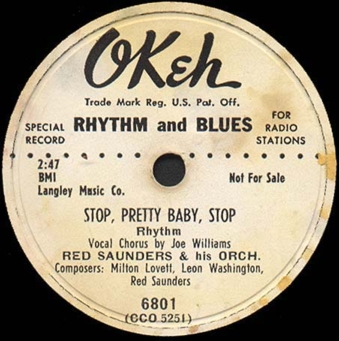
Red Saunders (d, ldr); Fip Ricard (tp); Sonny Cohn (tp); Harlan "Booby" Floyd (tb); John Avant (tb); Porter Kilbert (as); Leon Washington (ts); McKinley Easton (bars); Earl Washington (p); Jimmy Richardson (b); Jumpin' Joe Williams (voc); Sonny Blount (arr -1).
Columbia Studios, Chicago, April 20, 1951
| CCO 5251 | Stop Pretty Baby Stop (Lovett-L. Washington-Saunders) [JW, ens voc] -1 | OKeh 6801 | |
| CCO 5252 | Mistreatin' Woman Blues (Saunders-Washington) ^ [JW voc] -1 | OKeh 7061, Moonshine LP 114 | |
| CCO 5253 | Week Day Blues [JW voc] (J. Woods-Saunders) -1 | OKeh 6834, Moonshine LP 114, Epic E3K 48912 [CD] | |
| CCO 5254 | 4 A.M. (L. Washington-M. Easton-Saunders) -1 | OKeh 6801 |
OKeh 6801 was a single, released on 45, 78, and 33(!) rpm. (An advert in Cash Box, July 21, 1951, which kicked off the revived OKeh label indicates that OKeh 6800 through 6804 were all released on 33 1/3 rpm singles. Columbia and Okeh must have quickly terminated that experiment...) OKeh 6801 was was scheduled for release on June 4, 1951 and apparently came out in early July (it was one of the 5 leadoff singles for the newly revived imprint). "Stop" was the A side, "4 A. M." the B side. (The title on the label was just "4 A.M.," not "4 A.M. Blues" as previous discographies have it.) OKeh 6834 was a single, released on 45 and 78 rpm, probably also in 1951. OKeh 7061 was a 45 rpm single, released around September 10, 1955; "Mistreatin' Woman" was the B side.
Moonshine 114 was a Dutch various artists LP titled Leapin' on Lenox. Epic E3K 48912 was a collection of 3 CDs released in 1993 and entitled The OKeh Rhythm & Blues Story 1949-1957. Our session information is from Leadbitter, Fancourt, and Pelletier, 1994 edition, and the Epic booklet.
According to Chris Trent, the chord voicings and treatment of rhythm on "Week Day Blues" indicate Sonny Blount's involvement. "Stop Pretty Baby Stop" and "4 A. M. Blues" have comparable touches, as does "Mistreatin' Woman Blues." "Mistreatin'" has no horn solos but it does include some drum breaks for Red.
Red Saunders (d, ldr); Sonny Cohn (tp); Harlan "Booby" Floyd (tb); John Avant (tb); Porter Kilbert (as); Leon Washington (ts); McKinley Easton (bars); Earl Washington (p); Jimmy Richardson (b); Jumpin' Joe Williams (voc); June Davis (voc); Sonny Blount (arr).
Columbia Studio, Chicago, August 24, 1951
| CCO 5278 | Last Night's Party^ [JW voc] | OKeh 6914 | |
| CCO 5279 | Hey Bartender^ [JW voc] (R. Hall-Saunders) | OKeh 7061, Moonshine LP 114, Memories Record Prevue MEP-1003, Epic E3K 48912 [CD], Columbia CK40799 [CD] | |
| CCO 5280 | Boot 'em Up (Saunders-L. Washington) | OKeh 6862, Columbia [Can] C-1926 | |
| CCO 5281 | Sugar Bounce (Toombs-Sweet) [JW, ens voc] | OKeh 6834, Moonshine LP 114 | |
| CCO 5282 | Gentle Lover [JD voc] | OKeh 6856 | |
| CCO 5283 | J.D. Blues [JD voc] | OKeh 6856 |
OKeh 6856 was a single released around April 5, 1952; "Gentle Lover" was the A side. OKeh 6862 was a single released in February 1952 on both 78 and 45 rpm; "Boot 'em Up" was the B side. (On the strength of "Hambone," the A-side which was Red's only hit record, there was also a Canadian release.) OKeh 6834 was a single released on 78 and 45 rpm, probably in late 1951. OKeh 6914 was a single released on 45 and 78 rpm, probably in late 1952. OKeh 7061 was a 45 rpm single released around September 10, 1955.

Although the booklet to the Epic box set claims to include an alternate take of "Hey Bartender," all releases have used the same take. The Epic reissues give the title as "Hey Bartender Buy That Man a Drink" but the short form is what appeared on the original OKeh release.
Surely the weirdest reissue of the title was on the B side of a red vinyl EP, Memories Record Prevue MEP-1003. It was incorrectly credited there to "Big Joe Williams & The Red Saunders Orch."; its sidemate was "Hillybilly Blues" by Eddie Clearwater. The A side contained the Mercury and Watch versions of "Bald Head" by Roy Byrd (better known as Professor Longhair).
Epic E3K 48912 was a collection of 3 CDs released in 1993 and titled The OKeh Rhythm & Blues Story 1949-1957. According to the Epic booklet, the version of "Hey Bartender" released on CD is an alternate take. Columbia CK40799 is a various-artists CD released in 1996 under the title Columbia Jazz Masterpieces—The 1950s: The Singers; other performers include Hot Lips Page, Dolores Hawkins, Babs Gonzalez, and Louis Armstrong (information from the online All-Music Guide).
Other sources of information on this session: Leadbitter et al., 1994 edition, a doowop "repro" catalog provided by Anthony Barnett, and the Epic booklet.
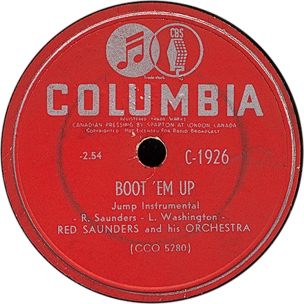
Leadbitter left out the last two items from this session, both of which featured June Davis. Jepsen did include her sides, and our session information about them is from that source. To our knowledge, June Davis never worked the Club DeLisa. Our first evidence of her comes from 1940, when she worked with a rehearsal band led by pianist Frank Melrose. Three privately recorded sides survive with her vocals on them; they were not commercially relased until 2006. Of these, "Bluesiana" and "Have You Ever Felt That Way" are obvious imitations of Billie Holiday. "If You'se a Viper," a duet with Melrose, is in a lighter, more pop-oriented style much closer to her recorded work with Red Saunders. June Davis was singing at El Grotto (64th and Cottage Grove, the predecessor to the Beige Room and Budland) in December 1946. She did not record again until this Red Saunders session.
"Last Night's Party" is early rock and roll with minimal writing, but according to ChrisTrent "the bottom-heavy sound of the band" suggests it may be Sonny Blount's work; rlc concurs. The piece shows distinct and early New Orleanian influence and somewhat resembles Sun Ra's 1958 composition "Great Balls of Fire." "Hey Bartender" incorporates a favorite Ra riff drawn from "Saint Louis Blues" and the rhythm bears Ra fingerprints as well. "Boot 'em Up" is a fluent but obvious imitation of the Basie band, circa 1938; but note the blatting trombone pedal under the ensemble, just before the false ending. Sonny could have lifted this feature from the Red Allen jump band of the 1940s with Don Stovall, whom he is known to have admired. "Sugar Bounce" mixes in some bop licks, and commits outright thievery from "Jumpin' with Symphony Sid"; note the sax ensemble as the piece fades. Sonny's involvement in "Gentle Lover" seems clear; "J. D. Blues" is an informal blues, and there his contributions, if any, would be harder to trace.
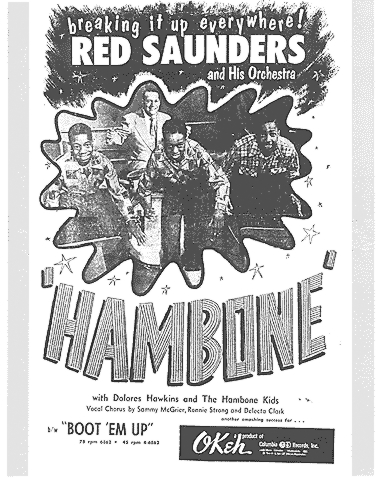


Red Saunders (d, ldr); Fip Ricard (tp); Sonny Cohn (tp); Harlan "Booby" Floyd (tb); John Avant (tb); Riley Hampton (as); Leon Washington (ts); McKinley Easton (bars); Earl Washington (p); unidentified (g -1) Jimmy Richardson (b); Dolores Hawkins (voc, whistling -1); The Hambone Kids: Delecta "Dee" Clark, Sammy McGrier, Ronny Strong (voc, hamboning -1); Sonny Blount (arr -1).
Columbia Studio, Chicago, January 18, 1952
| CCO 5314 | Hambone* (Saunders-L. Washington-H. McGrier) -1 | OKeh 6862, Columbia [Can] C-1926 | |
| CCO 5314 [alt.], JZSP 59257 | Hambone* (Saunders-L. Washington-H. McGrier) -1 | OKeh 7166, OKeh 7282, Epic LP 22125, Epic EG 37649, Edsel ED 149, Edsel ED CD 149, Century CD # | |
| CCO 5315 | La Raspa (trad.) | OKeh 6884 |
OKeh 6862 was a single issued on 45 rpm and 78 rpm in February 1952 (large display ads in Billboard and Cash Box showed the Kids performing in front of Red and his drums). "Hambone" was the A side. Dolores Hawkins was a singer under contract to OKeh; she recorded with Red Saunders at just this one session. her The originally issued take of "Hambone" xsincluded Dolores Hawkins' whistling but lacked her vocal interjections; it also included a brief passage for the full band and a tenor sax solo. The Kids' rhythmic practice is "hamboning" or "patting juba": slapping various body parts as a substitute for drumming. Dee Clark, as Sammy McGrier pointed out in Pruter's book, also stamped with his heel on the 2nd and 4th beats. Horace McGrier Sr. wrote two verses for the song, though he is not credited on the label (shame, shame).
"Hambone" was Red Saunders' only hit: it went to #20 on the R&B charts for one week, and according to an October 1952 article in Billboard, "OKeh Records hit the 80,000 figure with the Red Saunders waxing." Red's comment to Art Hodes was succinct: "It got us this house—the down payment." The single sold well enough to justify a Canadian release (we're pretty sure it's the only one that Saunders ever got); on the Canadian 78 the matrix number for "Hambone" carries suffix -2A.
What purported to be a straight reissue of "Hambone" appeared as the A side of OKeh 7166 (in 1963) and again on OKeh 7282 (in 1967); both were 45-rpm singles. The occasion for the reissue is made clear on the label to 7166: "As Featured by Sandy Becker on His TV show 'Sandy's Hour'." The JZSP number is the contemporary Columbia master number that appears on the label of 7166. In fact the reissues used an alternate take of "Hambone," running 2:13, in which the Hambone Kids and Dolores Hawkins are accompanied throughout by guitar, bass, and drums only; the rest of the band contributes nothing, except shouts of "Hambone!" at the beginning and end of the piece. Thanks to Dan Ferone for providing label scans of OKeh 7166. Thanks to John McCarthy for pointing out that the reissue of "Hambone" was on OKeh 7282as well as OKeh 7166 as reported in Leadbitter, Fancourt, and Pelletier's blues discography, and for providing a dub of OKeh 7282.
The flip side of both reissue singles was "Rumble Mambo" by Link Wray and the Wraymen, obviously not a Red Saunders number (as erroneously stated in Leadbitter). Our thanks to the online Link Wray discography (http://pages.prodigy.com/cyclops/linkwray.html) for the release dates (Robert Pruter mentions the 1963 reissue of "Hambone" in Doowop: The Chicago Scene).
The coupling of "Hambone" and "Rumble Mambo" (it would be interesting to know the record-company logic behind this...) has caused confusion in the Link Wray camp as well. Jeff Hall points out that a collection of what were supposed to be 16 of Link Wray's late-1950s recordings was issued on in England on Edsel ED 149 [LP] and ED CD 149 in 1989. The collection was titled Link Wray & The Raymen. It included the alternate take of "Hambone" as a Link Wray performance! A subsequent CD collection of Wray material from this period on the Sony label avoided this blunder.
The alternate take was probably used on Epic LP 22125 (a 2-LP set of OKeh Rhythm and Blues released in 1982) and definitely on Epic EG 37649, Okeh Rhythm & Blues (apparently a reissue of this 2-LP set). On a recent bootleg doo-wop "repro" single, "Hambone" appears as the A side (the B side is "Zeke'l Zeke'l" from the next session); the "repro" is billed as derived from OKeh 6862. A 1990s compilation CD, Pop Fifties Vol. 7, includes "Hambone" (in the company of "Cry" by Johnny Ray, "The Twelfth of Never" by Johnny Mathis, and other distinctly non-R&B material); it was issued by Century Records in Canada for use by radio stations. That version of "Hambone" is said to have been taken from OKeh 6862; we have not been able to check the CD.
OKeh 6884 was a single issued on 45 and 78 rpm in May 1952. "La Raspa" was the B side. Chris Trent is sure that Sonny Blount did not arrange "La Raspa," which he describes as "a medley of European and Latin American tunes for which [Sonny] could never have been responsible." Clearly true. "La Raspa" is clumsy march music without swing or convincing Latin rhythm, and the sectional writing is incompetent. "Hambone," on the other hand, is the historical intermediary between the "band vocals" of the Swing era and such numbers as "It's Christmas Time," which Sunny recorded with a group called the Qualities in 1959—as well as Sunny's ubiquitous space chants.

Red Saunders (d, ldr); Fip Ricard (tp); Sonny Cohn (tp); Harlan "Booby" Floyd (tb); John Avant (tb); Riley Hampton (as); Leon Washington (ts); McKinley Easton (bars); Earl Washington (p); unidentified (eg -2); Jimmy Richardson (b); The Hambone Kids: Delecta "Dee" Clark, Sammy McGrier, Ronny Strong (voc, hamboning -1); prob. Sonny Blount (arr -1).
Columbia Studio, Chicago, April 3, 1952
| CCO 5330 | Zeke'l Zeke'l (Saunders-Dahl) [HK voc] -1, 2 | OKeh 6884 | |
| CCO 5331 | Piece A-Puddin' (Toombs) ^ [HK voc] -1 | OKeh 6914 | |
| CCO 5332 | Portrait of Vintage P. McWorm | OKeh (unissued) |
OKeh 6884 was a single, issued on 45 and 78 rpm in May 1952. "Zeke'l Zeke'l" was the A side. "Zeke'l Zeke'l" was reissued on the B side of a bootleg "repro" single with "Hambone" as the A side. OKeh 6914 was a single, released in late 1952 in 78 and 45 rpm. Track and personnel information from Leadbitter et al., who give no vocal credits. An uncredited electric guitar is prominent on "Zeke'l Zeke'l." The hamboning on "Piece-A-Puddin'" occurs only at the beginning.
"Piece A-Puddin'" was probably arranged by Sonny Blount, according to Chris Trent. The writing resembles Ra's arrangement for "The Sun Man Speaks." rlc concurs, citing the "heavy bottom" to the arrangement. Sonny's involvement in "Zeke'l Zeke'l" is also likely. The unissued track has obviously not been checked.
Herman "Sonny" Blount (p); Laurdine "Pat" Patrick Jr. (bars).
Chicago, June 9, 1952
| Wonderful You | Transparency 0316 [CD, disk 6] | ||
| A Place in My Heart | Transparency 0316 [CD, disk 6] |
The oldest surving collaboration between Sunny and Pat Patrick consists of two tracks from a rehearsal in 1952.
1952 seems to have been a year for name changes. On February 18, Fritz Jones appeared in front of a Cook County judge; he emerged from the courtroom as Ahmad Jamal. Sunny would follow suit 8 months later, proclaiming his vocation: that he was a citizen of Saturn, not of Planet Earth; that he was not human, but rather of an angel race; that he was to serve as the Cosmic Communicator, bringing the Creator's message to benighted Earthlings. On October 20, 1952, he officially changed his name to Le Sony'r Ra—Ra after the Egyptian sun god, Sony for reasons both heliocentric and mundane, and an extra "r" to bring the total up to a cosmically significant nine letters. This was the name that appeared on his passport. With characteristic modesty, he explained that he went through the legal rigmarole because "Jesus Christ should have registered himself with the authorities. Then he wouldn't have had any trouble." Sun Ra (in earlier days, Le Sun Ra) was technically his stage name.
He deliberately concealed his former life. In Chicago, where he had been known as Sonny Blount, this was not always feasible. But to audiences that hadn't known him earlier in his career, he would say that he was never really named Herman Blount, that he had always used other names, that the name "didn't have no rhythm" anyhow. He spoke rarely, if at all, about his roots in Birmingham. (Local 208 never forgot his name; its officials would know him as Herman Blount throughout his stay in Chicago, and he may even have signed some union contracts using his old name.) In time he would rename his band the Arkestra (a respelling that just happens to include "Ra" both forwards and backwards).
1952 wouldn't be such a good year for Sunny's young protégé Pat Patrick. The Board meeting minutes of Local 208 often recorded requests for personal loans from musicians; these were invariably turned down.
Member Laurdine Patrick appeared before the Board requesting a loan of $512.00 with which to purchase a saxophone, clarinet, and cases. He stated that his instruments were stolen last August.
On motion, the request was denied. (November 20, 1952, p. 1)
In March 1953, Patrick was in hot water with Local 208, making an appearance on March 5 "to show cause why he should not be fined, suspended, or expelled" on account of playing a dance at Englewood High School on February 17.
Patrick was then enrolled at Florida A&M University; in the summer of 1953 he would return to rehearsing with Sun Ra as well as performing with Paul Bascomb's combo (see our Parrot page for the latter).
1953 was the year of the arrangements. Sunny was making no commercial recordings of his own, and probably didn't feel that his experimental ensemble was ready to make them. But he was willing now to put his stamp on arrangements written for others, to a degree not previously heard. His name did not appear on a single record label in 1953—in one case the band's didn't either—but Red Saunders was now recording his aggressively "modern" arrangements: "Voodoo Blues," "It's Raining Again," "Summertime." And the opening bars of "Call My Baby" announce, for all who care to hear, that Sun Ra has arrived.
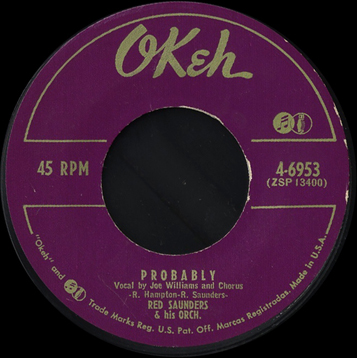
Red Saunders (d, ldr); Fip Ricard (tp); Sonny Cohn (tp); Harlan "Booby" Floyd (tb); John Avant (tb); Riley Hampton (as; cl -1); Leon Washington (ts; cl -1); McKinley Easton (bars, as; cl -1); Earl Washington (p); Jimmy Richardson (b); Joe Williams (voc); unidentified vocal group (backing voc); Sun Ra (arr).
Columbia Studio, Chicago, January 21, 1953
| CCO 5400, ZSP 13401 | Mambo in Trumpet (Salamanca) [ens grunts] | OKeh 6953 | |
| CCO 5401 | Honky Tonk Train Blues (Meade Lux Lewis) -1 | Columbia/Legacy CK64988 [CD] | |
| CCO 5402, ZSP 13400 | Probably (Hampton-Saunders) [JW, ? voc] | OKeh 6953 | |
| CCO 5403 | Voodoo Blues (Saunders-P. Williams) [JW, ? voc] | Epic E3K 48912 [CD] |
OKeh 6953 was a single released in April 1953, in both 78 and 45 rpm versions. By this time, Columiba had started its ZSP series for items that the company mastered and pressed; both sides of 6953 carry ZSP numbers in place of CCO numbers. Epic E3K 48912 was a collection of 3 CDs released in 1993 and titled The OKeh Rhythm & Blues Story 1949-1957. Columbia/ Legacy CK-64988 is a CD titled Juke Joint Jump: A Boogie Woogie Celebration; it was released in October 1996. Our basic information about these tracks draws from Leadbitter, Fancourt, and Pelletier, Blues Records 1943-1970 L-Z, Vol. 2, 1994 edition. Leadbitter et al. miss the vocal group (apparently 4 singers) on "Voodoo Blues" (they do get cited for "Probably," where the original label mmerely refers to them as "Chorus").
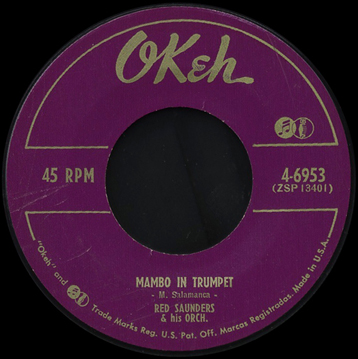
According to Chris Trent, "Mambo in Trumpet" and "Probably" are "definitely Sun Ra arrangements." "Mambo in Trumpet" uses the heavy Latin rhythm that Sunny was fond of in the late 1950s. "Probably" has a post-Ellingtonian sax ensemble with a heavy bottom; since Riley Hampton, who would became a major recording session arranger after he left Saunders, co-composed the number, we suspect that Ra retouched what Hampton had written. Trent says that "Voodoo Blues" is a musical "Rosetta stone" that combines R&B with Ra's "heavy rhythm exotica." There are particularly noticeable Ra touches in the instrumental interlude for piano and percussion and the tenor sax solo with baritone obbligato. "Honky Tonk Train Blues" is a feature for Earl Washington's piano; the horns are restricted to an accompaniment role, full of train-whistle emulations. The handling of the saxes is characteristically deft, however, and the train whistling makes a good excuse for some dissonant writing. Indeed, Hampton, Washington, and Easton shift from a clarinet trio, through two clarinets and a tenor sax [a violation of orthodox jazz arranging rules], to their usual instruments.
Leadbitter et al. mistakenly list "Rumble Mambo" as another title from this session(!). John McCarthy points out that it was actually a track by Link Wray and his Wraymen that was used as the B side for the 1963 and 1967 issues of an alternate take of "Hambone" (on OKeh 7166 and 7282, both 45-rpm singles). See Jeff Hall's Link Wray discography at http://pages.prodigy.com/cyclops/linkwray.html).
Sun Ra (org); "Thea Barbara" (female voc -1); unidentified (male voc -2).
Chicago, March 9, 1953
| The Many Thoughts of... (Ra) | Transparency 0316 [CD, disk 10] | ||
| The Inner Being (Ra) | Transparency 0316 [CD, disk 10] | ||
| The Haunted Melody (Ra) -1, 2 | Transparency 0316 [CD, disk 10] | ||
| Pennies from Heaven -2 | Transparency 0316 [CD, disk 10] | ||
| You and the Night and the Music -2 | Transparency 0316 [CD, disk 10] |
Sun Ra (p).
Chicago, April 27, 1953
| Ebb Tide (Maxwell) | Transparency 0316 [CD, disk 10] |
In 1953, Sun Ra did some work for the new Parrot label. His involvement as an arranger has been known for many years (in the case of the Joe Williams sessions), or for a few years (with the Jo Jo Adams session). What eluded detection for 55 years was Sunny's piano playing on one of the two sessions that jazz great Coleman Hawkins made for Parrot during an extended gig at Cadillac Bob's Toast of the Town. The recent release of The Eternal Myth Revealed: Volume One - Covering 1933-1959 on Transparency, which includes two Sun Ra solo piano performances from September 23, 1953 ("I Remember You" and "The Best Things in Life Are Free"), made it clear how similar the piano playing on 6 of the Hawkins tracks is to what can be heard on these. (However, it does not appear to be the same piano; the instruments are out of tune in different places.) The Transparency box includes two sides from this session ("September Song" and "Flight Eleven") but also presents sides from the August 1953 Hawkins session with Les Strand at the organ, Leo Blevins on guitar, and a different pianist; we doubt that Sunny had anything to do with these items.
Coleman Hawkins (ts); Sun Ra (p); unidentified (b); unidentified (d).
Chicago, August or September 1953
| [6994] | Flight Eleven | Savoy MG 12013, Savoy SV-0182 [CD], Classics 1416 [CD], Transparency 0316 [CD, disk 11] | |
| [6995] | Modern Fantasy | Savoy MG 12013, Savoy SV-0182 [CD], Classics 1416 [CD] | |
| [6996] | Confessin' | Savoy MG 12013, Savoy SV-0182 [CD], Classics 1416 [CD] | |
| [6997] | September Song | Savoy MG 12013, Savoy SV-0182 [CD], Classics 1416 [CD], Transparency 0316 [CD, disk 11] | |
| [6998] | You Can't Take That Away from Me [They Can't Take That Away from Me] | Savoy MG 12013, Savoy SV-0182 [CD], Classics 1416 [CD] | |
| [6999] | Should I? | Savoy MG 12013, Savoy SV-0182 [CD], Classics 1416 [CD] |
It is not known where these sides were recorded. But the out-of-tune piano and the weird balance rule out Universal Recording, or any other studio worthy of the name. An empty club is the likely venue.
Enough sides were cut at Hawk's two Parrot sessions to make an LP. But Al Benson never carried through with the plan. He put out two singles (Parrot 783 and 784), both consisting of material from the session with organ, piano, guitar, and (on two of the sides) a chorus.
Al Benson sold Parrot and Blue Lake Records to John Henry "Lawyer" Burton in March 1956. Burton operated the labels for a few months, and threw in the towel before 1956 was out. Burton sold all of the Parrot Hawkins tracks to Herman Lubinsky. Savoy MG 12013, The Hawk Returns, was an LP released in 1957; it consisted of the 12 sides that Hawk had done for Parrot, including all 6 from this quartet session (the quartet tracks were grouped together on Side B). The original Parrot matrix numbers for the session remain unknown; the numbers in brackets were assigned by Savoy. "You Can't Take That Away from Me" is the way the title was rendered on the Savoy release.
A straight CD reissue of the LP, under the same title, appeared in 1994 as Savoy SV-0182.
All 12 tracks that Hawk cut for Parrot can be heard on Classics 1416, Coleman Hawkins 1953-1954, a 2006 CD that was among that label's last.
Finally, two tracks from this session appear on Transparency 0316, Sun Ra: The Eternal Myth Revealed Volume 1, a 14-CD set released in 2011.

Jo Jo Adams (voc) with Sonny Cohn (tp); Leon Washington (ts); McKinley Easton (bars); unidentified (eg); Earl Washington (p); prob. Jimmy Richardson (b); Red Saunders (d); Sun Ra (arr).
Universal Recording, Chicago, September 1953
| P 53117 | It's Been So Long | unissued | |
| P 53118 | Corrine | rejected | |
| E-53119 | Call My Baby (Adams) | Parrot 788, Relic 7016 [CD], Classics 5083 [CD], Transparency 0316 [CD, disk 10] | |
| E-53120 | Rebecca (Adams) | Parrot 788, Relic 7016 [CD], Classics 5083 [CD], Transparency 0316 [CD, disk 10] |
In all previous discographies the personnel of Parrot 788, a single released in November 1953, was given as unknown.
It is obvious to the ear that this is a Red Saunders ensemble, and that Red is on drums. Sonny Cohn is the lead trumpeter. There is no alto saxophone. Leon Washington solos on both sides, a little more grittily than usual. The feature for guitar in "Call My Baby" is the work of player with a heavy attack, like Charlie Christian or T-Bone Walker; the guitarist accompanies four to the bar throughout both tracks in a Freddie Green style. The same guitarist appears to have been on Adams' 1947 session with Tom Archia for Aristocrat. Whoever it is, it isn't Ike Perkins.
The pieces may both be midtempo blues in the same key, but the band is clearly reading from charts. The arrangements definitely are by Sun Ra; especially on "Call My Baby," they keep threatening to turn into early Arkestra numbers, then veer temporarily back to the usual formulae. The arrangements are not just remarkable in their own right; they show Sun Ra's "far out" style emerging from its chrysalis. Our thanks to the late Otto Flückiger for careful listening to these sides.

Parrot did not credit a composer on either released side; however, Relic gives Jo Jo Adams as the composer.
By interpolation in the Parrot matrix series (see our Parrot Discography), a date in September 1953 is indicated. The E- prefix indicates that this record was originally slated for release on a subsidiary called Eagle, which Al Benson ended up deciding not to open. In the list of Parrot/Blue Lake tapes that were leased to Chess in 1958 or 1959, four Jo Jo Adams tracks were included in tape box 2027 along with six tracks by the Crume Brothers, a gospel group. The Chess tape list is our source for the titles of the two unreleased sides. "Corrine," which according to Donn Fileti was rejected, was an attempted remake of a number from Jo Jo's first session for Melody Lane/Hy-Tone.
Relic 7016, Cool Playing Blues: Chicago Style, is a CD of Blues material recorded for Parrot Records. The other featured artists are "Little Papa Joe" [Jody Williams], L.C. McKinley, Curtis Jones, St. Louis Jimmy (see the 1956 entry below) and J.T. "Nature Boy" Brown.
Sun Ra (p).
Chicago, September 25, 1953
| I Remember You | Transparency 0316 [CD, disk 5] | ||
| The Best Things in Life are Free | Transparency 0316 [CD, disk 5] |

Joe Williams (voc) with the Red Saunders Band: Red Saunders (d, dir); Sonny Cohn (tp); Riley Hampton (as); Leon Washington (ts); McKinley [Mac] Easton (bars); Earl Washington (p); Ike Perkins (eg); Walt Champion (b); Sun Ra (arr).
Universal Recording, Chicago, September 28, 1953
| 53126? | It's Raining Again (Ra) | Regent 6002, Savoy MG 12216, Savoy SJL 1140, Denon/Savoy SV-0199 [CD] | |
| 53127? | Always on the Blue Side (Ra) | Regent 6002, Savoy MG 12216, Savoy SJL 1140, Denon/Savoy SV-0199 [CD] |
Joe Williams (voc) with the Red Saunders Band: Red Saunders (d, dir); Sonny Cohn (tp); Riley Hampton (as); Leon Washington (ts); McKinley [Mac] Easton (bars); Earl Washington (p); Ike Perkins (eg); Walt Champion [Walter Cole] (b); Sun Ra (arr).
Universal Recording, Chicago, September 28 or December 31, 1953
| Detour Ahead (J. Frigo-Carter-Ellis) | Regent 6002, Savoy MG 12216, Savoy SJL 1140, Denon/Savoy SV-0199 [CD] | ||
| Blow Mr. Low (Saunders-D. Williams) | Savoy 1165-A, Regent 6002, Savoy MG 12216, Savoy SJL 1140, Denon/Savoy SV-0199 [CD] | ||
| BL-54104 | Tired of Moving (Williams) Time for Moving* |
Blue Lake 102, Savoy 1165-B*, Regent 6002*, Savoy MG 12216*, Savoy SJL 1140, Denon/Savoy SV-0199 [CD], Empire Musicwerks CD N-1 | |
| BL-54103 | In the Evening (L. Carr) | Blue Lake 102, Regent 6002, Savoy MG 12216, Savoy SJL 1140, Denon/Savoy SV-0199 [CD], Empire Musicwerks CD N-1 |
Blue Lake 102 was a 78 and 45 rpm single released in January 1954 (which is when Parrot opened its Blue Lake subsidiary). "In the Evening" is credited to Joe Turner on the original label.
"Tired of Moving" (called "Time for Moving" on Savoy 1165) and "Blow Mr. Low" (previously unissued) appeared on a single has often been mislisted, and was formerly mislisted here, as Savoy 116. Savoy 1165 was released in late July of 1955, as Herman Lubinsky sought to draw sales off the popularity of Joe Williams' version of "Every Day I Have the Blues" with Count Basie; it was advertised in Cash Box on August 6, 1955, p. 24, and reviewed in the same issue ofCash Boxp. 28. Lubinsky bought the sides from Al Benson when Blue Lake was still an active label.
We have grouped together the two items known to have been recorded on September 28, but have otherwise followed the order of the tracks on the Regent and Savoy LPs, as we do not know the original matrix numbers or even the precise recording date for four of the six tracks.
Parrot / Blue Lake was sold in March 1956 and became inactive in the fall of that year. While some of the remnants were licensed to Chess later, and others ended up in the hands of Relic Records, the remaining Joe Williams masters were immediately sold to Regent/Savoy (which also bought a Coleman Hawkins session from the defunct label). It's possible, in fact, that the transaction took place before "Lawyer" Burton, who bought Parrot/Blue Lake from Al Benson, had closed its doors. All 6 tracks from this session were released in August 1956 on the LP Regent 6002, titled Joe Williams Sings (it was reviewed in Billboard on August 25, 1956, p. 29). They later appeared on LP as Savoy MG 12216 as Joe Williams Sings Everyday and were reissued (in 1984) on Savoy SJL 1140 under the title Everyday I Have the Blues. The Savoy album was reissued in its entirety on CD as Denon/Savoy SV-0199; put out in 1993, this reverted to the title Sings Everyday. All of these releases contained four other tracks that Williams had recorded with a King Kolax unit in 1952; see the King Kolax Discography for these).
In addition, the two sides that appeared on Joe Williams' Blue Lake single reappeared (in excellent sound) on Empire Musicwerks CD-N1, a collection of Parrot/Blue Lake jazz sides titled Jukebox Jazz! From the Southside of Chicago and released in December 2002.
The personnel are as listed in various sources, including Leslie Gourse's book, Every Day: The Story of Joe Williams (Quartet Books, 1985); Leadbitter et al. agree. Gourse says Williams gave 1950 as the date, but this is flatly unreliable (Blue Lake/Parrot didn't exist in 1950!). Judging from Red's other recordings, there's no way he would have been performing so "modern" an arrangement as "It's Raining Again" in 1950. Walt Champion was also known as Walter Cole; he became Red's regular bassist later in the 1950s.

Leadbitter et al., reading more into the matrix numbers on the Blue Lake labels than is appropriate, give December 31, 1953 as the date, but the band on these vocal sides is smaller and includes a guitarist. In earlier versions of this discography, we gave early 1954 as the date. However, Bob Porter in his liner notes to SJL 1140 says that "It's Raining Again" and "Always on the Blue Side" were done on September 28, 1953 and the other four sides were cut "during that period." (The September 28 date is from the outside of a tape box, as was the custom at Parrot/Blue Lake.) A magazine article promoting the label appeared in December 1953 (now reproduced on our Parrot page); Joe Williams was one of the artists mentioned, so obviously some recording had already been done by then. Nothing would have prevented the sides from all being done at one session, but the only vacant Parrot matrix numbers around September 28, 1953 are 53125 and 53126, while a block of 6 matrix numbers (53179 through 53184) opens up around the December 31 session. As many as four of the items we have listed here could actually be from the later session.
These were Joe Williams' last recordings in Chicago; he left town to join Count Basie around Christmas 1954. By July 1955, he had an R&B hit with Count Basie—a new, two-sided rendition of "Every Day I Have the Blues."
Sun Ra discographer Julian Vein believes that all but "Blow Mr. Low" and "In the Evening" were arranged by Sun Ra; he published his opinion as early as 1967. Ra's involvement with "It's Raining Again" and "Always on the Blue Side" is particularly obvious; in fact, the lack of listed composer credits for these items is most intriguing. Sunny was not copyrighting any of his pieces during this period—and "Raining" and "Blue Side" sound like Ra compositions! "Tired of Moving" is a straightahead blues that Sunny is less likely to have composed; the original Blue Lake label attributes it to Joe Williams. Given Sunny's involvement with Saunders when the original "Blow Mr. Low-Blow" was cut in 1950, he probably at least retouched this piece and "In the Evening."
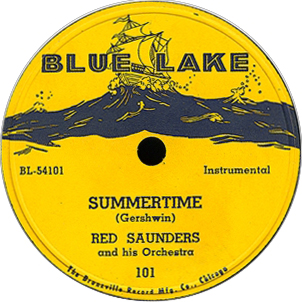
Red Saunders (d, ldr); Sonny Cohn (tp); Fip Ricard (tp); Marty Martinez (tb); Harlan "Booby" Floyd (tb); Porter Kilbert (as); Leon Washington (ts); Mac [McKinley] Easton (bars); Earl Washington (p); Jimmy Richardson (b); Sun Ra (arr).
Universal Recording, Chicago, December 31, 1953
| BL-54101 | Summertime (Gershwin) | Blue Lake 101, Chess CHV 415, Bellaphon [G] BJS4032, Empire Musicwerks CD-N1 | |
| BL-54102 | Riverboat (Clark Terry) | Blue Lake 101, Chess CHV 415, Bellaphon [G] BJS4032, Empire Musicwerks CD-N1 | |
| 53181? | Lawdy, Lucy [ens shouts] | Chess CHV 413, Bellaphon [G] BJS4031 |
Blue Lake 101 was a 78 and 45 rpm single released in January 1954. "Lawdy Miss Lucy" and perhaps another unknown title were intended for release on Blue Lake (they were assigned matrix numbers 53181 and 53182, according to Leadbitter, Fancourt, and Pelletier; LFP mistake these numbers from the main Parrot matrix series, which started at U53100 and skipped from a U53 prefix to a U55, for numbers in the Blue Lake series, which started at BL-54101).
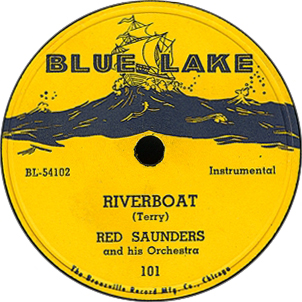
Parrot / Blue Lake went belly-up in 1956; Chess leased a big batch of masters from the company's last owner, John "Lawyer" Burton, in 1958 or 1959. Chess LP CHV 415 (released 1972) was titled Southside Jazz and CHV 413 (also released 1972), a compilation including Leo Parker, Sahib Shihab, and Red Saunders, was titled The Late Great King of the Baritone Sax. (The band shouts "Lawdy Miss Lucy" but the LP gives the title as "Lawdy, Lucy." The track was included because of Mac Easton's prominent baritone sax solo, in a style influenced by Leo Parker.) The Bellaphon issues (which are mentioned in Tom Lord's Jazz Discography) were German reissues of Chess material; dates and album titles unknown.
The date and personnel are from Joe Segal's liner notes to the Chess LP, CHV 415. The lineup fits the instrumentation that can be heard on the tracks, and was probably provided by Red Saunders himself. Leadbitter et al. supply incomplete instrumentation and no personnel, give two unknown titles for December 31, 1953, and refer to "Riverboat" and "Summertime" as 1954 recordings.
Sun Ra is not mentioned as the arranger in those notes, but Julian Vein has concluded that these were his arrangements. The arrangements are much more aggressively "modern" than anything the Saunders band committed to record earlier (except the interlude in "Voodoo Blues," and the two Jo Jo Adams sides done for Parrot in September). They appear to be Sunny's work from start to finish. According to Segal, the trombone soloist on "Summertime" is Marty Martinez, whereas Booby Floyd can be heard on "Riverboat."
The Clark Terry composition first appeared on record as "River Boat" on Flame 1003. Issued on a subsidiary of Franklin Kort's Swing Time label, the 78-rpm single came out in March 1952, according to a mention in the "R. & B. Beat" column in Billboard. There it was performed, in a very different arrangement, by a group led by guitarist Ike Perkins. Clark Terry was featured on trumpet, and Lonnie Simmons, whose composition "Organism" was used for the B side, played organ. Either Simmons or Perkins could have brought "Riverboat" to Saunders' attention.
Opportunities to get arrangements recorded unfortunately diminished during the following two years. Red Saunders recorded for Parrot/Blue Lake with Ann Carter (c. March 1954) and Walter Spriggs (c. October 1954), but there are no clear indications of Sunny's involvement with either session. Record companies were losing interest in the Saunders aggregation, and Sunny's last opportunity to arrange for Saunders would come in February 1955, behind singer Billy Brooks. However, he was doing occasional arrangements for King Kolax, who was leading a successful quintet during the period, and we believe that some of these made onto records.

King Kolax [William Little] (tp, ldr, voc); Harold Ousley (ts); Prentice McCarey (p); "Cowboy" Martin (b); Leon Hooper (d); Grant Jones (voc); unidentified female (voc -2); prob. Sun Ra (arr -1).
Universal Recording, Chicago, December 22, 1954
| 54-222 | What Have You Done to Me [GJ voc] | RST 1580 [CD], P-Vine Special [J] PCD 5271/4 | |
| 54-223 | Right Now [GJ, ens voc] | Top Rank RLP 111, RST 1580 [CD] | |
| 54-223 [alt.] | Right Now [GJ, ens voc] | Charly CRB 1043 | |
| 54-224 | Push Out [KK, ens voc] -2 | Charly download | |
| 55-225 | Vivian (Kolax) -1 | Vee-Jay 136 | |
| 55-225 [alt.] | Vivian (Kolax) -1 | Charly download | |
| 55-226 | Goodnite Blues (Kolax) | Vee-Jay 136, Top Rank RLP 110 | |
| 55-226 [alt.] | Goodnite Blues (Kolax) [KK voc] | Charly CRB 1043 |
Session details from Lord's Jazz Discography. Lord has only 54-223 (misnumbered 54-233), 55-225, 55-226. The other items were filled in from Leadbitter and Slaven's Blues Records 1943 to 1970 A-K(1987). Leadbitter and Slaven have "Good Night Blues" for 54-225, and they give 54- as the prefix throughout (whereas Kurt Mohr gave 55- as the prefix for the last two items).
Vee-Jay 136 was a single released around June of 1955. Top Rank RLP110 was a French LP titled Jazzville Chicago Volume 1. RLP111 was titled Jazzville Chicago Volume 2. Both were compiled by Kurt Mohr and issued in 1962. Top Rank was a label belonging to the Rank Organisation in Britain; at the time Rank had a licensing agreement with Vee-Jay.
Vee-Jay 136 was a single released around June of 1955. Top Rank RLP110 was a French LP titled Jazzville Chicago Volume 1. RLP111 was titled Jazzville Chicago Volume 2. Both were compiled by Kurt Mohr, and issued in 1961 and 1962, respectively. Top Rank was a label belonging to the Rank Organisation in Britain; at the time Rank had a licensing agreement with Vee-Jay.
The first, second, and fourth tracks were also issued on Charly LP CRB 1043, Rootin' and Tootin', a collection of Chicago R&B from small labels that was issued in 1985. The Charly LP notes incorrectly put "Right Now" on the next recording session. RST 1580 is an Austrian CD titled Grant "Mr. Blues" Jones: In the Dark (1949-1958). P-Vine Special PCD 5271/4 is a Japanese 4-CD box from 2000 titled Vee-Jay, The Chicago Black Music.

Ken Ellzey suggests possible Sun Ra arrangements on both of King Kolax's sessions for Vee-Jay. Ra spoke of working with Kolax in interviews but revealed no details. Harold Ousley was indeed a member of an early Sun Ra band (in 1952). There is no need for Sun Ra arrangements (or anybody's arrangements) on generic jump band-style R&B like "Right Now," "What Have You Done to Me?," or "Goodnite Blues." However, "Vivian" (presumably named after Vivian Carter of Vee-Jay) is a mysterioso Latin number with percussion breaks built right into the theme. Off the beaten path for King Kolax, but straightforward for Sun Ra at this time. Harold Ousley did not want to rule out "Vivian" as a Sun Ra arrangement either: "Kolax wrote a lot himself, but he also used a lot of other people's stuff."
The Nu Sounds: Roland Williams (voc); Vic... (voc); John ... (voc); Kalil... (voc); Sun Ra (p, dir).
Club Evergreen, Chicago, 1954 or 1955
| A Foggy Day (Gershwin-Gershwin) | Saturn 9/1954, Evidence 22164 [CD] |
Saturn 9/1954 is a 45 rpm single released in 1983. According to Michael Anderson, who was Ra's archivist in 1983, both sides of this single originated on a demo disk. The track was reissued in September 1996 on Evidence 22164, a 2-CD set titled The Singles. John Gilmore said that one of Sunny's vocal groups auditioned for a record label run by a woman (this would be Vivian Carter of Vee-Jay; Vi Muszynski of Bandera wasn't on the scene till 1958, after Saturn was up and running), but her verdict was that they sounded “too good” (a euphemism for “too White”). John told this story about the Cosmic Rays, but he often conflated them with the Nu Sounds, whose vocal style is more likely to have elicited such a reaction.
According to Alton Abraham, the Nu Sounds, led by Roland Williams, were one of the vocal groups being coached by Sun Ra. Location from Abraham and Robert Pruter; Club Evergreen was on North Clybourn Street. (On other occasions, Abraham attributed this side to a later vocal group, the Cosmic Rays; the source of the confusion is that Sunny had the Nu Sounds and the Rays record the same tunes, then picked the version he liked better for release. This policy applied not only to Ra's vocal compositions but also to some of the standards that he arranged for vocal groups.)
Besides the competing recordings by the Nu Sounds and the Cosmic Rays, a further source of confusion has been that Sun Ra's interest in vocal groups came and went. It was intense in 1954 and 1955, quickly vanished once the Arkestra began recording on its own in 1956, then returned in 1958-1960. The known studio recordings of Ra's vocal groups are from the later period, even though he was rehearsing with some of the same performers in the earlier period.
On October 5, 1954, a composer named Robert Douglas Mayo copyrighted “Dreams Come True.” Although Sun Ra's name is nowhere on the piece, the original sheet music is in his handwriting! Sunny would rehearse the song with the Nu Sounds in 1954 or 1955 and record it with Clyde Williams and members of the Arkestra on two occasions in late 1956. A little while later, the long hiatus ended for good, and Sun Ra began to copyright his tunes again. Research by James Wolf shows that Le Sonyr Ra (no apostrophe in the Library of Congress files) copyrighted “Bop Is a Spaceship Lullaby” on November 18, 1954, and “Chicago USA” on December 23, 1954. Both had lyrics as well as music by Ra and were obviously intended for vocal groups. These were followed on February 9, 1955 by “Baby Please Be Mine” (under the name Sun Ra).
Although John Gilmore and others recalled recordings of some of these songs, all were thought to be lost until rehearsal tapes were recovered in 2000. In fact, “Chicago USA” was written for the Nu Sounds, and rehearsal recordings of it and “Bop Is a Spaceship Lullaby” have been found. "Black Sky and Blue Moon" has turned up as well. In 2009, a version of “Baby Please Be Mine.” was finally released.
A few instrumental performances have also survived from this period. Two of them had to wait for release till 1973.
Sun Ra (p); Wilbur Ware (b -1).
Sun Ra's apartment, Chicago, around 1955
| Piano Interlude (Ra) | Saturn 485, Evidence 22014 [CD] | ||
| Can This Be Love? (Smith-James) -1 | Saturn 485, Evidence 22014 [CD], 1201 Music 9019 [CD] |
According to Julian Vein, these two tracks were sold to Black Lion/Freedom in 1971, along with recordings from 1962 and 1963 that later became side B of the Saturn LP The Invisible Shield but were not issued at the time. Saturn 485 (released in 1973) was an LP titled Deep Purple (on some copies, Dreams Come True). Although it had standard printed white labels with a Chicago address for the company, no covers were printed for it; the LP was issued with various generic covers, often hand decorated by members of later Arkestras. All of Side A of this LP was reissued on Evidence 22014, Sound Sun Pleasure!!, a CD from 1992. “Can This Be Love?” was reissued again in 2000 on 1201 Music 9019, a CD titled Standards.
Roland Williams (voc); Vic... (voc); John... (voc); Kalil... (voc); with Sun Ra (p, dir).
Rehearsal, Chicago, 1954 or 1955
| A Foggy Day (Gerswhin-Gershwin) | Atavistic UMS/ALP243 [CD] | ||
| A Perfume Counter | Atavistic UMS/ALP243 [CD] | ||
| Love Is... | Atavistic UMS/ALP243 [CD] | ||
| Wordless Piece | Atavistic UMS/ALP243 [CD] | ||
| I Was Wrong | Atavistic UMS/ALP243 [CD] | ||
| Louise | Atavistic UMS/ALP243 [CD] | ||
| St. Louis Blues (Handy) | Atavistic UMS/ALP243 [CD] | ||
| The Wooden Soldier and the China Doll | Atavistic UMS/ALP243 [CD] |
A rehearsal tape, from 1954 or 1955, was released on a 2003 CD, Spaceship Lullaby, Atavistic UMS/ALP243. The version of “Foggy Day” on this tape is not the same one that was released in 1983 on a Saturn single.
The Nu Sounds: Roland Williams, Vic ..., John ..., Kalil ... (voc, hand clapping); Sun Ra (p, dir); Robert Barry (d); Laurdine “Pat” Patrick (bars -1).
Rehearsal, Chicago, 1954 or 1955
| Spaceship Lullaby (Ra) | Atavistic UMS/ALP243 [CD] | ||
| Stranger in Paradise (Borodin-Wright-Forrest) | Atavistic UMS/ALP243 [CD] | ||
| Just One of ThoseThings (Porter) | Atavistic UMS/ALP243 [CD] | ||
| Honky Tonk | Atavistic UMS/ALP243 [CD] | ||
| Haunted Heart | Atavistic UMS/ALP243 [CD] | ||
| Evelyn | Atavistic UMS/ALP243 [CD] | ||
| Honeysuckle Rose (Waller-Razaf) | Atavistic UMS/ALP243 [CD] | ||
| Honey | Atavistic UMS/ALP243 [CD] | ||
| Black Sky & Blue Moon (Ra) | Atavistic UMS/ALP243 [CD] | ||
| Ra coaching Roland Williams | Atavistic UMS/ALP243 [CD] | ||
| Holiday for Strings (Ra dynamics demo) | Atavistic UMS/ALP243 [CD] | ||
| Holiday for Strings (Rose-Gallo) | Atavistic UMS/ALP243 [CD] | ||
| I Fall Asleep Counting My Blessings | Atavistic UMS/ALP243 [CD] | ||
| Nice Work If You Can Get It (Gershwin-Gershwin) | Atavistic UMS/ALP243 [CD] | ||
| Somebody Loves Me (Gershwin-Gershwin) | Atavistic UMS/ALP243 [CD] | ||
| Chicago USA (Ra) | Atavistic UMS/ALP243 [CD] | ||
| Chicago USA (Ra) -1 | Atavistic UMS/ALP243 [CD] |
“Holiday for Strings” and “Honeysuckle Rose” were on a rehearsal tape that Ra brought to WKCR-FM; they were broadcast during the 1987 Sun Ra Festival. In the second edition of this discography, Sun Ra's instrument was incorrectly identified as an electric piano and Robert Barry's presence on drums was noted. These and other selections from the tape were released for the first time on CD in 2003, Atavistic UMS/ALP243, Spaceship Lullaby, where the sound, though clearly emanating from an old home tape machine, is much improved over what could be heard on the broadcast.
Unidentified vocal group with Sun Ra (p, dir).
Rehearsal, Chicago, c. 1955
| C'est Si Bon | Atavistic UMS/ALP243 [CD] | ||
| Blue Moon (Rodgers-Hart) | Atavistic UMS/ALP243 [CD] | ||
| Baby Please Be Mine (Ra) | Atavistic UMS/ALP243 [CD] | ||
| Blue Skies (Berlin) | Atavistic UMS/ALP243 [CD] | ||
| My Only Love | Atavistic UMS/ALP243 [CD] |
This rehearsal tape, from 1954 or 1955, was released on a 2003 CD, Spaceship Lullaby, Atavistic UMS/ALP243. The Lintels were a doowop group; this was their first rehearsal with Sun Ra. It is not known whether they continued to work with him, but no releases on Saturn ensued. The tune identified here as “Baby Please Be Mine” is not Sun Ra's composition.
1955 also saw Sunny's last recorded efforts as an arranger for the Red Saunders band. Although many of Red's regulars would remain in the band until the Club DeLisa closed in February 1958, and some stayed with him beyond that, R&B was trending toward rock and roll and record companies were beginning to see Saunders' band as dated.
Robert "Billy" Brooks (voc); Red Saunders (d, dir); Sonny Cohn (tp); unidentified (tp); Riley Hampton (as, cl); Leon Washington (ts, cl); McKinley Easton (bars, bcl); Earl Washington (p; celeste on -2); Ike Perkins (eg except -2); Jimmy Richardson (b); prob. Sun Ra (arr -1).
Unidentfied studio, Chicago, February 18, 1955
| ACA3109 | Mambo Is Everywhere (L. L. Lawrence)^ -1 | Duke 142 | |
| ACA3110 | Song of the Dreamer (Eddie "Tex" Curtis)^ | Duke 142 | |
| ACA3111 | Donna (L. Cox-E. Curtis) | Duke 145 | |
| ACA3112 | I Want Your Love Tonight (Eddie "Tex" Curtis)^ -1 | Duke 149 | |
| HHA 21201 | This Is My Prayer (Don D. Robey [sic])^ -2 | Duke 149 |
Here we have three singles (Duke 142, 145, and 149) not listed in Lord, Bruyninckx, or Leadbitter! They are listed in Jepsen's discography; however, Jepsen mentions only Brooks and Saunders in his personnel. Duke 142, and one side from 145 and 149, appear to have come from a 4-tune session with the Red Saunders band. (The flip side of 145 is from a different session with a different band; the flip of 149 includes the Saunders band and may be from the session of February 18, 1955.)

Dan Kochakian owns a copy of Duke 142, a 78 and 45-rpm single that was released in June 1955 (date provided by Bill Daniels' dating guide). The label states Houston, Texas, but that's where the Duke/Peacock home office was. The ACA prefix indicated that the sides were mastered at ACA Studios on Fannin Street in downtown Houston. Swiss jazz researcher Kurt Mohr said that Don Robey of Duke Records often supervised sessions in Chicago. Press clippings collected by Robert Pruter show that Billy Brooks was performing at the Club DeLisa in March and April 1954 (duly advertised in the Defender on March 13 and 20 and April 3). On July 10, Brooks was working Club Evergreen with a band led by Red Holloway. Galen Gart and Roy C. Ames, in Duke/Peacock Records: An Illustrated History with Discography (Milford, NH: Big Nickel Publications, p. 78) state that Don Robey flew to Chicago in February 1955 to record Brooks. However, the incomplete chronological list of Brooks sessions (which leaves out his first one for Duke/Peacock in 1953) identifies only the session of November 1, 1955 as done in Chicago. Clearly, however, the session of February 18, 1955 is the one they were referring to on page 78.
To nail the date down further, we know (from Gart and Ames, p. 222) that "Mambo Is Everywhere" and "Song of the Dreamer" were mastered for 45 and 78rpm on March 4, 1955, and remastered on April 11, 1955. "Donna" and "I Want Your Love Tonight" were mastered on August 3, 1955.
"Mambo Is Everywhere" has Latin rhythms of the sort favored by Sun Ra. "Song of the Dreamer" is a sentimental Country & Western tune of a sort that Ra is not known to have arranged (and while there is a potentially interesting alternation between a clarinet/bass clarinet trio and the standard sax section, the transition is rather gauchely handled). Gart and Ames (p. 78) state that the record was "only a moderate hit," but that the tune was covered by Johnnie Ray on Columbia and Eddie Fisher on RCA Victor, indicating commercial potential.
A second Billy Brooks single, on Duke 145 (78 rpm), is now in the collection of Armin Büttner. It was probably released in August or September 1955. Side A, "Donna," is credited to Billy Brooks / Red Saunders Orch. "Donna" does not use the clarinets, but it is a sentimental tune related to "Song of the Dreamer" and Sunny's involvement seems unlikely. (The title, according to Gart and Ames, was originally "I Want to Be with Donna.")

Side B of Duke 145, "I'm Gone," is a fast boogie credited to Billy Brooks and his Orchestra. (The composition is credited to Don Robey, the owner of Duke/ Peacock, an attribution that should be taken with a grain of salt.) All indications are that this is a different band, with a solo by a tenor player who is much grittier than Leon Washington. The guitarist could be Ike Perkins, however. The matrix number is ACA3028, which indicates an earlier session. In fact, Gart and Ames (p. 221) show that "I'm Gone" (which was not mastered till August 17, 1955) did come from an earlier session, presumably on November 23, 1954. The other three titles from this session (ACA3029, "Be My Baby"; ACA3030, "Then I Can Live"; ACA 3031, "From Midnight till Morning") were never released. Alvin Fielder says that he was drumming on many of Duke's studio sessions in Houston at the time; he may well be on these sides.
A copy of Duke 149 is now in the collection of Armin Büttner. On the evidence of the matrix numbers, ACA3112 ("I Want Your Love Tonight") is from the same session with Red Saunders. The flip side, HHA 21201 ("This Is My Prayer"), would seem from the matrix to be from a different session (not clear which one, but Brooks recorded for Duke on October 28 and November 1, 1955, and did his final session for the label on February 26, 1957). However, both sides of Duke 149 credit the accompaniment to Red Saunder's Band [sic], and the band sounds the same on both sides. (However, there is no guitar on "This Is My Prayer," and the pianist doubles on celeste.) Leon Washington solos on "I Want Your Love," and there are 8 bars for Riley Hampton on "Prayer," while Mac Easton is prominent in the backing on both. "I Want" is a mambo that could have been arranged by Sun Ra. For now, "This Is My Prayer" is included with the February 18, 1955 session; if it came from a later session, other material including the Red Saunders band ought to materialize.
The personnel were identified by ear, assuming non-catastrophic turnover since the last Joe Williams session. Fip Ricard left the band on November 10, 1954, according to Otto Flückiger's notes, so trumpet #2 must be someone else. Mac Easton recorded with Gene Ammons for Prestige in Hackensack, New Jersey, on November 26, 1954 and February 8, 1955, but is not known to have made any other excursions out of town. (Armin Büttner believes that Mac is present on "Donna," and he would have had time to return to Chicago for this session.)
Sonny Blount (p, ldr); Laurdine "Pat" Patrick (bars); Robert Barry (d).
Rehearsal, Chicago, July 23, 1955
| tk. 1 | Of This I Know [Treasure Hunt] | Transparency 0316 [CD, disk 11] | |
| tk. 2 | Of This I Know | Transparency 0316 [CD, disk 11] | |
| When You're With the One You Love | Transparency 0316 [CD, disk 11] | ||
| Darn That Dream | Transparency 0316 [CD, disk 11] |
"Of This I Know," take 1, was talked about for a few years (and occasionally heard) as "Treasure Hunt." One copy of the tape was titled "Treasure Hunt" and "c. 1950" in Sunny's handriting. It got its first public performance on May 22, 1995, on a WKCR-FM memorial broadcast. Our thanks to Charles Blass for information about the broadcast. Musicians were identified by ear.
Michael Anderson subsequently found the original tape, from a rehearsal on July 23, 1955. The tape contained "Of This I Know" in a second, longer take, plus performances of two other standards.
Sunny also continued his relationship with the King Kolax band, which made a second session for Vee-Jay.
King Kolax [William Little] (tp -1, voc, ldr); Harold Ousley (ts); Prentice McCarey (p); Malachi Favors (b); Leon Hooper (d); Grant Jones (voc); Calvin Carter (voc -2).
Universal Recording, Chicago, September 16, 1955
| 55-326 | Those Rhythm and Blues [CC voc] | Top Rank RLP 110 | |
| 55-326 [alt.] | Those Crazy Rhythm 'n' Blues [CC voc] | Charly CRB 1043 | |
| 55-327 | H2O -1 | Top Rank RLP 110 | |
| 55-328 | Traveling | unissued | |
| 55-329 | Time [KK voc] | Top Rank RLP 110 | |
| 55-330 | Enchanted Moods | unissued | |
| 55-331 | Four Dimensions | unissued |
Session details from Lord's Jazz Discography, except that Lord omits 55-328, 330, and 331, which were filled in from Leadbitter and Slaven, Blues Records 1943 to 1970 A-K (1987).
Lord (and the Charly compilers) credit Grant Jones with the vocal on "Those Crazy Rhythm 'n Blues" but he is not present on it. The Mohr-Flückiger-Demeusy files reveal that it was Calvin Carter, the brother of Vivian Carter, who impersonated the female fan who wants to hear "those crazy rhythm 'n' blues." Two takes survive. On the take issued by Top Rank, which left "crazy" out of the title, Carter starts with, "This the place you been talkin' about?" On the take issued by Charly, the speech begins, "Here comes my doghouse daddy." And after King Kolax's solo, Carter says, "That was King Kolax... my sister-in-law used to like him, that's how I know."
This session was intended for release on Vee-Jay but none were ever issued by that label. (Apparently the company had lost interest even in blues vocals from King Kolax.) Top Rank RLP110 was a French LP titled Jazzville Chicago Volume 1. It was compiled by Kurt Mohr and issued in 1961. An alternate take of one of the tracks was also issued on Charly CRB 1043, Rootin' and Tootin', an LP collection of Chicago R&B derived from the Vee Jay label. The Charly LP incorrectly gives "Cowboy" Martin and not Malachi Favors as the bassist.
"Those Crazy Rhythm 'n' Blues" is standard jump-band R&B. "Time" is an ordinary slow blues; no need for a written arrangement from Sun Ra... "H2O" is a straight bebop number. The other tracks have not been checked because they are still unreleased in 2012, but obviously "Enchanted Moods," and "Four Dimensions" do sound a bit promising as far as Ra arrangements go.
Although Sunny continued to arrange for other leaders, we don't know of any specific items being recorded after the King Kolax session of September 1955. It didn't matter now, because Sunny was finally getting ready to record his own band.
We will refer to the small to medium-sized band that Sun Ra led as the Arkestra, although it wasn't actually called the "Arkistra" till late 1956, and didn't acquire its present-day spelling till February 1957. Once Sunny finally adopted "Arkestra," the bllling was used on recordings well before it showed up in nightclub ads or other publicity for live performances.
Sunny didn't always work with trios; he had indulged in several short-lived experiments with larger ensembles. Meanwhile, only Robert Barry stayed with him throughout the pre-Arkestral period. Tommy Hunter had to flee to New York for a while in 1950; in 1953 he went back there and stayed. Pat Patrick was unavailable during most of 1952 and 1953 because he was attending college at Florida A&M.
A key addition was tenor saxophonist John Gilmore. Born on September 28, 1931 in Summit, Mississippi, but raised in Chicago from toddlerhood, Gilmore attended DuSable High School, with its fabled band program. After getting out of the Air Force in 1951, he worked with Earl Hines and quickly became regarded as one of the up and coming young musicians in Chicago. An article in the Roosevelt Torch by Joe Segal (December 11, 1953), describes the university's Jazz Club concert of December 8, in which guest artist Charlie Parker alternated sets with “some of the top local artists,” including John Jenkins on alto sax, Harold Ousley and “Johnny” Gilmore on tenor sax, Andrew Hill, piano, and Hal Russell, drums. (Our thanks to Chris DeVito for bringing this article to our attention.) Not long after this event, Gilmore began rehearsing with The Ra. In the first half of 1954, Sun Ra had just John Gilmore and Robert Barry, augmented by Pat Patrick when he returned from college at Florida A&M.

The first engagement that Ra took as a leader in Chicago with members of his experimental ensembles took place in 1954. Before John Gilmore became a regular, Ra had rehearsed with tenor saxophonists John Tinsley and Swing Lee O'Neil. Bassist Earl Demus was also a participant. A Chicago Defender ad from December 25, 1954—the first mention of his name in that newspaper since he'd moved to Chicago—announced a gig by Le Sony'r Ra, accompanied by O'Neil, Demus and Robert Barry (drums). The venue was Duke Slater's Vincennes Lounge.
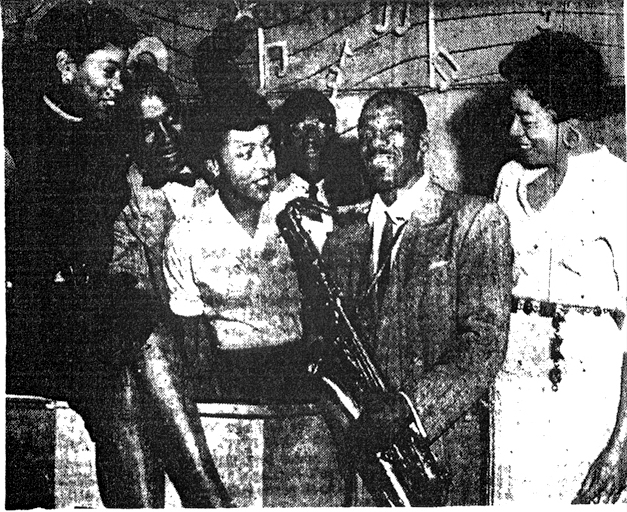
The band had already been at the Lounge for two weeks. Slater had just opened for business, probably during the first week of December 1954. The band was duly advertised on December 11 and 18, but on both occasions O'Neil was identified as the leader and the other participants were not named. It wasn't until the club's third ad, on December 25, that the personnel was listed and Ra got top billing. But in the same issue, it was O'Neil who appeared in the genre photo of featured musician hamming it up with club owner and female patrons. By the end of 1955, Sunny no longer had trouble being identified as the leader of his own ensembles, but throughout his stay in Chicago, he was rarely the focus of publicity in the Defender.

Ra's quartet was at the Vincennes Lounge for 6 weeks. On January 22, 1955, a quartet led by Red Simms took over; Simms kept Demus on as bassist. For the rest of the year, Simms' quartet and a quartet led by Lefty Bates alternated at the Lounge. Sunny is unlikely to have viewed this as a setback; Slater's establishment was not suited to the larger ensembles that he had in mind. But he had to go back to putting in long hours in the strip joints of Calumet City; judging from Robert Barry's reminiscences, he still needed the income well into 1955. Meanwhile, after Pat Patrick's return, the Arkestra picked up Dave Young on trumpet, then Julian Priester on trombone, then Richard Evans on bass, then Jim Herndon joined on tympani and timbales. Not all of the additions were permanent: for a little while Sunny was rehearsing an octet with an alto saxophonist named Sonny Rollins.
A side note on Sonny Rollins' two sojourns in Chicago seems apropos here. Little is known about either of them, because Rollins wasn't playing in public. His first stay, from somewhere in the fall of 1949 to January 1950, involved rehearsing with drummer Ike Day. The second stay began in May 1955, when Rollins got out of the Federal drug treatment facility in Lexington, Kentucky, and ended in November, when he was asked to replace Harold Land in the Clifford Brown-Max Roach quintet. Rollins took menial jobs, such as janitorial work, to support himself. He rehearsed with other musicians—for instance, he and Booker Little worked on "There's No Business like Show Business"—and attended some performances at clubs, but took no gigs. (Eric Nisenson's biography Open Sky provides the chronology, plus Rollins quotes about day jobs and rehearsing with Booker Little. It doesn't mention the rehearsals with Sunny, which probably didn't go on for long.)
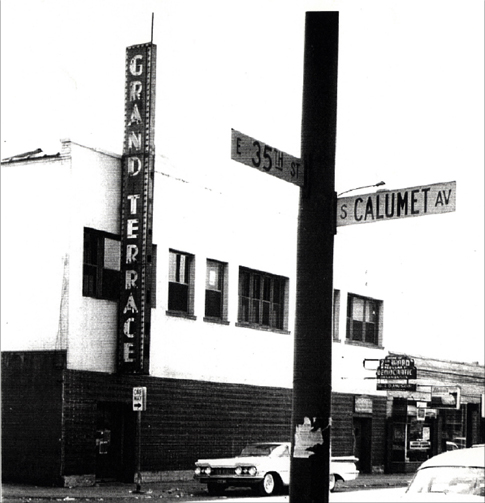
1955 also saw Sunny's return to the Local 208 contract list, for the first time in nearly 9 years. On July 7, he filed a 5 week contract with a club called Shep's Playhouse, replacing Eldee Young's group. According to John Szwed's biography, Alton Abraham helped him obtain the gig. Paying no mind to legalities, the Union local identified him as Herman Blount—we figure it was the name that was on the contract. We don't know how large a group the engagement called for. Located at 4233 Lake Park Avenue, Shep's Playhouse was in operation for about a year, from May 1955 to somewhere in the middle of 1956. Shortly after it opened, the club hosted a Wednesday night talent show operated by DJ McKie Fitzhugh, but he soon moved on to other venues. One of the leaders to post a contract with the establishment later on was Sunny's former bassist Earl Demus, after the Red Simms combo broke up. More we cannot say, because the Playhouse bought no ads in the Defender.
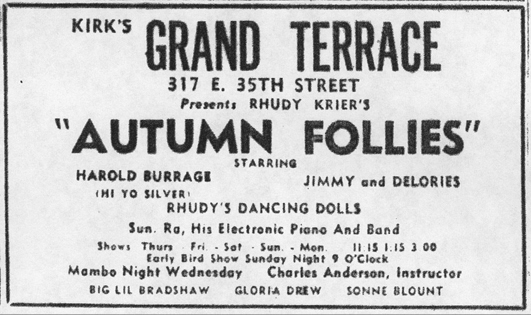
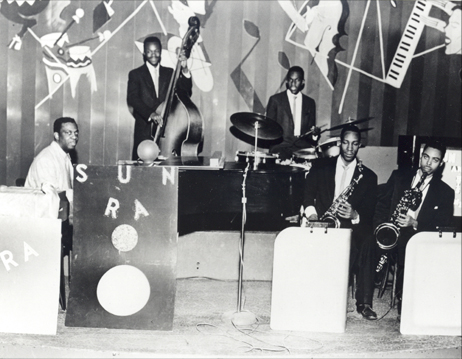
At the beginning of October, again with Abraham's help, Sunny was booked at the Grand Terrace, a venerable ballroom whose management was going through a spell of trying to revive it as a musical venue. The Terrace had reopened to much fanfare in May 1955; a show featuring King Kolax's band had run out of steam in July; a second revue featuring Memphis Slim's combo had had a shorter run in August. Sunny appeared as part of an elaborate show called "Autumn Follies" organized by Rudy Crier; top billing went to blues and soul singer Harold Burrage. Remarkably, the sign board announcing the show was rediscovered in 2012.
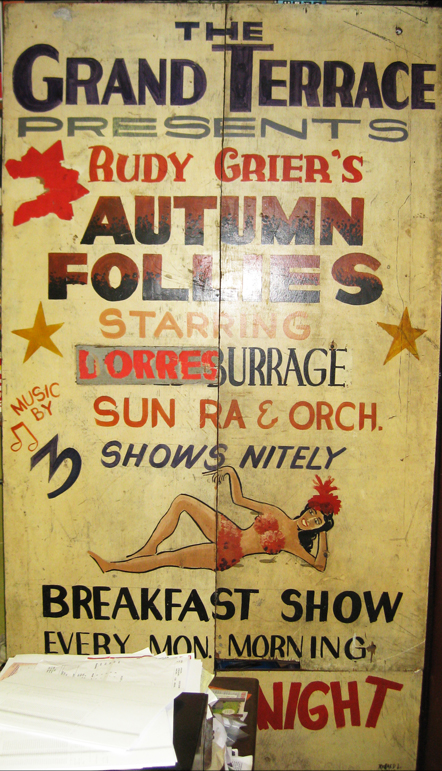
The Grand Terrace went out of business in 1957; in 1960 the building was sold to David Meyers and turned into an Ace Hardware store, still in business at 315 East 35th Street. Amazingly, the mural behind the stage (most of which can be seen in the 1955 photo of Ra with a quintet) was partly preserved; today portions of it are visible in the manager's office, a break room, and in the stairwell leading up to the manager's office in the hardware store. David Meyers recently found the sign board that the Terrace used to advertise the show in 1955; it has Harold Burrage's name on it (another piece of wood, now partly lost, with another performer's name, was nailed over it when he left the show) and Sun Ra's, as well as a reminder that Wednesdays were mambo nights.
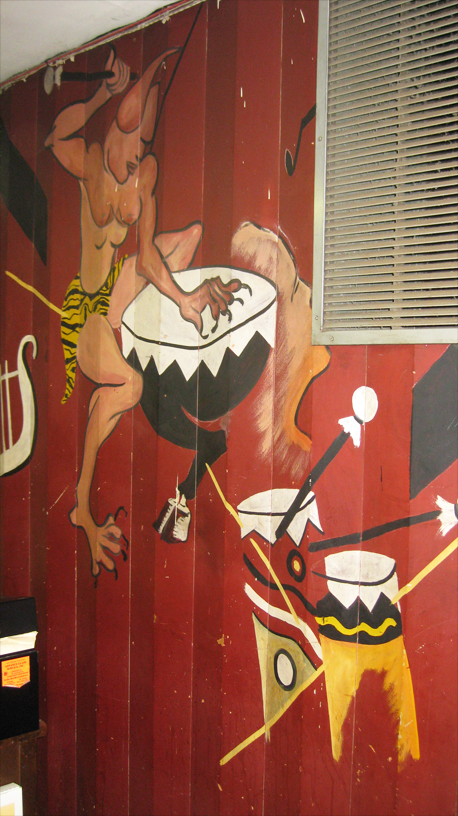
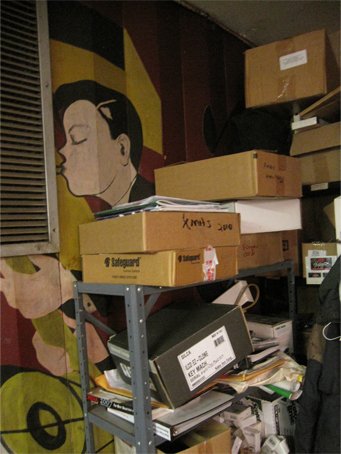
The Defender ads made special mention of his Wurlitzer "electronic" piano, which is what the company preferred to call it. This would have been a significant novelty for clubgoers in those days; Sunny had spotted a very early model (probably the EP-110) in a music store not long after it first became commercially available.
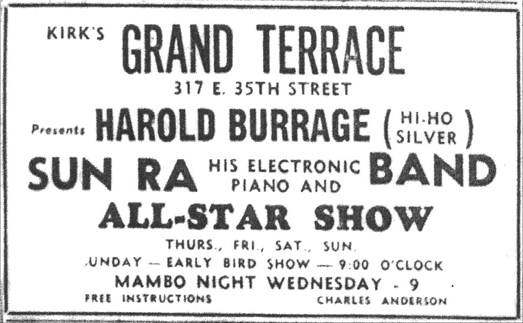
The first known recording of Sun Ra playing his new electric piano came to light recently. It was a two-sided 78-rpm lacquer that ended up in the hands of Jimmie Davis, the proprietor of Club 51 records, presumably because it was submitted to him as a demo. In the early 1970s, it was in a large batch of acetates that Davis sold to collector Richard Reicheg.
The labels on the acetate were left blank, which suggests that Davis paid little attention after receiving it (he wrote names and titles on the labels of some others that were submitted to him). Club 51 was in operation from 1955 through 1957, and Davis ran a disk-cutting machine in a room in the back of his record shop where many cheap demos were cut. But the disks that groups cut elsewhere and presented to Davis (we are familiar with demos by the Freeman Brothers Combo and a King Fleming group, along with others by doowop and gospel groups whose names we do not know) generally date from 1954-1955. The presence on one side of the acetate of John Gilmore, Pat Patrick, and Julian Priester points to the fall of 1955 as the date of origin. And any attempt to interest another small label would have had to precede Sunny and Alton Abraham's decision to start their own company.
Sun Ra (Wurlitzer ep); Julian Priester (tb -1); John Gilmore (ts -1); Pat Patrick (bars -1); Richard Evans (b); Robert Barry (d).
Chicago, Fall 1955
| unidentified title (tk. 1) | unissued acetate | ||
| unidentified title (tk. 2) | — | ||
| Out of Nowhere (Green) -1 | — |
The disk has absolutely no documentation on it or accompanying it; all identifications were made by Robert Campbell.
The Wurlitzer is unmistakable, as is Sunny's manner of playing it. The recording (possibly made direct to a disk cutter, at an unknown location) suffers from placing the microphone too close to the Wurlitzer's built-in speaker, though this is not as serious a problem on "Out of Nowhere." Both sides push the limits of a 10-inch 78, reaching 4 minutes of playing time, with the innermost grooves of "Out of Nowhere" nearly touching the label.
The unidentified title may be a Ra composition. Sunny and the trio run through it twice, at a perkier tempo the second time. Sunny can be heard asking for the second runthrough.
The other side of the acetate begins with the trio playing the standard (and long-time Ra favorite) "Out of Nowhere." They are then subsequently joined by John Gilmore, Pat Patrick, and (briefly) Julian Priester, each soloing. The piece ends, just past 4 minutes, without time for an ensemble to take it out.
The Grand Terrace show apparently started off with some promise commercially, but by the end of October, the ads in the Defender were rapidly shrinking—in linear proportion, we suspect, to the ballroom's revenues. The last advertisement ran on November 5. Before the run ended, Harold Burrage left the revue and his place was taken by another headliner. The Defender's entertainment roundup mentioned the show one more time, on December 3, by which time the Terrace was ready for another period of inactivity. (It would attempt new shows on three different occasions during 1956. The ballroom's final gasp would be a run from August through October 1957.)
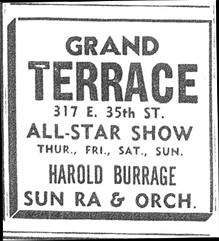
The Grand Terrace job probably didn't call for the entire ensemble—the photo we have shows a quintet. But by the time it started, Sunny had assembled a stable octet of Dave Young (tp); Julian Priester (tb); John Gilmore (ts); Pat Patrick (as, bars); Richard Evans (b); Robert Barry (d); and Jim Herndon (tymp, timb). The best-known photo of the early Arkestra shows this octet lineup doing a one-nighter at the Parkway Ballroom. Another photo from the same period (from the collection of Charles Walton) shows the same group playing the Parkway, with the addition of the Lester Young disciple Johnny Thompson (ts), who, it may be worth adding, had previously worked with such leaders as King Kolax. But Thompson, who appeared on a handful of recording sessions during his career, is not known to have recorded anything with Sun Ra, and John Gilmore did not recall him remaining in the band for long. Tenor battles would not become part of the Arkestra's presentation.
Ra had not yet filed a copyright on a single instrumental composition, but there was starting to be movement on the Arkestral front: Julian Priester copyrighted his pieces “Urnack,” “Soft Talk,” and “Ra's Star” on October 10, 1955; all three were part of the early Arkestra's repertoire, and two were among the first to be recorded. On the very same date, Richard Evans copyrighted “Lullaby of Forrealville,” a piece that would turn up on the July 1956 session for Transition.
In an interview he gave in 2009, Richard Evans told Dan Ubick and David Ma that he was born in Birmingham, Alabama, in 1932, and that his older brother Claude, who had been there for a few years, brought him to Chicago in 1939. He grew up not far from the Regal Theater, where at age 9 he got to see Fats Waller, Duke Ellington, Count Basie, and Cab Calloway. He listened to Al Benson's show on the radio, but also absorbed Polish polka and country music. He took up the string bass in high school. When he joined the first Arkestra, he was 23 years old. This is how Evans recalled his time in the band:
Sun Ra, to my ear, was like a poor man’s Duke Ellington at the time. He was like the planet Saturn; he was just strange and far out. He would do magic tricks a lot. And if you were a horn player in his band, he would write licks for you. Also, you couldn’t say anything negative to him. It wasn’t a band, more like a cult. He was one strict fella.
One time, I painted a sign for him that said “Sun Ra and his fabulous jazz band performing.” I spent about two weeks on it. He looked at it and broke out laughing. He said, “We don’t play jazz, we play dazz.” I took my little painting back, and still don’t know what he meant by that. [laughs]
I stayed with Sun Ra for about a month or so. Even though I left his band, and even though he was a strange fella, he did show me how to get copyrights for my work. I have to give him credit for helping me out with that. (Dan Ubick and David Ma, "Soul Conductor," Wax Poetics Issue 34 (2009; republished in 2014 as "Bassist-turned-arranger Richard Evans put the soul in Cadet Records," Wax Poetics, http://www.waxpoetics.com/blog/features/articles/bassist-turned-arranger-richard-evans-put-soul-cadet-records/)
Evans was actually with the Arkestra for more like 3 months, he was invited back for the first Transition session, and he subbed on a few occasions later. The registration on "Forrealville" confirms his remark about learning how to copyright his compositions.
In the late 1950s, Evans led a piano trio ("that followed Ahmad Jamal around town"). In 1959, the trio made one LP for Argo (Richard's Almanac). The session introduced him to the Chess brothers. After a long tour with Paul Winter in 1962, Evans arranged and, after a quarrel between the leader and the producer, ended up producing an Ahmad Jamal LP; in 1963, he became a house arranger for the Chess brothers. From 1967 through 1970, Evans produced sessions for Cadet (the Argo subsidiary with a new name) and effectively ran the label, being responsible for LPs by The Soulful Strings, Dorothy Ashby, Marlena Shaw, and Woody Herman, among others. He later produced and arranged LPs for Capitol and Atlantic, finishing his career in Boston, as a professor at the Berklee College of Music. Richard Evans died in 2014.
The primary venue for the full Arkestra during this formative period was the Parkway Ballroom. Because the Parkway, like other ballrooms and halls that mostly did one-nighters, made its own special deal with Local 208, which was renewed once a year, bandleaders did not file individual contracts for their appearances. So we don't know how often the Arkestra played the Parkway.
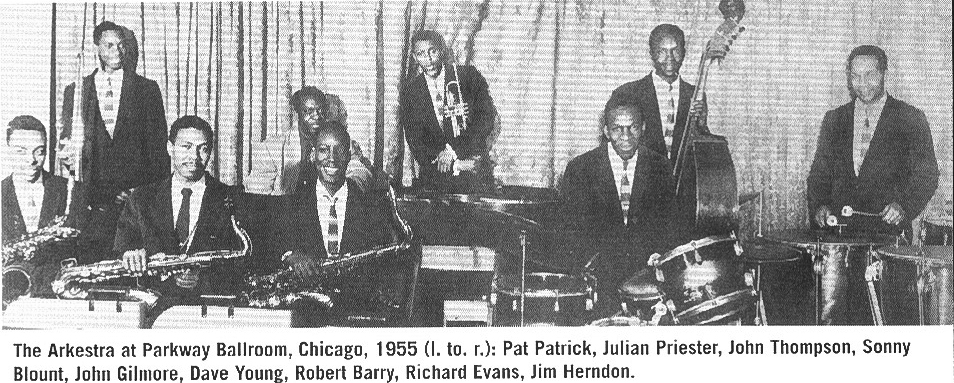
According to Julian Priester, Sunny and the Arkestra were taken in by a slick promoter who claimed to be able to book a major show for them in Chicago, followed by a European tour. After much Arkestral rehearsing with singers and dancers, the initial event fell through and the band was left without work during the Christmas season. But the setback proved temporary.
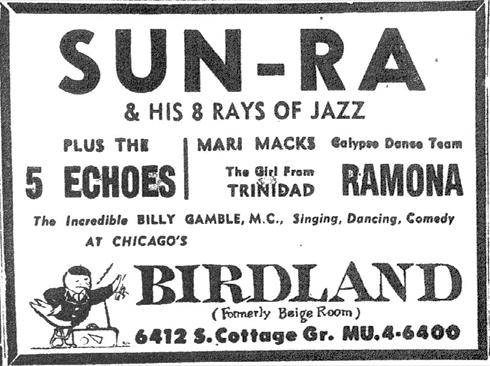
The Arkestra's gigs become easier to track once it got its first break—steady work at Cadillac Bob's Birdland. Birdland was a locale with considerable meaning for Sun Ra, for until Cadillac Bob took it over and pumped some new life into it, the basement club had been known as the Beige Room. Cadillac Bob, whose real name was Robert Cherry, had previously operated a club called the Toast of the Town. Coleman Hawkins was booked for a long run there in 1953, when Sunny recorded with him for Parrot. Cadillac Bob also managed the Flame Lounge and Basin Street for a while in 1953-1954.
Birdland opened on December 8, 1955 (Local 208 Board meeting minutes, December 15, 1955, p. 3). Cadillac Bob still owed money to Ivory Joe Hunter for an engagement at the Toast of the Town, which put him in a sticky situation with the Union local that he had to move quickly to resolve. The first band to play the new club was Arnett Cobb's. From December 21, 1955 through January 1, 1956, the Miles Davis Quintet headlined there (contract posted with Local 208 on December 15). The Arkestra's first contract with Birdland, for two weeks with option, was accepted and filed by Local 208 on January 5, 1956, in the name of Sonny Blount. On January 19, he posted a new contract as "La Sonya Ra." On February 2, he filed a contract for two weeks with options and a second, indefinite contract with "the Birdland," both as Sonny Blount. At least Local 208 knew how to spell his old name.
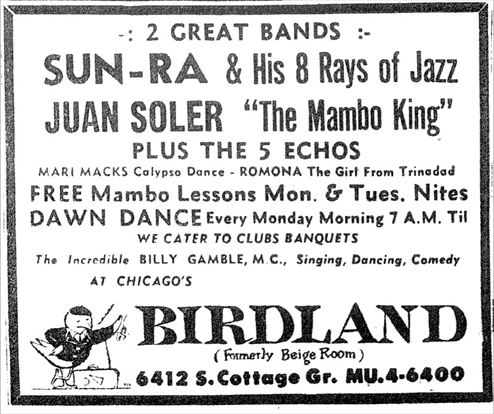
Now that they had regular work at Cadillac Bob's establishment, Sunny's band was finally ready to record on something besides his home tape machine. His working methods were already set. Constant rehearsals had been part of his musical life in Birmingham. In Chicago, they were just like going to work—five days a week, eight hours a day. Everyone remembers the rehearsals, especially Art Hoyle, who had to drive all the way from Gary, Indiana. Like Ellington, Ra would write pieces as he sat at the piano, handing out individual parts to each band member. On the gig, there was no fixed program; Sunny would signal the next piece in his piano introduction—and to the musicians' frustration he would often change it around from the way they'd done it in rehearsal.
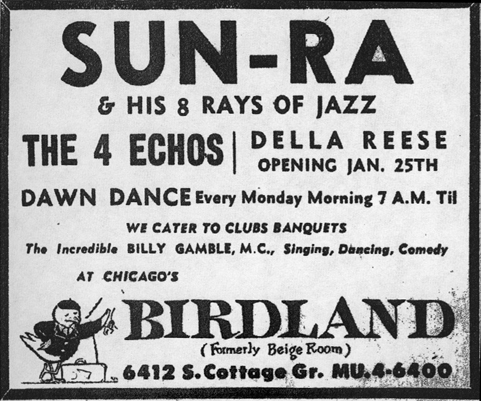
When the band opened at Cadillac Bob's basement club, Wilburn Green was playing what Sunny quaintly called the "electronic bass" and Gilmore's old Air Force buddy Art Hoyle had become the Arkestra's main trumpeter. We are able to hear their efforts because Alton Abraham, his brother Artis, and Sun Ra had put together a new company called Saturn Records and found some capital, and the new label booked time at various studios including Balkan and RCA Victor.
Sun Ra was working with still another vocal group around this time. Two singles by Walter Dunn and the Metros were released in 1968 on Alton Abraham's Repeto label, a Saturn subsidiary. Because Abraham copyrighted one of the tunes in 1963, it was formerly thought that the Dunn sides were cut in that year, by a group of Chicago musicians not involving Sunny.
However, Michael Anderson's archival research turned up two rehearsal tracks for the Dunn session and a date of January 17, 1956 for these plus the four released sides. It is not clear to us, however, that the Dunn rehearsals (with just piano and drums) were made on the same date as the released sides; also, we question whether any of the Dunns were studio recordings. Although four released titles sound much better on the original tapes than on the Repeto singles, which suffered from poor mastering, the balance still doesn't suggest studio conditions.
There is also some question whether Sunny played on the sides. Given a 1956 date, this seems likely (though it is worth noting that Alton Abraham once identified the pianist on the date as Muhal Richard Abrams, who was already on the scene in 1956).
Walter Dunn (voc) with four unidentified male vocalists; Sun Ra (p); Robert Barry (d).
Rehearsal, Chicago, poss. January 1956
| I'll Close My Heart (Dunn) | Transparency 0316 [CD, disk 9] | ||
| When You're in Love This Way (Dunn) | Transparency 0316 [CD, disk 9] |
These rehearsal tracks were first released in 2011 on Transparency 0316, a 14-CD set titled The Eternal Myth Revealed Vol. 1.
Walter Dunn (voc); four unidentified males (voc); Sun Ra (p, dir); poss. Johnny Thompson (ts); poss. Richard Evans (b); Robert Barry (d).
Chicago, poss. January 17, 1956
| When You're in Love This Way (Dunn) | Repeto 4223 | ||
| Perfidious Lover (Dunn) | Repeto 444-C/1001, Transparency 0316 [CD, disk 9] | ||
| Christina, Eugena, Marie (Satanas-Dunn) | Repeto 444-D/4235, Transparency 0316 [CD, disk 9] | ||
| I'll Close My Heart (Dunn) | Repeto 4232 |
The Repeto singles were released in 1968. The label's numbering system was eccentric even by Saturnian standards: 4223 was coupled with 444-C/1001, and 444-D/4235 was coupled with 4232. Another Saturnian touch was the composer credit to "Satanas"; "Christina, Eugena, Marie" was copyrighted on May 6, 1963 by Walter Dunn and Alton Abraham. Because Sun Ra was not thought to be involved, the Repetos were not included in the Saturn singles collection on Evidence.
"Perfidous Lover" and "Christina, Eugena, Marie" were reissued in 2011, in much improved sound, on Transparency 0316, a 14-CD set titled The Eternal Myth Revealed Vol. 1. Both sides are unusually long for a 7-inch 45: "Christina" clocks in at 3:58 and "Perfidious" at a full 5:00. Personnel were identified by ear. The tenor saxophonist, who is not John Gilmore, gets a solo on each side. Michael Anderson suggests Johnny Thompson. However, we can't go along with Anderson's suggestions of Ronnie Boykins on bass (the date is too early) or Tommy "Bugs" Hunter on drums (in 1956, Hunter was living in New York).

Another group that Alton Abraham once said he had recorded was called the Clock Stoppers. The Stoppers were sometimes thought to have been a vocal group (it turns out they weren't). Of course everyone wondered whether Sunny had some connection with the group (it turns out he didn't have any). Abraham recorded the group, but he didn't keep a copy of their 45, which wasn't on Saturn, Satur, or Repeto, and isn't in the Alton Abraham Collection at the University of Chicago.
We were alerted to Clock 985, a 45-rpm single with a very plain black on white label, by Dante Carfagna (email of June 30, 2020). "Please Little Girl" (C-985-A) and "Got to Be Mellow" (C-985-B) were credited to The Clock Stoppers (W. Truman, Vocal). W. Truman also got both composition credits. Carfagna points out that "Got to Be Mellow" was by Leon Haywood, whose rendition was released in October 1967. The Clock Stoppers were a soul group, just W. Truman with electric guitar, electric bass, and drums. Recording balance was a bit amateurish. The only positive sign of Abraham's role: the publishing credits went to Enterplan (incorrectly, for the B side). So a minor mystery has been solved. The Clock release looks like an Alton Abraham project from 1967 with no input from Sun Ra.
Sun Ra (still using the name Herman Blount as well as Le Sony'r Ra) suddenly began copyrighting instrumental compositions, with “Satana and Saturn” on February 1, 1956. “Satana: Verse” was never recorded; “Saturn: Interlude” and “Saturn: Chorus” are the piece that has become familiar to us. Apparently, the interlude was composed after the chorus; John Corbett says that a 1955 rehearsal tape has come to light that includes only the chorus. On February 6, 1956, Sunny copyrighted “Super-Blonde” and “Call for All Demons.”. Sunny also copyrighted “East of Uz” on February 1, “Velvet” on February 6, and “Beta-Beta” (as in the early Saturn slogan, "Beta Music for Beta People for a Beta World") on February 13. “Velvet” was subsequently recorded by the Arkestra on multiple occasions; the other two were not, so far as we know, though “East of Uz” got a belated premiere in 1976, when Pat Patrick's Baritone Retinue included it on the only Saturn LP under Patrick's own name.
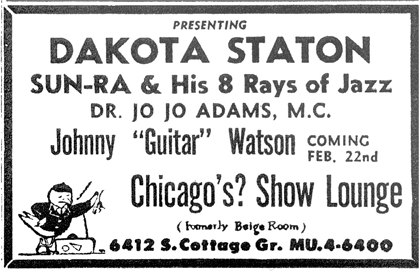
Soon Birdland, in trouble with its namesake in New York, was on the lookout for a new handle. Morris Levy, the proprietor of the original Birdland, had a concert featuring some of his headliners coming up at the Opera House in mid-February. On finding out that the Chicago also had a Birdland, he promptly filed suit (as announced in the Defender for February 11). On February 18 and 25, the club was being advertised as "Chicago's ? Show Lounge"; on March 3, an ad annnouncing a reengagement for the Miles Davis Quintet referred to it as the "Birdband Show Lounge"—an experiment not to be repeated, as the club would revert to namelessness for a while.
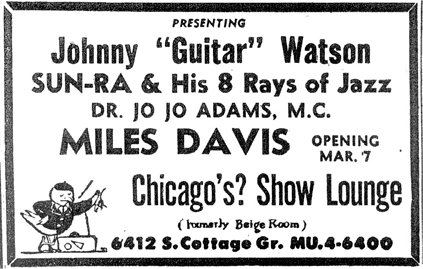
The Miles Davis gig, promised for March 7 through 18, fell through. No contract for it was filed with Local 208; according to Chris DeVito, Miles had left his sidemen stranded in Los Angeles at the conclusion of an engagement there in late February, returning to New York by himself and doing some recording there on March 16. Consequently the Arkestra, though not mentioned in the March 3 ad, seems to have split the month with a combo led by Al Smith. Duke Groner's combo was brought in for a week to help out. (Our thanks to Chris DeVito for information about Miles Davis's engagements during the period.)
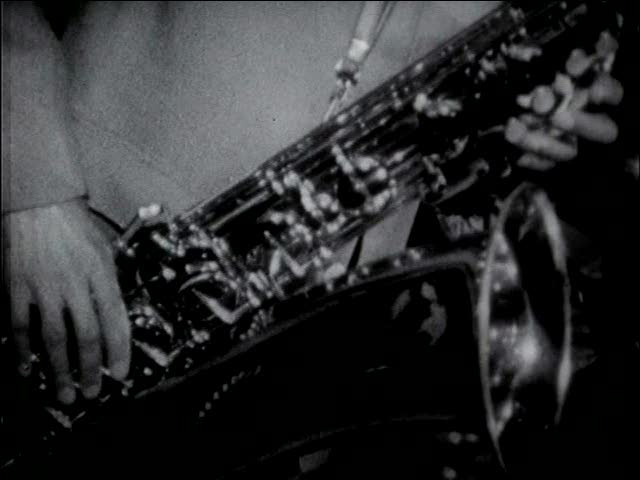
It is known that Sun Ra wrote arrangements for B. B. King and for Johnny “Guitar” Watson. Watson was on the same bill with the Arkestra at Birdland starting on February 22, 1956; he filed a two-week contract with "Chicago Birdland" on February 16. King was at the club from December 12 through 16 (five-day contract filed on December 6, 1956). As with all such work, which he regarded as routine, Sunny never gave details in interviews.
Among the other performers who shared the bill with the Arkestra were "Mambo King" Juan Soler (second week of January), the doowop group The Five Echoes (January), guitar-playing bluesman Lowell Fulson (late January and early February), singer Della Reese (late January), singer Dakota Staton (February), bassist Duke Groner and his combo (one-week contract with Chicago Birdland filed on March 1, followed by another week in December), singer Dinah Washington (a week at the end of June, followed by another 3 weeks in late July and early August, and another two weeks starting on Christmas eve), singer Jerri Winters (early July), blues shouter Jimmy Witherspoon (July), Eddie Boyd's trio (indefinite contracts filed on September 20 and October 4), Little Miss Cornshucks (late October and early November), Al Hibbler (late November), Ruth Brown (early December), Earl Swann (five-day contract posted on December 6), and Richard Whatley (a drummer and bandleader who more often went as Don Costello; his indefinite contract with Budland posted on the same date).
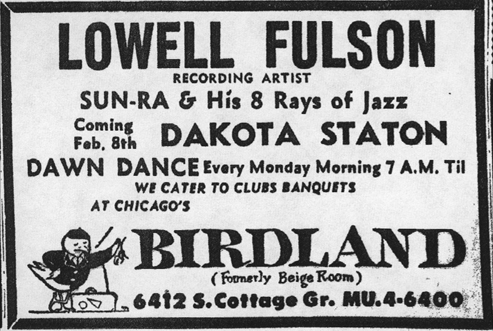
Al Smith's band (which we know was at least 7 pieces, because Smith had to answer to the Board of Musicians Union Local 208 about not charging the higher leader's fee for a larger group) took over on March 19 and remained in residency through the first week of May. (We don't know whether Smith's band also played the Monday morning breakfast dance, or the Arkestra continued in this role). Sunny always said that he suggested the name "Budland" to Cadillac Bob. There is no reason to doubt this, but the first advertisement to give the club its new name, which appeared on March 31, cited Al Smith as the house bandleader instead of Sunny. The first recording sessions for Saturn took place during this hiatus from Budland.
We will assume that “Super Blonde,” as issued on a Saturn single and later on an LP, is a variant of the track now called “Supersonic Jazz.”
Sun Ra (Wurlitzer ep -1, p); Art Hoyle (tp); Julian Priester (tb); John Gilmore (ts); Laurdine “Pat” Patrick (bars); Wilburn Green (eb); Robert Barry (d); Jim Herndon (tymp, timb -1).
Balkan Studio, Chicago, around March 22, 1956
| 100- A 22 | Super Blonde (Le Sun-Ra) | Saturn Z1111-B, Saturn H7OP0216^, Saturn SR-LP 0216^, Impulse AS-9271, Evidence 22015 [CD] | |
| 100 B 22 | Soft Talk (Priester) | Saturn Z1111-A, Saturn H7OP0216^, Saturn SR-LP 0216^, Impulse AS-9271, Evidence 22015 [CD] | |
| Medicine for a Nightmare (Ra) [2nd version] -1 | Saturn H7OP0216^, Saturn SR-LP 0216, Impulse AS-9271, Evidence 22015 [CD] | ||
| Medicine for a Nightmare (Ra) [alt.] -1 | Evidence 22164 [CD] | ||
| Advice to Medics (Ra) [ep only] -1 | Saturn H7OP0216^, Saturn SR-LP 0216, Impulse AS-9271, Evidence 22015 [CD] |
Saturn Z1111, a 45 rpm single with a yellow label, has been referred to as the Arkestra's first release. We used to doubt that, but the paperwork for the pressings shows that it really was. And the “Arkistra” spelling points to a release in 1956. Preserved in the Alton Abraham Collection (Box 4, Folder 22) is a receipt from a pressing plant, Musical Products Co. at 561 West 16th Street, for 132 copies of Z1111. It is dated May 4, 1956. Saturn may not have been satisfied with Musical Products as a supplier, because we have not seen any other invoices from this company in the Alton Abraham Collection; given the shortness of the initial run, other pressing plants may have been called on later.
Rumor has had it that Z1111 was the only Saturn to come out on 78 rpm. We are not sure that this happened, as we have never seen a Saturn 78. But one must habe been projected, because a label for "Soft Talk," in 78 rpm format, is preserved in the Alton Abraham Collection (Box 17, Folder 7); it is stamped May 31, 1956 on the back.
The late Otto Flückiger owned a copy of Z-1111 and supplied the matrix numbers, which we've verified from a copy in the Alton Abraham Collection (Box 67). Photos of the label are displayed in Geerken and Hefele's book; personnel are listed right on it.
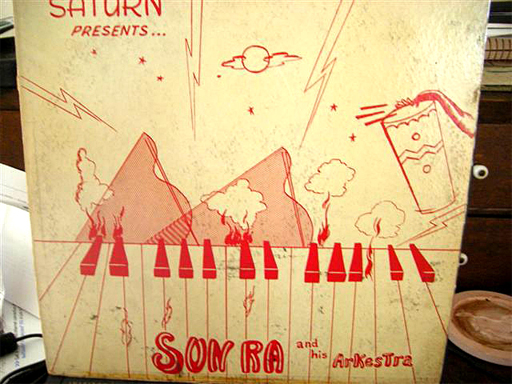
Both sides of Saturn Z1111 reappeared in March 1957 on the first Saturn LP, Super-Sonic Jazz. The serial number of this LP was originally H7OP0216 (thanks to Alden Kimbrough for this information; the matrix numbers for the two sides were H7OP-0216 and H7OP-0217). The first pressing of this LP carried a jacket with an illustration by Claude Dangerfield of a keyboard with flames and lightning bolts and hands playing a conga drum—all printed in red on white. (On extant copies, the white covers have yellowed with age.) A later variant of the cover displayed the same art in black on pink-purple.
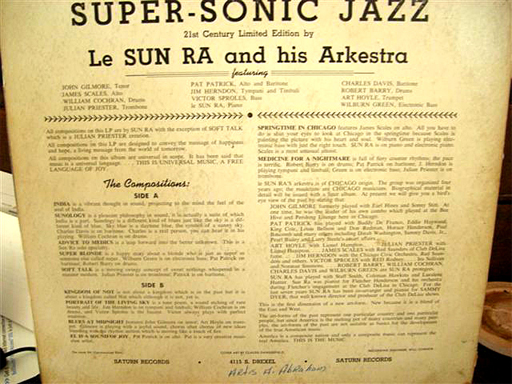
By 1959, when the LP was mentioned in the credits to The Cry of Jazz, the serial number had been changed to SR-LP 0216; around 1961, it was given a new cover; in 1967, the LP was given the catalog number 204. Later pressings on El Saturn show this number on the labels. All tracks from the LP were reissued in 1974 on Impulse AS-9271, under the title Super Sonic Sounds. “Super Blonde” was retitled “Super Bronze” on the Impulse release only. All tracks were reissued on Evidence 22015 [CD] in 1992 under the original title.
"Super Blonde" was used on the soundtrack of The Cry of Jazz, a short film that would not be completed until the summer of 1958. At 20:42 into the film, "Super Blonde" starts with the piano intro by Sun Ra. Visually, most of this segment presents an octet at Budland in 1956 with a four-man front line with John Gilmore, tenor sax, Art Hoyle, trumpet, Julian Priester, trombone, and Pat Patrick, baritone sax. Both drums and tympani are visible, as is a string bass player. As heard in the film, the number includes a brief trumpet solo by Art Hoyle, followed by the dissonant central ensemble, and a Pat Patrick baritone sax solo that cuts off abruptly at 21:50.
The previously unreleased alternate of “Medicine for a Nightmare” was discovered in 1993 during research on the Saturn singles; it was issued for the first time in September 1996, on the Saturn singles collection from Evidence (The Singles, Evidence 22164 [2 CDs]). On the alternate take, Ra plays piano throughout. Herndon was usually credited on Saturn jackets with playing “timbali”; according to Allan Chase, these were timbales tuned lower than usual.
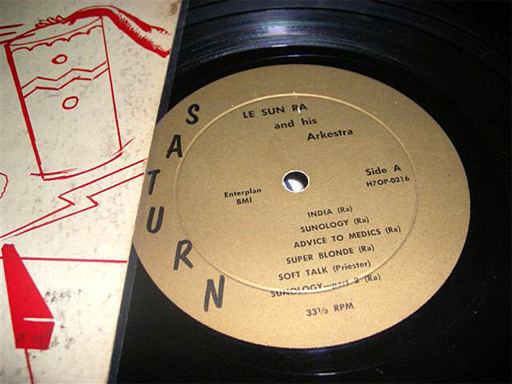
Copyrights provide no clue to the precise recording date, because Sunny apparently neglected to copyright “Medicine for a Nightmare.” and waited till after the LP had been released to register his electric piano solo “Advice to Medics.” "Advice" was copyrighted on April 8, 1957, as Part III of "Prevues of Tomorrow (A Suite of Translated Thought)." In the first and second editions of the discography, we placed this number on the session we have now dated to November 21, 1956 (see below). But it was not listed on any tape boxes from the session.
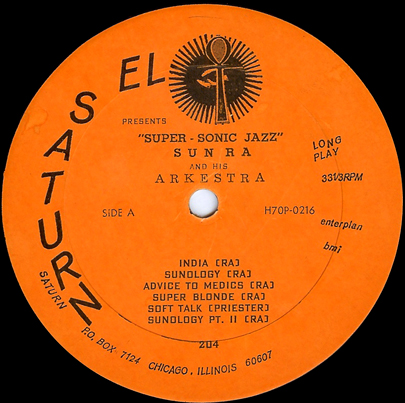
Sun Ra (p, Wurlitzer ep); Art Hoyle (tp -1); Julian Priester (tb -1); James Scales (as); Pat Patrick (bars -1); Wilburn Green (eb); Robert Barry (d); John Gilmore (space bells, perc).
Balkan Studio, Chicago, April 13, 1956
| Springtime in Chicago (Ra)^ | Saturn H7OP0216, Saturn SR-LP 0216, Impulse AS-9271, Evidence 22015 [CD] | ||
| New Horizons (Ra)* -1 | Saturn HK 5445, Evidence 22038 [CD] | ||
| Journey in Discland | Saturn (unissued) | ||
| Ebb Tide | - |
“Chicago in Springtime (Springtime in Chicago)” was copyrighted on May 21, 1956. The later copyright date and the presence of James Scales (who was not in the “8 Rays of Jazz” from January through mid-March) indicate that this tune was not part of the session that produced Z1111.
Steve Espinola notes that by this session, Sunny's Wurlitzer electric piano had developed a fault especially common in the earliest models: a broken reed that produced an off-pitch note (in this case, the F# above middle C was flat). Before the Arkestra's fall sessions, Sunny got his instrument repaired.
There is a Musicians Union recording contract, once in Alton Abraham's files, for a 3 hour session at Balkan Studios. Balkan was a lower-cost establishment. The home base for Balkan Records, a small Chicago label that specialized in polkas and Serbian music, it was occasionally used by other independent labels in Chicago; for instance, United cut a gospel session there in 1952. According to the contract, which was on display at the Hyde Park Art Center in Chicago in late 2006 and early 2007, the session took place on April 13, 1956. We had previously estimated April-May 1956 as the approximate time frame for “Springtime in Chicago,” so the date fits.
“Springtime in Chicago” appeared in March 1957 on the first Saturn LP, Super-Sonic Jazz. The serial number of this LP was originally H7OP0216; the cover, by Claude Dangerfield, featured a piano keyboard with flames and lightning bolts. The serial number was subsequently changed to SR-LP 0216; probably in 1961, the cover art was changed to another Claude Dangerfield illustration featuring solar and musical symbols. In 1967, the LP was given the catalog number 204, and starting in 1968, this number actually appeared on the labels. All tracks from this LP were reissued in 1974 on Impulse AS-9271, under the title Super Sonic Sounds. All tracks were reissued on Evidence 22015 [CD] in 1992 under the original title.
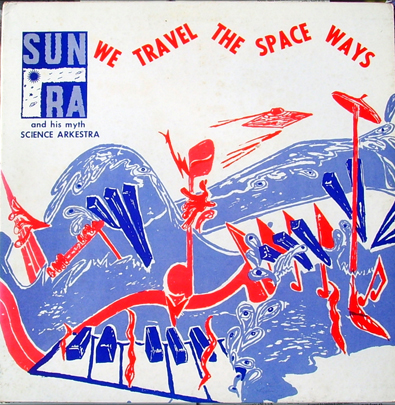
Saturn HK 5445, released in 1967, was an LP entitled We Travel the Spaceways. It was given the catalog number 409. The album used a Claude Dangerfield cover of waves and musical symbols that dated back to the late 1950s. The album may also have circulated under the serial number ESR 5445. All items from this album were reissued in 1992 on Evidence 22038 [CD]. It has sometimes been claimed that this version of “New Horizons” is an alternate take from the July 12, 1956 Transition session at Universal Studios, but its absence from the outtake pressing from that session and the less-than-perfect recording balance indicate a different origin. (Gilmore's bells are too close to the microphone on both released sides from this session.) We further note the earlier copyright date (“New Horizons” was copyrighted on April 24, 1956, while most of the material from the Jazz by Sun Ra session was copyrighted in a batch on July 17).
The unissued titles were mentioned in the documentation for a tape made at Balkan Studios; Green and Scales' names were on the tape box.

Sun Ra (p); Jim Herndon (tymp); Robert Barry (d); prob. John Gilmore (bells); unidentified (bells, scrapers).
Rehearsal?, Chicago, 1956
| Adventur [sic] in Space (Ra) | Saturn 874, Evidence 22164 [CD] |
This piece was issued around 1968 on Saturn 874, a 45 rpm single; Ihnfinity (which was incorporated in 1967) is credited on the label, and the title was misspelled “Adventur.” The abrupt editing suggests a Sun Ra solo excerpted from a longer performance; sonics are a little rugged for a studio recording. Lucious Randolph has confirmed that Ra sometimes played like this in Chicago and believes the tympanist is Jim Herndon. The drummer sounds like Robert Barry in his work with Herndon. Alton Abraham confirmed Herndon's presence. The side was reissued in September 1996 on Evidence 22164, a 2-CD set titled The Singles.
James Wolf has discovered that the piece was copyrighted on April 25, 1956! While the precise circumstances of the recording remain mysterious, we wonder whether this item was originally titled “Journey in Discland,” (or excerpted therefrom). Either would put it on the session of April 13, 1956.
Sun Ra (p, Wurlitzer ep); James Scales (as, bells); Wilburn Green (eb).
Chicago, April 23, 1956
| Somebody Else's World (Ra) | Transparency 0316 [CD, disk 12] | ||
| Blues in Outer Space (Ra) | Transparency 0316 [CD, disk 12] | ||
| Space Aura (Ra) [inc] | Transparency 0316 [CD, disk 12] |
These three tracks were first released in 2011 on Transparency 0316, The Eternal Myth Revealed Vol. 1, a 14-CD set compiled by Michael Anderson. "Somebody Else's World" has the familiar motif, accompanied on the electric piano, but changes to straight 4/4 with piano accompaniment for Scales' alto sax solo. The identities of the participants are obvious. Anderson describes these as items from a rehearsal and gives the date as April 23, 1956. Sound quality is unusually good, raising the question whether they are in fact from another outing at Balkan Studio. A Union contract in the Alton Abraham collection was filled out by Sun Ra and dated May 16, 1956 (almost certainly an instance of postdating; below, we'll see that the Elks Hall contract was postdated from June 10 to August 30, 1960); it identifies the session as 4 tunes, 3 hours and gives Ra, Scales, and Green as the personnel.
A tape box of unreleased Saturn material apparently once contained an early recording of Sun Ra's composition “State Street.” The date on the box was May 7, 1956. No other details are known. This could also have come from Balkan Studio.
Balkan was a little bitty business, without the impressive back-office operation to generate the invoices and test pressing reports in triplicate that Saturn would get from RCA Victor. The surviving receipts from Balkan (all handwritten on small forms, and in some cases illegible) in the Alton Abraham papers (Box 4, Folder 22) are dated March 22, April 21, April 26, May 5, and June 6, 1956. Contrary to what we used to believe, there is no evidence of activity at Balkan Studio after June 6. The only other correspondence with Balkan in the Alton Abraham papers is a letter dated September 1, 1956, asking for payment of $25 still owed on the "May balance."
Now Sunny landed a gig with another brand-new Chicago-based independent—the Heartbeat label, run by record store owner Seymour Schwartz. Schwartz wanted to record a singer named Billie Hawkins doing two of his own compositions, and hired the Arkestra to accompany. As it happened, Schwartz also booked the RCA Studio for his session. We had previously dated this session to January 1956, but given what we now know about Saturn and recording studios, we have put the first Arkestral session at RCA Victor in mid-May. The matrix numbers on the Heartbeat single are just a little earlier in the same series. And Schwartz may, in fact, have introduced Ra and Abraham to RCA Victor, s company with which they would have a fairly steady relationship through 1961.

Billie Hawkins (voc); with Sun Ra (p; arr); Art Hoyle (tp); Dave Young (tp); Julian Priester (tb); John Gilmore (ts); Pat Patrick (bars); Wilburn Green (eb); Robert Barry (d).
Rehearsal, Chicago, prob. April 1956
| I'm Coming Home | Transparency 0316 [CD, disk 12] | ||
| Last Call for Love | Transparency 0316 [CD, disk 12] | ||
| Kiss Me Sweet | Transparency 0316 [CD, disk 12] | ||
| At Last | Transparency 0316 [CD, disk 12] |
It turns out that one of Billie Hawkins' rehearsals with the Arkestra was recorded. These four tracks were released in 2011 in Transparency 0316, a 14-CD set titled The Eternal Myth Revealed: Volume 1. Michael Anderson gives the date as January 12, 1956 in the notes to the Transparency box. We suspect this is too early, on account of the revised dates for the Billie Hawkins session and the Arkestra session at RCA Victor.
All participants in the rehearsal were identified by Robert Campbell. Two trumpets are clearly present; it appears that the entire band was at the rehearsal except Jim Herndon.
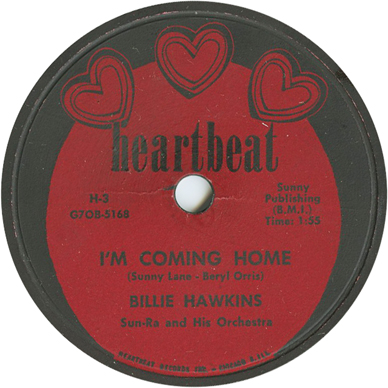
Billie Hawkins (voc); with Sun Ra (p -1, 2; Wurlitzer ep -2; arr); Art Hoyle (tp); Dave Young (tp); Julian Priester (tb); Pat Patrick (as, bars -1; bars -2); John Gilmore (ts); Wilburn Green (eb); Robert Barry (d); Jim Herndon (tymp -2).
RCA Studios, Chicago, April or May 1956
| G7OB-5168 G7OW-5168 |
I'm Coming Home (Sunny Lane-Beryl Orris) -1 | Heartbeat H-3 | |
| G7OB-5169 G7OW-5169 |
Last Call for Love (Tom Seymour) -2 | Heartbeat H-4 |
Our thanks to Freddie Patterson for rediscovering what may be the earliest release, by the Arkestra—though Sun Ra wasn't using that spelling in his publicity yet, and Heartbeat, which put this single out in 1956, wasn't doing it either. It isn't the earliest studio recording by the band, but Schwartz probably got his single out faster than Alton Abraham could with the first Saturns. The quality studio recording and the matrix numbers are from RCA's Chicago operation; in fact, the matrix numbers are just a little earlier than those found on the second Arkestra single on Ra's Saturn label. Two trumpets are present, and Green is on electric bass, so we know this is the Arkestra after Christmas 1955.
Helping to confirm the date on this session is Steve Espinola's observation that the F# above middle C has gone flat on Sunny's Wurlitzer electric piano.
In 2011, four tracks (two of them quite brief) from Sunny and the Arkestra's rehearsal with Billie Hawkins were released on Transparency 0316, a 14-CD set titled The Eternal Myth Revealed: Volume 1. This compilation is also the first to reissue the the Heartbeat sides. However, the Transparency notes claim that these sides were recorded at the first Arkestral session for Saturn. This is clearly not the case: there are two trumpets on the Heartbeats, but not on the first Saturns, and the matrix numbers to the Heartbeats do come from an earlier block.

The original labels identify Billie Hawkins as the artist and mention Sun-Ra and His Orchestra in small print underneath. Heartbeat H-3/H-4, the first record on Seymour's new label, was released on both 78 and 45 rpm; RCA Victor used different code prefixes for 78s (G7OB) and 45s (G7OW). The record is rare on 45 and even scarcer on 78. Heartbeat would put out one more record in 1956, releasing another version of "Last Call for Love" by Country singer Bob Atcher on 45 only; the labels showed the three-heart design in a different color scheme. Heartbeat then went dormant, reopening in February 1958 with a new business partner for Seymour Schwartz and a very different label design (black print on gold) that set the pattern for all subsequent releases.
All personnel were identified by Robert Campbell. In a 2003 interview, Seymour Schwartz recalled that Billie Hawkins was a sexually ambiguous male singer. (Hawkins is referred to as "she" in the notes to the Transparency box.) Schwartz also said he wrote the tunes for the session (“Tom Seymour” is a thin pseudonym, and his daughter's name is Sunny; the publishing companies, Heartbeat and Sunny, were both in-house).
There would be no further opportunities for the Arkestra with Schwartz's operation. Heartbeat didn't really get going until its relaunch in 1958, when it became a vehicle for Schwartz's cornet playing instead of his songwriting. His rendition of "Peg o' My Heart," done "right down the middle of the road" with organ accompaniment, was released on St. Patrick's Day, 1958, and quickly picked up by jukebox operators in the area around Chicago, setting the label's main direction until it closed in 1966.
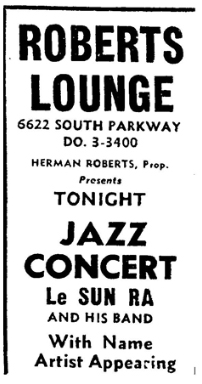
The first Arkestra we can hear for ourselves was a mutant hard-bop band. Bop wasn't Sunny's music exactly, but it was what the young musicians in the Arkestra understood. And there wasn't anything conservative about such music in 1956. It was modal hard-bop, polytonal hard-bop, polyrhythmic hard-bop. Sunny wrote a new tune in honor of his "home planet"; "Saturn," with interlude and chorus, became the band's theme song. It convinced John Gilmore that Sunny's music offered endless possibilities, that it was "morestretched out than Monk."
The very first studio recording of the piece was briefly available on a Saturn single in November 1956. Although Alton Abraham recalled the release and supplied a master tape for the Evidence reissue in 1996, he no longer had a copy of the actual single in his possession. One finally showed up on the collectors' market, a decade later.
We had previously placed the next session in February 1956, relying on copyright dates for some of the compositions. But it now appears that the Arkestra was using Balkan Studios from March through early May 1956, and first RCA Victor session did not take place till May 16. On May 21, 1956, RCA Victor billed Saturn for 3 hours of recording time, 6 reels of tape, and 1 hour of transfer time; recording time cost $28 per hour. The order was described as "verbal May 16, 1956," which is the most likely date for the actual session. RCA issued a receipt on May 17, recording payment of $143.50 (both items are now in Box 16, Folder 4, of the Alton Abraham Collection.) There is no Union contract for this—or for any session that we know was conducted at RCA Victor—in the Alton Abraham papers, presumably because RCA Victor handled such paperwork ... and turned it in on time.
Sun Ra (Wurlitzer ep -1, p); Art Hoyle (tp); Julian Priester (tb); John Gilmore (ts); Laurdine “Pat” Patrick (bars); Wilburn Green (eb); Robert Barry (d); Jim Herndon (tymp -1).
RCA Studios, Chicago, May 16, 1956
| G7OW5257 | Saturn (Ra) | Saturn G7OW5257, Evidence 22164 [CD], Paddle Wheel KICJ 315 [CD], Evidence 22219 [CD] | |
| G7OW-5258 | Medicine for a Nightmare (Ra) -1 | Saturn Z222A, Saturn SR 9956-2-O/P, Impulse AS-9245, Evidence 22066 [CD], Paddle Wheel KICJ 315 [CD], Evidence 22219 [CD] | |
| G7OW5259 | Call for All Demons (A Call for All Demons*) (Ra) -1 | Saturn G7OW5259, film soundtrack (edited), Saturn SR 9956-2-O/P*, Impulse AS-9245*, Evidence 22066 [CD]* | |
| G7OW-5260 | Demon's Lullaby (Ra) | film soundtrack (edited), Saturn SR 9956-2-O/P, Impulse AS-9245, Evidence 22066 [CD] | |
| G7OW-5261 | Urnack (Priester) | Saturn Z222B, film soundtrack (edited), Saturn SR 9956-2-O/P, Impulse AS-9245, Evidence 22066 [CD] | |
| G7OB-5261 tk. 1 [as announced in the studio, fs] |
Velvet (Ra) -1 | Transparency 0316 [CD, disk 12] | |
| G7OB-5261 tk. 2 [sic, fs] | Velvet (Ra) -1 | Transparency 0316 [CD, disk 12] | |
| G7OB-5261 tk. 3 [sic, fs] | Velvet (Ra) -1 | Transparency 0316 [CD, disk 12] | |
| G7OB-5261 tk. 4 [sic] | Velvet (Ra) -1 | Transparency 0316 [CD, disk 12] | |
| Supersonic Jazz (Ra) -1 | Evidence 22164 [CD] |
We have RCA Victor-derived matrix numbers for six of these seven pieces (although in one case the number we have from the studio session is inconsistent with the numbering on the early singles).
“Snomed Yballul (English pronunciation: Demon's Lullaby)” was copyrighted on April 24, 1956.
Saturn Z222 ("Medicine for a Nightmare" b/w "Urnack") was a 45 rpm single with black print on gold and the Saturn logo in block letters across the top (information courtesy of Glenn Jones). From a RCA Victor custom pressing invoice in the Alton Abraham papers, we can see that 500 pressings were ordered on June 5, 1956. The first shipment arrived on June 11. Saturn ordered another 175 copies on June 14 and another 287 on June 20. “Arkistra” was Sunny's original respelling of “Orchestra.” Sun Ra maintained that there was an “equation of sound-similarity” between “kest” and “kist” but by some point after January 1957 he had settled on “Arkestra.”
We think the same version of "Medicine" was used on the Z222 single and the much later LP, Angels and Demons at Play. It would nonetheless be nice to have confirmation. Steve Espinola has observed that "Medicine" as released on Angels and Demons includes the out of tune F# on Sunny's electric piano; in fact, Sunny plays around with the in-tune F and the flat F#.
According to Alton Abraham, “Saturn” was released on one of the first Saturn singles. A 1961 Saturn press release listed “A Call for All Demons” and “Demon's Lullaby” as appearing on singles. Art Hoyle recalled these two were coupled on a Saturn single in 1956, and Julian Priester also reported that “Call” appeared on a single. In 2006, Saturn G7OW5257/G7OW5259 (nothing on it but the matrix numbers) showed up for sale on ebay. It turned out to be a coupling of the first version of “Saturn” (Side A) with “Call for All Demons” (Side B). An order for test pressings from RCA is retained in the Alton Abraham papers. "Call for All Demons" and "Saturn" were two of the three 45-rpm test pressings ordered on August 2, 1956. On October 15, 1956, Saturn placed an order with RCA Victor for 254 copies of G7OW5257/5259, taking delivery on October 23. A statement from RCA Victor dated November 5, 1956 shows that Saturn was paying 20 cents a record for the pressings (Alton Abraham papers, Box 16, Folder 6). The total quantity ordered was down significantly from Z222, which helps to explain why it took so long for collectors to find 5257/5259.
The third test pressing in the August 2, 1956 order is for "Somed [sic] Zballul [sic]," title still spelled backwards. The matrix number is given as G7OW-5260.
A draft of a release announcement for Saturn LPs (none of which materialized under those titles) is now published in Pathways to Unknown Worlds (p. 120),. It identifies the first three Saturn singles, giving the actual pairings. It does not mention “Demon's Lullaby.”
“Supersonic Jazz” was found during master tape research for the Evidence singles collection. It presumably had a matrix number in RCA's G7OW series, but this has not been recovered. The piece is similar to “Super Blonde”: both are blues with the same opening riff and virtually identical solo lineups; however, in “Supersonic Jazz” the central, highly dissonant ensemble passage is replaced with a tympani break by Jim Herndon.
“Supersonic Jazz” and “Demon's Lullaby” may have been paired on another Saturn single still to be rediscovered, though we have not found any paperwork for it. Could the very first release of "Lullaby" really have been in the 1959 film The Cry of Jazz, where it was edited down to 1 minute?
Finally, the first version of "Velvet," cut at this session, remained unknown until all four takes of it were released in 2011 on Transparency 0316, a 14-CD set titled The Eternal Myth Revealed, Volume 1. There it is attributed to a session in May 1956. The Arkestra is audibly the same ensemble as on the rest (note Wilburn Green's prominent electric bass) and the engineer calls out "G7OB-5261" during take 1. The "OB" code was used on 78-rpm releases; the Saturn pressings ended up instead with the "OW" used for 45-rpm masters. How the numbers got out of sequence (so that 5261 ended up being the matrix number for "Urnack" as released), we of course do not know.
“Saturn” was reissued and “Supersonic Jazz” issued for the first time in September 1996 on The Singles, Evidence 22164 [a 2-CD set]. “Saturn” is also on Sun Ra Came Down to the Earth, a Japanese CD sampler, derived from Evidence releases, which appeared in 1997 on Paddle Wheel KICJ 315, and Greatest Hits: Easy Listening for Intergalactic Travel, released as Evidence 22219 in September 2000.
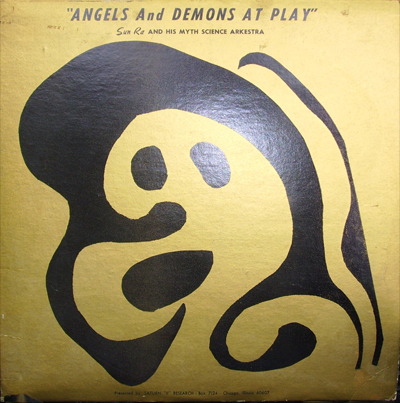
Four tracks from this session reappeared in 1965 on side B of Saturn SR 9956-2-O/P, Angels and Demons at Play. (“Call for All Demons” was titled “A Call for All Demons” on this and subsequent releases.) In 1967 the LP was given the catalog number 407. The album is distinctive among early Saturns in its complete lack of liner notes—there was no room for any, because the same design was used front and back. The cover design is one of three originally done as cutouts in black on a white background. While the Angels and Demons cutout was actually used (in a striking black on gold rendition), the other two, initially intended for the early New York albums When Sun Comes Outand When Angels Speak of Love, were displayed in the 1966 Saturn catalogue but replaced with different covers when the LPs were released. (See Pathways to Unknown Worlds, pp. 63, 64, and 66.) The artist is not identified; John Corbett has suggested that it was Sun Ra himself.
All titles from Angels and Demons at Play were reissued on Impulse AS 9245 in 1974 and on Evidence 22066 [CD] in 1993. This version of “Medicine for a Nightmare” was further reissued in 1997 on a Japanese Sun Ra CD sampler, Sun Ra Came Down to the Earth on Paddle Wheel KICJ 315, and on Evidence 22219, Greatest Hits: Easy Listening for Intergalactic Travel, in September 2000.
Three of the sides from this session also appeared, in excerpts, on the soundtrack of The Cry of Jazz, a 34-minute film produced and directed by Edward O. Bland and originally scheduled for release in October 1958. (The film credits, consistent with the actual premiere of the film, show a 1959 copyright date.) It was recently reissued on DVD as Atavistic UMS DJ-865. The credits to the film claim that all of the music included therein was "recorded in Europe" ... to prevent the Musicians Union from finding out. The only released record mentioned is the first Saturn LP, Super-Sonic Jazz (see below)—but only two of the five Saturn tracks used in the film came from it.
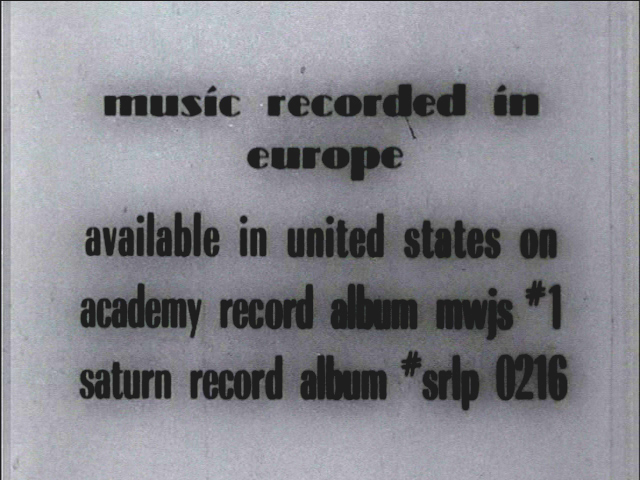
Regrettably, none of the audio for the Arkestra is live. In a
2005 interview,

At 13:16 into the film, "Demon's Lullaby" begins. It is edited down to the ensemble head, a brief trumpet solo by Art Hoyle, a repetition of the ensemble, and part of the tenor solo by John Gilmore, quickly faded; the edited piece ends at 14:16. No musicians are visible; the number accompanies a scene of pool players in a pool hall.
"Urnack" comes in at 19:39. The film shows a 8-man Arkestra on stage, probably at Budland in 1956. The lineup appears to be Jim Herndon (tympani), Robert Barry (drums), possibly Victor Sproles (bass), Art Hoyle (trumpet), John Gilmore (tenor sax), Julian Priester (trombone), Pat Patrick (alto and baritone sax), and Sun Ra (piano). Some footage of a later Arkestra (playing probably at Budland in 1957) with BeBop Sam Thomas on guitar and a different front line that includes Marshall Allen on alto sax is edited into the segment. About a minute into the piece, John Gilmore begins his tenor sax solo, which ends with an edit at 20:42.
"A Call for All Demons" picks up at 23:00 in The Cry of Jazz. Jim Herndon is fully visible for a moment during the intro. On the soundtrack, Ra's piano intro is followed by the ensemble theme. However, the band that gets the most exposure during this segment of the film is an ensemble that probably played Budland in 1957. BeBop Sam Thomas is briefly seen on guitar, as is a string bass player (possibly Victor Sproles). In the film the front line includes a trumpet player, John Gilmore, tenor sax, Marshall Allen, alto sax, and an unidentified baritonist (Charles Davis can be glimpsed in the film, but not in this particular scene). The piece ends with an edit at 24:00.
The March through May 1956 version of the Arkestra has a highly distinctive ensemble sound; its personnel is easily identified by ear. The Impulse release of Angels and Demons at Play incorrectly listed Victor Sproles on bass; he did not join the band till the fall of 1956. Wilburn Green's electric bass is prominent on all of the tracks; his absence from The Cry of Jazz is a dead giveaway that the audio for the scenes of the 1956 Arkestra in the movie was not recorded live. Art Hoyle was in the Arkestra from Christmas 1955 till somewhere near the end of 1956.
The band continued to pick up occasional gigs away from Budland. On May 14, the Defender advertised a one-nighter at Roberts Show Lounge by "Le Sun Ra and his Band"—the ad was typical in its absence of fancy nomenclature. The outing must have drawn enough of a crowd to satisfy Herman Roberts, because on May 29, the daily Defender announced that
Sun-Ra and his band will be featured at Roberts Lounge, 6620 S. Park, every Monday in a Jazz concert. This versatile band plus a host of guest celebrities makes Monday nite at Roberts a must if you are looking for an enjoyable evening.
On that same day, the Arkestra was being featured at the Roosevelt University Jazz Club's final concert of the spring semester. According to Joe Segal's column in the Roosevelt Torch (May 28, 1956, p. 4):
The feature presentation of the evening will be the new experimental and highly controversial eight piece modern group led by "SUN RA," the inventor [sic] of a new electronic piano (which he will use Tuesday). The group is comprised of trumpet, tenor sax, trombone, baritone sax, drums, Fender bass (electric), tympani, and of course, the leader's piano. JOHNNY GILMORE, PAT PATRICK, ROBERT BERRY [sic], and JULIAN PRIESTER, are some of the better known members of the band. Their arrangements have been termed as the most advanced Modern Jazz yet devised.
Our thanks to Chris DeVito for this reference. This was no bush-league series: the preceding event had featured the Modern Jazz Quartet and Dexter Gordon. Alternating sets with the Arkestra were ad hoc groups of local musicians billed as the “Jazz Club All-Stars,” who included Paul Serrano (tp), Ira Sullivan (tp, ts), Johnny Griffin (ts), Eddie Harris (ts), Clifford Jordan (ts), Frank Strozier (as), Billy Wallace (p), Eddie Baker (p), LeRoy Jackson (b), Victor Sproles (b), Billy Gaeto (d), Walter Perkins (d), and Wilbur Campbell (d). Eddie Harris had rehearsed with Ra before; Victor Sproles would become a regular member of the Arkestra.
We previously listed a live recording of a jam session from the Pershing Ballroom, featuring guest stars Gene Ammons and J. J. Johnson, as coming from June 1956. However, the latest information puts the date as August 1958, so see below.
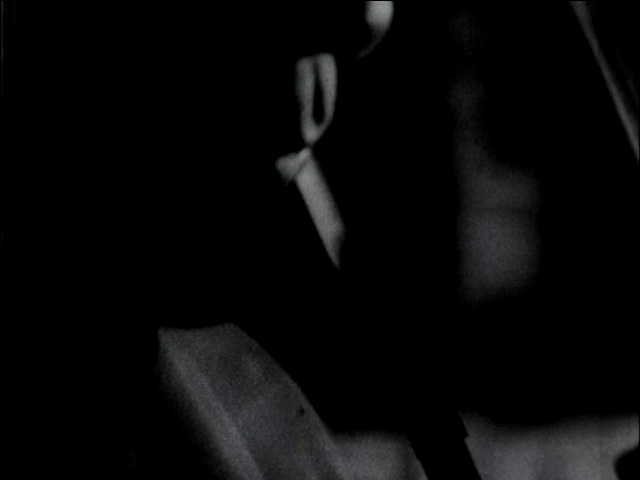
Because Sunny's most recent contract with Birdland/Budland, posted back on February 2, 1956, was of indefinite duration, we are not entirely sure how often the band's run was interrupted after his 6 week absence from mid-March to early May. The club didn't purchase any ads in the Defender for several weeks after Billie Holiday and Al Smith left (the last ad mentioning them appeared on May 5).
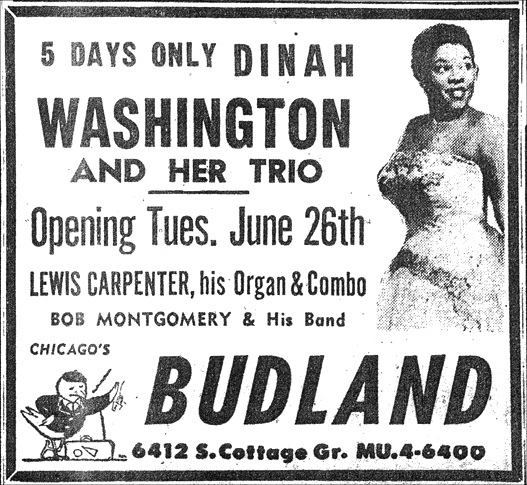
However, Art Hoyle (interviewed in Pathways to Unknown Worlds, p. 87) recalled playing Budland opposite Dinah Washington the night that Clifford Brown died (June 26). Budland did purchase an ad announcing the great singer's opening night at the club, but no mention was made of the Arkestra on the occasion. The "7 Rays of Jazz" would reappear (in fine print) in the Budland ads for July 7 and 14. Most later Budland ads mentioned only the headliners (usually these were visiting singers) and, to what we are sure was Sun Ra and Alton Abraham's great annoyance, failed to identify the house band.
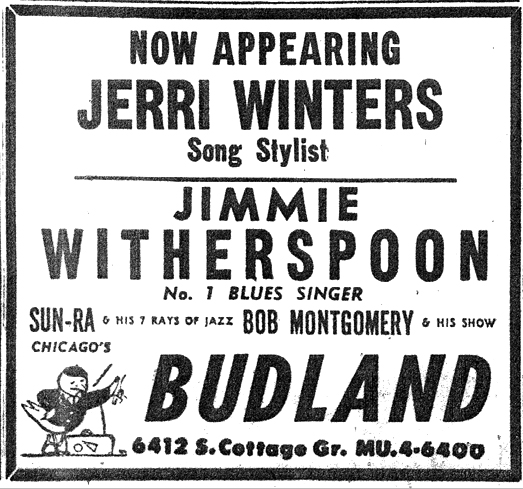
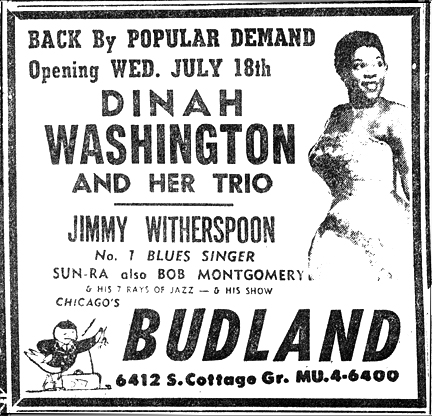
Hoyle also recalled a quintet drawn from the Arkestra (himself, John Gilmore, Ra, Victor Sproles, and William Cochran) working opposite the Compass Players in a venue on the North Side. The Compass Players, featuring Elaine May and, during part of their run, Mike Nichols, were the first improv theater group in the United States; in July 1955 they had begun performing in a space adjoining the Compass Tavern on East 55th. The Players subsequently moved to the Dock on South Lake Park Avenue, then to the Offbeat on North Broadway. According to John Szwed's book, Space Is the Place (pp. 148-149), the Players were appearing at the Argo Off-Beat Room on North Broadway when Sunny's quintet was brought in to replace pianist Bill Mathieu. The quintet alternated 30 to 40-minute sets with the improvisational actors. Szwed places the beginning of the quintet gig in May 1956. Contemporary notices are hard to find; the Chicago Tribune (November 25, 1956, pt. 7 p. 14) later described the appearance of an intermission pianist at the Offbeat as though it was something brand new--but the Tribune hadn't been covering the venue or the Compass Players. The Compass Players broke up in January 1957.
Preserved among Alton Abraham's papers (see Pathways to Unknown Worlds, p. 117), the first issue of a mimeographed newsletter called the Jazz Informer announced a Sun Ra concert on June 24, 1956. The Informer was published by a social club called the Rounders. Art Hoyle recalled that "we played for dancing for a group called the Rounders, whose motto was 'no squares allowed.' They were made up of bread truck drivers, potato chip truck drivers, milkmen, postmen, firefighters, regular guys from the community. They loved jazz" (p. 87). According to Szwed, the Rounders' events took place at Roberts Show Lounge, which advertised its availablity for private parties and club events.

In July, Sun Ra got an opportunity to record an entire LP for the adventurous Transition label (which, a couple of months later, would be responsible for Cecil Taylor's first session as a leader). This began a relationship with producer Tom Wilson that lasted well into the Arkestra's New York period. It may have also led to Sunny becoming acquainted with composer, arranger, and producer Ed Bland, who knew Wilson. For the session, Sunny was given the go-ahead to add Dave Young's second trumpet, James Scales' alto sax, and Richard Evans' string bass to his working octet.
Sun Ra (Hammond B-3 org -2, p); Art Hoyle (tp, bells from India); Dave Young (tp, bells); Julian Priester (tb, cathedral chimes, arr); James Scales (as); John Gilmore (ts, woodblocks); Pat Patrick (bars, bells from India); Richard Evans (b); Wilburn Green (eb, tambourine); Robert Barry (d, bells); Jim Herndon (tymp, timb, bells); Prince Shell (arr -1).
Universal Recording, Chicago, July 12, 1956
| Brainville (Ra) | Transition TRLP J-10, Delmark DL-411, Delmark DS-411, Sonet SLP23, Transition [J] PA 7006, Goody GY 30002, Delmark DD-411 [CD] | ||
| Call for All Demons (Ra) tk. 2 [false start] | Transition test | ||
| Call for All Demons (Ra) tk. 3 | Transition TRLP J-10, Delmark DL-411, Delmark DS-411, Sonet SLP23, Transition [J] PA 7006, Goody GY 30002, Delmark DD-411 [CD] | ||
| Transition (Ra) tk. 1 | Transition TRLP J-10, Delmark DL-411, Delmark DS-411, Sonet SLP23, Transition [J] PA 7006, Goody GY 30002, Delmark DD-411 [CD] | ||
| Possession (Revel) tk. 1 [inc] -1 | Transition test | ||
| Possession (Revel) tk. 2 -1 | Transition TRLP J-10, Delmark DL-411, Delmark DS-411, Sonet SLP23, Transition [J] PA 7006, Goody GY 30002, Delmark DD-411 [CD] | ||
| Street Named Hell (Ra) tk. 1 [false start] | Transition test | ||
| Street Named Hell (Ra) tk. 2 | Transition TRLP J-10, Delmark DL-411, Delmark DS-411, Sonet SLP23, Transition [J] PA 7006, Goody GY 30002, Smithsonian RD108 [CD], Delmark DD-411 [CD] | ||
| Lullaby for Realville (Evans) | Transition TRLP J-10, Delmark DL-411, Delmark DS-411, Sonet SLP23, Transition [J] PA 7006, Goody GY 30002, Delmark DD-411 [CD] | ||
| Future (Ra) [inc, tb solo only] | Transition test | ||
| Future (Ra) | Transition TRLP J-10, Delmark DL-411, Delmark DS-411, Sonet SLP23, Transition [J] PA 7006, Goody GY 30002, Delmark DD-411 [CD] | ||
| Swing a Little Taste (Priester) | Transition TRLP J-30, Transition [J] GXF3126, Delmark DD-411 [CD] | ||
| New Horizons (Ra) | Transition TRLP J-10, Delmark DL-411, Delmark DS-411, Sonet SLP23, Transition [J] PA 7006, Goody GY 30002, Delmark DD-411 [CD] | ||
| fragment [p noodling only] | Transition test | ||
| Fall off the Log (Ra) | Transition TRLP J-10, Delmark DL-411, Delmark DS-411, Sonet SLP23, Transition [J] PA 7006, Goody GY 30002, Delmark DD-411 [CD] | ||
| Sun Song (Ra) -2 | Transition TRLP J-10, Delmark DL-411, Delmark DS-411, Sonet SLP23, Transition [J] PA 7006, Goody GY 30002, Delmark DD-411 [CD] | ||
| Delilah [Majestic 1] (Ra) | Transition test | ||
| Delight (Ra) tk. 1 | — | ||
| Delight (Ra) tk. 2 | — | ||
| unidentified hard bop (Ra) | — |
Transition TRLP J-10, Jazz by Sun Ra Vol. 1, was issued in 1957. Personnel details and session date are from the booklet included with this LP (and reprinted in the Delmark CD issue). Sun Ra's notes quote statements by Art Tatum and Duke Ellington from the January 9, 1957 issue of Downbeat, so a release date early in the year is indicated.
The Transition LP, with original title, was reissued in the early 1970s in Japan as Transition PA 7006. Under the title Sun Song, all tracks from TRLP J-10 appeared on Delmark DL-411 and DS-411 (1967), Sonet SLP23 (Sweden), and Delmark DD-411 [CD, 1991]. David Martinelli and Marco Melaragni point out that there was a bootleg LP, derived from Delmark, titled Sun Song volume 2 and released around 1971 by the notorious BYG subsidiary Goody (GY 30002). On that exceedingly bogus release, the band was anachronistically identified as Sun Ra and his Myth Science Arkestra.
“Swing a Little Taste” initially appeared later in 1957 on an LP sampler (including tracks by Donald Byrd, Jay Migliori and others) titled Jazz in Transition. This was reissued in the late 70s in Japan as Transition GXF3126. “Swing a Little Taste” was also included as a bonus track on Delmark DD-411 (though there it is incorrectly credited to Sun Ra). “Street Named Hell” take 2 was also reissued on Smithsonian RD108, Big Band Renaissance, as part of a 5-CD various-artists collection.
Most of the new compositions on the album were copyrighted in a batch on July 17, 1956. Julian Priester copyrighted "Let's Swing a Little Taste," while Le Sun Ra registered "Fall off the Log," "Brainville Uranus," "Future," and "Transition." The last was a suite consisting of "The Street" (i.e., "Street Named Hell"), "The Action" ("Transition" proper), and "Delight." A detailed transcription of “Sun Song” was copyrighted on August 27 as “Spur of the Moment.”
Three new compositions, plus some false starts, take announcements, and conversations with the band come from a 12” Transition test pressing that was discovered by Pete Gianakopoulos in January 1997. The test pressing seems to have been made from the "spare parts reel" that resulted from the session. Its contents have never been issued in any form. Side A consists of 9 tracks from this session, some fragmentary, interspersed with Ra's announcements (total time is 17 minutes). Side B is outtakes from 2 sessions for the label by other artists. Thanks to Gianakopoulos for information on this unique document, and an opportunity to hear a dub. James Wolf has identified one of the unfamiliar compositions as “Delight.” (After digital noise reduction by Chris Trent, Sun Ra and band members could be heard announcing “Delight” on the test pressing.) The other two new pieces on the test pressing were never copyrighted by Sun Ra. We still do not know the title of the hard-bop number, which is a solo feature for James Scales. The ballad with a prominent tenor lead by John Gilmore has now been identified by Michael Anderson as "Delilah"; it would reappear on the Majestic Hall recording of 1960, with a baritone sax lead by Ronald Wilson. On release in 2002, it was given the placeholder title of“Majestic” 1.
According to Allan Chase, Eutrace U. “Prince” Shell arranged “Possession” for the Arkestra; Ra's only change was to add an alto saxophone part for James Scales to play on this session. Shell did two other arrangements for the Arkestra: one of Tadd Dameron's “Lady Bird” (not recorded, at least not in its original form—Sun Ra would record a version of “Lady Bird” for release in the 1970s), and a composition of his own dedicated to Gene Ammons and called “Memoirs of a Jug.”

The Arkestra recorded often enough in 1956 that we can hear a sharp difference in character between the March through July 1956 edition and the one that recorded in the fall. The difference is notieeable even though the band was holding down a steady gig throughout. Several key personnel changes took place. Robert Barry was replaced by William “Bugs” Cochran on drums. Wilburn Green on electric bass gave way to Victor Sproles on string bass (precise dates are not known, but Sproles, who had been in the house trio at the Beehive, and Bugs Cochran were on board by October). Julian Priester left in September to go on tour with Lionel Hampton; for the Budland gig, Sunny went to a front line of one trumpet and three saxes, and the Arkestra would operate without a regular trombonist for quite some time thereafter. James Scales had stopped working with the Arkestra, but with the arrival of baritone saxophonist Charles Davis, Pat Patrick spent more time playing alto sax, his duties including occasional solos.
After Dinah Washington's June-July appearances at Budland, the house band role was taken over for a while by King Kolax. King K's quintet was in residence from mid-July (contract posted with Local 208 on July 19) through early September (last mentioned in an ad on September 8). After that, the Arkestra seems to have returned to the club, but through the last week of October, Cadillac Bob quit paying for ads in the Defender. Budland could even have been shuttered for a week or two.
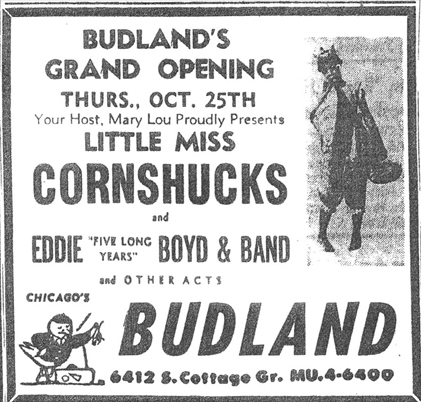
When the ads resumed in late October, the marketing strategy was centered on the headliners, no credit whatsoever going to the house band. Despite apparently holding down that responsibility through the end of 1956, except for a week or two when Duke Groner's combo stepped in, the Arkestra got no publicity at all. The Budland ads from October 27 and November 3, 1956 sum the situation up perfectly. As a marketing strategy, not bothering to name the house band was less than brilliant. The establishments that Cadillac Bob was hoping to compete with in 1956 were the Club DeLisa and Roberts Show Lounge. But the DeLisa never failed to credit Red Saunders in its ads, while Roberts, which rotated its house bands, always mentioned the ensembles of Duke Groner, Porter Kilbert, Paul Bascomb, and Andrew Hill.

In October, Pat Patrick recorded on his own for the tiny Ping label, in a legendary quintet session with Von Freeman, Andrew Hill, Malachi Favors, and Wilbur Campbell; his composition "Down Pat" was copyrighted on October 29.
During the fall and winter of 1956, the Arkestra backed such performers as Little Miss Cornshucks, Al Hibbler, and Ruth Brown, and probably alternated with B. B. King's band. Budland brought in Duke Groner's band for a week in December, to fill a gap between B. B. King and Dinah Washington; it also signed Richard Whatley, a drummer who had been leading bands for the previous decade under the stage name "Don Costello." But judging from Whatley's advertised gigs and contracts filed with Local 208, he could not have been carrying the Thursday through Sunday night load most weeks at Budland. More often than not, this would be the Arkestra's uncredited responsibility.
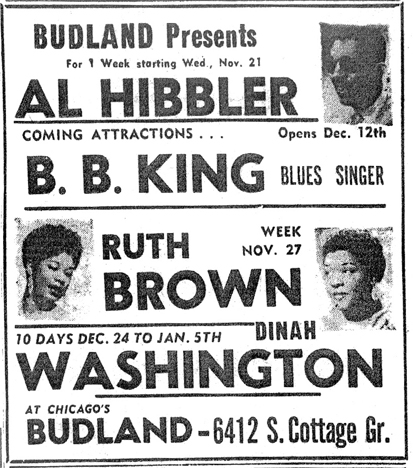
We had thought the next session might have been from Balkan Studio in September or October, but there is no paperwork from Balkan past September 1, 1956, in the Alton Abraham Collection, and that is a letter asking for payment of $25.00 outstanding on the "May balance." Meanwhile, the Abraham papers include a bill from RCA Victor, dated November 21, 1956, for 2 hours of recording time (again, at $28 an hour) and 3 reels of tape (Box 16, Folder 6). So the statement on the LP that it was recorded at RCA Victor Studios is close to true: most of it came from the May 16 and November 21 sessions.
Sun Ra (p, Wurlitzer ep, space gong); Art Hoyle (tp, perc); Pat Patrick (as, perc); John Gilmore (ts, perc); Charles Davis (bars, perc); Victor Sproles (b); William Cochran (d); Jim Herndon (tymp, perc).
RCA Victor Studio, Chicago, November 21, 1956
| tk. 1 | Kingdom of Not (Ra) | Saturn H7OP0216, Saturn SR-LP 0216, Impulse AS-9271, Evidence 22015 [CD] | |
| tk. 1 | Portrait of the Living Sky (Ra) [no horns] | Saturn H7OP0216, Saturn SR-LP 0216, Impulse AS-9271, Evidence 22015 [CD] | |
| tk. 1 | Eve (Ra) | Saturn (unissued) | |
| tk. 2 | Eve (Ra) | Saturn (unissued) | |
| tk. 1 | Blues at Midnight (Ra) [tp, ts, p, b, d, tymp only] | Saturn H7OP0216, Saturn SR-LP 0216, film soundtrack [edited], Impulse AS-9271, Evidence 22015 [CD] | |
| tk. 1 | El [El Is a Sound of Joy] (Ra) | Saturn H7OP0216, Saturn SR-LP 0216, Impulse AS-9271, Evidence 22015 [CD] | |
| tk. 1 | India (Ra) | Saturn H7OP0216, Saturn SR-LP 0216, Impulse AS-9271, Evidence 22015 [CD] | |
| Sunology (Ra) | Saturn H7OP0216, Saturn SR-LP 0216, Impulse AS-9271, Evidence 22015 [CD] | ||
| Sunology part II (Ra) | Saturn H7OP0216, Saturn SR-LP 0216, Impulse AS-9271, Evidence 22015 [CD] | ||
| Dreams I (Ra) | Saturn (unissued) | ||
| Dreams II (Ra) | — | ||
| Dreams III (Ra) | — |
H7OP0216, Super-Sonic Jazz, was the first album to be issued by Saturn. According to John Corbett, drawing on documents originally in the possession of Alton Abraham, the master tape was edited at RCA Studios on February 14, 1957, and the LP was released on March 5 with an initial pressing of 500 copies (see Pathways to Unknown Worlds, pp. 5-6). The LP was the first record to use the now customary spelling "Arkestra." Flashing by so fast that nearly everybody missed it was a notice in Cash Box's Chicago R&B column: "Alton Abraham, Saturn, establishing local distrib for pending Le Sun Ra LP" (March 23, 1957, p. 42). Saturn didn't buy ads in Cash Box, so this was all the attention it would get.
The album's original matrix numbers, according to Alden Kimbrough and Peter Roberts, were H7OP0216 and H7OP0217; these indicate that the album was pressed by RCA Victor, and the H prefix stands for 1957. The first cover for the album was done by Claude Dangerfield, featuring a keyboard, lightning bolts, flames and a conga drum, printed in red on white. Dangerfield, a classmate of Pat Patrick and John Gilmore at DuSable High School, designed several album covers for Saturn in the late 1950s (though much of his work was not used until later), as well as some cover art that never showed up on a Saturn LP but was preserved in Alton Abraham's collection.
By 1959, the album was carrying the serial number SR-LP 0216; this could have been the intended number all along, but it cannot be seen on either the label or the cover of the earliest pressings. The Dangerfield keyboard cover was still in use, but was now printed in yellow on pink-purple.
The 1957 and 1959 editions of the LP carried back liner notes with extensive information about each composition and each musician, with the evident goal of introducing the Arkestra to potential record buyers. Such meticulous crediting would not, alas, become a tradition at Saturn.

The second and more common cover, also by Dangerfield, shows the Void with various solar and musical symbols. This cover was in circulation in 1961—Kimbrough owns two copies with this cover and yellow labels —and remained the cover of choice thereafter. The Void cover was printed in varying colors: blue and green backgrounds have been reported, but yellow print on a black background was the most common. In 1967, the LP was given the catalog number 204, which actually appeared on the orange El Saturn labels in 1968. Around 1970, the album was re-pressed once again on Thoth Intergalactic, still with the catalog number 204 (Stephen Ramirez). In all, Super-Sonic Jazz was re-pressed more often than any other Saturn album, and we may not have described all the label varieties. On all Saturn labels, "El Is a Sound of Joy" is abbreviated to "El."
Editions of the album with the Void cover employ a revised, heavily abridged version of the original liner notes, with shorter comments about each piece and no bios on the musicians. Two poems by Sun Ra are added.
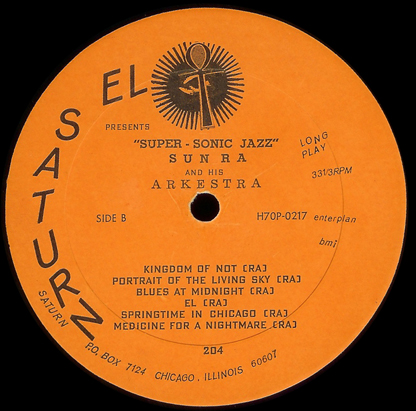
Two years after its release on LP, this performance of "Blues at Midnight" was featured in Ed Bland's film The Cry of Jazz, which was recently reissued on DVD as Atavistic UMS DJ-865. An edited version of the 1956 "Blues at Midnight" accompanies “scenes of Negro life,” alternating with footage of the musicians. It starts at 4:13 into the film and continues all the way to 13:16. In this case, the editing pads more than it cuts: the original recording times in at 6:30 and the film version runs to 9:03. The initial tympani roll is removed and Ra's piano solo is abbreviated. John Gilmore's theme statement and tenor sax solo are heard in their entirety, Art Hoyle's trumpet is cut off almost as soon as it begins, around 7:15, then Gilmore's solo is repeated, and the trumpet solo does not get going till 10:25. At 11:15 a fragment of the tenor sax solo is repeated once again; the trumpet takes over at 11:53 and continues to the abrupt ending of the segment. The soundtrack leaves out Ra's final piano solo and the fade that can be heard on Super-Sonic Jazz.
The tympani were probably excised from the film soundtrack because when the musicans are on screen tympani are on view with no one behind them. "Blues at Midnight" is made to appear to be the work of a later quintet consisting of Sun Ra (upright piano), Hobart Dotson (trumpet), John Gilmore (tenor sax), Ronnie Boykins (bass), and William "Bugs" Cochran (drums). Ronnie Boykins and John Gilmore are on camera far more than the others (hence the repetitions of Gilmore's recorded solo, which also lend support to the movie's message about the confining force of reiterated chord changes), but the faces of every performer except Sun Ra can be seen at one time or another. The quintet appears to have been filmed in the summer of 1958. Ed Bland (when interviewed by Ralph Pleshar) stated that Hobart Dotson appeared in the movie.

All tracks from the Saturn album were reissued in 1974 on Impulse AS-9271, under the title Super Sonic Sounds. All tracks were reissued on Evidence 22015 [CD] in 1992 under the original title. “Kingdom of Not” was also included in a 1997 Evidence-derived Sun Ra CD sampler, Sun Ra Came Down to the Earth, on Japanese Paddle Wheel Records, KICJ 315, and on Evidence 22219, Greatest Hits: Easy Listening for Intergalactic Travel, in September 2000.
The location comes from the Saturn liner notes, and the personnel is based on the Saturn credits. The dates for these sessions can be pretty closely bracketed, because Patrick is playing alto sax, Sproles is on bass, and no trombonist is present. Julian Priester (who did not recall playing with Sproles) departed from the Arkestra in September 1956. Art Hoyle, in turn, left in December 1956 or soon thereafter to join Lionel Hampton's band (the latest date gave was March 1957, but this is clearly too late—the liners to the first pressing of Super-Sonic Jazz already credit him with service in Hamp's band).
A tape box from this session also included versions of “Eve” (“Portrait of the Living Sky” was a rather elaborate piano prelude to take 1 of “Eve” that ended up being released by itself; meanwhile the ensemble work on either take of "Eve" was probably not to Sunny's liking), and three takes of a number titled “Dreams.” (timing in at 2:55, 3:00, and 3:00). This last could be “Dreams Come True”—we don't know. The tracks are listed here as per the tape box, not as they appeared on the LP. The tape box also listed “Super Blonde,” and “Velvet”, which are presumably the versions from March 1956 (ultimately included in the LP) and May 1956 (not included).
Several of the Ra tunes from this session were copyrighted on December 17, 1956 (see below). The original title of “Kingdom of Not” was “Big Charles” (which also appears on a tape box from the session) and “El Is a Sound of Joy” was called “El (House of Joy).” The impromptu “Blues at Midnight” and the now independent “Portrait of the Living Sky” had to wait till April 8, 1957, when they were registered as Parts I and II of "Prevues of Tomorrow (A Suite of Translated Thought)."
A listing of two tape reels preserved in the Alton Abraham Collection (Box 4, Folder 5) shows "India" (tk. 1), "Sun Olligie [sic] (tk. 1 and tk. 2), "Dreams" (tk. 1, 2, and 3) on Reel 1, GO7P-0357. Reel 2, GO7P-0358, shows "Big Charles" (tk. 1), "Eve" (tk. 1—"Ist 1:30 ONLY"), "Blues at Night" [sic] (tk. 1), "Eve" (tk. 2—crossed out), "Sound of Joy" (crossed out), "As You Once Were" (crossed out), "Sound of Joy" (tk. 1). These have RCA Victor numbers and appear to have been edited into possible LP sides.
The version of “El Is a Sound of Joy” from this session sounds embryonic compared to the version later released on Sound of Joy—note how the second and third strains are repeated twice and the second strain appears again before the piano solo, and how the final chorus seems tacked on. However, the rhythm section on the first version (with just Cochran's drums under the second strain, no tympani or hand clapping) makes a reference to Chicago's elevated trains much more plausible.
The Arkestra's involvement with the short-lived Transition label would have a major impact on Sunny. In July Transition had sprung for a session at Universal, the best studio in town. Jazz by Sun Ra Vol. 1 was released in December 1956, no doubt to great expectations; the Alton Abraham Collection includes a slew of copies (e.g., in Box 4, Folder 2) of the ad that Transition placed in Down Beat for December 26 ("Far Out as West Coast Jazz! Basic as Basie!"). But Transition folded before it could release its second Sun Ra album, previously thought to have been made in November, but more likely in December. It would be almost a decade before anything from this second Transition album saw the light. Julian Priester, concerned about "the rise and fall of the fork," had gone on the road with Lionel Hampton; Charles Davis had come in on baritone sax, and William "Bugs" Cochran had taken over on drums. The Arkestra had grown less militant and more relaxed; compositions like The Kingdom of Not showed the influence of Gospel music as well as an obvious strain of exotica. So did El Is a Sound of Joy.
The second Transition session was well recorded and all of the counterrhythms register. "El Is a Sound of Joy" may have been intended to invoke Chicago's elevated trains (though the Saturn version does a better job of that than the Transition). But we think the title also came out of one of the poems Sunny was writing at the time: "El is Ra/ Ra is El/ Is Ra El?" The album as a whole, which escaped release till Delmark picked it up in 1968, is one of Sunny's best.
The Arkestra's recording sessions in the second half of 1956 were focused almost exclusively on Sun Ra's compositions. At Budland, on the other hand, the band provided backing for such artists as Little Miss Cornshucks (already familiar to Sunny from his turn in the Fletcher Henderson band back in 1946) and Ruth Brown.
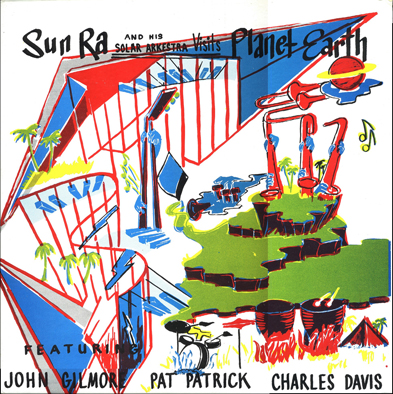
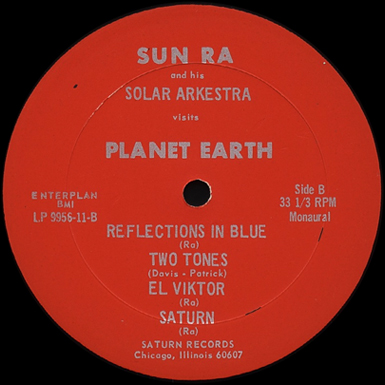
Sun Ra (p, Wurlitzer ep, announcement); Art Hoyle (tp, perc); Dave Young (tp except -2); John Avant (tb -1); Pat Patrick (as, bars, perc); John Gilmore (ts, bells, perc); Charles Davis (bars, perc); Victor Sproles (b); William Cochran (d); Jim Herndon (tymp, timb, boom bam except -2); Clyde Williams (voc -2).
Universal Recording, Chicago, c. December 1, 1956
| El Is a Sound of Joy (Ra) -1 | Delmark DS-414, Monkey MY 40014, BYG 529.162, Delmark DD-414 [CD] | ||
| Overtones of China (Ra) -1 | Delmark DS-414, Monkey MY 40014, BYG 529.162, Delmark DD-414 [CD] | ||
| tk. 1 | Eve (Ra) [inc] | Transparency 0316 [CD, disk 13] | |
| tk. 2 | Eve (Ra) -1 | Saturn 9956-11-A/B, Evidence 22039 [CD], Transparency 0316 [CD, disk 13] | |
| Two Tones (Patrick-Davis) | Saturn 9956-11-A/B, Delmark DS-414, Monkey MY 40014, BYG 529.162, Evidence 22039 [CD], Delmark DD-414 [CD] | ||
| Paradise (Ra) [p, ep, b, d, perc only] | Delmark DS-414, Monkey MY 40014, BYG 529.162, Delmark DD-414 [CD] | ||
| Planet Earth (Ra) | Delmark DS-414, Monkey MY 40014, BYG 529.162, Delmark DD-414 [CD] | ||
| Ankh (Ra) | Delmark DS-414, Monkey MY 40014, BYG 529.162, Delmark DD-414 [CD] | ||
| Saturn (Ra) | Saturn 9956-11-A/B, Delmark DS-414, Monkey MY 40014, BYG 529.162, Evidence 22039 [CD], Delmark DD-414 [CD] | ||
| Reflections in Blue (Ra) | Saturn 9956-11-A/B, Delmark DS-414, Monkey MY 40014, BYG 529.162, Evidence 22039 [CD], Delmark DD-414 [CD] | ||
| tk. 1 | El Viktor (Ra) | Transparency 0316 [CD, Disk 13] | |
| tk. 2 | El Viktor (Ra) [fs] | Transparency 0316 [CD, Disk 13] | |
| tk. 3 | El Viktor (Ra) [fs] | Transparency 0316 [CD, Disk 13] | |
| tk. 4 | El Viktor (Ra) [fs] | Transparency 0316 [CD, Disk 13] | |
| tk. 5 | El Viktor (Ra) | Saturn 9956-11-A/B, Delmark DS-414, Monkey MY 40014, BYG 529.162, Evidence 22039 [CD], Delmark DD-414 [CD], Transparency 0316 [CD, Disk 13] | |
| As You Once Were (Ra-Williams) -2 | Delmark DD-414 [CD] | ||
| Dreams Come True (Ra-Mayo) -2 | Saturn 485, Saturn XI, Evidence 22014 [CD] | ||
| Dreams Come True (Ra-Mayo) -2 [alt.] | Delmark DD-414 [CD] |
This session was recorded for Transition (before Sunny's first album for the label was released) and was intended for Jazz by Sun Ra Volume 2. The LP featured Sunny's working band with the addition of Dave Young on second trumpet and Johnny Avant on trombone (the latter on two tracks only). But the company folded before these plans could be carried out. Items from this session appeared on three different LPs, two on Saturn and one on Delmark, from which various reissues have sprung in turn.
First, five tracks (not four, as we previously thought) appeared in 1966 on Saturn 9956-11-A/B, Sun Ra Visits Planet Earth. "Two Tones," "Reflections in Blue," "Saturn," and "El Viktor" were all placed on the B side of the Saturn LP. However, "Eve," which appeared on the A side, turns out to also be from this session (and not released elsewhere!). The cover art, by Claude Dangerfield, was a variant of the work he had prepared for A Tonal View of Times Tomorrow, an LP that never got past the early planning stages. In 1967 Visits Planet Earth was given the catalog number 207. All tracks from this album were reissued in 1992 on Evidence 22039 [CD].
Second, all but three tracks from the session were released in 1968 on Delmark DS-414, Sound of Joy (in electronic stereo). According to Bob Koester, as interviewed by Allan Chase, the two cuts featuring vocalist Clyde Williams were in Delmark's possession but were held from release in 1968 because they seemed stylistically incongruous with the rest of the session. (Clyde Williams sang with Sun Ra from late 1956 through the middle of 1958.) The Delmark album was pirated as the first LP of the 2-LP set Monkey MY 40014 (Monkey being a French label with seriously dubious credentials). In addition, there was a single-LP French bootleg in the BYG Jazz Masters Série, BYG 529.162 (issued c. 1970—thanks to Marco Melaragni for pointing this one out).
Third, “Dreams Come True” with Clyde Williams' vocal saw the light in 1973 on Side A of Saturn LP 485, Deep Purple (some copies titled Dreams Come True). All tracks from Side A of this LP were reissued on Evidence 22014 [CD, 1992]. “Dreams Come True” was also reissued in 1983 on the Saturn anthology LP, Just Friends (Saturn XI). Hoyle was listed as “Arthur Horn” on the jacket of Saturn 485, and Robert Barry was incorrectly given there as the drummer.
All but one of the tunes from the session (including “As You Once Were” but not “Eve”) were finally united, in mono, on one disk in 1994 as Delmark DD-414 (a CD again titled Sound of Joy). The composer of “As You Once Were” is not listed by Delmark, but Ron Horton's research at the Library of Congress shows that Ra copyrighted it, and James Wolf has found that Clyde Williams was credited with the words. The Delmark CD incorrectly states that “Dreams Come True” was previously unissued. That appears to be true only of the take that Delmark used. In fact, Delmark used a different take of the piece from the one that appeared on Saturn 485. There is even some possibility that Saturn used a version from the November session (we have not heard any of the tracks from that session called “Dreams” so we cannot comment further).
Finally, in 2011 complete sets of takes for two items from this session were released for this first time on Transparency 0316, The Eternal Myth Revealed Vol. 1. On Disk 13 of the set, Michael Anderson included all five takes of "El Viktor" (take 1 is complete; takes 2 through 4 are false starts; the master was take 5) and both takes of "Eve" (take 1 runs about 30 seconds; the master was take 2). Anderson notes that on previous releases part of Ra's piano introduction was previously cut from take 2, but the difference is small (just 8 seconds at the beginning of the piece). As we did in previous versions of our discography, Anderson attributes "Eve" to a rehearsal in 1957 or 1958 (we used to list it as Sun37, alongside the later recordings of "Overtones of China" and "Planet Earth") but the solo credit to Pat Patrick on alto sax should have given away its true origin. In fact, "Eve" is scored for three saxes and trombone, much like "El Is a Sound of Joy" from the same session, and the percussion work is typical of that session (not as heavy as it would become on the 1957-1958 rehearsals). There is no sign of participants in the 1957-1958 Arkestra such as Lucious Randolph, Marshall Allen, or James Spaulding.
The personnel are as listed on the Delmark LP jacket. "Eve" was not released on Delmark, but the Saturn back liner credited Pat Patrick with "alto saxophone solo" on it; in fact, he was the only alto saxophonist on the track. The date and location for this session have been troublesome. First the date. Delmark gave (and, on the CD, still gives) November 1957 as the recording date, which is impossible. Given the makeup of the band, September to December 1956 is pretty much guaranteed. Art Hoyle was gone by the end of 1956 or shortly thereafter. By November 1957 James Spaulding and very likely Marshall Allen would have been playing alto sax in the Arkestra while Charles Davis would not have been available. November 1, 1957, the date that has been given in many discographies, needs revising to November 1, 1956. But now that we have a firm date for the Saturn session at RCA Victor (November 21), we find December 1, 1956 more likely.
Delmark gives John Avant as the trombonist. Priester says that Johnny Avant was a leading studio musician in Chicago and could well have been available for only the three tracks on which a trombone can be heard. None of these feature trombone solos; the most exposed trombone part is four-note descending motif during "Eve." And "El Is a Sound of Joy" and "Eve" are both scored for alto, tenor, and baritone saxes plus trombone, but not trumpet. (Avant also worked briefly with Arkestrans Gilmore and Ronald Wilson in a big band led by alto saxophonist Willie Randall; earlier, he had been a regular in the Dukes of Swing when Sunny was their music director and in the Red Saunders band while Sunny was arranging for Saunders.)
James Wolf at the Library of Congress has found that Sun Ra registered a slew of tunes in December 1956. On December 5, he and Clyde Williams copyrighted “As You Once Were.” Pat Patrick and Charles Davis copyrighted "Two Tones" on December 7. On December 17, “Sunology (A Suite of Philosophical Sounds)” followed. The eight-part suite consisted of “Planet Earth,” “Overtones of China,” “India,” “Eve,” “Big Charles” [retitled “Kingdom of Not” before release], “El (House of Joy),” “El Victor,” and “Summation: Sunology.” Each tune had been recorded at the November session for Saturn, the December session for Transition—or at both.
Now the location. Delmark says the session took place at Universal Recording, but Hoyle recalled recording for Transition in a “kind of nondescript” studio on the West Side of Chicago. Alton Abraham recalled recording at a studio with a name like “Balladine” as well as RCA Studios. We used to think this pointed to Balkan Studio, which Saturn used earlier in the year, but there are no new bills from Balkan in the Alton Abraham collection past June 6, 1956. A more remote possibility was Boulevard Studios, used in 1956 and 1957 by other local labels like Abco, Cobra, Salem,and United, but Boulevard was in the Loop, not on the West Side, and we have found no paperwork from Boulevard in the Alton Abraham Collection. Any session paperwork would, in this case, have gone to Transition, not to Ra and Abraham, and we don't know whether any is still extant. We'll go with Universal, if only because the sound quality is so high and it would have been easy for Hoyle and Abraham to mix this session up with the November 21 outing.
John Szwed uncovered test pressings of Sound of Joy and Visits Planet Earth. Both were made at a Columbia pressing plant, but it is not known whether the plant was in Chicago or New York.
On one of these sessions, probably (to judge from the date of the complaint) the outing for Transition, got Sunny into hot water with Local 208, which diligently checked recording dates for musicians who were not in good standing with the Union:
Member Herman Blount (Sun Ra) appeared before the Board, as notified, to explain why he used Arthur Doyle [sic] on a recording session. It was explained to Blount that this musician had filed a transfer with this Local from Local 203 [Hammond, Indiana] but had failed to pay transfer dues for the third and fourth quarter, 1956, and that he had not paid his fourth quarter dues in Local 203. For the reasons above stated, Hoyle had no status as a member of the Federation and did not have the right to play with or for members of the Federation in good standing.
Member Blount stated that he did not know all of this and felt that in as much as he [Hoyle] was a member of Local 203, he had the right to play the miscellaneous engagement.
The matter was discussed at length with Blount and he advised the Board that he felt as though he was being persecuted.
On motion, the Board ruled that Herman "Sun Ra" Blount shall be fined $25.00 for engaging the services of Arthur Hoyle, same to be paid within ten days, or he shall stand erased. (Minutes of the Board of Directors Meetings, American Federation of Musicians Local 20, December 20, 1956, p. 2)
Sunny must have paid his fine promptly, because he would remain in good standing with Local 208 for the rest of his stay in Chicago.
After the Hoyle episode, we are sure Sunny firmly resolved not to keep Local 208 apprised of the Arkestra's appearances in a local independent film, which had started production a few months earlier.
Over two years in the making, The Cry of Jazz was a 34-minute film produced and directed by Edward O. Bland and announced, in a Chicago Defender article, for release in October 1958. The schedule slipped and the movie's premiere finally took place in April 1959. The film then became a sought-after curiosity, rarely screened. Years later, it was reissued on DVD as Atavistic UMS DJ-865. The credits in the film as released declare that the music was "recorded in Europe"... to throw Locals 10 and 208 off the scent (see below for the reasons Local 10 would have had for tracing the origins of the music).
If Bland ever intended to record the Arkestra live, he quickly abandoned that plan. The Arkestral footage in the film consists of portions of different live peformances fitted to a pre-recorded soundtrack. What's more, Arkestra members are asked to fill a couple of unexpected roles—as a Dixieland ensemble, and as a Cool jazz quartet without a piano. The audio for the Dixieland and Cool sequences was also taken off records. Sunny plays solo to illustrate the harmonic confines that Bland thought were bad for jazz; here the music consists of repetitions of two excerpts taken off a record.
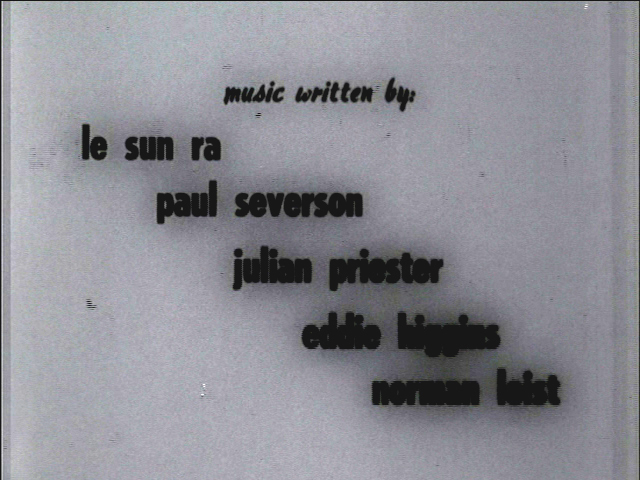
Except for the Cool and Dixieland pieces, the tune used during the opening and closing credits, and the piano fragment that Sunny appears to be playing over and over in one scene, the music heard in the film comes out of the Arkestral book.
The credits at the end of film list Le Sun Ra and Julian Priester as composers (the latter being responsible for "Urnack"). So far so good.
By contrast, we had thought that Paul Severson must be a fictional personage. In the film, he is a jazz bandleader, mentioned once but never seen. Alex, the character who serves as Ed Bland's spokesman, supposedly works as an arranger for Severson (Alex's photo, but not Severson's, appears on an obviously fake poster in one of the Budland scenes). But while the film heavily fictionalizes him, Paul Severson was a real musician. Severson was born in Fargo, North Dakota, in 1929, and graduated from Central High School in 1946. He received a Masters degree in Music from Northwestern and settled in Chicago in the early 1950s. Severson played trumpet, trombone (the instrument he featured on his own records), and keyboards, and did a lot of composing and arranging.
Paul Severson first appeared on record when Academy, a very small independent, released a single by the Jimmy Reid band (Academy 54113 was recorded toward the end of 1954, and reviewed in Cash Box on January 22, 1955, p. 30). We believe Reid was a trumpet player. Reid's band, which consisted of trumpet, trombone, three saxes, piano, bass, and drums, played in the Swing and jump styles. Severson composed and arranged both sides of the record, and we suspect the trombone solo on "Wildcat Stomp" is his.
According to Gary Heller (email communication, November 28, 2021) the principals at Academy were orignally Frank McGovern, Lou Fary, and Carol Mills. The company probably started in 1954; a small item in Billboard (November 27, 1954, p. 18) noted that Fary had left. McGovern was also in the advertising business. Some material recorded for Academy may have been used in radio or TV commercials. Copies remain of a one-sided Academy 78 (pressed in plastic coating on cardboard) featuring Lennie LaCour (one of the company's rock and roll performers) that in 1957 or 1958 could be had when one bought a pack of Orange Crush, a soft drink.
Around the time that The Cry of Jazz was being made, Paul Severson was working for several leaders; for instance, in the trombone section of Ralph Marterie's society band. He also did radio work for CBS. We don't know how often his own groups were performing. Worthy of further notice, as Gary Heller reminds us, is that Severson published sheet music for more than 50 Dixieland titles with Hal Leonard Inc. What we don't presently know is whether Severson recorded any Dixieland. During his stay in Chicago, he also made a stereo tape for a reel-to-reel operation called Omegatape. The tape included a new version of at least one composition ("Who Me") that he had recorded on an LP (see below). So far we don't have a track listing on the tape or details on the musicians who participated.
Like a number of other white jazz musicians in Chicago (Bill Walker and Dick Marx are two that come to mind), Severson would later write music for TV commercials (including jingles for Doublemint gum and Marlboro cigarettes; he won 15 Clio awards). He also composed a theme for Mutual of Omaha's long-running Wild Kingdom series. From 1973 to 1979, he lived in Grand Junction, Colorado, then moved back to his hometown of Fargo, North Dakota. While in Grand Junction, he played locally in jazz combos and taught at Mesa State Univesity for two years, composing the music for an original stage musical. While in Fargo, he started several jazz groups, taught across the river at Moorhead State University (now known as Minnesota State University at Moorhead), where he headed the Music Industry program, and served as music director for the Friendship production studio and the Trollwood Performing Arts School. He was also a lay minister in the Unitarian Universalist church and later became active in the Church of Religious Science. Returning to the Grand Junction area in 2006, after he was diagnosed with prostate cancer, Paul Severson died in Cedaredge, Colorado on May 20, 2007, one week after completing an ambitious symphonic jazz score. He was 78 years old, and was survived by his wife Karen, two children, and four grandchildren (Sharon Sullivan, "Friends Remember Doublemint Gum Jingle Writer Who Died in Cedaredge," Glenwood Springs Post-Independent, May 29, 2007, http://www.postindependent.com/news/friends-remember-doublemint-gum-jingle-writer-who-died-in-cedaredge/; Mila Koumpilova, "Fargo Creator of Marlboro, Doublemint Jingles, Dies at 78," inforum.com, May 22, 2007, http://www.inforum.com/content/fargo-creator-marlboro-doublemint-jingles-dies-78). It had been so long, and Severson had done so many other things, that neither obituary mentioned the jazz records (and the jazz tape) that he had made in Chicago.
Eddie Higgins was a white jazz pianist then rising to prominence on the Chicago scene. He was born Edward Haydn Higgins in Cambridge, Massachusetts, on February 21, 1932. Like Severson, Higgins studied at the Northwestern University School of Music. From a discography to which Higgins personally contributed, we learn that he began recording as a leader in 1957, when his trio cut its own LP for the Replica label, run by audio enthusiast Bill Huck in Des Plaines, Illinois, and came to the attention of a wider public starting in 1959, when he appeared on Lee Morgan and Wayne Shorter albums for Vee-Jay and recorded an album of his own. Higgins was based in Chicago until 1970, working such venues as the Brass Rail, the Preview Lounge, the Blue Note, and the Cloister Inn, enjoying a long run at the London House (in a trio with Richard Evans on bass and Marshall Thompson at the drums), doing some producing for Chess Records, and recording there for several other labels, including Atlantic.
Because The Cry of Jazz includes a Dixieland number—the only one we have not yet traced—we should add to Paul Severson's Dixieland activity the fact that Eddie Higgins worked for a time in the house band at Jazz Ltd.. After Sun Ra had left Chicago, in 1962-1963, Higgins would tour with Jack Teagarden, and in 1964 he recorded a Dixieland album in Chicago under the leadership of Jan Scobey. In 1970, Eddie Higgins moved to Fort Lauderdale, Florida, working the jazz festival circuit. He became so popular in Japan and South Korea that in later years he played most of his concert dates in the Far East, and recorded a slew of CDs for the Japanese Venus label. Higgins was an active performer into 2008. He died in Fort Lauderdale, Florida, on August 31, 2009.
In The Cry of Jazz, a long-unidentified composition appears during the opening and final credits (in excerpts of approximately 1 minute each) and between 15:26 and 16:17 in the middle of the film, where it accompanies a sequence of two young black children in a squalid, roach-infested apartment
Eddie Higgins' very first recording session, pre-dating the first under his own name, took place in late 1956 or early 1957—under the leadership of Paul Severson, who played trombone on the date. On the ensuing LP, Replica 1003, Jazz by Paul Severson, which was released in 1957, there were two compositions credited to Severson alone, one credited to Higgins alone, and one credited to Paul Severson and Norman Leist. (Norman Leist was a colleague of Severson's about whom little is known.)
The piece used during the credits was composed by Severson and Leist and was titled "My Rhapsody." It stands out on Replica 1003 because the Latin percussion, the ostinato bass, and the instrumental lineup make it the sole bit of Exotica (in fact, the only track that sounds, even a little, as though it could be by Sun Ra) on an album that largely consists of well crafted mainstream jazz with a tight ensemble, sort of a Chicago counterpart to Herb Pomeroy's group in Boston. The front line on "My Rhapsody" consists of Kenny Soderblom and Hobart Grimes (flutes), Warren Kime (playing his trumpet without the mouthpiece most of the time), and Paul Severson (trombone); the rhythm section consists of Eddie Higgins (piano), Mel Schmidt (bass), and Bob Tilles (congas and bongos).
At 27:07 in The Cry of Jazz, a brief motif from a piano solo is repeated over and over to symbolize "the restraining elements of jazz." (What we see is Sunny playing an upright piano while other instruments lie flat on the darkened stage: alto sax, flute, tenor sax, string bass, and drums.) \A faster variant of the motif comes in around 28:00 (Sunny's face is clearly visible at 28:10, for the only time during the entire movie), again played over and over as the narrator intones about the way repeating chord changes put the jazz performer on a "circular seesaw." There is a little drum accompaniment to the second motif, though the drum set is unoccupied during this segment of the film. The repeated motifs end at 28:44.
The motif was taken from an Eddie Higgins piano solo. Specifically, from his own composition "Lela," on the Jazz by Paul Severson album, Replica 1003. The piece showcases Higgins' fleet soloing in the Bud Powell manner. The bit of drum work heard on the soundtrack is by Bob Tilles.
The two rather sedately paced Cool jazz excerpts included in The Cry of Jazz are not from the Replica album, where the rhythms are peppier and Eddie Higgins' piano is prominent. The Replica was Severson's second and last album as a leader. His first had been recorded in April 1956 for Academy, the same company that released the Reid single. The other musicians were Kenny Soderblom on tenor and baritone saxes, Mel Schmidt on bass, and Bob Tilles on drums. Academy MWJ-1, Paul Severson Quartet, is mentioned in the credits to the film. MWJ stands for Midwest Jazz Series; still to be determined was whether there were any other LPs in that series. Since (as Gary Heller has reminded us) Frank McGovern was credited as a script consultant, he made sure his company's LP was mentioned.
The two Cool pieces were "Too Much" and "Who, Me?" Both were composed by Paul Severson; both feature Soderblom on a highly Lestorian tenor sax. "Too Much" was placed as the first track on Side A of the Academy album; "Who, Me?" was the second track on Side B. "Too Much" is heard during the scenes of commuter trains and poodle grooming; "Who, Me?" is the piece that four members of the Arkestra (John Gilmore, Ronnie Boykins, a trombonist, and a drummer) appear to be playing.
Ed Bland was apparently able to cut a deal for the use of album tracks not just with Academy, but also with Replica. Bill Huck's label was a lot bigger in its day than Sun Ra's Saturn operation, but not nearly so durable (it was in business from 1955 to 1958). Yet Severson's Replica LP is not mentioned in the credits to the film. Could this be because Replica had gone out of business by the time the film was released? One of its last releases was a single, Replica 100, by Warren Kime & His Five Trumpets (reviewed in Cash Box on March 15, 1958, p. 10). "Holiday for Trumpets" was a Severson composition.
For that matter, Academy did not last much longer; its final new recording was done in 1958.
We used to wonder what Paul Severson thought about the finished film. An email from Gary Heller (November 28, 2021) informs us that he took Severson's History of Jazz course in 1987 at Moorhead State University. Severson screened The Cry of Jazz on film and expressed pride in having participated in it.
From the soundtrack music, only the Dixieland excerpt still needs accounting for.
Though not really about the Arkestra, then, The Cry of Jazz contains the only known film footage of the band from the Chicago period—scenes filmed at 5 or 6 club gigs between 1956 and 1958 (according to Bland, when interviewed by Ralph Pleshar). We have identified the musicians on each club appearance where they can be seen. Julian Priester did not recall being filmed, but can be seen momentarily while his composition "Urnack" is heard on the soundtrack. Bland said that BeBop Sam Thomas was present on electric guitar, and frame-by-frame analysis of the film turns him up fleetingly in 2 places.
Not wanting to depend on others to put out his music, Sun Ra had wisely started his own record company. "I didn't want to go through all that starving in the attic and all that foolishness," he said in 1987. "I wanted to bypass that particular trauma they put on artists."
Saturn records were as close to home-made as anything that requires a mechanical process can be. They were typically pressed in batches of seventy-five—sometimes less. The mastering and pressing were less than the best (even vinylmaniacs admit that Saturns sound much better as reissued on CD). The silk-screening or printing on the front covers was done by Alton Abraham and others involved with the company; many of the original print blocks survived among Alton Abraham's effects and were exhibited at the Hyde Part Art Center in Chicago during 2006-2007. Sunny brought the records to gigs in a cardboard box, where band members sold them for cash only. Record store sales (and reviews in the jazz press) were few and far between.
During the period that concerns us, Saturn was a singles label. The first three Arkestral releases were on 45s (though some reappeared on LP much later). There were just two LPs: Supersonic Jazz, which came out in 1957, after it was clear that there would be no more Transitions, and Jazz in Silhouette, from 1959. An item in the Chicago Defender, from June 1959, announced that Saturn had released 6 singles by then. The bulk of the Arkestra's Chicago recordings would go unreleased until 1965, and some waited a good deal longer.
Two different doo-wop guides (the Goldmine guide and the Group Collector's Guide) list a single on Saturn 1002 by The Montereys, with a recording date of 1956. The titles were “My Girl” and “With You.” Bob McGrath's encyclopedia, The R&B Indies, adds releases by the group on Saturn 1001 and 1003. Alton Abraham was positive that no such group ever recorded for his and Sunny's Saturn label. The “other” Saturn had a different logo (which can be seen in McGrath's volume) and, according to some sources, operated out of Pittsburgh.
As 1957 began, the Arkestra was still at Budland, sometimes restricted to the Monday morning "breakfast dance." Cadillac Bob must have regretted the expense after Dinah Washington did a return engagement over the holidays. In the future, it was Herman Roberts of Roberts Show Lounge who would lay out the fees she demanded. No longer would Budland regularly book big-name singers from out of town. During the first six weeks of the year, gigs at the club were not being advertised and the place was nearly empty. But organ trios were suddenly popular in the black community and Cadillac Bob decided to put one together in mid-Febuary. By early March, Tom Archia was fronting the trio on tenor sax and customers were returning. For the next six months, the club was able to sustain itself, but its resurgent advertisements kept passing over Sunny's contribution.
Studio time cost money, too. For the next couple of years, Ra and Abraham usually made do with tapes cut at rehearsals or in the clubs. The 1957 Arkestra isn't well documented on records—just a handful of instrumental tracks were ever released, all of them from rehearsals. By the beginning of 1958 there had been major alerations to the lineup. An adventuresome alto saxophonist from Indianapolis named James Spaulding (1938- ) came into the fold in July or August of 1957. Spaulding sounded the same then as he would years later — about halfway between Cannonball Adderley and Ornette Coleman. Alto saxophonist Marshall Allen (born May 25, 1924 in Louisville, Kentucky) had wandered into Chicago in 1952, after a sojourn in Europe. Playing in his spare time while he maintained a day job at the Rivier Camera Company, he sought out Sun Ra after hearing the Transition album. He and Spaulding added their flutes to the Arkestral armamentarium. And then there was bassist extraordinaire Ronnie Boykins (born in 1932), another graduate of DuSable High School who had been playing in R&B bands.
A benefit sponsored by Artis Abraham (Alton's brother, and a possible third participant in Saturn Records) for a candidate for Mayor of Bronzeville took place on February 15 at the Grand Ball Room, 6351 South Cottage Grove. (See Pathways to Unknown Worlds, p. 82). Music was by "SUN RA (Sun God of Jazz)." The candidate was probably a member of the Abraham clan. Artis Abraham would run for Mayor of Bronzeville in 1959, and Zenophon Abraham ran for the honorary but high-profile office in 1961.
According to Leroy Cooper (who briefly played baritone sax with Sun Ra in 1957), Ra was doing arrangements at the time for singer Lorez Alexandria (see As Serious as Your Life by Val Wilmer). Though Ronald Wilson, who would become a member of the Arkestra for a time, played on her first LP for King Records, we have no evidence of Ra arrangements on Alexandria's recordings from this period. Alexandria recorded for the King label in Chicago on two separate occasions in 1957, but King Fleming was responsible for all of the arrangements on these sessions. Her 1959 recordings for King were also made in Chicago, but these variously featured an unidentified small jazz combo, an unidentified big band, and a big band with a string section arranged by Riley Hampton.
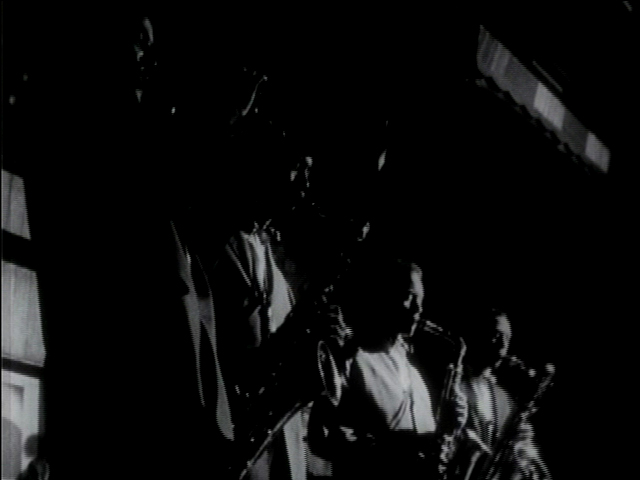
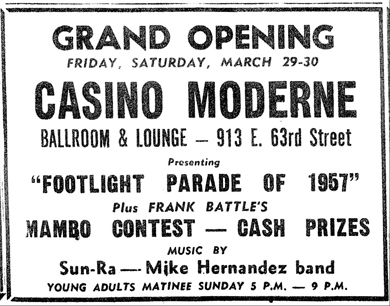
On March 28 and 30, 1957, the Defender announced the grand opening of a new ballroom called the Casino Moderne at 913 East 63rd Street. The festivities, spread over Friday and Saturday nights, featured Sunny and the Arkestra along with Mike Hernandez and his Latin Band. On April 2, the Defender included Sun Ra, for the first time in months, in a roundup of talent appearing in Loop and Southside clubs. Again, he now rated a mention in connection with the Casino Moderne.
The Casino Moderne settled down into a pattern of featuring Latin groups most nights and "modern jazz" outfits on Mondays (Joe Segal quickly became the impresario for the latter). The Arkestra was never, so far as we know, featured in the jazz on Mondays series, but would make an occasional appearance at the ballroom.
An advertisement in the Defender shows that Sunny and the band were still at Budland in July, in a show that also featured standup blues singer Jo Jo Adams and an organ trio led by tenor saxophonist Tom Archia. Archia enjoyed a long run at the club from early March through early August, when he quit after an altercation with Adams during a Monday morning breakfast dance. The late Charles Walton, who was in Archia's band for much of this run, recalled that "Cadillac Bob, as usual, became funny with the money and didn't pay us on time"; Archia would also complain to Local 208 that his pay was coming in "dribbles." One suspects that Cadillac Bob got funny with Sunny's money as well.
And Cadillac Bob continued to take the Arkestra for granted. It seems that Alton Abraham had to pay for any Defender blurbs that the Arkestra got.
The photo that accompanied the Defender announcement showed Sunny wearing a fez, as he and the rest of the band had done for a little while the previous year. It is said that they quit after some of Elijah Muhammad's bodyguards showed up one night and told them, "No more fezzes." Apparently the Nation of Islam had an exclusive on such headgear.
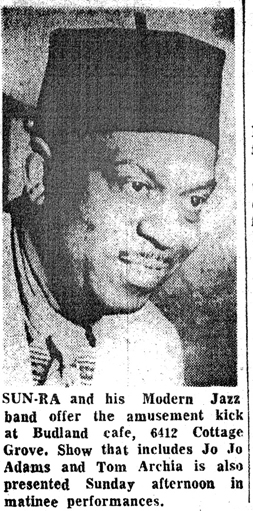
On August 15, 1957, Sun Ra posted an indefinite contract with the Club DeLisa, where he was now leading the off-night band. (Local 208 was now restricting its members to 5-day weeks, so both Monday and Tuesday were off-nights.) Sunny did not use the full Arkestra for these gigs. Mike DeLisa, the oldest of the four DeLisa brothers and the one who was quoted in the press in the past, had died around January 1, 1957, and the club could no longer afford a large band: the regular bandleader, Red Saunders, had been gradually shedding personnel since 1949, and an experiment whereby Red's band was supplemented with Juan Soler's mambo ensemble was halted after a few months. Although the DeLisa's downward trend must have been painfully obvious, Sunny was surely proud to be featured on the same stage where he had played with Fletcher Henderson and the Red Saunders band had performed so many of his arrangements. The abbreviated Arkestra appears to have kept the gig until January 1958, when Louie DeLisa died. The last Defender advertisement for the club ran on January 25, 1958. The DeLisa closed its doors after a final show on February 16, leaving a hole in the South Side entertainment scene that would never be filled (Club DeLisa Up For Sale; Rings Down Curtain Feb. 16. Chicago Defender, February 15, 1958, p. 22).
Despite the sore lack of publicity, the band did get some use out of Budland. One of Sunny's conditions on any club gig was that the Arkestra be allowed to rehearse at the club when it was empty. The next session was recorded at such a rehearsal.

The featured vocalist was new to the Arkestra. Hattie Randolph was Lucious Randolph's sister. She had performed in a family band led by their father, trumpet player Zilner T. Randolph, which recorded once for Zilner Randolph's Blue House label (in 1949) and once for Chess (Chess 1500, credited to "Two Honeys and a Cone," was recorded in October or November 1951). She had sung at a club called Birdland in 1954 (this short-lived venue had no connection with Cadillac Bob's establishment) and in a revue at the Rena Theater in 1955. Her singing had attracted the attention of local entrepreneurs Paul King and Les Caldwell. who recorded her for their Drexel label that same year.
We previously estimated the date as early 1957 but Michael Anderson's compilation of tapes from the Sun Ra Archives gives a precise date of August 25.
Sun Ra (p); Victor Sproles (b); Tito (cga); Hattie Randolph (voc).
Budland, Chicago, August 25, 1957
| tk. 1 | Don't Blame Me (McHugh-Fields) | Transparency 0316 [CD, disk 12] | |
| tk. 2 | Don't Blame Me (McHugh-Fields) | Saturn 485, Evidence 22014 [CD], Transparency 0316 [CD, disk 12] | |
| 'SWonderful (Gershwin-Gershwin) | Saturn 485, Evidence 22014 [CD] | ||
| Lover Come Back to Me (Romberg-Hammerstein) | Saturn 485, Evidence 22014 [CD] |
Hattie Randolph says these tracks were made live at Budland after Art Hoyle left the band. The bassist is not Ronnie Boykins; Victor Sproles was credited on the Saturn LP jacket. Tito is the only conga player that other musicians have recalled working with Ra during the 1950s. The three sides were first released in 1973 on Side A of Saturn LP 485, Deep Purple (some copies titled Dreams Come True). All tracks from Side A were reissued on Evidence 22014 [CD, 1992]. Transparency 0316, The Eternal Myth Revealed Vol. 1 is a 14-CD set released in 2011. It includes a second take of "Don't Blame Me" as well as a scrap of conversation between the takes.
A further discovery is that the August 25, 1957 tape also contains two instrumentals featuring guest guitarist Calvin Newborn. A member of a well-known musical family, Calvin Newborn was born in Memphis, Tennessee, on April 27, 1933. He studied several instruments, settling on the guitar, which he played a band led by his father, Phineas Newborn Sr. In 1949, he toured with Roy Milton, followed by stints with B. B. King and Jackie Brenston (with whom he recorded for Chess). He is credited with teaching Howlin' Wolf how to read music. From 1956 through 1958 his main gig was in a band led by his brother, Phineas Newborn Jr. Calvin Newborn subsequently worked and recorded with many prominent musicians, including Earl Hines and Lionel Hampton. He would rejoin the Arkestra for a 1962 session in New York City.
Sun Ra (p); Calvin Newborn (eg); Victor Sproles (b); Tito (cga).
Budland, Chicago, August 25, 1957
| Blue Space (Ra) | Transparency 0316 [CD, disk 12] | ||
| Everything I Have Is Yours | Transparency 0316 [CD, disk 12] |
These tracks were first released in 2011 on Transparency 0316, The Eternal Myth Revealed Vol. 1 a 14-CD set.
Hattie Randolph recalled a version of “Saturn” featuring her brother Lucious on trumpet. Although such a thing could have been recorded rather easily, none of the three known versions of “Saturn” from the Chicago period includes him. And there has been no confirmation of such a release on the Saturn label. The versions that saw release on Saturn featured Art Hoyle (May 16, 1956) and Hobart Dotson (see below, March 6, 1959). A third version, with Art Hoyle and Dave Young (November 1, 1956) was never released on Transition, for which it was originally intended, or on Saturn, but did eventually appear on Delmark.
For years, we thought that Sunny and other members of the Arkestra were on Saturn 4236/4237, a single likely recorded in 1957 by an eccentric blues singer known variously as Yochan(n)an or the Muck Muck Man. Particularly when Ra was given part of the composer credit on both sides and Yochanan was identified as "The Space Age Vocalist," it seemed likely that members of the Arkestra accompanied the singer. Consequently, the two sides originally issued from this session appeared on Sun Ra: The Singles from Evidence. But Yochanan had a "rock and roll band" at the time, with John Tinsley on tenor saxophone. Tinsley (whose name is sometimes spelled "Tinsey" in sources from the period) had rehearsed with Sun Ra, but he usually led his own combos. What was session Sun35 in previous editions is now Appendix A to this page.
A second Yochanan single (see below) emphatically sounds like the work of a later Arkestra and the session is still in the main body here.
Meanwhile, Sunny wasn't done with Budland. But once again Cadillac Bob wasn't doing anything to promote the Arkestra, so Alton Abraham launched a new round of promotions at his own expense. A quick blurb in the daily Defender's "Off the Record " column for September 10 declared that
Sun Ra and his Outer Space Arkestra was [sic] featured at Budland Sunday when the Atonites played host to the Tempo Players on their "Open Season Program." Of course, the affair featured Outer Space dancing.
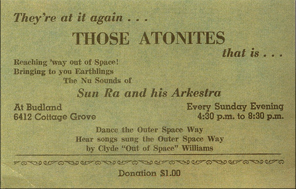 Taking its wording from one of Alton Abraham's press
releases, it marked the first time that the Defender referred
to Sunny's band as an Arkestra. Saturn Record publicity from this period styled Sunny's followers as Atonites—a joint allusion to atonal music, and to the Egyptian sun god Aton or Aten. A surviving Atonite
announcement and an unsold ticket can be seen in Pathways to
Unknown Worlds (p. 82). Clyde "Out of Space" Williams got his own
billing as the band's vocalist.
Taking its wording from one of Alton Abraham's press
releases, it marked the first time that the Defender referred
to Sunny's band as an Arkestra. Saturn Record publicity from this period styled Sunny's followers as Atonites—a joint allusion to atonal music, and to the Egyptian sun god Aton or Aten. A surviving Atonite
announcement and an unsold ticket can be seen in Pathways to
Unknown Worlds (p. 82). Clyde "Out of Space" Williams got his own
billing as the band's vocalist.
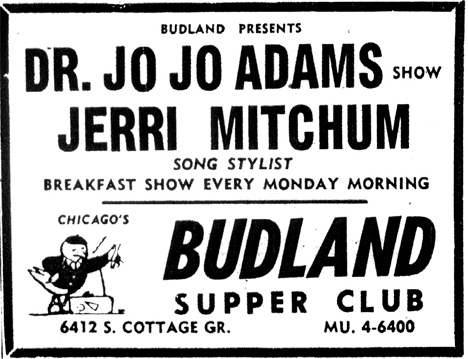
But Budland's fortunes were declining as well. Tom Archia had quit the house trio. Then Cadillac Bob got into all kinds of Union trouble for hiring Jack McDuff a week or so after Archia left. Moving onto Local 208's turf from Danville, Illinois, Brother Jack (real name Eugene McDuffy; he had previously recorded for Chance as pianist and occasional organist in Schoolboy Porter's band) was taking advantage of the shortage of keyboardists who knew their way around a Hammond B-3. A Jack McDuff trio would have kept customers coming in, but it wasn't to be. On October 3, Harry Gray and the Board of Local 208 ordered McDuff off the gig. Cadillac Bob was in a quandary; the only performer he thought could exert any drawing power was the MC, Jo Jo Adams. Adams told jokes and sang blues; he had no band. Bill Hobbs, who had been the drummer in the McDuff trio, signed a contract with the club, but a trio of Bill Hobbs, saxophonist Flaps Dungee, and a no-name organist wasn't going to keep the cash register ringing. From the previous year, Cadillac Bob still had the Arkestra and Richard Whatley's band under contract, but Whatley couldn't have been called on much; he was showing up regularly on the Local 208 contract list during 1957 with jobs at other clubs. So the Atonite promotion helped to keep the Arkestra at Budland, but on what terms and with what frequency we don't know. Just scraping by, Budland would buy just one more ad in the Defender before June 1958, when it briefly reverted to an elaborate variety-show production starring R&B singer Carl van Moon.
There was one indisputable sign of diminishing Arkestral activity. Pat Patrick had often taken sideman gigs, but now he began leading his own band at the It Club, posting an indefinite contract on September 5, 1957, and following up with a second on October 3. He probably stayed another month, giving way to Ernie Green, who posted a contract with the New "It" Club on November 7. In the absence of advertisements or press releases it is impossible to know where else the Arkestra was playing during this period. Sunny posted no further contracts with Local 208 until well into 1958, but besides occasional one-nighters at the ballrooms and off-night duties at the Club DeLisa, he and the band could have been playing any of a number of non-Union joints that had sprung up. Local 208 was no longer making any sustained effort to keep its members out of them.
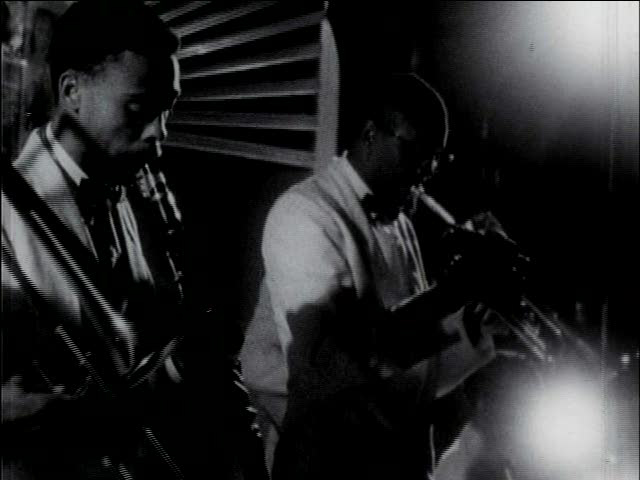
On June 19, 1957, Ra had copyrighted a piece with words by himself and music by Arganny Jones titled “Tone Pictures” (James Wolf). The handwriting on the lead sheet for “Tone Pictures” is not Sunny's. Arganny Jones was a musician about whom we know virtually nothing. Brad Markus found a reference to him in the International Musician for January 1950; Jones was one of several musicians listed as having been reinstated in Local 208 (along with T. S. Mims, Sr., and Forrest Sykes). With words like "Pleasant intuitions of better things to come," the piece is one of Sunny's poems set to music. No recordings have been found.
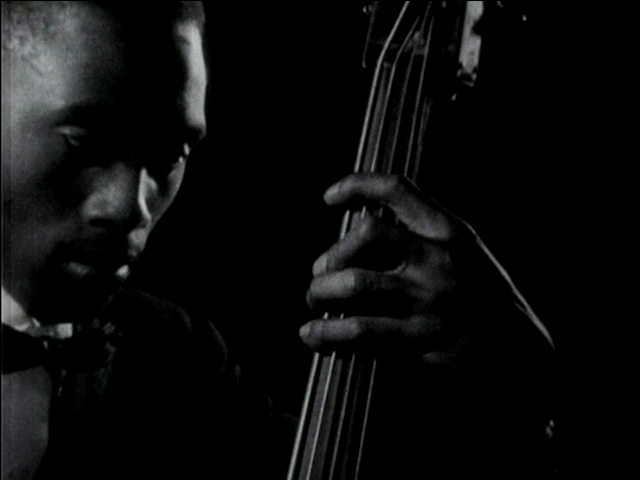
Sun Ra (p, solar p [Wurlitzer ep], Egyptian sun bells), Lucious Randolph (tp); Nate Pryor (tb); James Spaulding (as); Marshall Allen (fl); John Gilmore (ts, solar bells, tambourine); Pat Patrick (bars, Rhodesian bells, solar drum); Ronald Boykins (b); Jim Herndon (timb); Robert Barry (d)
Rehearsal, Chicago, late 1957 or early 1958
| Planet Earth (Ra) | Saturn 9956-11-A/B, Evidence 22039 [CD] |
Sun Ra (ep, p, spiral percussion gong, Chinese solar gong); Lucious Randolph (tp); Marshall Allen (as, fl); James Spaulding (as); John Gilmore (ts, solar drum); Charles Davis (bars); Pat Patrick (space lute); Ronnie Boykins (b); Robert Barry (d); Jim Herndon (tymp, timb).
Rehearsal, Chicago, late 1957 or early 1958
| Overtones of China (Ra) | Saturn 9956-11-A/B, Evidence 22039 [CD] |
These two tracks were released in 1966 on Side A of Saturn LP 9956-11-A/B, Sun Ra Visits Planet Earth. (A third track, "Eve" from Side A of the same LP was formerly listed here, but turns out of have come from the same session around December 1, 1956 that produced side B of the album; see above.) In 1967, it was given the catalog number 207. In 1992, all tracks from this LP were reissued on Evidence 22039 [CD]. The extensive solo credits on the Saturn jacket were helpful in establishing the personnel. James Spaulding joined the Arkestra soon after his arrival in Chicago in August 1957; Marshall Allen and Ronald Boykins were in the fold by the beginning of 1958 and may have joined earlier. Julian Vein gives early 1958 as the date for these items. Lucious Randolph said that the date is approximately correct, and was positive about his appearance on “Planet Earth” (on which he solos) but not completely sure about “Eve” and “Overtones of China.” (And that is just as well, since no trumpet is actually audible on "Eve," which we have now placed with the session of December 1, 1956).
A test pressing of Visits Planet Earth was uncovered by John Szwed. It was made in a Columbia plant, but it is not known whether it was done during the Chicago or New York period (the latter seems more likely).

A conspicuous indication of Sunny's good standing with Local 208 was his installation, in a ceremony on January 2, 1958, to a 4-year term as a member of the local's Examining Board. (The other examiner was William Neeley). He must have had this experience in mind many years later when he occasionally gave a sermonette that began, "This is judgment day—or, rather, examination day." (A version was recorded on the Arkestra's second session for A&M in 1989, and attached to the front end of an instrumental titled "Of Invisible Them.")
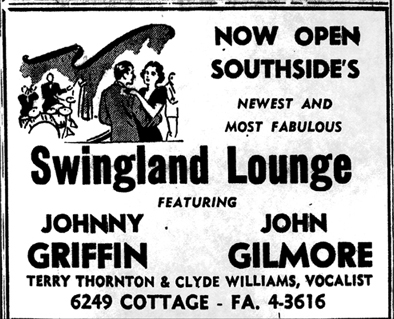
Meanwhile, pickings continued to be lean for the band, as economic recession bit sharply into the South and West Side club scenes. Just before Christmas 1957, John Gilmore defected from the Arkestra for the first time. He joined Johnny Griffin in a Battle of the Tenors format at the new Swingland Lounge (6249 South Cottage Grove, an address previously occupied by the Cotton Club). Griffin filed an indefinite contract with Local 208 on February 6, 1958, and Gilmore followed with his own on March 6. They were assisted by the rhythm section of Jodie Christian (piano), Bill Lee (bass), and Wilbur Campbell (drums). Former "Out of Space" singer Clyde Wiiliams was also on the bill. Swingland's owners misgauged the market for this kind of jazz, and the club closed its doors in April 1958; the last couple of advertisements mentioned Johnny Griffin but not John Gilmore. Gilmore's departure probably took place around March 20, when Victor Sproles, who had come in on bass, filed a new contract as the leader.
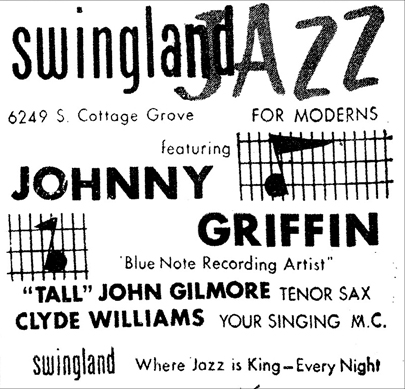
Had Griffin and Gilmore made their 3 month run in New York City, the group would have enjoyed a high probability of being recorded. But in Chicago at this date only the Chess brothers' Argo label might have been interested, and such a project would have posed contractual difficulties in Griffin's case.
Gilmore promptly returned to the Arkestra. A draft of an advertisement for a Sunday matinee dance at the Casino Moderne, March 30, 1958, was found among Alton Abraham's papers (Pathways to Unknown Worlds, p. 120). Getting feature billing alongside the great tenor saxophonist were Pat Patrick and Lucious Randolph.
John Gilmore had not yet reached his full maturity as a soloist, but his name would be featured on the labels to the next Saturn LP release in 1959. After recording an album with Clifford Jordan for Blue Note and co-leading with Johnny Griffin at Swingland, he had earned the recognition.
Meanwhile, Sun Ra copyrighted an enigmatic instrumental on February 11, 1958 titled “Out of Sight” (a collaboration with Conrad S. Wilson; the lead sheet is not in Sunny's handwriting). No recordings are known (thanks to James Wolf for ferreting this one out). Conrad Wilson was a musician whose name shows up twice in the Local 208 Board meeting minutes. The first mention pertained to a gig he had played at the Conrad Hilton Hotel in late January 1956, with a bongoist who wasn't paid up with the union. The second was on account of an engagement he had played on December 31, 1957; the band he was working in played at Budland that night. We still don't know what instrument Conrad Wilson played, or anything else about him.
We formerly listed a track as Sun39, with the possible title "The Cry of Jazz" (it was used in the opening and closing credits of the film with the same name). However, we have now identified the piece as "My Rhaposody," composed by Paul Severson and Norman Leist. It was recorded by a septet led by Paul Severson for Replica Records, a small hi-fi-oriented label run by Bill Huck in Des Plaines, Illinois, in late 1956 or early 1957.
For more about "My Rhapsody" and other non-Ra music included in The Cry of Jazz, see above.
Sun Ra (p); Marshall Allen (as, fl); John Gilmore (ts); unidentified (eg); unidentified (b); unidentified (d); Clyde Williams (voc).
Live at Budland, Chicago, 1958
| 'SWonderful (Gershwin-Gershwin) | Transparency 0316 [CD, Disk 12] | ||
| Roll 'em Pete (Turner) | Transparency 0316 [CD, Disk 12] | ||
| My Funny Valentine (Rodgers-Hart) | Transparency 0316 [CD, Disk 12] |
These tracks were unearthed by Michael Anderson and issued in 2011 on The Eternal Myth Revealed Volume 1 (Transparency 0316, a 14-CD set). The recording was made live at Budland, with the tape recorder parked on the bandstand. Clyde Williams was featured on all three numbers but is markedly off-mike; the influence of Joe Williams is nonetheless noticeable on "Roll 'em Pete."
1958 saw a return to instrumental singles on Saturn.
Le Sun Ra (p); Everett (E. J.) Turner (tp); Marshall Allen (as); James Spaulding (as); John Gilmore (ts); Pat Patrick (bars); Ronnie Boykins (b); William “Bugs” Cochran (d); Alvin Fielder (d).
Rehearsal, Chicago, mid 1958
| J08W2045 | Hours After (Turner) | Saturn J08W0245/6, Evidence 22164 [CD] |
Saturn J08W0245/J08W0246 was a 45 rpm single with a gold label, released in October 1958. According to paperwork preserved in the Alton Abraham Collection (Box 16, Folder 6 part 1), Saturn placed its order for this single with RCA Victor on September 26, 1958, and received a shipment of 275 copies on October 2. (Meanwhile, the J prefix duly indicates that the records were pressed by RCA Victor in 1958). “Hours After” was the A side. The only copy of the single yet to be located is in the possession of Leonard J. Bukowski. The track was reissued in September 1996 on The Singles, Evidence 22164 [2 CDs].
“Hours After” was written and arranged by trumpet player Everett (E. J.) Turner, Jr., who joined the Arkestra after Alvin Fielder, probably toward the middle of 1958. The original title was “Stinkin'.” It is clearly E. J. Turner (a Kenny Dorham disciple) who is featured on this track, though the original label stated, “Featuring Lucious Randolph”! (Randolph was the trumpet soloist on the flip side, “Great Balls of Fire.”) “Hours After” is attributed to Turner-Ra on Jazz in Silhouette. The piece was copyrighted on October 8, 1958 with music by Turner and words by Sun Ra (James Wolf). "Hours after, you hear it, you'll hum it/ If you play a guitar you will strum it..." No recordings of the vocal version have been found.
Alvin Fielder confirmed his presence and Turner's. Muddy recording quality indicates a rehearsal (Alton Abraham said that this was done in a studio, which is cannot be the case, barring a sonic disaster--and that he used Robert Barry and not Alvin Fielder on studio sessions, which seems correct). The first edition of The Earthly Recordings of Sun Ra included Charles Davis on baritone sax, but Alvin Fielder says that only Pat Patrick was present. Fielder gave the date as “around February 1959.” However, we now know when the record was shipped by RCA Victor.
Sun Ra (p); Lucious Randolph (tp); William Fielder (tp); Everett (E. J.) Turner (tp); Freddie Hubbard (tp); Nate Pryor (tb); John Avant (tb); Marshall Allen (as, fl); James Spaulding (as, fl); John Gilmore (ts); Pat Patrick (bars); Charles Davis (bars); BeBop Sam Thomas (eg); Wes Montgomery (eg); Ronnie Boykins (b); William Cochran (d); Alvin Fielder (d); Hattie Randolph (voc).
YMCA, Indianapolis, mid-1958
| unidentified titles | unissued |
This legendary concert (for which the musicians were not paid...) is included because it figures prominently in the reminiscences of Lucious Randolph, Alvin Fielder, Bill Fielder, Nate Pryor, and James Spaulding, and in Val Wilmer's book As Serious as Your Life. The personnel is based on a composite of their reminiscences; Alvin Fielder confirmed it except he did not believe that Charles Davis was present. (A more recent recollection by Bill Fielder had Hobart Dotson at the concert, playing lead trumpet, and omits Turner.) The concert was most likely recorded (as was Ra's standard practice at the time) but there is no confirmation that tapes are still extant. Wes Montgomery sat in. One version of the story has it that Freddie Hubbard wasn't allowed to because of his youth. However, Fielder recalled that Hubbard did sit in and liked Bugs Cochran's drumming. Alvin Fielder places the date as “April or early May 1959.” If Alvin Fielder is correct about the time of year, Charles Davis probably wasn't on hand, as he remained in Dinah Washington's band until the singer fired him in June 1958.
On June 26, 1958, Sun Ra posted an indefinite contract with Budland. Cadillac Bob had purchased two Defender advertisements in June, just before re-engaging the Arkestra. then dropped back off the newspaper's entertainment pages for nearly six months. In August, Budland picked up Porter Kilbert's band, which had been the house ensemble at Roberts Show Lounge for several months, until it was displaced by Red Saunders' veteran ensemble (Kilbert's contract was accepted and filed on August 21). We used to think that Budland had no further need for Arkestral services once Kilbert's band had been engaged, but the Arkestra was still around in December. It's pretty clear, though, that Kilbert's band normally got the Friday and Saturday night slots.

In December, when the club made another brief bid for attention in the Defender, the "Outer Space Band" was confined to the Monday morning breakfast dance. Dr. Jo Jo Adams had been brought back as the MC. (Inevitably, Sunny's name was going to come out as "Sun Ray"—the Defender had done it once in the weekly entertrainment roundup, but this time the misspelling was right in the display ad.) The Defender for December 20, 1958, carried a brief blurb for a Monday night jam session at the club; John Gilmore and Pat Patrick were among the participants readers were told might be there.
We don't know how long the jam sessions lasted. Budland brought in a band led by guitarist Leo Blevins, whose contract was accepted and filed by Local 208 on February 19, 1959. Blevins' band was still working a steady gig at the Last Chance Lounge in February, but when Budland resumed advertising in June, Porter Kilbert was gone and Blevins was in charge of the house ensemble. In May, Jo Jo Adams decamped to the Green Door, a blues club that kept him on as its weekend MC for several months. Budland was now trying to return to the variety show format that it had often used in 1956; the show was organized by Rudy Crier, who had been in charge of the Grand Terrace's final efforts in 1955, 1956, and 1957. Crier even brought in Harold Burrage, who had been a headliner when Sunny played the Terrace in 1955. No sooner had Burrage gotten himself noticed again than he was hired away by Roberts Show Lounge; the revue limped through July with other headliners. Although Crier had worked with Sun Ra in the fall of 1955, we suspect that the Arkestra departed around the same time as Porter Kilbert's band. In any event, the last ad for Budland ran on August 1, 1959. The club probably shut down later that month. By September 12, Leo Blevins and his International Jazz Men were headlining at the Coral Club (1378 East 63rd Street).
There would be one final attempt (with no ad budget) to bring live music to Budland, in January 1960. This involved Leo Blevins and Richard Whatley (aka Don Costello); there is no reason to think that Sunny played any role in it. Blevins' band was at Budland for two weeks, exiting in early March 1960. In 1964 or 1965, the club would reopen as a venue for DJs like Herb Kent, who hosted dances for teenagers.
Sunny and members of his band also participated from time to time in jam sessions at the Pershing Ballroom. Part of a session is preserved on one side of reel of tape that was found in the archives by Michael Anderson. Anderson previously thought it might be from June 1956 but his further research has turned up a date in August 1958.
J. J. Johnson (tb except -1); Gene Ammons (ts except -1, 2); Pat Patrick (bars except -2); Sun Ra (p); Ronnie Boykins (b); Robert Barry (d).
Pershing Ballroom, Chicago, August 15, 1958
| Chi-Town Blues | Transparency 0316 [CD, disk 13] | ||
| Just You, Just Me (Klages-Greer) | Transparency 0316 [CD, disk 13] | ||
| I Can't Get Started -1 | Transparency 0316 [CD, disk 13] | ||
| Don't Blame Me -2 | Transparency 0316 [CD, disk 13] |
Thirty-three minutes of music from a genuine all-star jam session are preserved on this tape. Pat Patrick, J. J. Johnson, Gene Ammons, and Sun Ra all solo at length. The sound is pretty good, except that J. J. Johnson is off-mike during the first two numbers. "I Can't Get Started" is a feature for Pat Patrick and "Don't Blame Me" is reserved for J. J. Johnson. Personnel identified by Michael Anderson; members of the audience helpfully call out "J. J." and "Mr. Jughead." All four tracks were released in 2001 on The Eternal Myth Revealed Vol. 1, a 14-CD set compiled by Michael Anderson.

Le Sun Ra (Wurlitzer ep); Lucious Randolph (tp); John Gilmore (ts); Pat Patrick (bars); BeBop Sam Thomas (eg); William “Bugs” Cochran (d); Alvin Fielder (d); Jim Herndon (tymp); unidentified (perc).
Rehearsal, Chicago, August or September 1958
| J08W2046 | Great Balls of Fire (Ra) | Saturn J08W2045/6, Evidence 22164 [CD] |
Saturn J08W0245/ J08W0246 was a 45 rpm single with a gold label, released in 1958. “Great Balls of Fire” appeared on the B side; the label states “Featuring Pat Patrick.” Bill Fielder (who played trumpet with Sun Ra in 1958) remembers “Great Balls of Fire.” The track was reissued for the first time in September 1996, on The Singles, a 2-CD set on Evidence 22164.
“Great Balls of Fire” came from a different rehearsal with much better sonics than the session that produced “Hours After.” (Alton Abraham said it was a studio session; if so, Robert Barry would be one of the drummers and not Alvin Fielder.) Personnel identified by rlc and corrected by Alvin Fielder (the first edition of this discography identified Ronald Wilson as the baritonist but Fielder does not recall working with him in the Arkestra). According to Alvin Fielder, Sam Thomas was the only regular guitarist in the Arkestra at this time, though Art Jobs worked with Ra briefly. Fielder also said that when the Arkestra used two drummers, he worked with William Cochran, not Robert Barry. He placed the session in “late summer or early autumn 1959.” (This is probably right about the season, but definitely wrong about the year). Saturn Records put in an order for J08W0245/0246 on September 26, 1958, and received a shipment of 275 copies on October 2, 1958.
Preserved among the Alton Abraham papers is a draft handbill for a coronation ball for Miss Bronze 1958 (Pathways to Unknown Worlds, p. 116). The ball took place on August 9 at the Casino Moderne, 913 East 63rd Street, where the band had often played for dancing, "Featuring the Great Sun Ra Plus a Host of Stars." But the coronation ball had to be one of the few occasions where an Arkestral performance was advertised with promises of "Girls Girls Girls Girls Girls Girls Girls."
Sun Ra (p, Solovox); Marshall Allen (as, fl); John Gilmore (ts); Pat Patrick (bars, cl); BeBop Sam Thomas (eg); Ronnie Boykins (b); unidentified (d).
Budland, September 23, 1958
| Just One of Those Things (Porter) | Transparency 0316 [CD, Disk 14] | ||
| Sophisticated Blues [Swinging Shephard Blues] | Transparency 0316 [CD, Disk 14] | ||
| Will You Still Be Mine | Transparency 0316 [CD, Disk 14] | ||
| Tequila | Transparency 0316 [CD, Disk 14] |
Another find from the Sun Ra archives is part of a live set at Budland from September 23, 1958. Date and location are as given in the notes to The Eternal Myth Revealed Vol. 1 (Transparency 0316, released in 2011). This was the work of a septet. The guitarist is most likely BeBop Sam Thomas. "Tequila" features the unusual front line of Marshall Allen on flute; Pat Patrick on clarinet, and John Gilmore on tenor sax. At the end of "Tequila," a short statement of "Medicine for a Nightmare" (with alto, tenor, and baritone sax) signals that the set is closing. Sun Ra had taken his Solovox out of mothballs, featuring it on "Tequila." The lower-register grunts and swoops would reappear in Sunny's Clavioline playing when he acquired that instrument some years later.
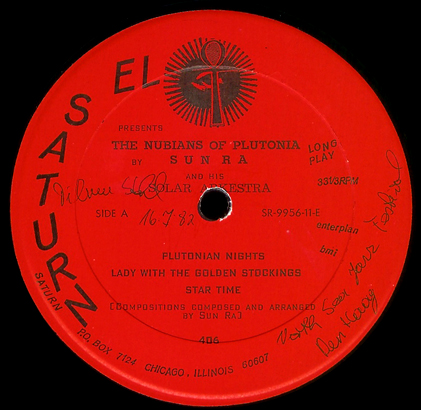
Sun Ra (p); Lucious Randolph (tp); Nate Pryor (tb); James Spaulding (as solo); Marshall Allen (as); John Gilmore (ts); Pat Patrick (bars solo); Charles Davis (bars); Ronnie Boykins (b); Robert Barry (d); Jim Herndon (timb, perc).
Rehearsal, Chicago, 1958
| Star Time (Ra) | Saturn K8OP-2864-2 (unissued test pressing), Saturn 9956-11E/F, Impulse AS-9242, Evidence 22066 [CD] |
In 1959, "Star Time" was being considered for inclusion on a Saturn LP to follow Jazz in Silhouette. The plans were abandoned, but one of two trial versions of an LP side survives as K8OP-2864-2, a custom pressing done for Saturn by RCA Victor, with "Star Time" as the third of five tracks.
The track did not see release for several years. It finally appeared on an LP first issued (in a generic Tonal View of Times Tomorrow cover) by Saturn in 1966 as SR 9956-11E/F, Lady with the Golden Stockings. In 1967, this album was given the catalog number 406; by the end of 1967 (according to Vein) it was retitled The Nubians of Plutonia and by 1969 given a new cover by Richard Pedreguera. Subsequent reissues (on Impulse AS-9242 in 1974 and Evidence 22066 [CD] in 1993) have used the later title. We obtained titles and personnel from the 1969 Saturn and Impulse issues.
Lucious Randolph confirmed Charles Davis's presence on this cut. Davis's availability for Arkestra recordings in 1957 and 1958 was limited by his commitment to singer Dinah Washington. He joined her band after she married tenor saxophonist Eddie Chamblee in February 1957 and was a regular member of her touring group until June 1958, when Dinah fired him along with drummer James Slaughter, another Chicago musician. Davis could of course have sat in with the Arkestra when the singer was either working in Chicago (as she typically did three or four times a year) or spending some time at her home in town. Davis worked with Sun Ra during the second half of 1958 and into the early months of 1959. Not long after the big Arkestral studio session of March 6, 1959, he moved to New York City.
 While the Arkestra enjoyed its long initial run at Budland, Sun Ra stopped coaching vocal groups. During
1958 and 1959 Sunny renewed his interest in them. He mentored several ensembles (including Mr. V's Five Joys and the Qualities), but the Cosmic Rays were his pride and joy. The Rays were four young men from the West Side of Chicago; their manager, Raymond Dancer,
lived on the South Side and had been acquainted with Ra for a little while. Ra, of course, named the group the Cosmic Rays. Sun Ra was
a serious believer in community outreach, and he hoped to change their destinies, but despite his efforts it has been said that all
four made bad exits from the planet many years ago. (The lead singer, Calvin Barron, died in the 1980s, supposedly in a murder-suicide.) "They were connected with a barbershop. I taught them other things." According to Dancer in his conversations with John Corbett, the Rays attended Arkestra rehearsals, typically working with Ra during breaks or with the entire band toward the end of the session.
Many of these rehearsals were recorded.
While the Arkestra enjoyed its long initial run at Budland, Sun Ra stopped coaching vocal groups. During
1958 and 1959 Sunny renewed his interest in them. He mentored several ensembles (including Mr. V's Five Joys and the Qualities), but the Cosmic Rays were his pride and joy. The Rays were four young men from the West Side of Chicago; their manager, Raymond Dancer,
lived on the South Side and had been acquainted with Ra for a little while. Ra, of course, named the group the Cosmic Rays. Sun Ra was
a serious believer in community outreach, and he hoped to change their destinies, but despite his efforts it has been said that all
four made bad exits from the planet many years ago. (The lead singer, Calvin Barron, died in the 1980s, supposedly in a murder-suicide.) "They were connected with a barbershop. I taught them other things." According to Dancer in his conversations with John Corbett, the Rays attended Arkestra rehearsals, typically working with Ra during breaks or with the entire band toward the end of the session.
Many of these rehearsals were recorded.
The Cosmic Rays: Calvin Barron (voc); Matt Swift (voc); Lonnie Tolbert (voc); unidentified (voc); with Sun Ra (Wurlitzer ep); E. J. Turner (tp); Marshall Allen (fl); James Spaulding (as); John Gilmore (ts); Charles Davis (bars); Ronnie Boykins (b); Robert Barry (d); Jim Herndon (tymp); Pat Patrick (space lute).
Rehearsals, Chicago, 1958
| Somebody's in Love (Raymond Dancer-Lonnie Tolbert) | Atavistic UMS/ALP243 [CD] | ||
| Bye Bye (Matt Swift) | Atavistic UMS/ALP243 [CD] | ||
| Black Sky and Blue Moon (Ra) | Atavistic UMS/ALP243 [CD], Norton CED-353 | ||
| Honey | Atavistic UMS/ALP243 [CD] | ||
| Honey | Atavistic UMS/ALP243 [CD] | ||
| Come Rain or Come Shine | Atavistic UMS/ALP243 [CD] |
When we first listed it, in the 2nd edition of The Earthly Recordings of Sun Ra, we thought that “Black Sky and Blue Moon” was by the Nu Sounds, possibly dubbed over a recording of the 1958-1959 Arkestra. But from John Corbett's tape finds, and his interviews with the group's manager, Raymond Dancer, we know that the vocal group on "Black Sky and Blue Moon" was the Cosmic Rays and that the recording was made at an Arkestra rehearsal in which the Rays participated. Other tracks on the tape were made at different rehearsals around this time.Some of the material was taped in stereo. The recording was not of the best quality and has not been all that well preserved.
A copy of “Black Sky and Blue Moon” was brought to WKCR-FM by Sun Ra and broadcast during the station's Sun Ra Festival in April 1987. The musicians were identified by rlc but there is no doubt about Allen (who solos) or Boykins—or Patrick, for that matter—and Gilmore can be heard in the ensemble. We have added Charles Davis to our previous listing after being able to hear the piece as released on Atavistic. The rhythm section plays in a manner already familar from the 1957 tracks on Visits Planets Earth and from the entire contents of The Nubians of Plutonia. It and the other selections were released in 2003 on Atavistic UMS/ALP243, a CD titled Spaceship Lullaby. Norton CED-353, released in 2009 as Sun Ra: The Second Stop Is Jupiter, also includes "Black Sky and Blue Moon," in stereo—and in somewhat better sound. Michael Anderson's notes to the Norton, which attribute this number to the Nu Sounds, give February 12, 1958, as the date—two days after the date he gives for the "Africa" rehearsal.
“Somebody's in Love” is accompanied by alto and baritone sax, Ra's Wurlitzer electric piano, bass, and drums. “Bye Bye” uses piano, bass (barely audible), and drums. The first version of “Honey” is accompanied by the Wurlitzer, plus space lute, bass, and drums with mallets. The second version features a similar Arkestral lineup to the one on “Black Sky and Blue Moon,” possibly minus John Gilmore. “Come Rain or Come Shine” includes Pat Patrick on baritone sax with Ra on the trusty Wurlitzer, Boykins on bass, and a drummer. A flute can be heard at the very end of the piece.
A number of sources, including the late John Gilmore, identified Calvin Barron as the lead singer of the Cosmic Rays. Matt Swift and Lonnie Tolbert were named by the group's former manager, Raymond Dancer. According to Robert Pruter in Doowop: The Chicago Scene, Calvin Barron was the most experienced member of the Rays. In 1956, Barron joined the Moroccos, who had already recorded, appearing on their last session for United in August of that year. But United was in decline—the company would close its doors in 1957—and after appearing on one side of a Teddy Phillips single for Mort Hillman's Salem label in October 1957 the Moroccos broke up. After the Rays became inactive, Barron would move on to another group called the Twi-Lites, which stayed together till 1963, if not later.
The Cosmic Rays: Calvin Barron (voc); Matt Swift (voc); Lonnie Tolbert (voc); unidentified (voc); Sun Ra (dir).
Rehearsal, Chicago, 1958 or 1959
| Daddy's Gonna Tell You No Lie [tk. 1] (Calvin Barron-Charles Edward Orio-Ra) | Saturn 9/1954, Evidence 22164 [CD] | ||
| Daddy's Gonna Tell You No Lie [tk. 2] | rejected |
Saturn 9/1954 is a 45 rpm single, not released till 1983 (according to the log at Variety Recording Studio, it was mastered on September 12, 1983; just 2 stampers were made). The complete lyrics to “Daddy's Gonna Tell You No Lie” are not included in this version, suggesting that it was a demo. Indeed, Michael Anderson has said that both titles on this single originated as a demo disk; the second take of “Daddy's Gonna Tell You No Lie” has a “bad start.” Take 1 was reissued on Evidence 22164 [2 CDs], The Singles, in September 1996.
The Cosmic Rays: Calvin Barron (voc); Matt Swift (voc); Lonnie Tolbert (voc); unidentified (voc); Le Sun Ra (p -1, dir); unidentified (eg); prob. Ronnie Boykins (b); Robert Barry (d); Jim Herndon (timbales -2).
RCA Studios, Chicago, c. August 1958
| 45-S-192 | Bye Bye (Matt Swift) -1 | Saturn B222, Live Gold 7016 [CD], Evidence 22164 [CD] | |
| 45-S-193 | Somebody's in Love (Raymond Dancer-Lonnie Tolbert) -2 | Saturn B223, Evidence 22164 [CD] |
Saturn B222/223 was a 45 rpm single. The Saturn label is light yellow and the print is red, in a sort of Art Deco style; the overall design resembles that of the oldest Saturn label we know, from Saturn Z-1111. Thanks to Jerry Gordon for a description of this very rare single; we have now seen another copy in the Alton Abraham collection.
The sides were recorded in a studio, but at a different session from the second Cosmic Rays single. Raymond Dancer, who managed the Rays and bankrolled their rehearsals with the Arkestra, told John Corbett that the two sides were recorded as demos at RCA Studios and subsequently released on Saturn. (We have not yet found a bill from RCA Victor for recording them.) Dancer's business card, now reproduced in Pathways to Unknown Worlds, mentions these two sides.
The presence of Jim Herndon on “timbali” favors a 1958 date. We used to think that Richard Evans was on bass, but he had long since quit being the Arkestra's regular bassist by this time.
The Alton Abraham Collection (Box 16, Folder 9) inclues a bill for the mastering of "Bye Bye" and "Somebody's in Love," from Sheldon Recording Studios, 2120 S. Michigan Avenue, charging the customary rate of $9 each. (Sheldon was the name that Chess Studios used for outside work.) The Sheldon invoice is dated September 28, 1958. In Box 16, Folder 8, is a bill from S. J. Shaw Plating Corporation (in Cincinnati) for 2 metal masters, mothers, and stampers for "45-192" and 45-193"; the metal parts were shipped on October 6, 1958. A copy of the single in Box 66 of the Alton Abraham collection shows Sheldon matrix numbers in the trailoff vinyl as well as the characteristic Sheldon stamp. Whether Saturn also had Sheldon press the single, we don't know; we haven't seen a pressing bill on it.
In 1995, “Bye Bye” was rereleased on the CD A Million Dollars Worth of Doo-Wop Volume 3 (Live Gold 7016). This is a various artists collection of obscure doo-wop from small labels, including Corvette, Dice, and Hightone. Our thanks to John Szwed for locating this item.
The first legitimate reissue of “Bye Bye” and the first reissue in any form of “Somebody's in Love” appeared in September 1996 on Evidence 22164 [2 CDs], The Singles.
The Crystals: four unidentified male vocalists; Sun Ra (p).
Rehearsal, Chicago, November 21, 1958
| Little Sally Walker (trad.) | Norton CED-353 | ||
| Honey in the Bee Box (trad.) | Norton CED-352 |
After Alton Abraham's death in 1999, a rehearsal tape with a previously unknown vocal group called The Crystals gained legendary status. The surviving tracks were released in 2009 on Norton CED-352, Sun Ra: Interplanetary Melodies, and Norton CED-353, Sun Ra: The Second Stop Is Jupiter.
"Little Sally Walker," unlike nearly everything else that Sunny did with vocal groups, is a rock and roll performance. (A member of the group can be heard at the end of track, complaining about spending 3 hours on "Little Sally Walker," but listeners today might think the results are worth it.) Little Sally Walker rides, of course, on a (flying) saucer. "Honey in the Bee Box" sticks closer to the original children's song, and at times the singers have some trouble taking it seriously.
The rehearsal date was provided by Michael Anderson. Ra's tapes also included "Eddie C Rock," a live tape from around this time of the Crystals (and possibly of members of the Arkestra) backing bluesman and occasional rock and roller Eddie Clearwater. This was so poorly recorded as to preclude reissue.
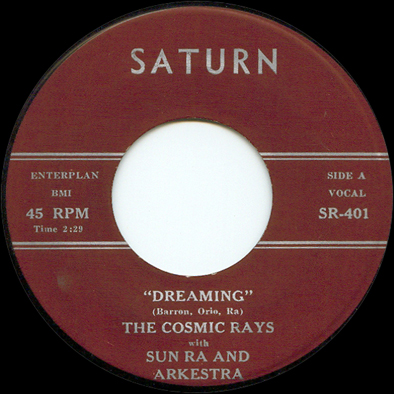
The Cosmic Rays: Calvin Barron (voc); Matt Swift (voc); Lonnie Tolbert (voc); unidentified (voc); with Sun Ra (p); Ronnie Boykins (b); Robert Barry (d); Tito (cga).
prob. Sheldon (Chess) Studios, Chicago, poss. August 1959
| S-401 | Dreaming (Calvin Barron-Charles Orio-Ra) | Saturn SR-401/2, Pesky Serpent ps 1001, Evidence 22164 [CD], Norton CED-353 | |
| S-402 | Daddy's Gonna Tell You No Lie (Barron-Orio-Ra) | Saturn SR-401/2, Valmor 1369, Evidence 22164 [CD] |
Saturn SR-401/SR-402 is a 45 rpm single, issued (so far as we know) in June 1960. Pete Gianakopoulous and the late Otto Flückiger reported copies that have red labels with golden yellow print.
Barry Soltz reports original 45s that have silver print instead of golden yellow. These bear a a stamp from Sheldon (the name that Chess for its studio and pressing plant when it did work for outside customers) in the trail-off vinyl and are pressed on heavy, stiff vinyl. There is an S prefix (for Sheldon) on the matrix numbers as incised in the trailoff area.
On June 29, 1960, Saturn sold 93 copies of this single to Mark Record Distributors, 854 East 63rd Street, for 59 cents a record. The receipt (in the Alton Abraham Collection, Box 16 Folder 9) was signed "Rec'd Bill Sheppard."
"Dreaming" and "Daddy's Gonna Tell You No Lie" had both been copyrighted on September 1, 1959. The composers were identified as Calvin Barron and C. A. Orio—no mention of Sun Ra on either. No bill for the actual recording session has turned up. The copyright date may therefore be a clue, though we have no evidence of a release before June 1960 (and Sheldon assigned 403 and 404 to "Big City Blues" and "The Blue Set," released in August 1960.
The single was “reissued” in 1983 (in imitation of the silver-print version). According to Barry Soltz, the reissues lack the Sheldon imprint in the trail-off area and are typically pressed on lighter, more flexible vinyl than was in use in 1959. Some have labels that are shiny (the original red to maroon had a matte finish). The reissue was not a genuine Saturn. Sunny's plans to put the sides back out himself were frustrated when a trunk containing his copies of the master tapes for both of them was stolen at some point in the late 1970s (Michael Arlt). According to Kenneth Ellzey, the reissue is a bootleg, one of the many “repro” 45s produced for doo-wop DJs and jukeboxes. The repro was still on sale as of June 1995.
Again, we used to think that the bass player was Richard Evans, but in 1958-1959, Ronnie Boykins would gotten the first call to play bass, followed by Victor Sproles; Evans played with Arkestra only on a few occasions during this period.
Lucious Randolph recalled a conga player named Tito who performed with Ra around that time.
Jerry Gordon has said that the original tape boxes have the notation “use take 2” for both sides. However, “Daddy's” is announced on the master tape as take 1, and it is not known whether any other takes survive. According to Pat Padua and John Szwed, this version of “Daddy's Gonna Tell You No Lie” was reissued in 1989 on a doo-wop collection LP, Valmor 1369, Jook Block Busters #1.

“Dreaming” was reissued on LP in 1995. Pesky Serpent ps 1001 was a limited-edition bootleg collection (1000 copies) under the title Beat Jazz: Pictures from the Gone World. It also included tracks by Slim Gaillard, Kenneth Rexroth, Jack Kerouac, Bob Dorough, Ada Moore, Gil Mellé, and Gregory Corso, as well as “Picasso” by Coleman Hawkins (Pedro Moreno).
Both tracks were legitimately reissued for the first time in September 1996, on The Singles, Evidence 22164 [2 CDs]. "Dreaming" was reissued in 2009 on Norton CED-353, a collection of Ra-directed vocal material titled Second Stop Is Jupiter.
Juanita Rogers (lead voc); Lynn Hollings (narration); 4 unidentified males (voc); Mr. V [Sun Ra] (p, dir); unidentified (ts); unidentified (eg); unidentified (d).
Somebody's living room, Chicago, 1958 or 1959
| 333A | Teenager's Letter of Promises (Rogers) | Pink Clouds 333, Evidence 22164 [CD] | |
| 333B | I'm So Glad You Love Me (Rogers) | Pink Clouds 333, Evidence 22164 [CD] |
Lynn Hollings is billed only on Side A of the original Pink Clouds 333, where he is the narrator. He was not one of the singers. Pink Clouds 333 is a 7” 45 rpm single. It seems to have been issued three times. The first time was around 1959 and the label was a Chicago-area gospel specialist. Pink Clouds put out a second single coupling one item from this session with a different Juanita Rogers side that had no Ra involvement; the labels also play up Hollings' involvement at Sunny's expense.
Pink Clouds actually got one of its singles reviewed in Cash Box (even with the trade magazine's much expanded coverage of record releases in the late 1950s, this has to be considered a miracle). Pink Clouds 796, with more typical fare for the label, featured a gospel group led by Willie Kent. What's interesting is the name given to the group: Mr V's Golden Suns (Cash Box, February 28, 1959, p. 57).
The third issue has a definite Saturnian provenance. The label is hand-drawn and the 45s were distributed out of the House of Ra in Philadelphia at some point between 1974 and 1977 (before James Jacson took up residence in the house). No composers are listed but the publisher for the tunes is Enterplan BMI (indicating Ra or Abraham had a hand in it). Both sides were reissued in September 1996 as part of The Singles, Evidence 22164 [2 CDs].
Thanks to Michael Arlt for alerting us to this release; he describes the sonics accurately by saying it was “made in somebody's living room.” James Jacson confirmed Sunny's involvement and said that the release derived from an “old, old paper tape” in Sun Ra's private collection. Sun Ra recorded paper tapes on his Sound Mirror from 1948 until at least 1954 (when he reportedly recorded some very early solos by John Gilmore on a paper tape—nothing more is known about these items, unfortunately). However, Robert Pruter dates these sides from 1958 or 1959, based on the vocal style. It is not known whether the Five Joys are the same as the “Five Jays” (male lead, female lead, three male backup singers) whose publicity photo is in Robert Pruter's collection. However that may be, Sun Ra told Arkestra members that he wrote the arrangements for this date. On “Teenager's Letter of Promises,” the episodes with Hollings as the (heavily reverbed) narrator have obviously been spliced in by an amateur.
Lynn Hollings was a jazz disc jockey in Chicago during the late 1950s and early 1960s. He also appeared on television in some capacity. All of this brought him enough of a following to support a couple of appearances in the Chicago clubs during 1961. The first was a DJ night at the West Side club 5thJack, in January (the Arkestra would play 5thJack a few months later). The second was a one-nighter in July, at a North Side jazz club called the French Poodle; for that event, he was billed as "Radio & TV's Romantic Voice."

It used to be believed by some in the doo-wop community that Sun Ra produced a single for the M & M label in Chicago, featuring the doo-wop group The Equallos. One of the Equallos titles on M&M 30 was “Beneath the Sun.” M and M was a spinoff of the Mad label, started in 1957 by tenor saxophonist Tommy “Madman” Jones. Alton Abraham told Jerry Gordon that his and Ra's activities brought them into contact with Jones (“Everyone intermingled back then”) and that M and M used the same pressing plant for its singles. But the lyrics to “Beneath the Sun” are typical love-lorn fare, the vocal arrangement is poor quality, the quartet is sketchily accompanied by a rhythm section that does not sound like Sunny or anyone he would have worked with, and the record was made in 1962. The date is enough to rule out Sunny's involvement.
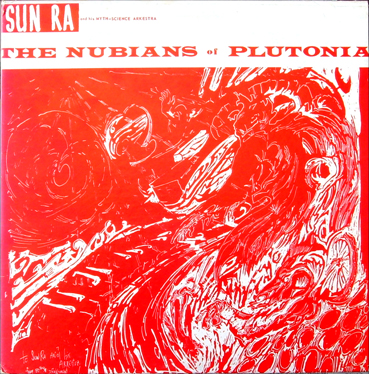
Sun Ra (p, Wurlitzer ep); Lucious Randolph (tp); Marshall Allen (as); John Gilmore (ts); Pat Patrick (bars); Ronnie Boykins (b); Robert Barry (d).
Rehearsal, Chicago, 1958 or 1959
| Plutonian Nights (Ra) | Saturn 9956-11E/F, Impulse AS-9242, Evidence 22066 [CD] |
Lucious Randolph is not sure whether he was present here, but Phil Cohran (the other trumpeter credited by Saturn and Impulse) hadn't joined the band yet.
Sun Ra (Wurlitzer ep); Lucious Randolph (tp); Marshall Allen (fl, perc); James Spaulding (as, perc); John Gilmore (ts, perc); Ronnie Boykins (b); Robert Barry (perc); Jim Herndon (perc); prob. Pat Patrick (bgo).
Rehearsal, Chicago, 1958 or 1959
| Lady with the Golden Stockings (Ra) | Saturn 9956-11E/F, Impulse AS-9242, Evidence 22066 [CD] |
This piece was retitled “The Golden Lady” on the jacket (but not the label) of the later Saturn releases and on Evidence 22066 [CD]. The Saturn label (but not the jacket) refers to the band as “Sun Ra and his Solar Arkestra.”

Sun Ra (Wurlitzer ep, bells); Ronnie Boykins (b); Robert Barry (d); Jim Herndon (cga, tymp, timb, perc); John Gilmore (Nigerian bells).
Rehearsal, Chicago, 1958 or 1959
| Nubia (Ra) | Saturn 9956-11E/F, Impulse AS-9242, Evidence 22066 [CD] |
Sun Ra (Wurlitzer ep); Nate Pryor (tb); Marshall Allen (fl); James Spaulding (as); poss. Charles Davis (bars); Pat Patrick (space lute, voc); Ronnie Boykins (b); Robert Barry (d, perc); Jim Herndon (timb, perc); poss. John Gilmore (perc); The Cosmic Rays (voc).
Rehearsal, Chicago, 1958 or 1959
| Africa (Ra) [CR wordless voc]/ | Saturn K8OP-2864-1 (unissued test pressing), Saturn K8OP-2864-2 (unissued test pressing), Saturn 9956-11E/F, Impulse AS-9242, Evidence 22066 [CD], Norton CED-352 | ||
| Africa (Ra) [CR voc]* | Atavistic UMS/ALP243 [CD] |
The baritone sax work is rather “outside” for Charles Davis; it could be that Patrick played baritone sax and another Arkestran was entrusted with the space lute (which is prominent in the arrangement). Also, Spaulding's alto sax can be heard in the background near the end of the piece.
The 2nd edition of The Earthly Recordings contained conjectural vocal credits for various Arkestrans, which are now known to be incorrect. (We were encouraged in our error by the 1969 liner notes to The Nubians of Plutonia, which proclaimed "Vocals performed by the Arkestra.") The version of “Africa” that was released on Saturn contains a vocal ensemble for four men singing and humming wordlessly. In 2003, a brief vocal performance of “Africa” by the Cosmic Rays, with Arkestral accompaniment, was issued on Atavistic UMS/ALP243 [CD], Spaceship Lullaby; the vocal excerpt was found spliced into a sort of tape collage with other material from rehearsals, including a fragment of “Plutonian Nights.” As Steve Espinola showed us shortly after the vocal excerpt was released, the excised portions with the lyrics are inserted into the instrumental version in two places where splices are evident, they fit just fine—so the Cosmic Rays were the vocal ensemble. John Gilmore's tenor sax is not audible anywhere in this piece.
"Africa" was issued for the first time with vocal credits in 2009, on Norton CED-352, Sun Ra and his Arkestra: Interplanetary Melodies. In his notes to the Norton CD, Michael Anderson gives February 10, 1958, as the date of the "Africa" rehearsal and identifies the vocal group as the Nu Sounds. However, the Norton release uses the cut version of the piece as it appeared on Saturn and Impulse. We are still waiting on a complete, restored "Africa," with the original words, has yet to see release.
The decision to cut most of the Cosmic Rays' contribution was made early on. In 1959, Saturn was considering an LP to follow Jazz in Silhouette. The tentative title was Ankhaton. The surviving test pressings each contain two unissued tracks from the Jazz in Silhouette session, "Ankhaton" and "Spontaneous Simplicity," and three tracks from the rehearsal sessions that were later used on The Nubians of Plutonia. "Africa," edited exactly as the released version, appeared on both test pressings.
Sun Ra did not copyright “Africa” until October 10, 1960, when he packaged it into a suite with "Interplanetary Music." As copyrighted, it had the same lyrics that the Rays sang on the uncut version. "Africa" with lyrics was performed live on just one occasion that we know of—the Arkestra's truly epic December 31, 1980 concert in Detroit, which lasted nearly 8 hours.
Sun Ra (p); William Fielder (tp); Marshall Allen (as); John Gilmore (ts); Ronnie Boykins (b); Robert Barry (d, perc); prob. Jim Herndon (perc); prob. Pat Patrick (perc).
Rehearsal, Chicago, 1958 or 1959
| Watusa [Watusi] (Pitts-Sherrill; arr. Ra) | Saturn 9956-11E/F, Impulse AS-9242, Evidence 22066 [CD] |
The trumpet player on "Watusi" is clearly not Hobart Dotson, and Lucious Randolph, Phil Cohran, and Everett Turner did not remember playing this piece. Bill Fielder did remember playing it. Tommy Hunter and Richard Wilkinson claimed that “Watusi” was written by Ronnie Boykins. Research at the Library of Congress has revealed that “Watusi” (which Sun Ra finally got around to copyrighting on May 1, 1967) was composed by André Pitts and Terri Vanne Sherrill (perhaps they were a dance team?), and arranged by Sun Ra. Indeed, one wonders whether the piece dates from the last months of the Club DeLisa, when a unit from the Arkestra was playing the off-nights. Sun Ra's off-night band consisted of 5 or 6 pieces.
Sort of in honor of a 1959 movie, the title was changed to “Watusa” on its first Saturn release, and the piece was incorrectly attributed to Ra thereafter.

Sun Ra (p); Lucious Randolph (tp); Nate Pryor (tb); Marshall Allen (as, fl); prob. James Spaulding (fl -1); John Gilmore (ts, bells); Pat Patrick (bars, bells); Robert Barry (d); Jim Herndon (timb, perc); unidentified (tambourine).
Rehearsal, Chicago, 1958 or 1959
| Aiethopia (Ra) | Saturn K8OP-28464-1 (unissued test pressing), Saturn 9956-11E/F, Impulse AS-9242, Evidence 22066 [CD] | ||
| Aiethopia (Ra) [alternate version] -1 | Saturn K8OP-2864-1 (unissued test pressing), Saturn K8OP-2864-2 (unissued test pressing) |
Lucious Randolph recalls recording "Aiethoipa" in a club with bad acoustics; “the mike was on the other end.” On the Saturn labels (but not on the jackets) this title is fragmented into “A Ie Tho Pia.”
Two versions of "Aeithopia" were considered for release on a Saturn LP in 1959. Tentatively titled Ankhaton, it was meant to follow Jazz in Silhouette. Two trial versions of one side have survived on test pressings made for Saturn by RCA Victor. On the first version, "Aeithopia" in the same performance that Saturn later released, but about 1:10 shorter because it is faded before the final chorus by the full band, is followed by a second "Aeithopia." The second test pressing replaces the first "Aeithopia" with "Star Time." The second performance of "Aiethopia" (this obviously may have come from a different rehearsal; we are putting it here for convenience) is dominated by a drum-tympani duet, which takes up the first half of the piece. There is a lengthy flute solo during the second half, but a second flute can be heard as well.
The first "Aeithopia" eventually saw release around 1966 on Saturn SR 9956-11E/F, an LP then titled The Lady with the Golden Stockings. It had a Tonal View of Times Tomorrow cover. In 1967, it was given the catalog number 406. In 1969, it was reissued with a cover by Richard Pedreguera and the title The Nubians of Plutonia. All tracks were reissued under this later title by Impulse (AS-9242) in 1974 and Evidence (22066 [CD]) in 1993. The approximate recording date was confirmed by Lucious Randolph.
As of 1958, Ra had already put together one of the premier sax sections in the business. He had reliable trumpet players in Lucious Randolph, Bill Fielder, and Everett Turner. And Nate Pryor came by to play trombone when he finished his day at the post office. At some point in the second half of 1958, Sun Ra began working with lead trumpeter and arranger Hobart Dotson, his one-time bandmate in the Dukes of Swing. Dotson brought his skills as composer and arranger as well as his prowess as a trumpet soloist into the band. The Dotson edition of the Arkestra developed its own ensemble sound. Ra also asked Dotson to take solos on numbers such as "Ancient Ethiopia" that were not originally intended as trumpet vehicles.
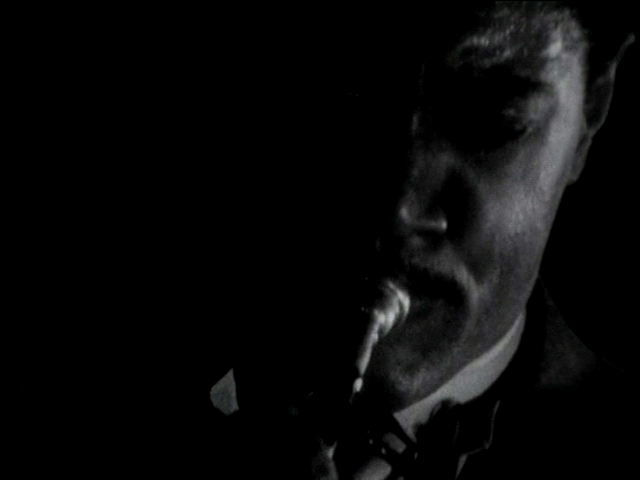
Hobart Dotson has to be one of the most obscure jazz musicians of all time. Born in Beloit, Wisconsin, on January 13, 1922, Dotson made his recording debut in 1945, when he appeared on four Gerald Wilson big band dates for Excelsior. He also did an AFRS Jubilee with Wilson that year, and a second Jubilee and a session for Black & White in 1946. An appearance with Wilbert Baranco on another Jubilee in March 1946 put Dotson together with Charles Mingus for the first time on record. Dotson then joined the last edition of Billy Eckstine's big band, where he played alongside King Kolax. By 1948, Dotson had relocated from Los Angeles to Chicago. He was a member of the Dukes of Swing when Sonny Blount was in charge of the book, appearing on their Aristocrat session. In 1949, he cut a session with pianist Johnny Perry for Rondo; legendary tenor saxophonist E. Parker McDougal was a featured soloist on the date. Alongside a vocalist named Joe Williams and a vibist named Hal Russell, he played in Jay Burkhart's legendary bebop orchestra, a band of as many as 21 pieces that got lots of favorable ink in Down Beat but never recorded. In the early 1950s, he made several records with a big band led by alto and tenor saxophonist Danny Belloc; he also played in Horace Henderson's legendary Trianon Ballroom band in the summer of 1954, alongside Porter Kilbert and Pat Patrick. In 1956, he contributed all four compositions for a date led by Billy Butler for the short-lived Verro label; Arkestrans Charles Davis and Julian Priester joined him in the band. And in 1957 he handled the arrangements for Porter Kilbert's Ping date. One wonders whether Dotson came to Budland with Porter Kilbert's band in August 1958 and that is how the collaboration began.
In the decade since the Dukes of Swing session, Hobart Dotson had amassed an impressive portfolio. He was a gifted composer and arranger who contributed Enlightenment to the Arkestra's repertoire. He had unsurpassed command of his instrument, playing its lowest and highest notes with absolutely no sense of strain. As a lead trumpeter, he would be sought out by leaders like Lionel Hampton, Charles Mingus, and Slide Hampton. What held Hobart back is that he could never eat up the chord changes like Freddie Hubbard or Lee Morgan. But Sunny was on his way past hard bop rhythmically; already well versed in modality and "space key," he was able to give Dotson his ideal musical environment.
We formerly listed a brief excerpt from a piano solo, which is repeated over and over in one scene from The Cry of Jazz, as a Ra performance (Sun 55). We have now identified this as a snippet from a performance by Eddie Higgins with the Paul Severson septet.
An October release datehas been set for "The Cry of Jazz," semi-documentary film using an interracial cast and Chicago scenes of Negro life, produced by KHTB PRODUCTIONS, Negro film group.
...
Producers Edward O. Bland, serious music composer, and Nelam L. Hill, housing analyst and writer, made the 33-minute 16 mm. film in six months. Collaborating with Mark Kennedy, author of The Pecking Order, on the script, they set out to examine the Negro's position and outlook in America using jazz as a spring board.
Although produced on a "shoestring" budget, the film project found many talents willing to lend service to it. Le Sun Ra and Paul Steverson [sic] composed and arranged musical background. Hank Starr, professional photographer, and Madeleine Tourtelot, art-film specialist, headed the technical crew. (p. 19)
KHTB stood for Kennedy, Hill, Titus, and Bland. Eugene Titus, Jr., a mathematician, was the fourth partner in the production.

The schedule slipped by a few months. On January 1, 1959, KHTB asked members of the Arkestra to sign a release giving permission to use their photos in the film. The film had taken so long to make, however, that some participants, like Art Hoyle and Julian Priester, were no longer in town and quite a few others were not working with the Arkestra. A copy of the release in the Alton Abraham papers does include the signatures of Sun Ra, Marshall Allen, John Gilmore, Pat Patrick, and trombonist Nate Pryor. A draft two-page contract for the use of the five titles previously recorded on Saturn, also in the Alton Abraham papers, is dated February 24, 1959; the signature page had lines for Ed Bland and Nelam Hill representing KHTB and "Herman S. Blount" and Alton Abraham representing Enterplan, the music publisher. The contract did not anticipate that The Cry of Jazz would be going into theatrical release or getting shown on television.
The Cry of Jazz premiered on April 3, 1959. It ran for a week, two showings a night, at the Lincoln Center (700 East Oakwood Boulevard). A single private showing followed on April 28, at the Union Nations Building in New York City. Another showing took place at the Sherman Hotel during a party for the Playboy Jazz Festival in July; still another at Gerri's Palm Tavern (446 East 47th Street) on August 23.One of the biggest and most talked of affairs ever held at Gerri['s] Palm Tavern... was the farewell party in honor of her son going back to college and the showing of the exciting film, "The Cry of Jazz." The affair was such a big success the patrons are requesting a repeat performance. (Chicago Defender, August 29, 1959, p. 14)
For an obscure, super-low-budget short film, The Cry got a lot of attention from the Defender—substantially more than Saturn Records could ever manage. Some of this was a function of the project's novelty. The South Side of Chicago had no tradition of independent film making, and the Defender's coverage of African American involvement in cinema focused almost exclusively on appearances in Hollywood movies by Dorothy Dandridge, Sidney Poitier, Eartha Kitt, and a few other nationally prominent performers.
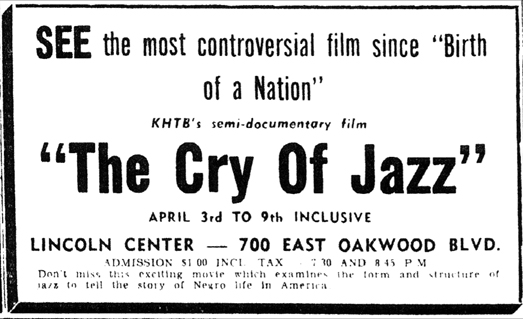
What did audience think of Ed Bland's message that jazz was already dead, fatally roped in by the white man's harmonic structures? Were they persudaded that repeated chord sequences stood for the "futureless future" that slavery and Jim Crow had imposed on black Americans? Or that when back people escaped the savagery with which they had been treated and could look forward to a productive and fulfilling future, they would no longer need jazz? Whatever its intended impact, the film would eventually become a legend among Ra fans. And despite their disagreements over the possibilities in store for jazz, Ra would benefit, during his New York years, from recording opportunities that Ed Bland steered his way.
The Cry of Jazz was not a documentary about the Arkestra, though the narrator refers to the "The Sun Ra" is an innovator in jazz, and "Call for All Demons" is presented as an example of his music. Rather, the Arkestra's function is to illustrate the stylistic evolution of jazz. Members of the band are shown on screen performing a Dixieland number (title uncertain), Swing (Bland stretched a little by choosing "Urnack" as an example), bop ("Super Blonde"), a Cool number ("Who, Me?" by Paul Severson), and "The Sun Ra." A quintet is shown playing "Blues at Midnight" (as an illustration of improvising over chord changes), and Sunny appears at the piano thrashing the same passage over and over (to illustrate the lack of growth potential in jazz; the passage, however, is exerpted from "Lela" by Eddie Higgins, from another Paul Severson album). During part of this scene the trombonist from the "Dixieland" band is also present, barely discernible in the murk. The film then shows flames about to consume slum tenements while a distorted fragment of the Dixieland music shrlls on the soundtrack. The Arkestra can be heard but not seen during another segment (playing "Demon's Lullaby").
The style of filming during the musical sequences—most of it dramatically dark—was chosen to obscure the fact that the same musicians were pretending to play all of the music. With the exception of John Gilmore and Ronnie Boykins during "Blues at Midnight," the musicians' entire faces are never on camera for long. Pat Patrick has already appeared as a Dixieland clarinetist, so when he takes a baritone sax solo on "Super Blonde" the audience gets to see just his fingers on the keys and his body from the chest down. (He does pop up with his baritone sax in another scene where his face is momentarily visible, but it is all over so quickly that casual viewers would never spot him.) Sunny is viewed from behind in every scene but one so he can't be identified as a regular participant. Because the soundtrack music was prerecorded and heavily edited, shots done on different nights with different personnel were rapidly intercut, though much of this trickeration would pass unnoticed by the audience. During most of a scene in which a quartet drawn from the Arkestra appears to be performing a Cool number (which the narrator has firmly defined as the white man's take on jazz; it is actually "Who, Me?" by Paul Serverson's quartet) the musicians are reduced to silhouettes. Could Sunny have drawn some inspiration from it when he decided on a title for his next Saturn LP?

Well in advance of its final exit from Budland, the Arkestra had found a new home base. The Queen's Mansion was a gay bar located at 6323 South Parkway. Its immediate predecessor on the premises had been the Surf Club, a bar and restaurant usually without a live music policy. But, as its proprietors and some of its patrons surely knew, from the early 1940s to the early 1950s the address had belonged to Joe's Deluxe Club, with its celebrated revue of female impersonators. The Mansion opened in late May or early June 1958, advertising two weeks in a row in the Chicago Defender just to let potential customers know that it was there. The club's original format called for a "jazz session" every Wednesday. (The weekly format was identical to the one employed at a slightly older establishment called Club Baby Grand. We don't know whether there was any ownership or management connection between the two.) In a most unusual occurrence since Alton Abraham sorted out priorities at the Vincennes Lounge, Sun Ra was not always billed as the leader at the Mansion; sometimes Hobart Dotson's name was used instead. Once the Arkestra settled in, we presume that the number of nights per week went up, though we have no details to report. We do know from Alvin Fielder's recollections that the band remained at the Mansion through the spring of 1959. The Mansion was evidently non-Union; there is nary a reference to it in the Local 208 contract lists from 1958 and 1959.
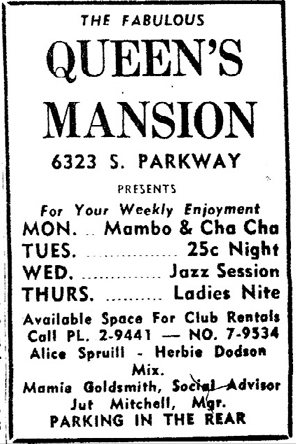
Collective personnel: Sun Ra (p); Hobart Dotson (tp); Lucious Randolph (tp); Bill Fielder (tp); E. J. Turner (tp); Bo Bailey [Larry Pickens] (tb); Nate Pryor (tb); Marshall Allen (as, fl, perc); James Spaulding (as, fl, perc); John Gilmore (ts, cl, perc); Pat Patrick (bars, perc); Ronnie Boykins (b); Victor Sproles (b); Richard Evans (b); Alvin Fielder (d); Clyde Williams (voc).
Queen's Mansion, Chicago, late 1958 through early 1959
| unidentified titles | Saturn (unissued) |
Alvin Fielder recalls extensive recording activity over several months or more while the Arkestra was playing at the Queen's Mansion. The personnel list is based on Fielder's recollections. He says that Boykins was the regular bass player, Sproles was used when Boykins was not available, and Richard Evans played “5 or 6 times” with this band. Dotson was on most of the jobs, Lucious Randolph “sometimes,” Bill Fielder and E. J. Turner “seldom.” Bo Bailey was the trombonist “most of the time” and Nate Pryor was there “some of the time”; the band hardly ever used two trombonists on a given night. A vocalist named Clyde “that used to work at the C&C Lounge” (i.e., Clyde Williams, who had been Sunny's male vocalist in 1956-1957) was with them “on a couple of occasions.” Jim Herndon does not figure in Fielder's recollections; he remained in town, but had taken up work that paid more reliably.
Sun Ra was in the habit of recording rehearsals and club dates, but most of these tapes have been long since reused, lost or discarded. Alton Abraham never confirmed or denied whether any tapes from these engagements survive.
According to Alvin Fielder, the repertoire for these engagements was primarily drawn from Jazz in Silhouette (see below) “with other tunes thrown in that might have been played only once or twice then put away.”
Early in 1959, Ra and Abraham decided that he had a band special enough to justify the expense of another studio recording. On March 6, a marathon session took place that eventually produced two LPs for Saturn, plus a cut that appeared on a third. The sessions were placed in 1958 in the past, but the exact session date is on the original tape box. The Jazz in Silhouette session was neatly bracketed between John Coltrane's semi-legendary meeting with Sun Ra, which took place in early February, and the second session for Miles Davis's Kind of Blue album, which took place in April.
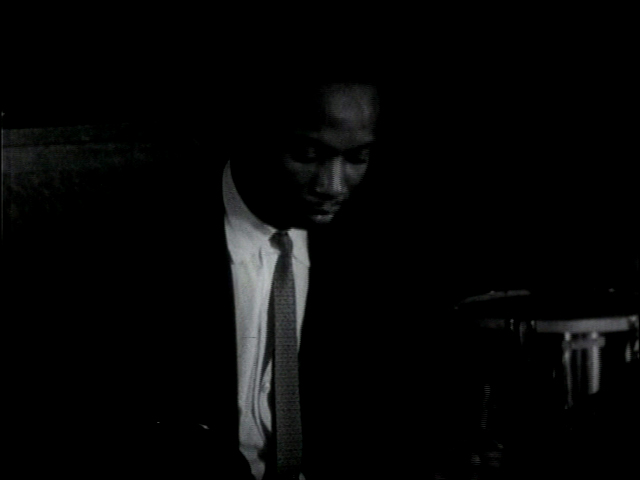
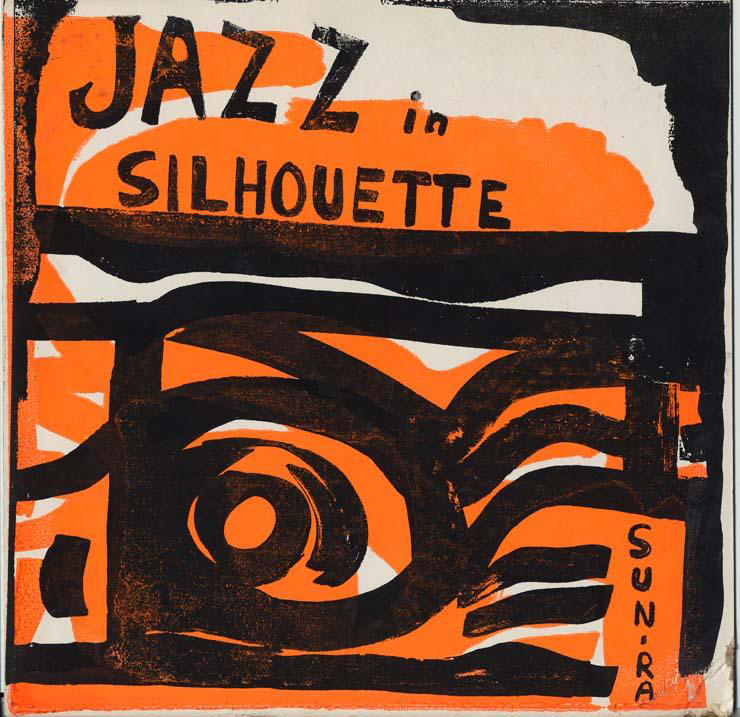

Le Sun Ra (celeste -1, gong -3, Wurlitzer ep -5, p); Hobart Dotson (tp mouthpiece -3, tp); Bo Bailey [Larry Pickens] (tb -2); James Spaulding (as, fl, perc); Marshall Allen (as mouthpiece -3, as, fl, perc); John Gilmore (ts, perc, voc); Pat Patrick (bars, fl, perc); Charles Davis (bars, perc); Ronnie Boykins (b, voc); William Cochran (d); Hattie Randolph (voc -4).
Studio recording, Chicago, March 6, 1959
| Hours After (Turner) -2 | Saturn K7OP3590/1, Saturn 5786, Impulse ASD 9265, Evidence 22012 [CD] | ||
| Horoscope (Ra) -2 | Saturn K7OP3590/1, Saturn 5786, Impulse ASD 9265, Evidence 22012 [CD] | ||
| Images (Ra) | Saturn K7OP3590/1, Saturn 5786, Impulse ASD 9265, Evidence 22012 [CD] | ||
| Blues at Midnight (Ra) -1 | Saturn K7OP3590/1, Saturn 5786, Impulse ASD 9265, Evidence 22012 [CD] | ||
| Enlightenment (Dotson) -2 | Saturn K7OP3590/1, Saturn 5786, Saturn SR 512, Impulse ASD 9265, Evidence 22012 [CD], Evidence 22014 [CD], Paddle Wheel [J] KICJ 315, Evidence 22219 [CD} | ||
| Saturn (Ra) | Saturn K7OP3590/1, Saturn 5786, Impulse ASD 9265, Evidence 22012 [CD] | ||
| Velvet (Ra) -2 | Saturn K7OP3590/1, Saturn 5786, Impulse ASD 9265, Evidence 22012 [CD] | ||
| Ancient Aeithopia (Ra) -3 [JG, RB voc] | Saturn K7OP3590/1, Saturn 5786, Impulse ASD 9265, Evidence 22012 [CD] | ||
| 'Round Midnight (Hanighen-Monk-Williams) -3 | Saturn (unknown), Saturn SR 512, Evidence 22014 [CD] | ||
| You Never Told Me that You Care (Dotson) | Saturn SR 512, Evidence 22014 [CD] | ||
| Hour of Parting (Schiffer-Spoliansky) | Saturn SR 512, Evidence 22014 [CD] | ||
| Back in Your Own Back Yard (Jolson-Rose-Dreyer) -1, 3 | Saturn (unknown), Saturn SR 512, Saturn XI, Evidence 22014 [CD] | ||
| I Could Have Danced All Night (Lerner-Loewe) | Saturn SR 512, Evidence 22014 [CD] | ||
| Interstellar Low Ways (Ra) -3 | Saturn SR 9956-2-M/N, Evidence 22039 [CD] | ||
| Spontaneous Simplicity (Ra) -5 | Saturn K8OP-2864-1 (unreleased test pressing), Saturn K8OP-2864-2 (unreleased test pressing) | ||
| Ankhaton [sic] (Ra) -2 | Saturn K8OP-2864-1 (unreleased test pressing), Saturn K8OP-2864-2 (unreleased test pressing) |
Jazz in Silhouette was originally issued in May of 1959 on Saturn K7OP3590/K7OP3591, identified by matrix numbers only. The release was announced by implication in a blurb in the daily Chicago Defender, June 9, 1959 ("Sun Ra Discs Hit Album," p. 19): two Saturn LPs were mentioned in the piece and neither was named. Our thanks go to doo-wop discographer Robert Ferlingere for a tutorial on the mysteries of the RCA Victor matrix number system (these are seen on many Saturns from the period that used RCA Victor's Custom Pressing services). The prefix K7OP indicates a 1959 release, not late 1958 as we and others had previously stated. The actual recording date, March 6, 1959, was on the original tape box. The tape box confirmed something long suspected—that the tracks on Sound Sun Pleasure!! were done at the same session. It also revealed three tracks that had not been suspected, the released "Interstellar Low Ways" and the earliest known, unreleased versions of "Spontaneous Simplicity" and "Ankhnaton."
Jazz in Silhouette originally had a silk-screened or serigraphed cover, with an abstract design and the title (copies can be seen in Geerken and Hefele's Omniverse Sun Ra, in Pathways to Unknown Worlds, p. 46, and in Art on Saturn). Colors vary as reproduced, from pinkish red and black to golden brown and black; it's not clear to what extent the differences are due to ageing, or to the that way the photos were taken and processed. The silk-screen design was credited to H. P. Corbissero, whose name never did turn up amongst the Afro-futurist artists on the South Side. Some thought that the H. P. stood for Herman Poole, but Sunny had made no other known use of those initials.
In 2025, Dan Kiss, a friend of the Corbissero family, suggested (email communication, April 15, 2025) that the artist was Harry Paul Corbissero of Ashtabula, Ohio.
On May 1, Harry Corbissero graciously responded by email to a letter from Robert Campbell that inquired about Jazz in Silhouette and enclosed a small printed copy of the cover art. The story is best told in his own words:
For a period of time, I lived in an apartment adjacent [to] his in a building on Chicago's South Side. Curiously, I still remember the address: 5414 South Prairie. At the time I was an art student at the Chicago Art Institute, and in an interracial relationship.
The thing I most remember about Sun Ra is that he practiced all the time, both day and night. The walls of the apartment were paper-thin, so there was no avoiding this notice. I really didn't pay it much attention. There were three apartments on this floor, and we shared a single bathroom. He was a very private person, but we were bound to have had a casual acquaintance.
He often practiced with others; a sax player most often. These details are really fuzzy. He must have told me about his group and I must have told him I was an art student. I didn't understand his music. I was into blues (which abounded there in that era.)
I can't remember exactly how it was I came to do the album cover for him, but it had not been my own first choice.
I had thought of a possible title (which I liked): When Sun Comes out - and I believe made a design based on this image. This didn't fit his own idea, so, facing a deadline, he accepted the rather rough or crude "daub" I created more or less on the spot (as depicted.) I got a copy of the record as my gratuity, which I gave to a friend back home.
I don't remember actually saying good-by to Sun Ra when I moved to the Near North [Side] after about two years when my relationship came to an end. We really had no more intervening involvement over that duration, that I remember.
My impression now is that he was a man who pursued his music with what I can only describe as a spiritual ardor. He seemed akin to a monk in his cell, somewhat isolated from the world outside and driven by singlemindedness.
I suppose this may be construed as a herald of genius.


Corbissero does not recall attending performances by the Arkestra or meeting Alton Abraham. Later in 1959 or in 1960, Corbissero moved to an address on Clark Street. In 1961, when Abraham ordered the second pressing run on the LP (see below), Sunny had left Chicago for good, and Corbissero had probably also done so. Corbissero's cover was replaced with a new one done by one of the artists in Abraham's circle. The second and later pressings also carried elaborate notes on the back of the LP.
Harry Paul Corbissero returned to his home town (Ashtabula, Ohio) where he pursued his art for many years, first painting, then photo collages. There has never been a website dedicated to his art, so with his permission we have placed two reproductions of his paintings here. Above and to the left: "The Avenging Angels." Above and to the right: a self-portrait. Corbissero wrote columns for a local newspaper, and worked as a life skills trainer, finally retiring at age 80. Such activities did not bring him into contact with anyone from the Ra-o-sphere. Though he had not discussed such matters with Sun Ra, Corbissero over time developed some thoughts of his own regarding destiny, the soul dimension, and the earth plane. Any partial resemblance to Ra's thinking he attributes to synchronicity.
Even though Sunny didn't want to use When Sun Comes Out as the title for his second LP on Saturn, he kept it in reserve. Ra and Abraham had cover art prepared for at least two prospective LPs to be called When Sun Comes Out, but like several others that were planned between 1959 and 1963, they did not materialize. Finally the title would be given to a 1963 release of tracks recorded in New York City during the previous year.

The second pressing run from RCA Victor amounted to 300 copies at 33 cents an LP, in an order dated October 28, 1961. The album was given the new serial number LP 5786 (first seen on a receipt from K. O. Asher Distributors, which took 10 copies of Saturn #5786 on consignment, November 15, 1961; the RCA order and the Asher receipt are both in the Alton Abraham Collection, Box 16 Folder 9). The new cover by Evans (not Richard Evans, the bassist) showed three half-naked women teleporting themselves over one of the moons of Saturn. (Compare the cover of Esquivel's “Other Voices, Other Worlds,” released on RCA Victor in 1958.)
The original Side A (matrix K7OP3590) consisted of “Hours After” through “Blues at Midnight” and Side B (matrix K7OP3591) of “Enlightenment” through “Ancient Aeithopia”; on all later issues, the sides are reversed. In 1967, this LP was given the catalog number 205. All tracks were reissued in 1974 on Impulse ASD 9265 (though Impulse faded the theme statement at the end of “Blues at Midnight”) and in 1992 on Evidence 22012 [CD]. Although the session was recorded in stereo, all issues except the Evidence CD are in mono! “Enlightenment” also appeared in 1970 on Saturn SR 512, Sound Sun Pleasure!! in a different stereo mix of the same take (thanks to Mike Fitzgerald for discovering this) and was reissued in that form in 1992 on Evidence 22014 [CD]. “Enlightenment,” in the mix that was included on Jazz in Silhouette, was also reissued in a 1997 Sun Ra CD sampler on Japanese Paddle Wheel KICJ 315, Sun Ra Came Down to the Earth, and on Evidence 22219, Greatest Hits: Easy Listening for Intergalactic Travel, in September 2000.
The 1961 Saturn press release mentions “Saturn” and “Velvet” as appearing on singles. It is possible that those two titles from this session were also released as a single; in fact, the version of “Saturn” from this album was included in a set of master tapes of singles by Alton Abraham. No pressing of such a single has been located, however. A single with a different version of “Velvet” (for instance, the October 1956 recording) is also possible.
Nate Pryor (who was supposed to be on this session but arrived too late) recalls that the studio was located off the Outer Drive, somewhere near Grand Avenue. Alton Abraham said that RCA Victor Studios and a studio with that he called “Balladine” (i.e., Balkan) were used for Saturn sessions. Bill Fielder said that Bo Bailey was on this session, not Julian Priester as stated on the Impulse issue. The incorrect listing could have come about because Bo Bailey, to use Pryor's words, “wasn't straight with the Union,”. The original Defender blurb proclaimed that "Twelve [sic] musicians are featured on these most progressive jazz recordings," then proceeded to list the correct personnel for this session... except that Nate Pryor was said to be playing trombone.
Our thanks to Allan Chase for recognizing the role of the mouthpieces in “Ancient Aeithopia.” The wordless vocal during this same piece includes John Gilmore and Ronnie Boykins but the most prominent voice belongs to another Arkestra member. Allan Chase's master's thesis should be consulted for a more detailed analysis of the scoring on each piece from this session (except the three that weren't known to be from it till more recently).
Sun Ra copyrighted “Images (A Suite Potential) ” on April 7, 1959; this included his other originals from the session. "Enlightment: A Suite of Sounds in Two Movements" was copyrighted by Hobart Dotson and Sun Ra on the same day. As copyrighted, it consisted of “Enlightment” (Sun Ra's intended spelling) and “You Never Told Me that You Care.” Both had music by Hobart Dotson and words by Sun Ra; Dotson seems to have been the copyist (James Wolf). According to Lucious Randolph, “You Never Told Me that You Care” was wholly written and arranged by Hobart Dotson. "Enlightment" as copyrighted has somewhat different lyrics from those that the Arkestra performed and recorded from the 1960s onward; "You Never Told Me" was never recorded with words.
Alton Abraham said that “'Round Midnight” and “Back in Your Own Backyard” were initially released on a Saturn single; no copies have been located, however. The mastering, pressing, and shipping paperwork would presumably have come from RCA Victor, but we have not found any in the Alton Abraham Collection.
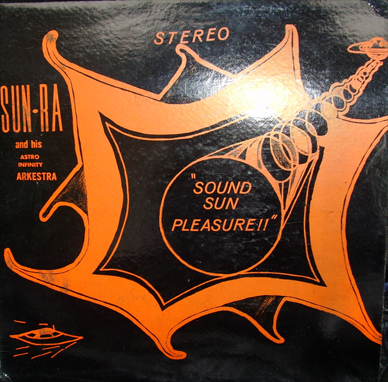
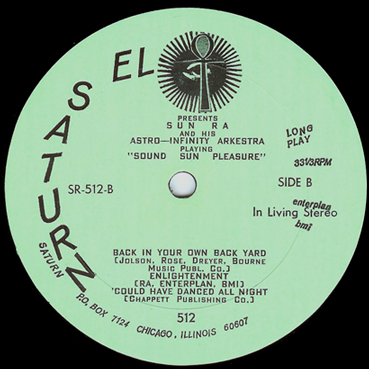
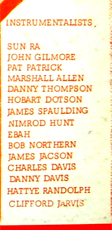 Otherwise, the standards from this session were held back from
release until they appeared on the Sound Sun Pleasure!! LP
(Saturn SR 512) in 1970. All tracks from that LP were reissued in
1992 on Evidence 22014 [CD]. “Back in Your Own
Backyard” was also reissued in 1983 on the Saturn anthology LP,
Just Friends (Saturn XI). “'Round Midnight” is
included in the 1997 Japanese Sun Ra CD sampler, Sun Ra Came Down
to the Earth, on Paddle Wheel KICJ 315, and on Evidence 22219,
Greatest Hits: Easy Listening for Intergalactic Travel, in
September 2000.
Otherwise, the standards from this session were held back from
release until they appeared on the Sound Sun Pleasure!! LP
(Saturn SR 512) in 1970. All tracks from that LP were reissued in
1992 on Evidence 22014 [CD]. “Back in Your Own
Backyard” was also reissued in 1983 on the Saturn anthology LP,
Just Friends (Saturn XI). “'Round Midnight” is
included in the 1997 Japanese Sun Ra CD sampler, Sun Ra Came Down
to the Earth, on Paddle Wheel KICJ 315, and on Evidence 22219,
Greatest Hits: Easy Listening for Intergalactic Travel, in
September 2000.
The personnel list for Sound Sun Pleasure!! was a ball of confusion: 15 performers were listed on the back liner. Some were really on the session; others were nowhere near it, but were active in the Arkestra during the late 1960s. Among those who actually participated, we may count Ra, Gilmore, Patrick, Allen, Dotson, Spaulding, Charles Davis, and Hattye Randolph (as her name is consistently spelled on Saturn LPs). Danny Thompson, Nimrod Hunt, Akh Tal Ebah, Bob Northern, Danny Davis, and Clifford Jarvis did not join the Arkestra till after Sun Ra moved to New York.
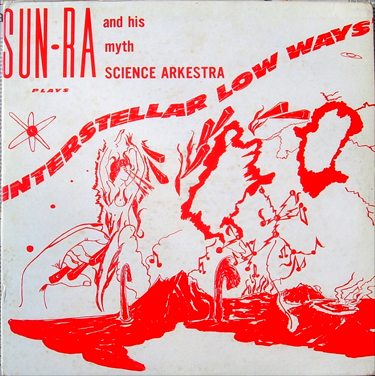

“Interstellar Low Ways” was released in 1966 or 1967 on Saturn SR 9956-2-M/N, Rocket Number Nine Take off for the Planet Venus. Plans were made to use a cover by Claude Dangerfield that featured a Sun Ra logo with a burning candle sticking out of it; the cover art was preserved among Alton Abraham's holdings, and shown in the Saturn catalogue from that year, but no LPs with that cover have been found. In 1967, this LP was given the catalog number 203; in 1969 it appeared as Interstellar Low Ways with a red and white cover, also by Claude Dangerfield, that featured musical golems and lots of volcanic activity. (Whether there was an earlier release under the “Rocket” title with the same red and white cover remains to be resolved.) All tracks from the album reissued in 1992 on Evidence 22039 [CD]. William Cochran is listed as a drummer on the later Saturn issue, and is not known to be on any of the other tracks that were released on it.
Pat Patrick was credited on the Saturn jacket with playing flute on "Interstellar Low Ways." Although Pat was on the session, so was James Spaulding, and he is much more likely to have drawn the second flute assignment while he was in the Arkestra. The chimes attributed to Sun Ra and the bells and claves credited to Pat Patrick on the Saturn jacket were probably played by other Arkestra members.
Two more tracks were listed on the tape box from this session: "Spontaneous Simplicity" and "Ankhaton" [sic]. "Spontaneous Simplicity" was a short piece featuring Ra's Wurlitzer electric piano (not otherwise employed on the session) and Marshall Allen's flute, along Ronnie Boykins' bass and lots of percussion. "Ankhaton" (the title would later be adjusted "Ankhnaton") included solos by Marshall Allen on flute, Charles Davis on baritone sax, James Spaulding on alto sax, John Gilmore on tenor sax, Hobart Dotson on trumpet, Ronnie Boykins on bass, Bo Bailey on trombone, and Sunny on piano. "Ankhaton" may have been left off Jazz in Silhouette because the string of solos format was already employed on "Blues at Midnight."
Both tracks were considered for inclusion in another Saturn LP, tentatively titled "Ankhaton," that was intended to follow Jazz in Silhouette. Two test pressings made by RCA Victor have turned up. These were made in 1959 and appear to be two different versions of one LP side. On both K8OP-2864-1 and 2864-2, "Ankhaton" and "Spontaneous Simplicity" are the first two tracks; the pressings differ in their choice of the next 3 tracks, all of which derived from rehearsal sessions later used on The Nubians of Plutonia.
It is to be hoped that master tapes can be found for "Ankhaton" and "Spontaneous Simplicity," as the test pressings have not been treated well over the years and are barely playable.
Jazz in Silhouette carefully balances the old and the new. Let's start with the number that originally opened the album. Hours After was actually written by Everett Turner, and there's an earlier recording of it with Turner taking the trumpet solo; all Ra contributed was the more decorous title (Turner called it Stinkin'), and some words that are not on any known recording. It's often considered to be a soul-funk number a la Horace Silver.
Horace Silver, huh? Try Erskine Hawkins. The album went on to include a Blues at Midnight, the Dameronian Images, another Saturn, and Sun Ra's take on hard bop shows up again in numbers like Velvet.
But Sunny was incorporating more and more of Africa into the band's playing. Ancient Ethiopia was an Afrocentric point of reference for Sunny; he wrote a processional to commemorate it, normally a 4 or 5-minute piece performed with lots of percussion and maybe a flute solo. On this occasion Jim Herndon wasn't available, and the percussion couldn't be quite as heavy as usual. No matter. He had special plans on this occasion.
Ra dreamed of rebuilding his brass section around Dotson and trombonist Bo Bailey, but it wasn't to be. For one thing, Dotson was an addict; he had given up the needle but swallowed down cough syrup every day. Band members helped hide his consumption from the leader, but this couldn't have gone on forever. (Ra was a rather abstemious sort. Some believe he took a vow of celibacy when he became Sun Ra. In any case he disapproved of drink, beyond an occasional glass of wine with dinner, and regularly lectured his band members against using drugs.)
Besides, Sunny's priority was for the band to get work, whether it paid well or not. Throughout its history, the Arkestra had plenty of gigs but the musicians were always broke (there was one exception — in the early New York years, there were no gigs either). Except for Marshall Allen, all of the musicians took outside work, and for Dotson, the lure of a road trip with B. B. King was too great. B. B. King played Roberts Show Lounge during the first half of June 1959. So no sooner was Jazz in Silhouette released than its trumpet soloist found a new band.
Dotson moved to New York, where he recorded with Charles Mingus in 1960, was a regular member of Slide Hampton's band from 1960 through 1962, and made two more sessions with Mingus in 1965. His bread-and-butter gig for the next several years was in Lionel Hampton's band, but he did not appear on any known recording sessisons with Hamp. Hobart Dotson died in Brooklyn, New York, on January 1, 1971, at the age of 48. As for Jazz in Silhouette, it didn't get one single review in the jazz press. Its importance wasn't understood until it was reissued by Impulse 15 years later.
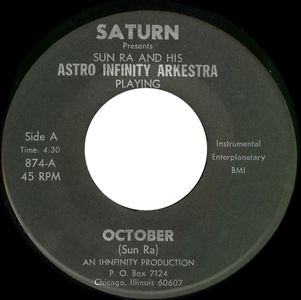
Sun Ra (p); Walter Strickland (tp); unidentified (tb); John Gilmore (ts); Pat Patrick (bars); Ronnie Boykins (b); poss. William Cochran (d).
Rehearsal, Chicago, 1959
| October (Ra) | Saturn 874-A, Evidence 22164 [CD] |
One of Ra's most striking compositions from the Chicago period, "October" was recorded at a rehearsal. It was first issued around 1968 on Saturn 874, a 45 rpm single. It was reissued on The Singles, Evidence 22164 [2 CDs], in September 1996. The label (white print on black) refers to Inhfinity Incorporated, which wasn't launched until 1967.
"October" features a fairly ordinary ballad lead, played on the trumpet, over a three-note figure consisting of the lowest notes of the tenor sax, baritone sax, and trombone. The arrangement alternates the pedal tones with lush harmonies for the three horns. Phil Cohran said he was not on this recording; his first guess was Walter Strickland. Nate Pryor doesn't remember making anything like this; he says that Ra would use Bo Bailey or Eddie King when he wasn't available. There is no alto sax in the ensemble; during the lushly scored passages that contrast with the pedal tones, John Gilmore plays in his upper register.
Sunny and Alton hoped that Jazz in Silhouette would make the Arkestra famous. Instead, it became the great unknown jazz LP. And no sooner did Sunny release the album than the band that made it fell apart. Losing Hobart Dotson was just the beginning. Hattie Randolph moved to Canada, and the sax section thinned out. By the time the album was released, Charles Davis had permanently resettled in New York.

More unsettlingly for Sunny, Pat Patrick was getting restless. On June 4, he posted a contract with Gerri's Palm Tavern, for two weeks with options. At this point in its life cycle, the Palm Tavern wasn't programming much live music, and it's doubtful that the options were exercised. One wonders whether Pat helped to talk the owner into screening The Cry of Jazz. Then in mid-October, Patrick landed a spot in a group led by drummer Marshall Thompson that played every Thursday night for two months at the New C&C Club & Lounge (6513 Cottage Grove; Thompson's contract was belatedly filed on November 19). Just before Christmas, as Thompson's enagement wound down, James Moody finished two weeks at the Sutherland Hotel Lounge. Patrick joined Moody's band and hit the road for New York City.
Meanwhile, James Spaulding was picking up studio work for Chess and Vee-Jay, where arrangers like Riley Hampton needed flute players. On December 3, 1959, he filed an indefinite contract with a Near North Side club called the French Poodle. He next moved to the Lake Meadows Restaurant (contract for 2 weeks and 3 days filed on December 17). Spaulding would continue to work in the clubs for at least another year, returning to the French Poodle in September and December 1960. The next year, he went back home to Naptown. When he relocated again, it would be to New York City.
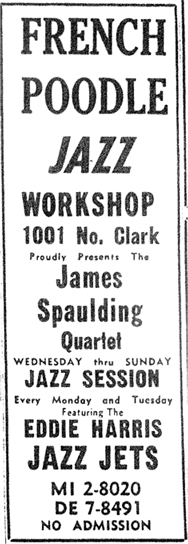
Lucious Randolph had not left the band, but he was becoming less available as he picked up more work with other leaders—for instance, with Andrew Hill's band on weekends at Roberts Show Lounge (as we learn from the Local 208 Board meeting minutes of May 21, 1959). Eventually he would take a day job at the post office. Everett Turner left town, and Bill Fielder would soon be making his own move to New York, where he and Pat Patrick shared a hotel room for a time. Bugs Cochran was busy playing for other leaders, and Robert Barry was seldom available. Sunny was perilously close to what he'd never much cared for: a combo.
Those who saw the band perform in the 1970s and 1980s have a standard image of an Arkestra performance. The glittering (though inexpensive) costumes worn by the musicians. Sunny's grand entrance. His otherworldly electronic keyboards. His sermons to benighted Earthlings. The Fletcher Henderson numbers, complete with repertory solos. A blues feature for Sunny's piano. At least one outside number with falsetto tenor sax, frenetic alto, berserk bass clarinet. Dancers. Maybe a light show. And those ditties about outer space.
If we could go back and witness a concert in Chicago (the best we can do is catch a few snippets in The Cry of Jazz), we would find some parts familiar, other parts less so. The lineup then was mostly Ra compositions, plus a few standards, heavily reharmonized. No high-pressure altissimo, no low rumbles from the saxes —they didn't acquire those techniques till after they moved to New York.
There were no Fletcher Henderson charts; Sunny hadn't performed any since 1947. With his usual perversity, Sunny waited until 1966 to make transcriptions for the Arkestra. His motivation was outrage at looking in a store window and seeing a new boxed LP set of Fletcher titled A Study in Frustration. So he began to sneak in King Porter Stomp or Limehouse Blues after a twenty minute free improvisation! The Henderson scores didn't become nightly staples till the mid-1970s. There were plenty of blues in the 1950s, but these were cool and bop-oriented as a rule. The rolling Chicago blues feature didn't enter the Arkestra's repertoire till 1977. Electronics were in their infancy — Sunny had his Wurlitzer electric piano and, once in a while, an organ, but no really strange sounds and no heavy amplification.
Probably the first thing you'd notice was Sunny's lack of stage presence. The 1955 photos from the Parkway Ballroom show him in his customary position — seated in the back of the Arkestra. (On smaller stages he would sit at front left or front right.) Sunny was writing poetry and pamphlets in those days, and the Sun Ra philosophy was already well developed. John Gilmore and Marshall Allen would even hand out Sunny's newsletters on street corners, though interviews indicate that most of the Arkestra musicians were nonbelievers. But Sunny didn't sing or preach to his paying audience until 1970. In fact, he didn't say much to the audience at all. His barely audible call of Sound of Joy and a couple of very quiet tune announcements for alternate takes from the session for Jazz by Sun Ra are the only recordings of his voice on Chicago-period items intended for release.
Costumes, on the other hand, were already in evidence. In The Cry of Jazz, band members are seen wearing dark suits in some scenes and white suits in others, but the filmmakers wouldn't have wanted Dixieland and Swing numbers performed by Arkestrans in tunics and sequined headdresses. Glitzier garb soon became the norm. According to Marshall Allen, Sunny on one occasion obtained outfits that a local opera company had discarded after performing William Tell. No doubt these were the inspiration for the space-age Robin Hood costumes the band sometimes wore in later years. Art Hoyle remembered "loud green and orange concerns" in 1956. By 1960, Arkestra members were sporting purple blazers, white gloves, and beanies with propellers on top that lit up. And they would release wind-up toy robots into the audience. There were no dancers yet, but the musicians were supposed to jump up and down on designated numbers.
Sunny had been talking about outer space for a while, but in the early days his vocal numbers were meant to be performed by the cabaret-style singers who worked Chicago nightclubs, or by doo-wop groups. The space chant, a simple ditty that could be sung by band members (and the audience, if so inclined) didn't appear till 1960. Once he started writing them they stayed in the band's repertoire for years: Interplanetary Music, We Travel the Spaceways, Rocket Number Nine Take for the Planet Venus.
From his previous Arkestras, Sunny could call on John Gilmore, Marshall Allen, and Ronnie Boykins. Nate Pryor was still a part-time trombonist. New trumpeters and drummers were badly needed. But the leaner 1960 lineup had its compensations. John Gilmore was no longer a bebopper; he had new things to say on the tenor sax, and his clarinet was available to lighten the texture when required. He was also taking up the bass clarinet, though he did not feature it on recordings right away. Marshall Allen had grown steadily under Ra's guidance. Ronnie Boykins already had full command of the ostinato and the bow. Sunny had the good fortune to recruit Phil Cohran, already an experienced bop trumpeter and a student of Irish and African music. A well schooled master of rims and mallets, Jon Hardy, became the chief occupant of the drum chair. Sun Ra always liked to say his music was about "precision and discipline," even on nights when the ensembles were ragged, the percussion verged on indeterminate, and the band was deliberately playing flat. The 1960 Arkestra exhibited precision and discipline as the rest of us would understand these terms.
We'd like to be able to include a biography of Jon Hardy, but 60 years after he joined the Arkestra we still know virtually nothing about him.
About Phil Cohran, we can say something. Philip Thomas Cohran Jr. was born in Oxford, Mississippi on May 8, 1927. His parents moved to Saint Louis when he was in grade school. He played trumpet in blues and jazz bands and led a 12-piece ensemble, the Rajahs of Swing. When he joined the Arkestra he was a recent arrival in Chicago. (See Giovanni Russonello, "Musical innovator's creativity and activism invigorated Chicago," Honolulu Star-Advertiser, July 5, 2017, p. B-6).
Meanwhile John Gilmore had taken on an odd assignment as leader at the Kitty Kat Club, which had hired nothing but piano trios for years. What kind of band he led we don't know, because the Kitty Kat was in a slump and had quit buying ads in the Defender. We do know that while John's contract (posted on January 7) was of the indefinite variety, on January 21 the club posted a 6-week contract with pianist John Young, who had already played there countless times. The Kitty Kat's fortunes would revive later that year when the movie version of A Raisin in the Sun was released and the club could boast that scenes had been filmed there.

According to the Defender for March 12, 1960 (p. 12), John Gilmore was then at an establishment called the Hickory Pit, where Jo Jo Adams was putting on his last Jo Jo show, and the up and coming saxophonist was performing in Baby Face Willette's organ trio with Clover English on drums. The Pit was clearly a non-Union establishment; no contracts appeared on the Local 208 list. There were no further mentions of the Jo Jo show in the Defender, so the gig probably didn't last long.
The Arkestra's fortunes would revive as Alton Abraham bankrolled a major recording session in June, and the band settled into its first really steady gig since the Queen's Mansion days, at the Wonder Inn. Advertisements for the Wonder Inn were rare, so until recently we had no idea when the Arkestra began appearing at the establishment. However, in 2023 Brad Markus found a handbill promoting Wednesday night appearances by the band at the Wonder Inn from February 1960; it is in the Pat Patrick collection at the Northwestern University library. Pat Patrick was already in New York City at this time; most likely another member of the band sent it to him.
Sun Ra (cosmic tone org); Phil Cohran (violin-uke, voc); John Gilmore (cosmic bells, voc); Ronnie Boykins (b, voc); prob. William Cochran (d); prob. Marshall Allen (perc).
Rehearsal, Chicago, 1960
| Interplanetary Music (Ra) | Saturn HK 5445, Evidence 22038 [CD] |
"Interplanetary Music" was copyrighted on October 10, 1960, as part of a suite that also included "Africa" and "We Travel the Spaceways." Phil Cohran's violin-uke was misidentified on the Saturn jacket as a “space harp” (one of several "space harps" was Cohran's amplified thumb piano; Cohran called it a Frankiphone). This track was first issued on the LP We Travel the Spaceways (Saturn HK 5445) in 1967; it was given the catalog number 409 and may also have circulated as Saturn ESR 5445. All tracks from this album reissued on Evidence 22038 [CD] in 1992.
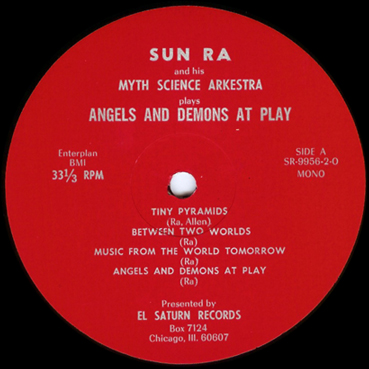
Sun Ra (cosmic tone org); Ronnie Boykins (b); Phil Cohran (violin-uke); Jon Hardy (d).
Rehearsal, Chicago, 1960
| Music from the World Tomorrow (Ra) | Saturn SR 9956-2-O/P, Impulse AS-9245, Evidence 22066 [CD] |
All tracks with Phil Cohran's violin-uke must date from 1960 or 1961; he purchased the instrument on January 22, 1960. Cohran identified Hardy as the drummer on this track. The track was first issued in 1965 on side A of Saturn SR 9956-2-O/P, Angels and Demons at Play. In 1967 this LP was given the catalog number 407. All titles from the LP were reissued on Impulse AS 9245 in 1974 and on Evidence 22066 [CD] in 1993.
Sun Ra (p); Phil Cohran (tp); Marshall Allen (as); John Gilmore (ts); Ronald Wilson (bars); Ronnie Boykins (b); Jon Hardy (d).
Rehearsal, Chicago, 1960
| Tapestry from an Asteroid (Ra) | Saturn HK 5445, Evidence 22038 [CD] |
Phil Cohran confirmed his presence here and said the piece was written for him. Pat Patrick was in New York in 1960; Cohran said that the full sound indicates that Ronald Wilson was probably present on baritone sax, and that Jon Hardy was the drummer. A similar arrangement of “Tapestry” was recorded during the “Majestic Hall” session, with Wilson on baritone and Gene Easton added on alto sax.
"Tapestry from an Asteroid" was not copyrighted until November 14, 1961, after the Arkestra laid down another version during its first New York-area studio session.
This track was first issued on the LP We Travel the Spaceways (Saturn HK 5445) in 1967; it was given the catalog number 409 and may also have circulated as Saturn ESR 5445. All tracks from this album were reissued on Evidence 22038 [CD] in 1992.
Sun Ra (p); poss. Bo Bailey (tb); John Gilmore (ts); Marshall Allen (as); Ronnie Boykins (b); poss. Robert Barry (d); unidentified (wood blocks).
Rehearsal, Chicago, 1960
| Between Two Worlds (Ra) | Saturn SR 9956-2-O/P, Impulse AS-9245, Evidence 22066 [CD] |
The trombonist is definitely not Nate Pryor; Ra used Bo Bailey or Eddie King when Pryor wasn't available. Ra also used John Avant on rare occasions, though it is not known whether he was still doing so at this time. Dick Griffin has said that he played with Sun Ra in 1961, but this track may be too early for him. It was first issued in 1965 on side A of Saturn SR 9956-2-O/P, Angels and Demons at Play. In 1967 this LP was given the catalog number 407. All titles from were reissued on Impulse AS 9245 in 1974 and on Evidence 22066 [CD] in 1993.
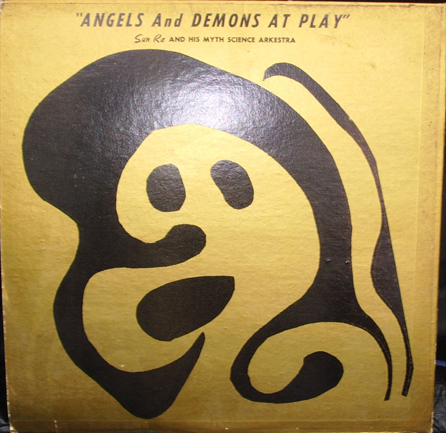
The Qualities: unidentified male vocal quartet, with Sun Ra (harmonium); unidentified (g -1); unidentified (bells); unidentified (wood blocks).
Rehearsal, Chicago, 1960 or 1961 (?)
| MO8W-4052 | Happy New Year to You! (Abraham-Ra) | Satur M08W4052/3, Evidence 22164 [CD], Norton CED-353 | |
| MO8W-4053 | It's Christmas Time (Abraham-Ra) | Satur M08W4052/3, Evidence 22164 [CD], Norton CED-352 | |
| tk. 2 | If I Only Hadn't Sinned | Norton CED-352 | |
| tk. 4 | She's My Moonglow | Norton CED-353 |
Satur M08W4052/M08W4053 was a 45 rpm single, produced by Alton Abraham and Sun Ra. The matrix numbers attached to the master at the RCA Victor pressing plant indicate the year the record was pressed (M was the RCA Victor code for 1961, just as L was the code for 1960, etc.) It had a lemonyellow label, with “Satur” in red script down the left side, in the same typeface that had been used on the first pressing of Jazz in Silhouette. Satur is not a typo; the “Satur” logo appears on both sides of the single, along with “Satur Records presents the Qualities” across the top. On a copy preserved in the Alton Abraham Collection (Box 66), the matrix numbers M-08W-4052-1 and M-08W-4053-1 are stamped in the trailoff area, indicating the records were pressed by RCA Victor. An order was placed with RCA Victor, resulting in bills for tape transfers and mastering, for pressing 99 copies (December 6, 1961), and for pressing another 200 (December 12).
Jerry Gordon has confirmed that it was mastered at RCA Studios in Chicago; the tape box reads “Happy New Year to Year.” “It's Christmas Time” is announced as take 2 on the master tape; other takes do not seem to survive. Alton Abraham stated that this single was made a year or so later than the Cosmic Rays recordings; this would imply that it was recorded in 1960. Because of the ad hoc instrumentation, John Gilmore believed that it was a group rehearsal held separately from the Arkestra rehearsals. Both tracks were reissued in September 1996, on the 2-CD set (Evidence 22164) called The Singles.
In his notes to the Norton CDs, Michael Anderson places the Qualities session all the way back on November 17, 1956. If this is so, the two holiday numbers had to wait five years to see release. The other two tracks—"She's My Moonglow" and the brilliant "If I Hadn't Sinned"—had to wait half a century before they saw release, on Norton CED-352, Sun Ra: Interplanetary Melodies, and Norton CED-353, Sun Ra: The Second Stop Is Jupiter.
In fact, Alton Abraham prepared a Satur's Sponsor's Agreement, which shows the old Saturn Records address at 4115 South Drexel but also has the new address at PO Box 7124, Chicago 7, Illinois penciled in (for this and the RCA Victor paperwork, see the Alton Abraham Collection, Box 16 Folder 9). We do not know whether the drafting was followed by any actual mailings.
Sun Ra (p); Phil Cohran (cnt); Marshall Allen (fl -2, as); John Gilmore (ts); Ronnie Boykins (b); poss. Robert Barry (d).
Chicago, 1960
| Big City Blues (Ra) | Transparency 0316 [CD, Disk 12] | ||
| Mr. Lucky (Mancini) [identified as Delilah on the Transparency release] |
Transparency 0316 [CD, Disk 12] | ||
| Velvet (Ra) -2 | Transparency 0316 [CD, Disk 12] |
These three tracks were released for the first time in 2011 on Michael Anderson's compilation, The Eternal Myth Revealed Volume 1 (Transparency 0316, a 14-CD set).
Anderson gives the date as March 18, 1956 and the location as Budland. But the group is audibly a later, smaller edition of the Arkestra, and Anderson identifies Phil Cohran, Marshall Allen, and Ronnie Boykins as participants. The front line is definitely Cohran, Allen, and Gilmore; note the head to "Big City Blues" and the frenzied colloquies on "Velvet." Boykins can be heard bowing at the end of the second track (which we have now learned is "Mr. Lucky"; see below), and solos on "Velvet." Anderson puts James Spaulding on the date, but he is not present. Anderson identifies Robert Barry as the drummer, which is possible, but Jon Hardy is more likely.
This is in fact a live recording of the 1960 Arkestra at an unknown location. The Wonder Inn is a distinct possiblity (see below). A remoter possiblity is 5thJack in 1961 (see further below); Phil Cohran was in the Arkestra for part of that gig.
There is some tape distortion on the second and third tracks, but the balance is better than on most live tapes of the Arkestra from this period (though piano and bass are still recessed). And the performances are brilliant: John Gilmore, in particular, is in blazing form. His solo on "Velvet," completely unaccompanied for a long stretch, makes the track a major find. Marshall Allen gets a lead on the second track (identified as "Delilah" in the Transparency set, really "Mr. Lucky") and a flute solo on "Velvet."
Our thanks to Graham Connah (email communication of April 20, 2020) for identifying the second track as "Mr. Lucky," by Henry Mancini. It was written as the theme to a TV series that first aired on October 24, 1959. Mancini's version, recorded in 1959, was included in an RCA Victor LP of the same name that was released in 1960. Maybe more to the point, it was included on a 45 rpm single off the album that got reviewed in Billboard on February 29, 1960.
Sun Ra (p); Phil Cohran (cnt); Gene Easton (as); Marshall Allen (as, fl, perc); John Gilmore (ts, perc); Ronald Wilson (bars); Ronnie Boykins (b, perc); Robert Barry (d); Prince Shell (arr -1).
Majestic Hall, Chicago, 1960
| Delilah [Majestic 1] (Ra) | Atavistic UMS/ALP 237 [CD] | ||
| Ankhnaton (Ra) | Atavistic UMS/ALP 237 [CD] | ||
| Possession (Revel) -1 | Atavistic UMS/ALP 237 [CD] | ||
| Tapestry from an Asteroid (Ra) | Atavistic UMS/ALP 237 [CD] | ||
| Majestic 2 (Ra) | Atavistic UMS/ALP 237 [CD] | ||
| Majestic 3 (Ra) | Atavistic UMS/ALP 237 [CD] | ||
| Majestic 4 (Ra) | Atavistic UMS/ALP 237 [CD] | ||
| Velvet (Ra) | Atavistic UMS/ALP 237 [CD] | ||
| A Call for All Demons (Ra) | Atavistic UMS/ALP 237 [CD] | ||
| Interstellar Lo-Ways (Ra) [inc] | Atavistic UMS/ALP 237 [CD] |
A tape made at Majestic Hall was released in 2002 in the Unknown Music Series, Music from Tomorrow's World: Chicago 1960, Atavistic ALP237. The material was most likely not issued on Saturn because the recording is clouded by distortion. However, Michael Anderson reports that a tape with better sound quality is extant.
Was the session an attempt to get more of Sunny's recent compositions on record? If Saturn treated the Majestic Hall outing as a formal recording session, one wonders why the tape ran out 28 seconds into “Interstellar Lo-Ways,” something much more likely to happen at a rehearsal or during a concert. Also, some of the themes (e.g., “Ankhnaton,” “Tapestry from an Asteroid”) are played only at the end of the piece, as would often happen during the Arkestra's live concerts in the 1960s, but not during the Arkestra's studio sessions of the Chicago period.
Just where was it recorded? John Corbett, the producer of Music from Tomorrow's World, was unable to identify any theater or auditorium by that name in Chicago during the period. But in an April 30, 1960 roundup of social club dances, the Defender mentions one by the After Hour Boys, to take place on May 28 at Majestic Hall, 1316 East 47th Street. The occasion could have been a rehearsal or an actual (lightly attended) concert at the venue.
Ronald Wilson's participation in the session is documented, and he gets enough solo space to amply confirm his involvement. Gene Easton (1927-1998), who came to Chicago in the early 1950s with Tommy Dean's band out of Saint Louis worked with Ra for only a brief time. Later on, he would start and long and productive collaboration with Phil Cohran.
“Majestic 1” is attributed to Hobart Dotson on the Atavistic release, but it is obviously the same piece as the unissued, unidentified ballad on the July 12, 1956 session for Transition, done long before Dotson got involved with the Arkestra. According to Michael Anderson,the correct title for the ballad is "Delilah." In 1956, Gilmore played the lead on tenor sax, while in this rendition Wilson states the melody on baritone. The true titles of Majestics 2, 3, and 4 remain unknown.

The next studio session arrived just in time. Sunny's band book was bursting; the result was a marathon that lasted all day and produced between thirty and forty titles. No fewer than 23 were released. The stylistic range covered in this one outing is incredible: perky recastings of But Not for Me and (believe it or not) Holiday for Strings, a feature for John Gilmore on Body and Soul, a snappy Big City Blues, lush ballads like Lights on a Satellite, mysterioso numbers like The Others in Their World, Orientalia with titles like Tiny Pyramids, and what would now be called World Music: Angels and Demons at Play, featuring Sunny's home-made lyre, the first of several instruments that he dubbed a "space harp." It would take an entire decade to release the 23 tracks.
The intention all along seems to have been to record as much as possible in a single day. In Alton Abraham's papers (Box 16 Folder 9) are invoices pertaining to a session in a strange place: the Elks Hall, at Winnebago and Ninth—in Milwaukee. Whose equipment was used, and who did the engineering, we do not know, but the results sound professional. Surviving credit memoranda to Marshall Allen, Le Sun Ra, Ronald Boykins, and John "Hardin" are dated June 10, 1960, for a "recording engagement" at Elks Hall, payment to be rendered at 4 PM on June 14, 1960. The rates were Union scale for a 6-tune session: $103 to Sunny, $51.50 to the rest of the band. Since the session was expected to extend well beyond 6 tunes (Saturn had presumably rented the hall for the entire day), the Union contract was delayed—and, as we shall see, noticeably incomplete when it was finally submitted.
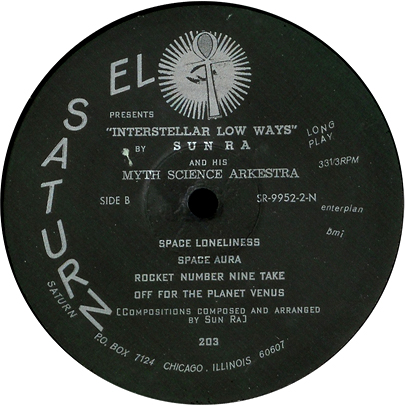

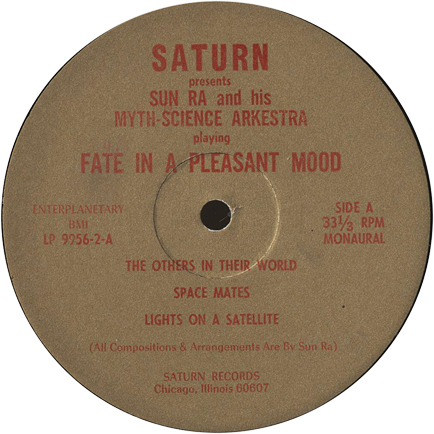
Sun Ra (bells, perc, gong -1, p -2, space harp -11); Phil Cohran (violin-uke -3, cnt -4, perc, voc); Nate Pryor (tb, bells -5); John Gilmore (ts -6; cl -7, perc, voc); Marshall Allen (as -8, fl - 9, bells, voc); Ronnie Boykins (space gong -10, b, voc); John L. Hardy (d, perc, gong).
Elks Hall, Milwaukee, Wisconsin, June 14, 1960
| The Others in Their World (Ra) -2, 4, 5, 6, 8 | Saturn 9956-2/A/B, Impulse AS 9270, Evidence 22068 [CD] | ||
| Space Mates (Ra) -1, 2, 9 | Saturn 9956-2/A/B, Impulse AS 9270, Evidence 22068 [CD] | ||
| Lights on a Satellite (Ra) -2, 4, 5, 6, 7, 8, 9 | Saturn 9956-2/A/B, Impulse AS 9270, Evidence 22068 [CD] | ||
| Fate in a Pleasant Mood (Ra) -2, 4, 6, 8 | Saturn 9956-2/A/B, Impulse AS 9270, Evidence 22068 [CD] | ||
| Ankhnaton (Ra) -2, 4, 5, 6, 8 | Saturn 9956-2/A/B, Impulse AS 9270, Evidence 22068 [CD] | ||
| But Not for Me (Gershwin) -2, 4, 6, 8 | Saturn ESR 508, Evidence 22011 [CD] | ||
| Day by Day (Cahn-Stordahl-Weston) -2, 4, 5, 6, 8 | Saturn ESR 508, Evidence 22011 [CD] | ||
| Holiday for Strings (Rose-Gallo) -2, 5 | Saturn ESR 508, Evidence 22011 [CD] | ||
| Dorothy's Dance (Cohran) -2, 4, 6, 8 | Saturn ESR 508, Evidence 22011 [CD] | ||
| I Loves You Porgy (Gershwin-Gershwin-Heyward) -2, 4, 6, 9 | Saturn ESR 508, Evidence 22011 [CD], Paddle Wheel [J] KICJ 315 [CD], Evidence 22219 [CD] | ||
| Body and Soul (Green-Heyman-Sour-Eyton) -2, 6 | Saturn ESR 508, Evidence 22011 [CD] | ||
| Keep Your Sunny Side Up (DeSylva-Brown) -2, 4, 6, 8 | Saturn ESR 508, Evidence 22011 [CD] | ||
| Tiny Pyramids (Boykins) -2, 4, 5, 7, 9 | Saturn 9956-2-O/P, Impulse AS-9245, Evidence 22066 [CD] | ||
| Angels and Demons at Play (Boykins-Allen) -1, 9, 11 | Saturn 9956-2-O/P, Impulse AS-9245, Evidence 22066 [CD] | ||
| LO8W-0114 | Space Loneliness (Ra) -2, 4, 6, 8 | Saturn LO8W-0114/0115, Saturn SR 9956-2-M/N, Evidence 22039 [CD] | |
| LO8W-0115 | State Street (Ra) -2, 4, 6, 8 | Saturn LO8W-0114/0115, Evidence 22164 [CD] | |
| LO9W0541 | The Blue Set (Ra) -2, 4, 6, 8 | Saturn SA-1001, Evidence 22164 [CD] | |
| LO9W0542 | Big City Blues (Ra) -2, 4, 6, 8 | Saturn SA-1001, Evidence 22164 [CD] | |
| Somewhere in Space (Ra) -2, 4, 6, 8, 9 | Saturn SR 9956-2-M/N, Evidence 22039 [CD] | ||
| Interplanetary Music (Ra) [ens voc] -2, 10 | Saturn SR 9956-2-M/N, Evidence 22039 [CD] | ||
| Rocket Number Nine Take off for the Planet Venus (Ra) [ens voc] (incl. Second Stop Is Jupiter) -2, 4, 6, 8 |
Saturn SR 9956-2-M/N, Evidence 22039 [CD], Paddle Wheel [J] KICJ 315 [CD], Evidence 22219 [CD] | ||
| Kingdom of Thunder (Ra-Allen) -1, 4, 7, 9 | Saturn 9956-2/A/B, Impulse AS 9270, Evidence 22068 [CD] | ||
| unidentified titles | unissued | ||
| Velvet (Ra) -2, 4, 5, 6, 8 | Saturn HK 5445, Evidence 22038 [CD], Paddle Wheel [J] KICJ 315 [CD], Evidence 22219 [CD] |
According to Phil Cohran, this session was an all-day marathon at which 30 to 40 tunes were recorded. All tracks were identified by Cohran as coming from this session, or have a similar ambiance to those he so identified. Cohran has placed this session at Hall Recording Company in Chicago (but see below).
A small index card in Alton Abraham's papers (Box 18, Folder 3) designates two numbers "For Immediate Recording" (really meaning, release on a single). The date was June 18, 1960 and the projected sides were "Faith [sic] in a Pleasant Mood" and "Dorothy's Dance." As it turned out, other tracks were chosen for release. Cohran has said that he copyrighted “Dorothy's Dance” “within a week” after the session; “Dorothy's Dance” was registered on June 24, 1960. Ronnie Boykins next copyrighted "Tiny Pyramids" on June 27. Sun Ra followed Cohran and Boykins to the Library of Congress with a suite (titled "Space Loneliness, A Sound Concerto," it collected 8 different themes, including “Space Loneliness,” “Fate in a Pleasant Mood,” “Lights on a Satellite,” and “State Street”) on July 8, and “The Blue Set” on July 21 (James Wolf). "Fate" as copyrighted had no lyrics, although Sunny would often sing or sermonize over this tune in later years.
“Angels and Demons” includes Sunny's home-made space harp (a type of lyre), not Cohran's instrument. Sunny's space harp (the first of several instruments to be given that name) was kept by Alton Abraham and is now in the Alton Abraham Collection at the University of Chicago Library. The tune became a bone of contention. It was copyrighted on May 1, 1967, as by Boykins, Allen, and Ra, with words by Sun Ra (no recording with the lyrics is known); then for a second time on December 29, 1976, as an instrumental by Ronald Boykins and Marshall Allen.
For “Kingdom of Thunder,” Lucious Randolph is credited on the Impulse reissue, but Phil Cohran is credited on the back of the original Saturn LP and mentioned in the 1967 catalog. Randolph had a vivid recollection of recording this piece in a club and being disappointed with the playback, and the less than ideal balance given to the muted trumpet is consistent with his story. However, Cohran recalls making this track at the Elks Hall marathon. Randolph also recalls recording “The Others in Their World,,” “Fate in a Pleasant Mood,” and “Lights on a Satellite” around this time, with similar personnel.
Alton Abraham said that the studio at Hall Recording Co. was too small for the Arkestra, and that he used it for mastering only. Hall Recording probably opened in June 1959; an item in Cash Box for June 27, 1959 announced (p. 29) that "Bill Hall and Stu Black opened their new Hall Recording Studio in the Loop recently." Abraham claimed that the session was done at RCA Victor Studio in Chicago, but the Alton Abraham Collection preserves a regular flow of paperwork between Saturn and RCA between 1956 and 1961, with a different job number assigned by RCA to each project, and there is no bill or invoice for a studio session in 1960. (RCA did bill Saturn for mastering and pressing on the first single to be released from the session.) The actual recording order is unknown, except that “Velvet” was the last track of the day. Personnel courtesy of Phil Cohran, confirmed by the postdated Union contract; the drummer, John Hardy, was not mentioned on any of the Saturn record jackets, though his name appears in the 1966 catalog in connection with Rocket Number Nine (as the LP was first meant to be called) We Travel the Spaceways.
Further confirmation of the common origin of many of these tracks is provided by a Saturn test pressing found in a Montréal record store by François Lamarche. The test pressing was made at Sheldon Recording Studios (as noted above, this was Chess Studio's external operation) and titled simply, Music of the Future by Sun Ra Arkestra. Side A contained “Space Mates,” “But Not for Me,” and “The Others in There [sic] World.” Side B had “Lights on the [sic] Satellite,” “Day by Day,” “Ankhnaton,” and “Holiday for Strings.” The pressing uses Alton Abraham's home address at 4115 South Drexel and gives a Montréal address and phone number for Sun Ra. It was therefore cut in August or September 1961. The Arkestra's relocation to New York probably disrupted the plan. In any event, Saturn did not issue LPs from this session till 1965, and when they began to appear, the tracks had been redistributed.
Fasten your seat belts. Tracks recorded at Elks Hall were issued on 2 Saturn singles and 5 different LPs.

The first release out of the Elks Hall marathon was Saturn LO8W-0114/0115, a 45-rpm single by Sun Ra and his Arkestra. On the single the band is simply designated as "Sun Ra & His Arkestra." A copy is in the collection of the late Otto Flückiger, and the description of these two sides in his pioneering discography was the only semi-reliable one for many years. The L prefix duly signifies that the record was mastered and pressed in 1960. In the Alton Abraham Collection (Box 16 Folder 6) there is receipt for a shipment from RCA Victor's pressing plant in Indianapolis. It is for 5 cartons of records and the date is July 18, 1960. This is almost certainly is for LO8W-0114/0115. Phil Cohran told us that “Space Loneliness” was a new composition in 1960 and recalled a visit to a radio station where the tune was played (off the single). In fact, the Alton Abraham Collection (Box 4, Folder 6) includes a brief review of the single from "Sound and Fury—Listening with Carl Wieland"; the date of the "test" is August 25, 1960. It's also worth noting that Sun Ra published the flip, “State Street,” as part of a “Space Loneliness” suite. On January 23, 1961, Saturn received another 300 copies of "114" from RCA Victor's pressing plant in Indianapolis (Alton Abraham Collection, Box 16 Folder 6).
Both tracks from 0114 were reissued on The Singles, Evidence 22164 [CD], in September 1996. For "State Street," this was the very first reissue.
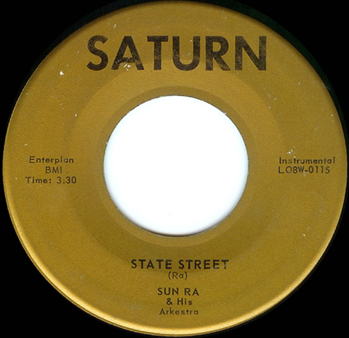
Saturn SA-1001 was a 45-rpm single, credited to “Sun Ra and his Arkestra.” Like L08W0114/0115, it had a black Saturn logo in block letters on gold, according to Glenn Jones. “The Blue Set” (matrix LO9W0541) was Side A; “Big City Blues” (LO9W0542) was Side B. According to Phil Cohran, who confirmed the listed personnel, it was recorded in 1960 and “released while we were performing.” Although Cohran didn't recall this, the sonics suggest that both sides were made at the same studio session as the other items. The postdated Union contract for the Elks Hall session confirms this, because "The Blue Set" and "Big City Blues" are listed as two of the 6 sides supposedly recorded (when in fact there were many more). Because the LO9W matrix numbers come a little later in the RCA Victor series, we may infer that it was released after "Space Loneliness" b/w "State Street." And so it came to pass that on August 3, 1960, Saturn was billed for two 45 rpm test lacquers from Sheldon Recording Studios, whose transfer and mastering operations had now spilled over from the Chess offices to 6742 North Trumbull Avenue. "Big City Blues" was numbered 403 by Sheldon, putting it right after the two sides of the second Cosmic Rays single; "The Blue Set" was numbered 404, and because of the length (4:40) Sheldon charged Saturn $12 for an EP test, instead of $9 for a regular 45 (Alton Abraham Collection, Box 16, Folder 9; the EP lacquer of "Blue Set" is preserved in the Alton Abraham Collection, Box 68). We have not seen a pressing bill for SA-1001, but the single was released later in August 1960; on August 31, 1960, Saturn sold 125 copies of "S1001" to United Record Distributors, 2029 South Michigan Avenue (also Box 16, Folder 9). Side A of the single was mislisted in Flückiger and subsequent discographies as “The Blues Set.” Both tracks from SA-1001 were reissued on The Singles, Evidence 22164 [CD], in September 1996.
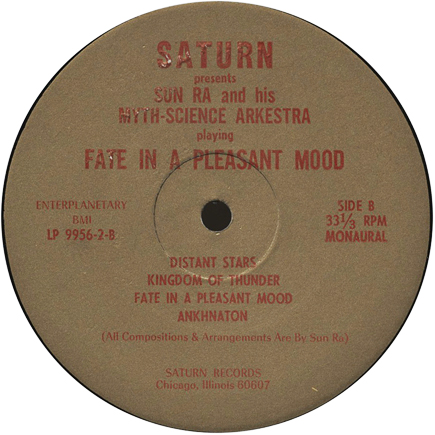
Saturn LP 9956-2-A/B, Fate in a Pleasant Mood, was released in 1965. During the initial pressing run the LPs had gold labels with red print. In 1967 the album was given the catalog number 202. The spine of the Saturn LP, but not the front or back cover, rendered its title as it may have been intended originally, “Faith in a Pleasant Mood” (the spine also said "Saturn Vol. 2" without indicating what Volume 1 was, and gave the number as 9956-2-B). The back cover, but not the label, identified the last title on Side B as “Ankhnation.” The personnel list credited Eddy Skinner with the drumming instead of John L. Hardy. All tracks were reissued in 1974 on Impulse AS 9270 and in 1993 on Evidence 22068 [CD].
Saturn LP 9956-2-O/P, Angels and Demons at Play, was released in 1965 and given the catalog number 407 in 1967; these two tracks appeared on Side A. All tracks from this album were reissued on Impulse AS 9245 in 1974 and on Evidence 22066 [CD] in 1993.
“Space Loneliness” (LO8W-0114) was first reissued around 1966 on Saturn SR 9956-2-M/N, Rocket Number Nine Take off for the Planet Venus. In 1967, this LP was given the catalog number 203; by 1967, it was out as Interstellar Low Ways (both titles are reported in Julian Vein's discography of November 1967). Three more tracks from this session were initially issued on Saturn SR 9956-2-M/N (misrendered 9952-2-M/N on some Saturn labels). All tracks from this album reissued in 1992 on Evidence 22039 [CD].
Saturn HK 5445, We Travel the Spaceways, was issued with the catalog number 409 in 1967 and may also have circulated as Saturn ESR 5445. All tracks from this album reissued on Evidence 22038 [CD] in 1992.
Saturn ESR 508, Holiday for Soul Dance, was released in 1970, credited to “Sun Ra and his Intergalactic Arkestra.” The album was reissued on Evidence 22011 [CD] in 1992.
“I Loves You, Porgy,” “Rocket Number Nine,” and “Velvet” are included in a 1997 CD sampler, Sun Ra Came Down to the Earth, on Japanese Paddle Wheel KICJ 315, and on Evidence 22219, Greatest Hits: Easy Listening for Intergalactic Travel, released in September 2000.
At a brighter tempo, Space Loneliness bumps and grinds like a Calumet City special. The original version has the right world-weariness. Phil Cohran remembered, "When we played it on the radio in 1960 a woman called up the station. She said, 'It sounds like something that crawled up from beneath the earth and died when it reached the sunlight.'"
"Rocket Number Nine" points toward the music that the Arkestra would be playing on the lower East Side of New York City. The tenor sax solo isn't the work of John Coltrane in 1962, but of John Gilmore in 1960. Not even Ornette Coleman's bassists were playing like Ronnie Boykins at this date.
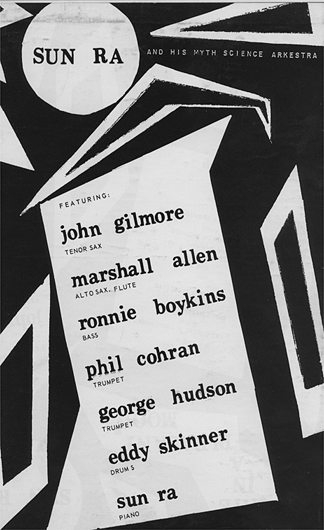
The actual American Federation of Musicians contract for the Elks Hall session (Box 16, Folder 9) was substantially postdated. On August 30, 1960, Alton Abraham drew up a contract for "one day of engagement" at Elks Hall, purportedly to take place on September 19. Names, Social Security numbers, and addresses were provided for the musicians, and John Hardy's last name was correctly spelled this time. Payment was the same as on the credit memoranda from June. And the titles to be recorded were ... "State Street," "Space Loneliness," "The Blue Set," "Big City Blues" (all actually released by this time!), "To Be Named Tune A," and "To Be Named Tune B." Obviously, everyone would have had to be paid more for 22 tracks than for 6, so more than a little misdirection was going on.
Because Lucious Randolph was on his way out of the band and Phil Cohran was not always available, Ra began training a young trumpet player named George Hudson. He also used Walter Strickland on trumpet—and kept making recordings at rehearsals (or, in at least one case, on a club gig in front of a live audience).

Sun Ra (p); Marshall Allen (as, fl); John Gilmore (ts); Ronnie Boykins (b); Jon Hardy (d); Ricky Murray (voc).
Wonder Inn, Chicago, 1960
| Early Autumn (Herman-Mercer-Burns) | Saturn ESR 508, Evidence 22011 [CD] |
Ricky Murray does not remember the Elks Hall session (which, so far as we know, contained no vocal numbers; for that matter, his name is not on the postdated Union contract) and suggests that this track was made at the Wonder Inn, 75th and Cottage Grove.
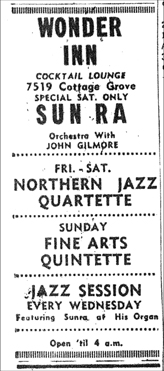
The Arkestra's Wonder Inn engagement has justly become legendary. Until recently we had no idea when it began, because the club purchased advertisements so sporadically. The Wonder Inn opened in January 1959. It was owned by Harold Harris, a pianist who recorded for Boxer and later for Vee-Jay, and Dan Dixon, Jr. Once it had announced its existence, the Inn quit running ads in the Defender till October 24, when Danny Overbea and the Northern Jazz Quartette were featured. On January 16, 1960, when the Inn next sprang for another Defender ad, it was still Overbea and the Northern Jazz Quartette; indeed, the latter act was around in March, when a couple more ads appeared, and was still being featured at the Inn in July 1960.
The first ad placing Sunny at the Wonder Inn was accompanied by a brief item in the Chicago Defender about “a special added attraction” for July 30, 1960: Sun Ra and his “recording band.” The next week, Sunny was mentioned again, but only in connection with the Wednesday night session. It turns out that Sunny had been presiding over the Wednesday night session for quite some time. A handbill that was acquired and saved by Pat Patrick (now in the Pat Patrick collection at Northwestern University) announces Wednesday night events for February 10 and 17, 1960. "Space Age with Sun Ra and his Recording Arists, Featuring Rhythms, Ideas, Fashions[,] Art, and original Songs from the Year 2000."
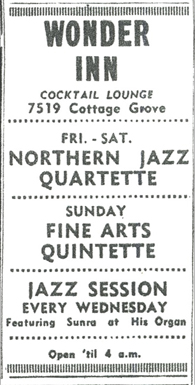
The reminiscences that various musicians have provided about the Wonder Inn are about more than a Wednesday night session. At some point, the Arkestra was regularly booked on the weekends, becoming the club's top attraction. Most likely this happened in the fall of 1960. The Arkestra probably remained there into the early months of 1961; during much of this period Jack DeJohnette, piano and drums, and Scotty Holt, bass, were the intermission act. We lack other documentary information; advertising was paid for out of petty cash, and because the Wonder Inn was non-Union, no contracts were posted with Local 208.
When "Early Autumn" was done, neither Phil Cohran nor George Hudson was apparently available, as the piece was recorded without a trumpet player.
“Early Autumn” was initially released in 1970 on Saturn ESR 508, Holiday for Soul Dance, and reissued in 1992 on Evidence 22011 [CD]. Though Murray is listed as the vocalist, and the solo credits are correct, the personnel listing on the Saturn jacket is otherwise completely wrong, giving a 14-piece ensemble from around 1969!
Recently a live tape of part of a set at the Wonder inn has resurfaced. "Early Autumn" is not on it. There is plenty of noise from enthusiastic patrons, which may have discouraged Saturn from releasing any of the tracks. All the same, the band was reasonably well recorded and the performances are first-rate.
Sun Ra (p, Wurlitzer ep, perc); George Hudson (tp, perc); Marshall Allen (as, fl, bells, voc); unidentified (fl -1); John Gilmore (ts, perc, voc); Ronnie Boykins (b, perc, voc); Jon Hardy (d); Ricky Murray (voc).
Wonder Inn, Chicago, 1960
| Angels and Demons at Play (Boykins-Allen) | Atavistic UMS/ALP 237 [CD] | ||
| Spontaneous Simplicity (Ra) - 1 | Atavistic UMS/ALP 237 [CD] | ||
| Space Aura (Ra) | Atavistic UMS/ALP 237 [CD] | ||
| 'SWonderful (Gershwin-Gershwin) [RM, ens voc] | Atavistic UMS/ALP 237 [CD] | ||
| It Ain't Necessarily So (Gershwin-Gershwin-Heyward) [ens voc] | Atavistic UMS/ALP 237 [CD] | ||
| How High the Moon (Lewis) | Atavistic UMS/ALP 237 [CD] | ||
| China Gate (Young-Adamson) [RM voc] | Atavistic UMS/ALP 237 [CD] |
This tape was released on CD in 2002 in the Unknown Music Series, Music from Tomorrow's World: Chicago 1960, Atavistic ALP237. Phil Cohran identified the trumpeter as George Hudson, who can also be seen in a photo taken during a performance at the Inn. We don't know who is playing the second flute on “Spontaneous Simplicity”; there is no trumpet on the piece, but we have never heard that George Hudson doubled on flute.
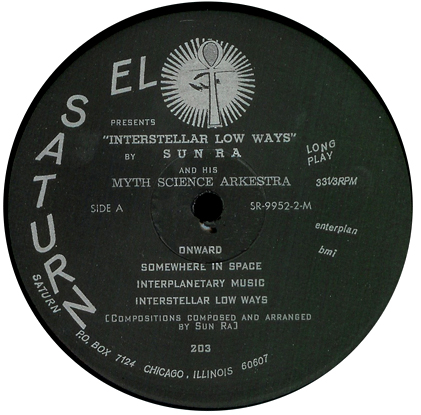
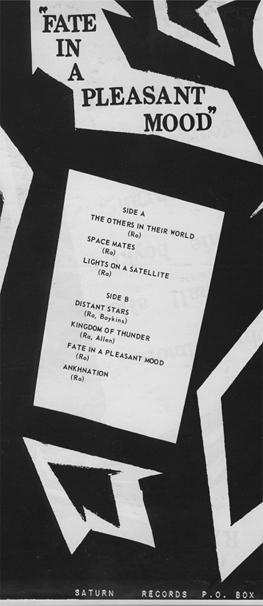
Sun Ra (p); George Hudson (tp); Marshall Allen (as, bells, flying saucer, voc); John Gilmore (ts, perc, voc); Ronnie Boykins (b, perc, voc); Jon Hardy (d).
prob. Wonder Inn, Chicago, around October 1960
| Distant Stars (Ra-Boykins) | Saturn 9956-2/A/B, Impulse AS 9270, Evidence 22068 [CD] | ||
| Onward (Ra) | Saturn SR 9956-2-M/N, Evidence 22039 [CD] | ||
| Space Aura (Ra) | Saturn SR 9956-2-M/N, Evidence 22039 [CD] | ||
| We Travel the Spaceways (Ra) [ens voc] | Saturn HK 5445, Evidence 22038 [CD] |
George Hudson began working with Sun Ra in late 1960 and remained with the Arkestra until Sun Ra left Chicago. His style is immediately recognizable on the first three tracks and Phil Cohran identified him on “We Travel” (which was attributed to Cohran on the Saturn jacket). The bizarre whirring and quacking heard at the end of “We Travel the Spaceways” comes from a toy robot with flashing lights; John Gilmore told John Corbett that around this time the Arkestra would release the “robots” into the audience during their performances. The band also used mechanical “flying saucers” as props. Edward Skinner (who later changed his name to Luqman Ali) was incorrectly credited as the drummer in John Hardy's place on a number of Saturn issues. It is known, however, that he and Hudson often worked together and it is possible that Skinner is on “Distant Stars” or “Onward.”
Most likely these sides were made at the Wonder Inn, where the Arkestra was in residence for months. "We Travel the Spaceways" has a similar ambience to the tracks from the Wonder Inn set that was recently released on Atavistic, including some audience noise (though not nearly as much as can be heard on some of the Atavistic tracks).
More information about the date of these sessions comes from James Wolf's research at the Library of Congress. Sun Ra copyrighted a suite including “Interplanetary Music,” “Rocket Number Nine,” and “We Travel the Spaceways” on October 10, 1960. Of course, the suite also included “The Satellites Are Spinning,” and Ra copyrighted “Theme of the Stargazers” on September 12, 1960. Neither was recorded until until May 1966.
"Space Aura" was not copyrighted until August 24, 1964, when Sunny was preparing to release Secrets of the Sun, an LP that included a second version of the tune recorded in New York in 1962. Copyright dates for "Distant Stars" and "Onward" are still not known.
Saturn LP 9956-2/A/B was first released in 1965 as Fate in a Pleasant Mood. In 1967 it was given the catalog number 202. It was reissued on Impulse AS 9270 (1974) and Evidence 22068 (CD, 1993).
Saturn SR 9956-2-M/N was issued in 1966 as Rocket Number Nine Take off for the Planet Venus, and given the catalog number 203 in 1967. In 1967, it was reissued with a new cover and the title Interstellar Low Ways, the title also used on Evidence 22039 [CD] in 1992. Some Saturn labels incorrectly give the numbers as SR-9952-M and SR-9952-N.
Saturn HK 5445, We Travel the Spaceways, was issued in 1967 and given the catalog number 409. It was reissued in 1992 on Evidence 22038 [CD].
There was a session focused on standards, which still remains mysterious, and Saturn invested in studio time to make a second Yochannan single.
Personnel unidentified.
Chicago, December 10, 1960
| Sunday | Saturn (unissued) | ||
| Thou Swell | — | ||
| Something to Remember | — | ||
| Stars Fell on Alabama | — | ||
| You're an Old Smoothie | — | ||
| Way Down Yonder in New Orleans | — | ||
| You're Blasé | — | ||
| Love Nest | — | ||
| unidentified titles | — |
Documentation accompanying a tape box gave a list of titles, a date of December 10, 1960, and an indication that the tape was copied on March 27, 1974. Nothing more is known about this recording. Is it still extant?
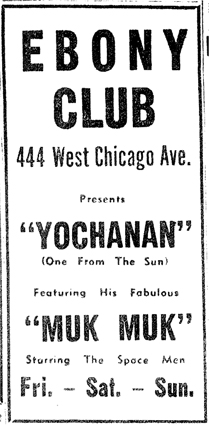
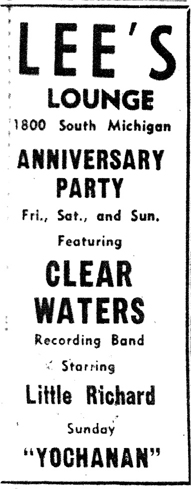
When Sunny turned the vocal chores on space chants over to members of his band, he was giving up on vocal groups once and for all. Meanwhile, Yochanan, the eccentric blues singer, had swung back into orbit. Yochanan was a little more visible on the South Side in 1960 than he had been in previous years. In April, he was working a 3-day weekend at the Ebony Club, with his own band, The Space Men. He was billed as the "One from the Sun." In June, he was an added attraction on Sunday night with guitarist Eddie Clearwater at Lee's Lounge, a moderately successful blues club.

In an ad for a November 1960 appearance with a band led by drummer Richard Whatley (who often used the stage name Don Costello), Yochanan was now identified as "The Man from the Sun." The venue, Swing City, was at the same address as the former Ebony Club. Before 1960 (admittedly, the ads that we have found are sparse) Yochanan had gone as "The Man from Mars" or "The Man from Outer Space." His second Saturn single was recorded at two different sessions that took place around this time, or just a little later.
Yochannan (voc) with Sun Ra (Hammond B-3 org); prob. Walter Strickland (tp); Marshall Allen (as); John Gilmore (ts); Ronnie Boykins (b); unidentified (d).
Unidentified studio, Chicago, before September 1961
| M09W1165 986B* |
Message to Earthman (McCarey-Yochannan-Ra) | Saturn 1502, Saturn 986*, Evidence 22164 [CD] | |
| Message to Earthman [alt.] | Evidence 22164 [CD] |
"Message to Earthman" was released in 1961 as the B side of Saturn 1502, a 45 rpm single (the M09W prefix indicates that the side was mastered and pressed by RCA Victor in 1961). According to Glenn Jones, the label of this exceedingly rare release has black print on gold with the Saturn logo in script down the side. Tucked into the record book that Alton Abraham kept in 1961 was a receipt from United Record Distributors for 100 copies of Saturn 1502; the date was September 27, 1961 (Box 18, Folder 5). We have yet to find session or production paperwork for M09W1165 (though we have seen a bill for a test pressing that included "The Sun One," from the next session).

The number was reissued in 1968 as Saturn 986, a 45 rpm single; on the reissue, the name is respelled “Yochannan” and “Sun Ra and his Arkestra” are also mentioned on the label. Yochannan's opening announcement, “The Sun Man's message to the Earthman” is edited out. The alternate version surfaced during research on the Saturn singles; it also has a (different) spoken introduction. Both versions were reissued in Fall 1996 on The Singles, Evidence 22164 [CD].
Both versions were reissued in 2009 on Norton CED-354, Sun Ra: Rocket Ship Rock. Yochannan's spoken announcements are included.
Hattie Randolph, who left the band in the middle of 1959, did not remember this side, whereas Lucious Randolph did. Phil Cohran said that no one in Chicago but Sun Ra was using lyrics about space at this time.
John Gilmore denied recording with Yochannan, but on this session there is no really no question about his presence. The trumpet player sounds like Walter Strickland and does not resemble Phil Cohran or Lucious Randolph.
The McCarey mentioned in the composer credits to Saturn 1502 (he is left off Saturn 986) is Prentice McCarey, the long-time pianist and arranger for the King Kolax band. Yochannan and McCarey had definitely worked together when "The Man from Mars" and the King Kolax band were holding forth at the Come Back Trail, in July 1957. According to Bo Dudley, who knew Yochannan and later recorded him for his Dud Sound label, Yochannan worked with King Kolax on many occasions (see the interview with Dudley by Miriam Linna in her notes to Rocket Ship Rock). What's more, passages in the extremely obscure "Jealous of My Shadow," recorded by singer Earl Pugh for JOB in December 1956, bear a distinct resemblance to "Message to Earthman." Pugh was accompanied on that session by a King Kolax quintet, with Prentice McCarey at the piano.
Yochannan (voc) with Sun Ra (Hammond B-3 org); Lucious Randolph (tp); Marshall Allen (as); John Gilmore (ts); Ronnie Boykins (b); unidentified (d).
Unidentified studio, Chicago, before June 1961
| M09W7841 | The Sun One (Yochannan) | Saturn 1502, Evidence 22164 [CD] | |
| 986-A | The Sun Man Speaks (Ra-Yochannan)^ | Saturn 986, Evidence 22164 [CD], Norton CED-354 | |
| The Sun Man Speaks [alt.] | Evidence 22164 [CD] |
“The Sun One” was issued in 1961 as side A of Saturn 1502, a 45 rpm single. The first edition of The Earthly Recordings gave the release date as 1959 or 1960, but the side was mastered and pressed by RCA Victor and in the Victor matrix code, the M-prefix stands for 1961. RCA Victor did a test pressing of M09W7841 and 7842 on June 2, 1961 (test pressing report in the Alton Abraham Collection, Box 16 Folder 7); we don't know what 7842 was... Then Saturn sold 100 copies of 1502 to United Record Distributors on September 27, 1961.
The originally issued “Sun One” ran about 2:45 and did not include Yochannan's monologue (“On the third moment, the stone was rolled away”). On the tape box it was called “The Man who Flew in from the Sun”; in Yochannan's spoken introduction, it was “The Man that Flew All the Way from the Sun.”
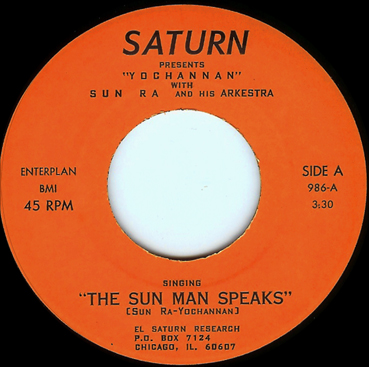
For the second issue in 1968 on Saturn 986, a 45 rpm single, a different take was used, under the title “The Sun Man Speaks.” This version included the monologue and ran 4 and a half minutes. The singer's name was spelled with another “n” (to bring it up to nine letters) and the label referred to “Yochannan with Sun Ra and his Arkestra.” A third version showed up during research on the Saturn singles. It is a shorter, monologue-less performance, on which Yochannan varies the lyrics: “I'm back, it's a natural fact.” All three versions were (re)issued in September 1996 on The Singles, Evidence 22164 [2 CDs].
Finally, the 4 1/2 minute rendition of "The Sun Man Speaks" reappeared in 2009 on Norton CED-354, Sun Ra: Rocket Ship Rock. The Norton release includes Yochannan's spoken title at the beginning.
To further confuse matters, there was a one-sided issue of “The Sun One” that appeared c. 1970 (according to Richard Wilkinson). It is not known which take of the piece was used on that release.
Neither Phil Cohran nor Lucious Randolph recalled participating in this session; however, the trumpeter sounds like Randolph. Though John Gilmore did not like Yochannan and denied recording with him, his presence in the ensemble here is unmistakable.
Although we haven't found advertisements for Yochannan's club gigs after 1960, he remained on the scene for nearly 25 years. His last recordings were made in 1968 for Bo Dudley's A-1 Dud label: one of the titles was "The Sun Man" (A-1 Dud 4717-A). According to Dudley, in his interview with Miriam Linna, another was "Muck You." Dudley recalled that "Muck Muck" was Yochannan's standard stage name in later years; he died in the mid-1980s.
The Arkestra remained in Chicago during the first half of 1961, doing little recording. Besides the two sides accompanying Yochannan, the Arkestra laid down four tunes during its last gig in town.
During the early months of the year, the Arkestra was still based at the Wonder Inn. On occasion, the Inn was in such parlous financial condition that the electricity got cut off and the band had to play in the dark. When the Arkestra resurfaced for the last time in the Chicago Defender entertainment ads, starting in late May, the band photo that was used had been taken on the Wonder Inn stage.
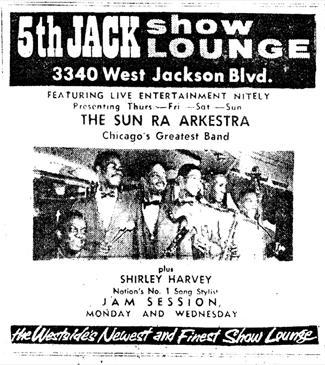
The Chicago Defender ran an advertisement on May 27, 1961 for an engagement at a new, highly ambitious West Side club called 5thJack. The club had opened for business just before Christmas of 1960. Previously 5thJack had featured bands lead bar-walking tenor saxophonist John Tinsley (who happened to be a former member of one of Ra's experimental ensembles, and a member of Yochannan's ensemble at his first session for Saturn; see Appendix A below) and by Betty Dupree, a bassist who had a long history of collaboration with pianist Willie Jones. The club also kept blues-oriented female vocalists on hand: Shirley Harvey and Bonnie Graham, both of whom had been singing in the South Side clubs for several years.
The Local 208 Board meeting minutes show that Sun Ra filed a contract for the 5thJack gig on May 18; weekly ads in the Defender confirm that the Arkestra was there for 5 weeks (on June 22, Tommy “Madman” Jones filed a contract with the club, beginning his engagement on June 30). Phil Cohran's recollection of a crowd and employees mesmerized by “Interplanetary Music”, to the point that all other activity came to a stop, refers to a night at 5thJack. The photo of the Arkestra that was included in four of the Defender advertisements shows Billy Mitchell on drums and Walter Strickland on trumpet. Thanks to John Corbett for the identification; Corbett also confirms that this photo was taken at the Wonder Inn.
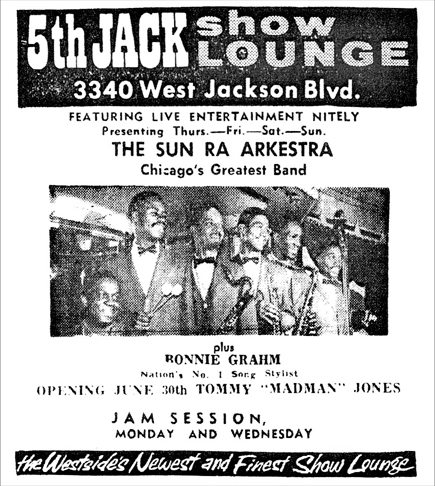
According to Ricky Murray's recollections, the Arkestra's last gig in Chicago was at the Pershing Lounge (confirmed by a contract filed with Local 208 on June 22). This gig probably lasted four weeks, starting around June 30. The Pershing Lounge had been a fairly high-profile venue in Chicago since the early 1950s, especially for piano trios. Ahmad Jamal had played there many times, eventually making himself and the venue nationally famous in 1958 with his hit Argo LP, Live at the Pershing Lounge. Despite the publicity jolt from Jamal's record, the Lounge went into eclipse later that same year (the now-celebrated pianist was on tour, and it's doubtful that the Lounge could afford his fee when he got back to town). It revived under new management in 1959, with the help of Eddie Buster's organ trio. But in 1960 the hotel changed hands, and for a few months was known as the Nan-Carl. The lounge closed, reopened, closed again, reopened again, but apparently everyone found "Nan-Carl" a risible name, and it reverted to Pershing Lounge. In the summer of 1961, Ahmad Jamal was the star attraction at his own restaurant, the Alhambra, which drew the fans even though it served no booze, and the once-mighty lounge couldn't afford ads in the Defender.
Sun Ra (p); Walter Strickland (tp); prob. Dick Griffin (tb); Marshall Allen (as); John Gilmore (ts); Ronnie Boykins (b); Billy Mitchell (d).
Pershing Lounge, Chicago, July 13, 1961
| Space Loneliness (Ra) | Saturn HK 5445, Evidence 22038 [CD] | ||
| Eve (Ra) | Saturn HK 5445, Evidence 22038 [CD] | ||
| I'll Remember April | Saturn (unissued) | ||
| State Street (Ra) | — |
Walter Strickland is identified on the Saturn jacket as the trumpet player on “Eve.” He is not so credited for this version of “Space Loneliness,” but a tape box, labeled as from the Pershing Lounge, July 13, 1961, once contained versions of “Eve” and “Space Loneliness” that were taken out on March 1, 1967. Both tracks were first issued in 1967 on the LP We Travel the Spaceways (Saturn HK 5445). It was given the catalog number 409 in 1967 and may also have circulated as Saturn ESR 5445. All tracks from this album were reissued on Evidence 22038 [CD] in 1992.
These versions of "Eve" and "Space Loneliness" offer rather dimly recorded piano, with bass and drums up front (hence the thunderous backbeat on "Space Loneliness"). Contrary to the first and second editions of The Earthly Recordings, there is no baritone sax (by Pat Patrick or anyone else) on "Eve." And the trombone player's overall timbre (along with the rather challenging part that Sunny asked him to play) suggest that he isn't Nate Pryor. Dick Griffin worked with Sunny on a number of occasions during his final months in Chicago.
Cosmic forces were hard at work. Up to now, despite the feelers extended for gigs in Birmingham and in New York City, the Arkestra had never gone farther away than Indianapolis. As the Pershing Lounge gig wound down, Sun Ra received an offer to play for two weeks at a club called El Morocco, on Closse Street in Montréal. The gig opened on July 31, 1961. As legend has it, the Arkestra was fired after two nights, but they scrounged and got other work in the area, playing for teenagers at St.-Gabriel-de-Brandon, a mountain resort about 60 miles north of Montréal; “When the Saints Go Marching In” was in their repertoire. Finally, they landed an extended engagement at The Place in Montréal. At this time “China Gate” and “I Struck a Match on the Moon” were in the book. Booted out of Canada after two months when their temporary visas expired, Sun Ra, Marshall Allen, John Gilmore, Ronnie Boykins, and Ricky Murray made their way to New York City.
Attempts to recruit some other Chicagoans (such as Art Hoyle and Lucious Randolph) proved unsuccessful. Trumpeter Billy Howell came from Chicago, but didn't stay. Luckily, Pat Patrick and Tommy Hunter were already in New York, and with their help Sunny began to rebuild the Arkestra. Rents were high, so they undertook the communal living that the Arkestra has since been known for. Financially, New York was cruel; the band got virtually no gigs for three or four years. Creatively, though, it was the right place to be. But that's a story for another site.
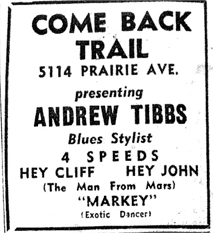
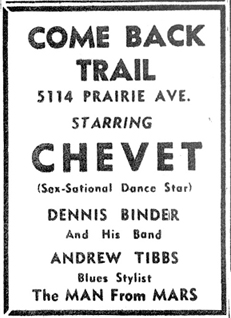
There is residual uncertainty about the date of the first Yochanan single, but if it was made in 1957 (as seems fairly likely), it was the only studio recording for Saturn that year. We have yet to locate any bills or paperwork, either for the recording session or for the production of the single.
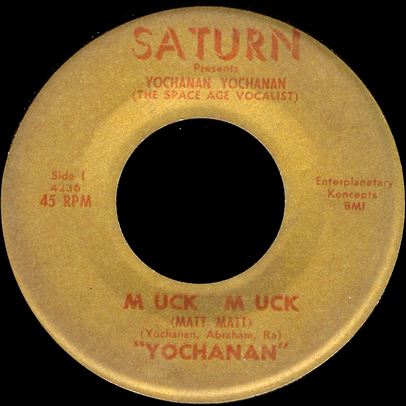
Yochanan (voc) with unidentified (p); John Tinsley (ts); unidentified (b); unidentified (d).
Studio recording, Chicago, probably 1957
| 4236 [alt.] | Muck Muck (Yochannan-Abraham-Ra) | Norton CED-354 | |
| 4236 | M uck M uck (Matt Matt) (Yochannan-Abraham-Ra) | Saturn 4236/7, Atomic Passion 1958, Evidence 22164 [CD], Norton CED-354 | |
| 4237 [alt.] | Hot Skillet Momma (Yochannan-Abraham-Ra) | Norton CED-354 | |
| 4237 | Hot Skillet Momma (Yochannan-Abraham-Ra) | Saturn 4236/7, Atomic Passion 1958, Evidence 22164 [CD], Norton CED-354 | |
| Rocket Ship Rock (Yochannan-Abraham-Ra) | Norton CED-354 | ||
4237 [alt.] |
Is That Me? (Yochannan-Abraham-Ra) | Norton CED-354 |
Yochanan (an extra "n" was later added to his name, perhaps for numerological reasons) was an eccentric R&B performer in Chicago who wore “sun colors” and open-toed sandals, said he was “descended from the Sun,” and gave “wild man” performances in clubs and along Maxwell Street. Although his work with Sun Ra would sometimes take him in other directions, Yochanan is best understood as a fringe blues performer. In Earl Hooker: Blues Master (we thank Lex Jansen for the reference), Sebastian Danchin describes his occasional participation in Hooker's band:
Hooker's own stays at Waterloo [Iowa] usually lasted several weeks. Chicago side-men who visited Iowa in the Hooker outfit included Sammy Lawhorn — a superb guitarist whose vibrato owed much to Earl's slide-playing — as well as the Muck Muck Man, a cranky Memphian who settled in Chicago, where he became famous for his outrageous stage act. Muck Muck was also known for going barefoot all year long, a habit he apparently kicked after his feet got badly frostbitten during a particularly harsh winter in Waterloo. (Jackson: University Press of Mississippi, 2001, p. 196)The frostbite story circulated in more than one version: for instance, John Gilmore said that Yochanan quit wearing open-toed sandals all winter after getting a bad case of frostbite in Chicago. But then Waterloo and Chicago winters have roughly the same frostbite potential.
What Yochanan's birth name was remains a mystery. His place of origin is also unclear, though as noted above others on the Chicago blues scene thought he was from Memphis. John Gilmore recalled Yochanan hanging around rehearsals while the band was playing at Budland but after Jazz by Sun Ra. By contrast, Julian Priester (who left the band in the Fall of 1956) did not remember him. Hattie Randolph recalled Yochanan, whose nightclub act at least occasionally included jumping over tables, as well as this single. We have learned from other sources (see Miriam Linna's notes to the Rocket Ship Rock CD) that Yochanan had a longstanding affiliation with Alvenia Fulton, who ran the Fulton Institute of Health and Fasting at West 63rd and Damen Avenue.
The “The Man from Mars” (another one of Yochanan's aliases) appeared pretty steadily at the Come Back Trail, a club in Sunny's neighborhood, from May through July 1957. (Located at 5114 South Prairie Avenue, the Trail had previously been known as the New Rocket Lounge, Sonny's Lounge, the Jewell Lounge, and, most famously, Ada's Chicken Shack). For instance, Yochanan was on a bill with Andrew Tibbs and the King Kolax band) on July 6, as per the club's ad in the Chicago Defender. It's reasonable to suppose that Yochanan's first session was made during this period of relatively high visibility. “M uck M uck” (so it was spaced on the original Saturn label) would be Yochanan's signature number as late as the early 1980s (he died around 1985). In the clubs, the lyrics were variations on the dozens; for the record buyers with tender ears, he substituted a lot of nonsense syllables. In fact, many on the Chicago blues scene knew Yochanan as "Muck Muck" or "The Muck Muck Man."
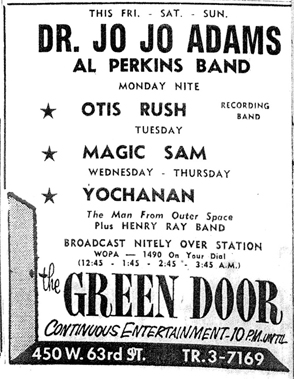
Yochanan rarely got gigs in the bigger Chicago blues clubs, and, when he did, he didn't hold on to them for long. After his run at the Come Back Trail, he would not resurface in the entertainment pages of the Chicago Defender until June 1959, when he was performing on Wednesday and Thursday nights at the Green Door (450 West 63rd Street). He lasted a week or two. In 1960, he would raise his profile a little, eventually recording again for Saturn (see above; the second time around, he was accompanied by an Arkestral unit).
John Gilmore intensely disliked Yochanan, denied recording with him, and told Robert Campbell that these sides were made by the singer's “rock and roll” band. But Alton Abraham said firmly that Arkestra members were used on all sessions with Yochanan. Now that we have "Rocket Ship Rock," which was not issued until 2009, we can hear Yochanan exhorting the tenor saxophonist to "Come on, John, and rock," whereupon the tenorist gets his only solo on the session. For years, we thought the saxophonist might be Pat Patrick playing tenor sax (as he did with Thelonious Monk, among others, but not with the Arkestra) but this solo didn't sound like him. Then we concluded that it might be John Gilmore after all. Our best information today is that it was John Tinsley, a "barroom tenor player" (according to Alvin Fielder) who usually led his own combo. (Some Local 208 documents spelled his last name as "Tinsey.") For all we know, this could be the only recording session that John Tinsley participated in; though fairly prominent on the South Side during the second half of the 1950s, he never had a record out as a leader.
The label states that the date was produced by Yochanan, Sun Ra, and Alton Abraham. Saturn 4236/4237 was a 45 rpm single.
To further complicate matters, "Muck Muck" (now with its subtitle Egyptianized: Maat Maat) and "Hot Skillet Mama (Momma)" were apparently prepared for copyright in 1960, judging from the date neatly inscribed at the bottom of the front page for each sheet. Words and nonsense syllables were carefully rendered. The compositions were credited to Yochannan Yochannan and Alton Abraham—no mention of Ra anywhere. Abraham, in turn, was in no hurry to get them registered; each sheet was stamped May 16, 1964 by the Library of Congress.
“Muck Muck” and “Hot Skillet Mama” were both reissued in 1995 on a bootleg collection LP titled Blowin' through Yokohama! (Atomic Passion 1958). This was billed as “16 Hot Skillet Muck Muck R&B Blasts!” and otherwise included “various muckety mucks” such as “Blowin' through Yokohama (Parts 1 and 2)” by the Medallions, “True Fine Mama” by Little Julian Herrera and the Tigers, “Stick Out Your Can” by Roscoe Holland, “Mama Ubangi Bangi” by the Four Sounds, “Brand New Automobile” by the Payments, the “Rock and Roll Sermon” by Elder Beck, and “She's Jailbait” by Roosevelt Sykes (thanks to Pedro Moreno for this information). Yochanan's name was consistently misspelled “Yochanon” by the compilers of this bootleg, who did correctly register his title of “Space Age Vocalist.” The first legitimate reissue of these tracks took place in September 1996, on The Singles, Evidence 22164 [CD]. The second was in 2009, on Norton CED-354, Rocket Ship Rock, compiled by Micahel Anderson. The Norton CD brought together for the first time all surviving tracks from this session, including the previously unknown "Rocket Ship Rock" and "Is That Me?"
Sun Ra and the core members of his Arkestra stayed in New York City for seven years. In the fall of 1968, they lost the lease on the Sun Studios, as their East Village abode was called, and accepted the offer of a row house in the Germantown area of Philadelphia from Marshall Allen's father. Except for a short period of residency in Oakland, California, in 1971-1972, Sunny remained at 5626 Morton Street until shortly before his death.
What Sunny and the other members of his Arkestra achieved in later years is covered in John Szwed's biography, and in The Earthly Recordings of Sun Ra.
Sun Ra maintained an extremely active schedule, composing, rehearsing, and performing, until October 1990, when he suffered a stroke. Though confined to a wheelchair, he returned to playing keyboards and leading the band in March 1991. A second stroke, in September 1992, ended his playing days; he returned to Birmingham, where he left the planet on May 30, 1993.
Among the Chicago-period Arkestra members, John Gilmore remained with Sunny to the end, taking only one leave from the band (from August 1964 through March 1965, when he went on tour with Art Blakey's Jazz Messengers). He assumed leadership of the Arkestra in 1993 and continued until shortly before his death in 1995, from emphysema.
Pat Patrick left the Arkestra in 1971, but returned on a number of occasions, becoming a regular member again in 1985. In 1976, he recorded as a leader for Sunny and Alton's El Saturn label. For health reasons, he played only alto sax and clarinet in the 1980s (when he was not helping out the rhythm section on electric bass). He left the Arkestra in 1988. Returning to East Moline, he died of leukemia on December 31, 1991.
Sunny and Pat's bandmate in the first experimental trios, Tommy Hunter, died of cancer in Montclair, New Jersey, in 1997.
Ronnie Boykins began taking leaves of absence from the Arkestra in 1970 and left for good in 1974. He worked with many other musicians, most notably Charles Tyler, and made one LP as a leader, for ESP-Disk'. He died of cancer in New York City in 1980.
Sam Thomas and Dave Young are deceased, but we have no details.
James Scales stayed in Chicago after his time with Sun Ra. Around 1966, he made four sides for the Marvello label in a style strongly influenced by the early Arkestra. Around the same time he also recorded for the mysterious and infrequently active Verro label; the four Verro sides were done in a style closer to hard bop that showed off his strengths as a soloist—though not as a singer.
We do not know when Wilburn Green, Bo Bailey, James Scales, Jon Hardy, Billy Mitchell, George Hudson, and Clyde Williams left the planet.
Phil Cohran also remained in Chicago. In May 1965, he was one of the founding members of the Association for the Advancement of Creative Musicians. Having worked with Sun Ra (and seen who was hanging out at the Wonder Inn), he was aware of Ra's influence on younger performers. Cohran did not stay with the AACM, because he was not sufficiently interested in free improvisation. In the Saturnian tradition, he started his own record label, Zulu, for which he recorded prolifically with several different ensembles. Kelan Philip Cohran died on June 28, 2017 in Chicago; he was 90 years old (see Giovanni Russonello, "Musical innovator's creativity and activism invigorated Chicago," Honolulu Star-Advertiser, July 5, 2017, p. B-6).
When this page was first posted, Julian Priester, Charles Davis, James Spaulding, Victor Sproles, Lucious Randolph, Hattie Randolph, Ricky Murray, E. J. Turner, Bill Fielder, Robert Barry, Bugs Cochran, Jim Herndon, Nate Pryor, and Al Fielder were alive, many of them still acively performing.
Marshall Allen stayed with the Arkestra for the rest of the Sunny's time on earth. In 1995, he assumed the leadership of the Arkestra, which is still working in 2024. He also recorded as a leader for the CIMP label and made sideman appearances on several other labels. The Arkestra used no keyboard player for several years after Sunny left the planet, but now appears in public with one.
After leaving the Arkestra to join Lionel Hampton, with whom he toured for several years, Art Hoyle was asked to rejoin in 1961 or 1962, not long after the core members had arrived in New York City. (At the time Hoyle had been working with Lloyd Price.) He declined. Hoyle played with the band on just one further occasion, in 1988. After Sun Ra left the planet, he contributed to a memorial collection by reciting several of Ra's poems (for many years, he had also been doing voiceovers for commercials). Art Hoyle died on June 4, 2020. He was 90 years old and had been suffering from Alzheimer's Disease for some time (https://www.legacy.com/obituaries/post-tribune/obituary.aspx?n=arthur-hoyle&pid=196306766).
This page draws primarily on two sources. The first is a talk that Robert Campbell presented at the Alabama Jazz Hall of Fame on March 26, 1995. Thanks to Jim Johnson, Joe Moudry, and Sherri Nielson for making this visit possible, and to the late Frank Adams and the late J. L. Lowe for some corrections about Sonny's Birmingham years. The second is the discographical listings in Robert L. Campbell and Christopher Trent, The Earthly Recordings of Sun Ra (2nd ed.), which was published by Cadence Jazz Books in 2000. We use this material with the permission of Cadence Jazz Books.
We have also employed material from Robert Campbell's panel presentation at the Hyde Park Art Center in Chicago on November 11, 2006. Our thanks to John Corbett, Terri Kapsalis, and Anthony Elms for organizing that event, and for the splendid exhibition catalogue that they have edited: Pathways to Unknown Worlds: Sun Ra, El Saturn, and Chicago's Afro-Futurist Underground 1954-1968 (Chicago: WhiteWalls, 2006). We got further help on Sun Ra's sojourn in Montréal from Victor Simoneau-Helwani.
Walter C. Allen's Hendersonia: The music of Fletcher Henderson and his musicians (Highland Park, NJ: Walter C. Allen, 1973) provided a roster of musicians in the 1946-1947 Fletcher Henderson band (see pages 437-441). John F. Szwed's 1997 biography, Space Is the Place: The Lives and Times of Sun Ra has been a major help throughout. Omniverse Sun Ra, edited by Hartmut Geerken and Bernhard Hefele (Wartaweil, Germany: Waitawhile, 1994), is a valuable source on Ra and his music that includes many photos of record labels and LP covers.
An exhibit at the University of Chicago Library, which now holds the Alton Abraham Papers, is a must-view, on the web if not in person: http://www.lib.uchicago.edu/e/webexhibits/sunra/.
Back to Red Saunders Research Foundation page.
Back to Robert Campbell's home page.